Early Views of San Pedro and Wilmington
Historical Photos of San Pedro and Wilmington |
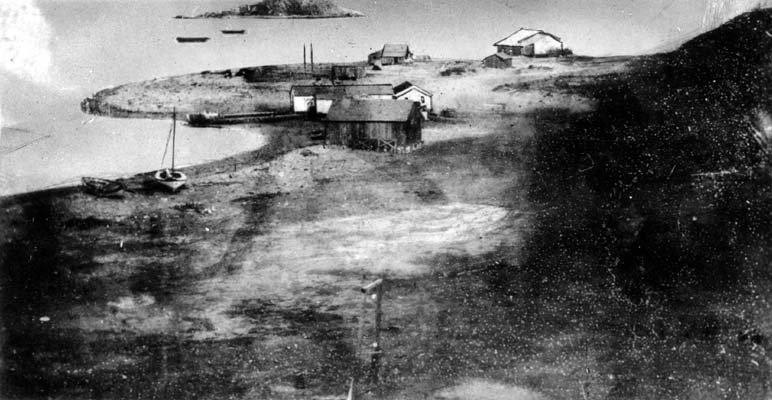 |
|
| (1850)* - View of what is now the San Pedro Harbor in a 1850 daguerreotype (silver copper plate process photo). The old landmark, Deadman's Island is in the background (it was removed in the 1920s to expand the harbor). |
Historical Notes In 1542, Juan Rodriquez Cabrillo discovered the "Bay of Smokes". The south-facing San Pedro Bay was originally a shallow mudflat, too soft to support a wharf. Visiting ships had two choices: stay far out at anchor and have their goods and passengers ferried to shore; or beach themselves. San Pedro was named for St. Peter of Alexandria, a Fourth Century bishop in Alexandria, Egypt. His feast day is November 24 on the local ecclesiastical calendar of Spain, the day on which Juan Rodriguez Cabrillo discovered the bay in 1542 which would be known as San Pedro. Santa Catalina Island, named after Catherine of Alexandria, was claimed for the Spanish Empire the next day, on her feast day, November 25.*^ |
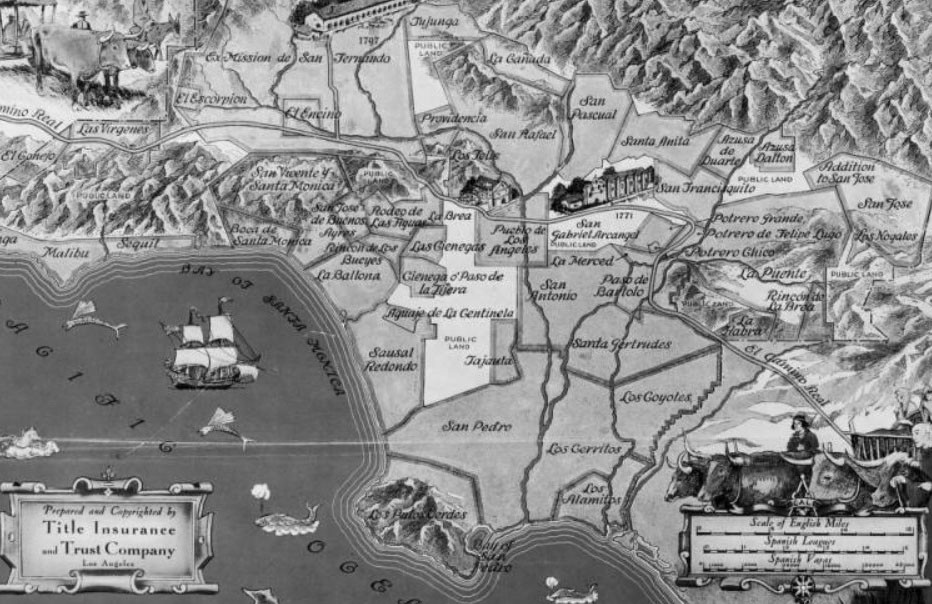 |
|
| (1919)^^ - Map showing the old Spanish and Mexican ranchos of Los Angeles County. In the lower center can be seen Rancho San Pedro sitting between Rancho Los Cerritos and Rancho Palos Verdes. |
Historical Notes Juan Jose Dominguez (1736–1809), a Spanish soldier, arrived in San Diego, California in 1769 with Fernando Rivera y Moncada and served with the Gaspar de Portolà expedition, and along with Junípero Serra, traveled to San Juan Capistrano, San Gabriel and Monterey. In 1784, Dominguez was granted a concession of seventeen Spanish leagues or 75,000 acres from the Spanish Empire. Dominguez's original grazing permission stretched from present-day Compton to the Palos Verdes Peninsula, but did not become a title to land until it was "re-granted" in 1822 in the Mexican era to Juan Jose's nephew and heir, Cristobal Dominguez. Cristobal died soon afterward, but his three sons settled on the ranch, building adobe homes. The following year Manuel Dominguez, eldest son of Cristobal Dominguez, married Engracia Cota and commenced a successful career raising cattle and serving in a variety of elected and appointed offices in Los Angeles. |
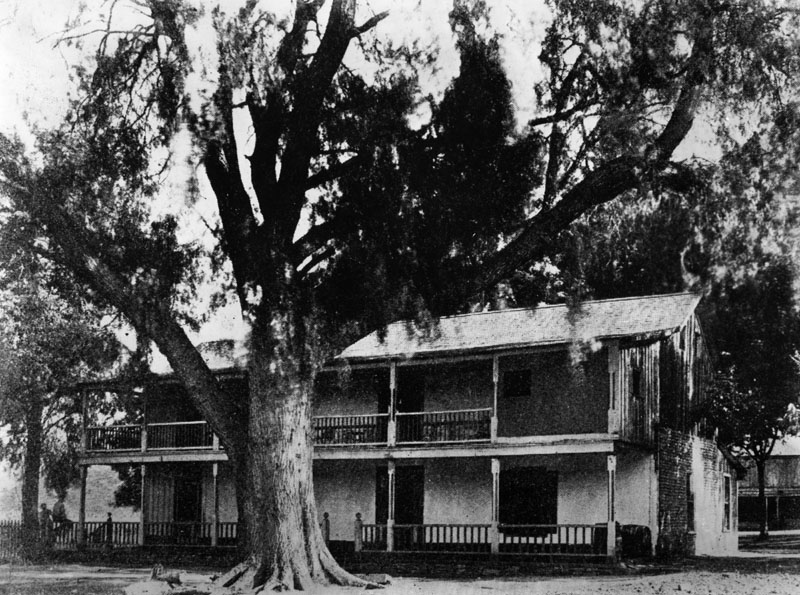 |
|
| (n.d.)* - Exterior view of a two-story adobe home of Don Diego Sepulveda, erected in 1853. Location: 700 block of Channel St, San Pedro. |
Historical Notes In 1851, the 21-yr old Phineas Banning, arrived in the tiny port of San Pedro. At the time the port consisted of just a shack and rickety pier owned by the Sepulveda family, wealthy Californios who also operated a primitive stage coach line to the pueblo, 20 miles away. It wasn’t long before the energetic young Anglo saw visions of fleets of wagons and an international port. He’d make both dreams come true.^**^ This adobe home, built by Diego Sepúlveda in the 1850s, was the first two-story Monterey-type adobe built in Southern California. The site of Diego Sepulveda's home was designated California Historical Landmark No. 380 (Click HERE to see complete listing).*^* |
 |
|
| (1800s)* - George H. Carson standing on the far right, and Mrs. Carson on the far left, at the Dominguez adobe. |
Historical Notes Mrs. Carson’s father was Don Manuel Dominguez, a wealthy sheep raiser, who inherited the Rancho San Pedro of 24,000 acres from his father, Don Christobal Dominguez, a commissioner of Spain, who had inherited it from his uncle, Don Juan Jose Dominguez, to whom the property had been granted by the Spanish throne. In 1839, Don Manuel Dominguez was elected Second Alcalde of Los Angeles; In 1843 he became prefect from the second district of California, and in 1849 he was a delegate to the Constitution Convention of California. George H. Carson was a native of Illinois, who saw service in the Mexican War under Colonel Newberry. At the close of that struggle he went to Los Angeles, establishing himself in the hardware business, in which he remained until his marriage in 1857, when he turned his attention to the direction of his wife’s interest in the San Pedro Ranch.^#^# Upon Manuel’s death in 1882, and the passing of his wife one year later, the Rancho lands were partitioned among his six surviving children, all daughters. Three of the married daughters continued the Dominguez legacy through the Carson, Del Amo and Watson families.^^^# |
 |
|
| (ca. 1800s)* - Another view of the Dominguez home in Wilmington during the 1800s. There are people standing near the fence at left. The residence contains two structures, which appear to be made of adobe. |
Historical Notes Phineas Banning acquired the land that would become Wilmington from Manuel Dominguez, heir of the original concession holder Juan Jose Dominguez, in 1858 to build a harbor for the city of Los Angeles. Wilmington was known as New San Pedro from 1858 to 1863, when it became the city of Wilmington. It was named by “Father of the Harbor” Phineas Banning after his Delaware birthplace.*^ |
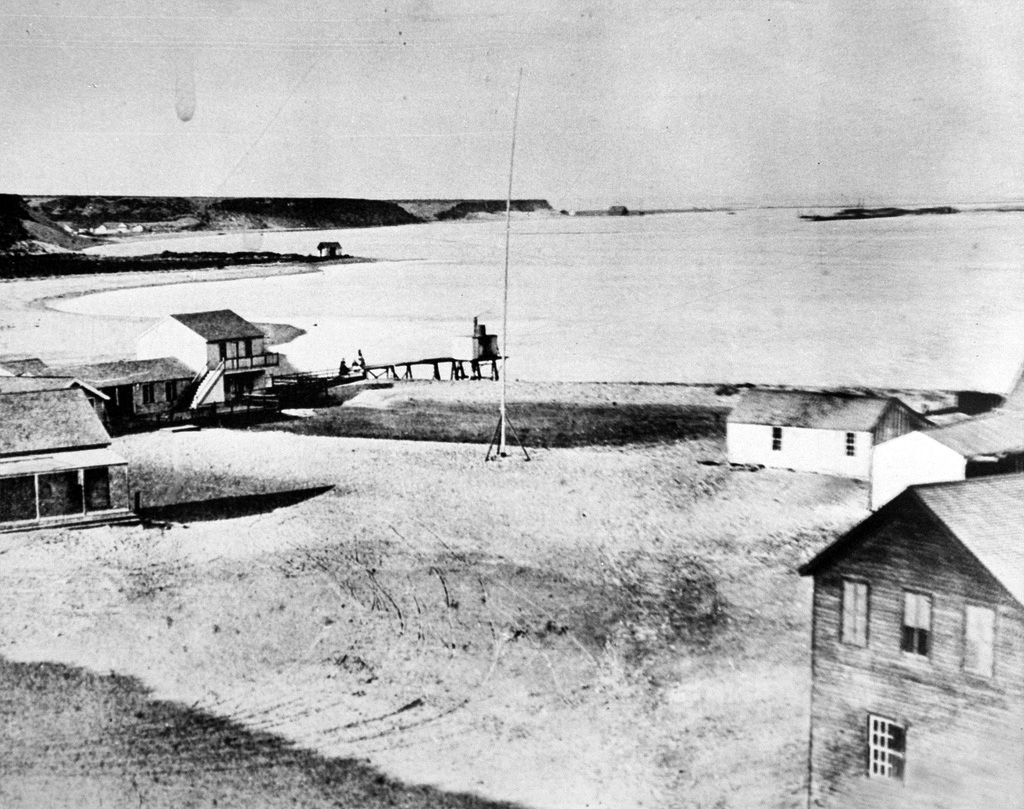 |
|
| (ca. 1865)#^ - At the south end of Los Angeles in the 1800s was a mudflat. By 1868 it would be named Timms' Landing and some historians consider it the first Port of Los Angeles. Timms' Landing was surrounded by vast areas of tidal flats and marshes. |
Historical Notes In 1852, German immigrant Augustus W. Timms obtained Sepulveda's Landing on the mudflats near here. He built a wharf, added a warehouse, corral and other facilities to service shipping and the running of stages to Los Angeles. Timms was a pioneer in the development of the harbor and for over fifty years this area was known as Timms' Point.*^* Timms' Point was designated California Historical Landmark No. 384 (Click HERE to see more Early California Historical Landmarks). |
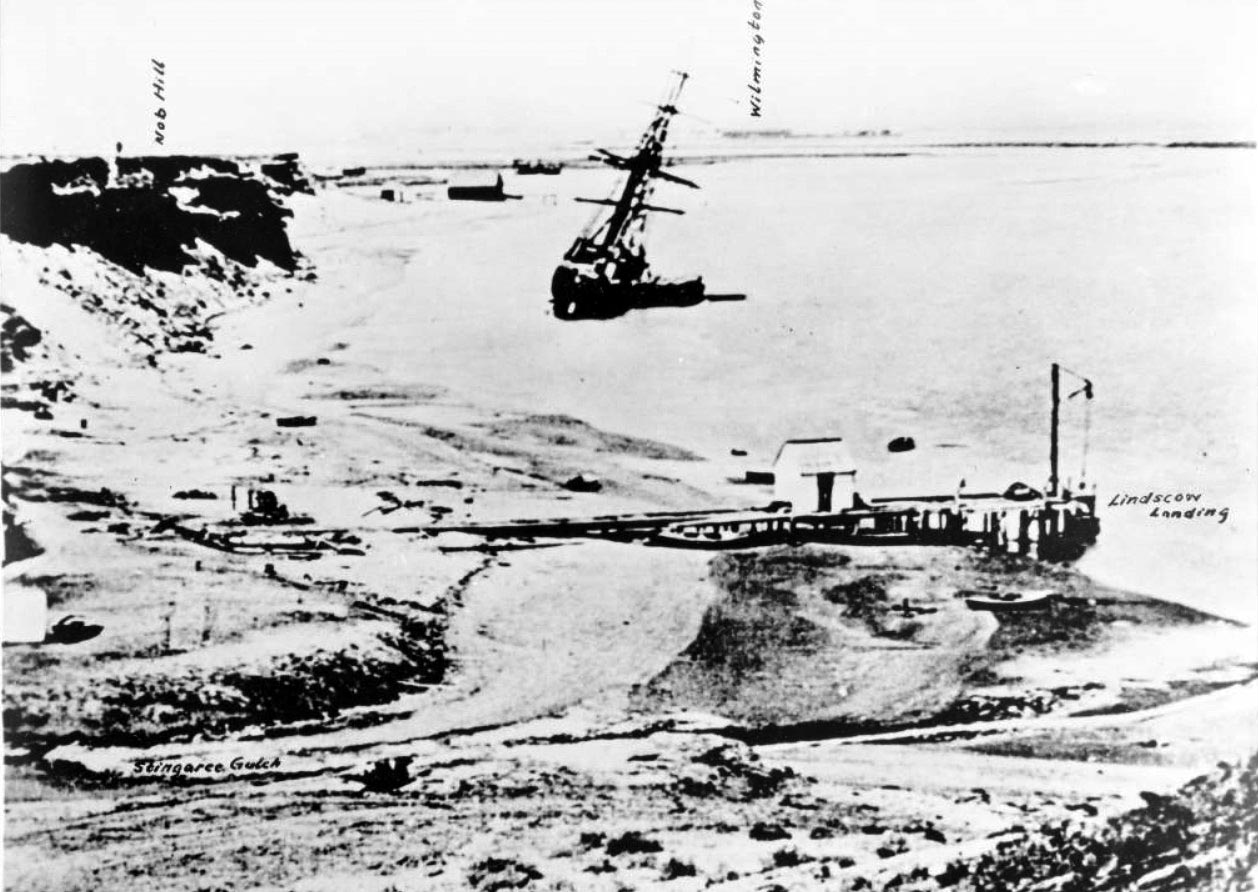 |
|
| (1870s)^^ - View of San Pedro Harbor showing a ship that has run aground in the bay at center, capsizing to the right. Handwriting on the image identifies the wharf and shack in the right foreground as Linscon Landing, the depression in the left foreground as Stingaree Gulch and the elevation in the right background as Nob Hill. It also identifies a faint line on the horizon as the community of Wilmington. |
Historical Notes The ship aground might also be unloading cargo using lighterage, the practice of unloading the cargo from a ship first to a lighter vessel, and then finally to the docks. The harbor at Wilmington did not have a deep-water channel running directly to the docks. The lack of a good deep-water harbor was a great handicap to Los Angeles until the Port of Los Angeles was constructed in the 1900s.^^ |
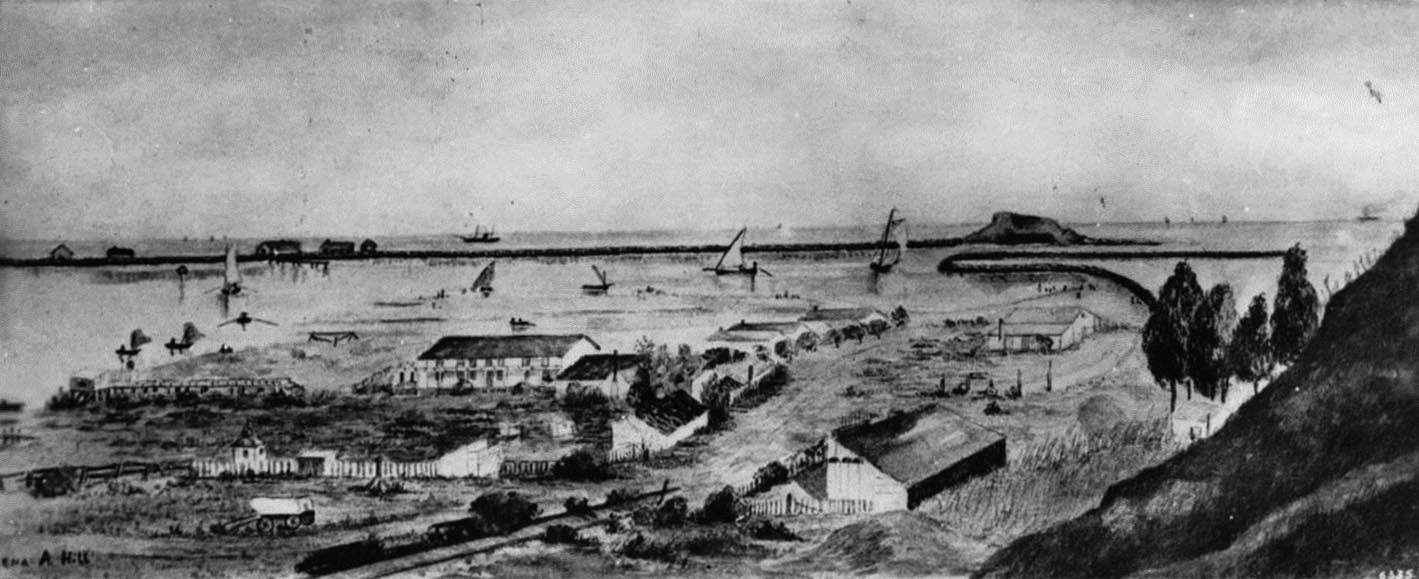 |
|
| (ca. 1875)^^ - Photograph of a painting of San Pedro depicting Timms' Point, Terminal Island and Dead Man's Island. At center the inlet is shown with four sailboats of varying sizes spread from left to right across it with smaller, non-sail boats interspersed among them. In the foreground, three structures are visible: a two-story craftsman-style building at center, as well as both a small booth-sized shack (also to the center) and a larger, roofless shack to the right. Short picket fences line parts of the area of each structure and an unhitched wagon sits in an empty lot in the foreground near the smaller shack. In the background, Dead Man's Island can be seen along with a breakwater peppered by small one-story buildings. |
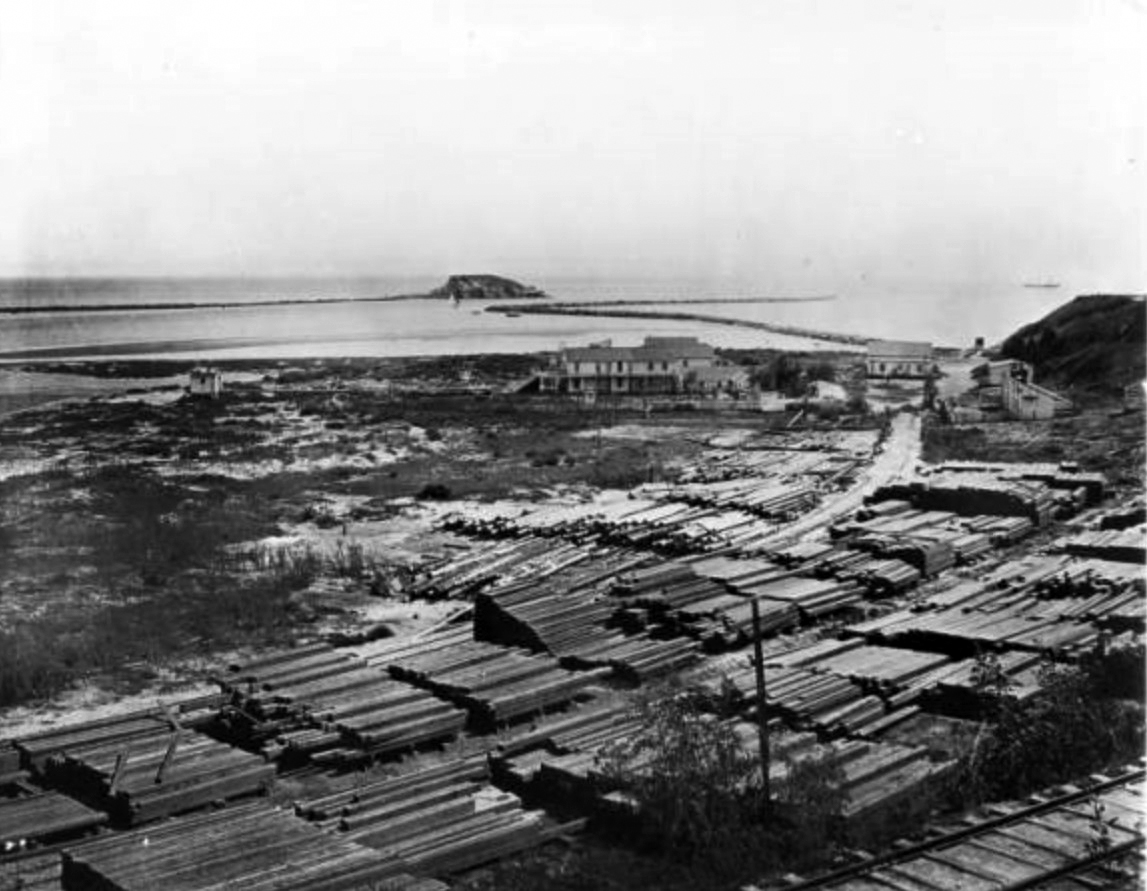 |
|
| (1876)#* - View of San Pedro Harbor from Timms' Landing, looking southeast from what would now correspond with the Southern Pacific Slip (Berth 73). Deadman's Island is in the distance, with dwellings and stacks of lumber near railroad tracks in the foreground on Timms' Landing. |
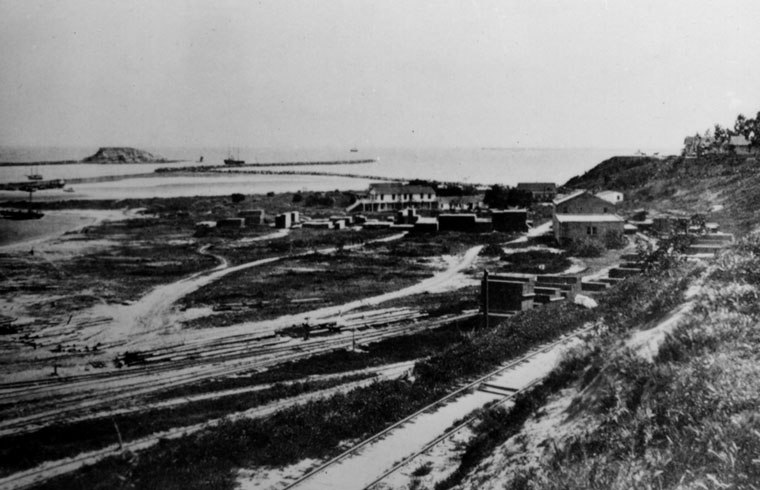 |
|
| (ca. 1870s)* - View of Timms' Point, Los Angeles Harbor. Breakwaters and Deadman's Island can be seen in the background. |
Historical Notes In 1857 the Dominguez family sold Phineas Banning a large parcel of land at the head of the slough northeast of San Pedro. Banning started a settlement called New San Pedro, then in 1859 changed the name to Wilmington after his birthplace. He also built a wharf, warehouses, a lumber yard and built lighters and a steamboat. Wilmington soon eclipsed Timms' Wharf and became the center of the shipping industry in San Pedro Bay. Banning bought stages and wagons to carry passengers and freight from San Pedro to Los Angeles, San Bernardino, and even as far as Yuma and Salt Lake City.*^*^ |
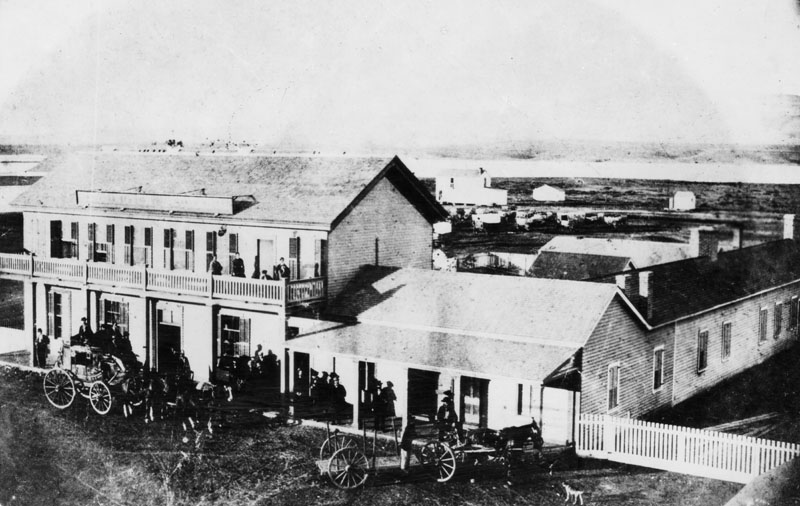 |
|
| (ca. 1865)* - View of the Wilmington Exchange building, hotel and stage station to Los Angeles before the railroad on Canal Street (now Avalon Boulevard). In the front of the hotel is a 4-horse stagecoach with passengers. |
Historical Notes In 1863, the Wilmington Exchange Hotel was built and was the first hotel in Wilmington. Phineas Banning’s first Wilmington home was the single-story building attached to the hotel (as seen above).**^ Besides operating a freighting business, Banning operated a stage coach line between San Pedro and Wilmington, and later between Banning, California, which was named in his honor, and Yuma, Arizona.*^ |
The Los Angeles & San Pedro Railroad (1st in Southern California)
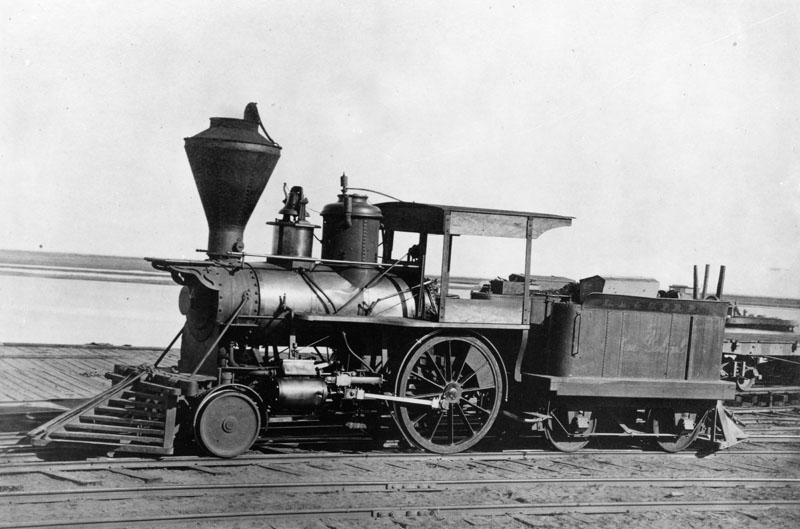 |
|
| (ca. 1868)* - View of locomotive "San Gabriel", the pioneer locomotive of Los Angeles County. It landed at Wilmington Harbor in December of 1868. |
Historical Notes The Los Angeles & San Pedro Railroad was Southern California's first railroad. Its 21-mile line from San Pedro Bay to Los Angeles was built from 1868 to 1869 and began operations on October 26, 1869. The railroad was the brainchild of Phineas Banning and its primary purpose was to transport freight from the port to the city. As a California state senator, Banning sponsored a bill authorizing the City and County of Los Angeles to finance construction of the railroad between Los Angeles and San Pedro. The city and county obliged--and then awarded Banning the contract to construct the line. The new 21-mile line connecting Los Angeles with the new shipping harbor at San Pedro Bay was built between 1868 and 1869. The Los Angeles & San Pedro Railroad was purchased by the Southern Pacific Railroad in 1873.* |
.jpg) |
|
| (ca. 1870)* - View of the L.A. & San Pedro R.R. stopped at a railroad station. |
Historical Notes The new Banning built railroad slashed the cost of transporting goods and passengers to and from the ships at San Pedro. Local merchants and farmers--not to mention port operators like Banning--benefited almost immediately. The railroad charged $6 per ton to transport inbound dry goods to the city. Outbound grain cost $2.50 per ton to ship, and passengers could buy a one-way ticket to the port for $1.50. Total commerce at the harbor more than doubled from 26,000 net tons of freight in 1869 to 55,000 in 1871.*#* |
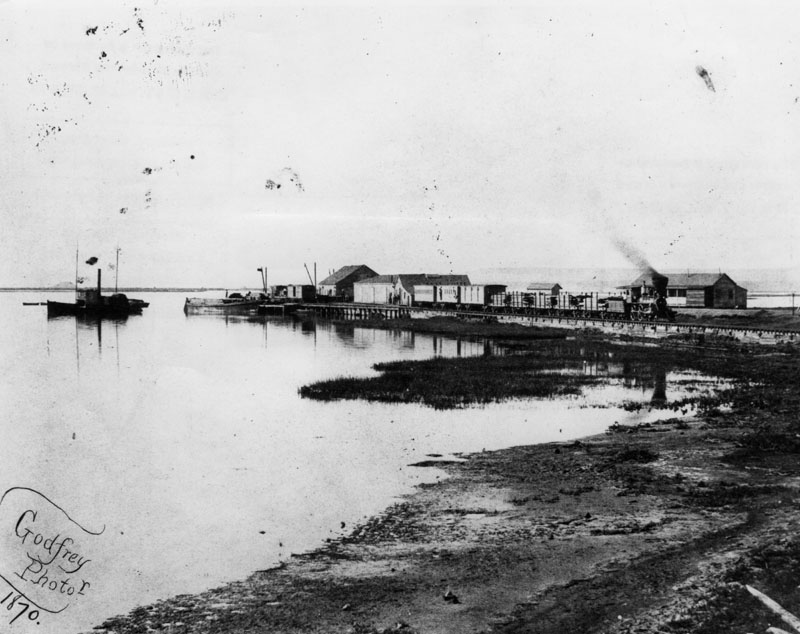 |
|
| (1870)* - View of Wilmington harbor in 1870, showing the Los Angeles and San Pedro Railroad, which had been completed by Phineas Banning in 1869--the first railroad to the harbor. Before that, freight was transported to Los Angeles by ox carts and later by horse-drawn wagons. |
Historical Notes Still relatively undeveloped, the harbor did not offer deep-water access, forcing merchants to send small boats and rafts to meet cargo-carrying ships at anchor in the bay. This method was particularly cumbersome in transporting lumber which, as a result of the growing towns surrounding San Pedro, was in enormous demand.*^^ |
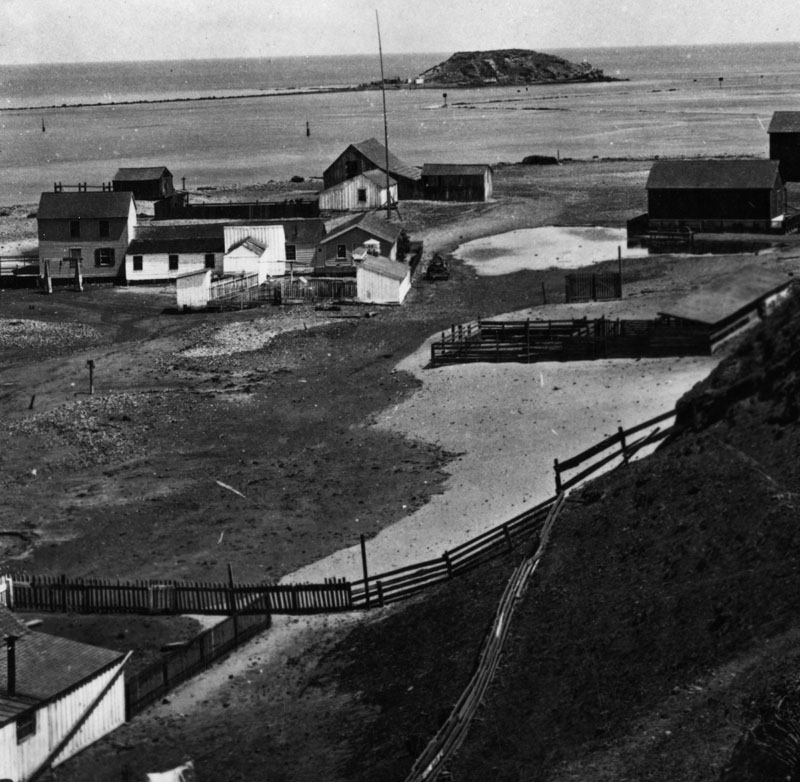 |
|
| (1873)* - Early view of Deadman's Island, shows some of the houses on the island. Breakwaters can be seen in the distance. |
Historical Notes In the late 1860's Banning realized that for San Pedro Harbor to become a center of commerce, that three things needed to be accomplished: Building a railroad, constructing a breakwater, and dredging the harbor to accommodate large ships and to allow them to dock directly at the wharfs. In October 1869, construction was completed on the Los Angeles and San Pedro Railroad, Southern California's first railroad. On March 2, 1871, Congress voted an appropriation for construction of a rock jetty from the lower end of Rattlesnake Island to Deadman's Island.**# In 1871, Phineas Banning greatly improved shipping when he dredged the channel to Wilmington to a depth of 10 feet. The port handled 50,000 tons of shipping that year.*^ |
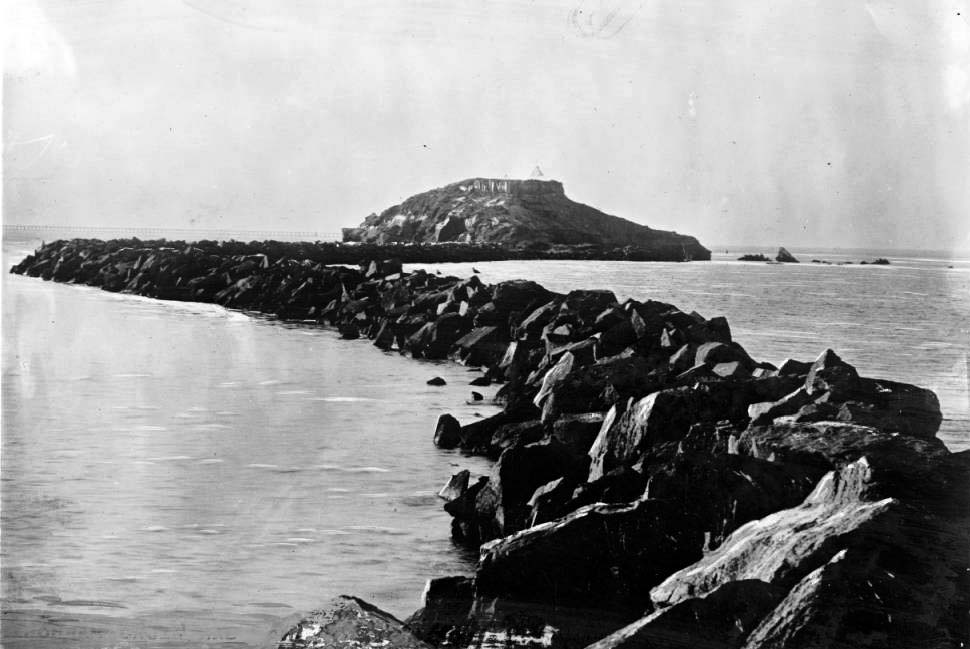 |
|
| (1870s)^^ - Photograph of a view of the San Pedro breakwater extending out of Deadman's Island. The jagged stone pilings of the breakwater can be seen snaking out from the right foreground, bowing out to the left, and returning right to meet up with the island, which is pictured at center. |
Historical Notes Deadman's Island was one of two islands near San Pedro in the 19th century. The land, sometimes referenced as Deadman's Island, Isla Del Muerto, and Reservation Point, was dredged away in 1928 as part of a harbor development effort. Rattlesnake Island, the other islet in the area, became Terminal Island.* |
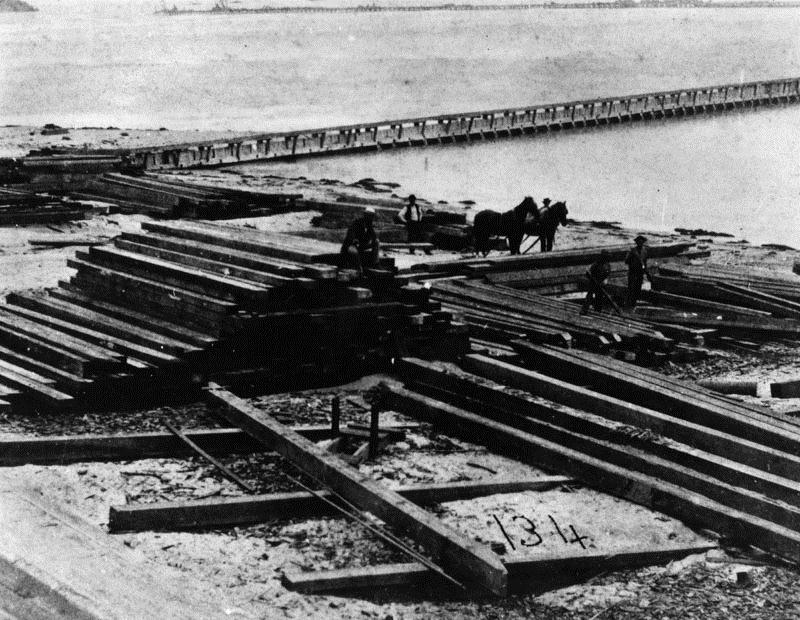 |
|
| (1876)* - Workers are building the breakwater at Wilmington in 1876, with help from a team of horses to move large beams. The structure of the breakwater extends into the sea. |
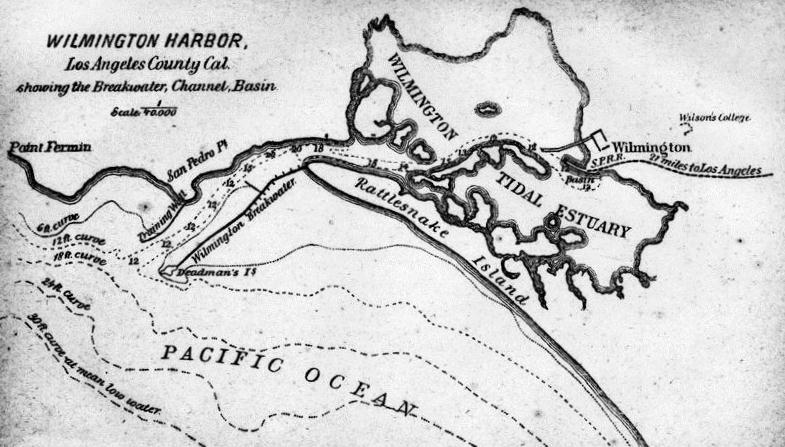 |
|
| (ca. 1880)* - Drawing of Wilmington Harbor, showing the breakwater, channel, basin and railroad tracks. Wilson's College (top right) was established in 1874 and existed in the early 1880's. |
Historical Notes Wilson College was a precursor to the University of Southern California. It opened in Wilmington in 1874 as the first coeducational college west of the Mississippi. Active for several years, it closed after the Methodist Church Conference received a large donation of land closer to Los Angeles and decided to develop on that site. Opened in 1880, that new college would become the University of Southern California. The next college to open in Wilmington was Los Angeles Harbor Junior College in 1949, an institution that became an important link in the state junior college system.**^ |
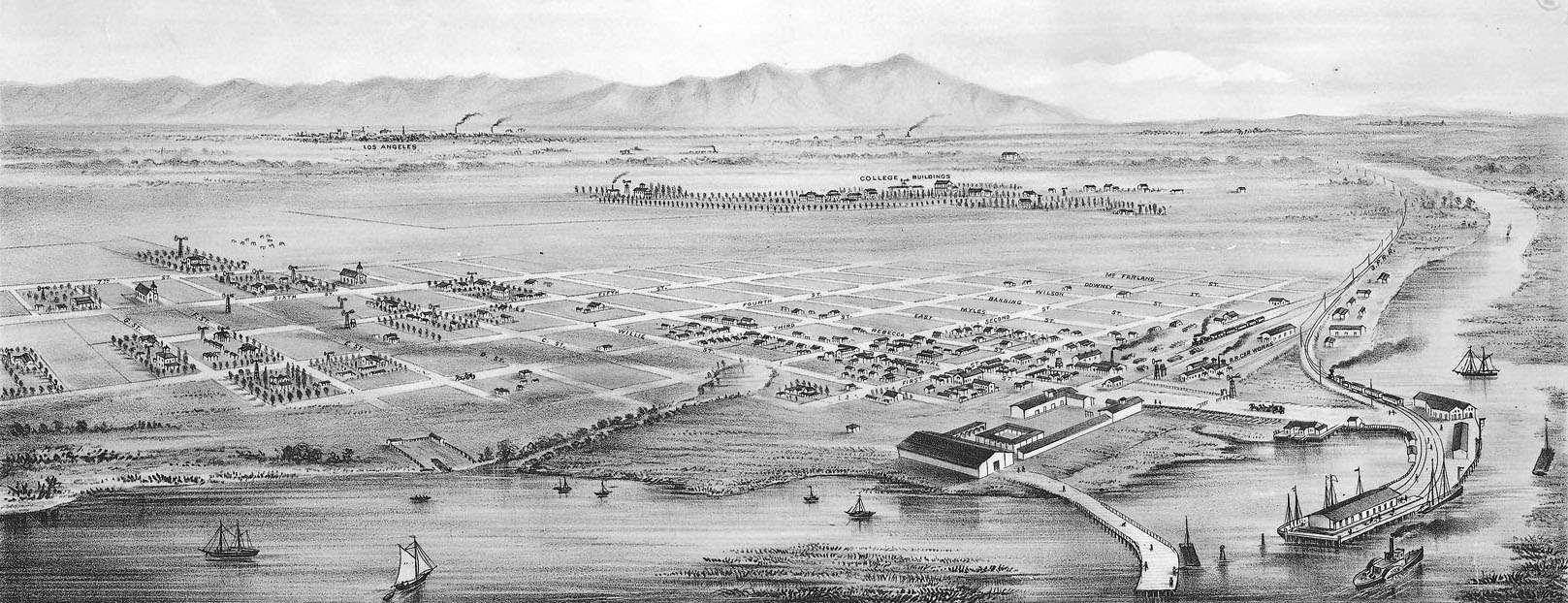 |
|
| (1877)* - Drawing of a bird's eye view of Wilmington looking north from Wilmington Harbor to the Sierra Madre Mountains, 30 miles distant. In the lower right can be seen the ocean terminus of the Southern Pacific Railroad, 23 miles from Los Angeles. |
Historical Notes In 1873 both the City and County of Los Angeles gave their holdings in the Los Angeles & San Pedro Railroad plus $600,000 to the Southern Pacific Railroad (SP) in return for having SP agree to run their railroad through Los Angeles. This move was believed to be necessary for the economic viability and growth of the City. The Los Angeles and San Pedro Railroad would now become the Southern Pacific Railroad. In 1876 the Southern Pacific would terminate their second transcontinental railroad in Los Angeles County.*^^ |
 |
|
| (ca. 1880)* - Drawing of the Dominguez family Rancho San Pedro. A railroad line passed through. |
Historical Notes The Rancho San Pedro is the site of the First Spanish land grant in California. The land was granted in 1784 by King Carlos III to Juan Jose Dominguez, a retired Spanish soldier who came to California with the Portola expedition and later with Father Juniperro Serra. The original land grant encompassed 75,000 acres, including the entire Los Angeles harbor. The land has passed through successive generations and remains in the Dominguez family. Today, the descendants operate the Watson Land Company and the Carson Estates Company on the original Rancho land.^^^# The Dominguez family Rancho San Pedro was designated California Historical Landmark No. 152 (Click HERE to see complete listing). Also, in 1976 it was placed on the National Register of Historic Places by the United States Department of the Interior. |
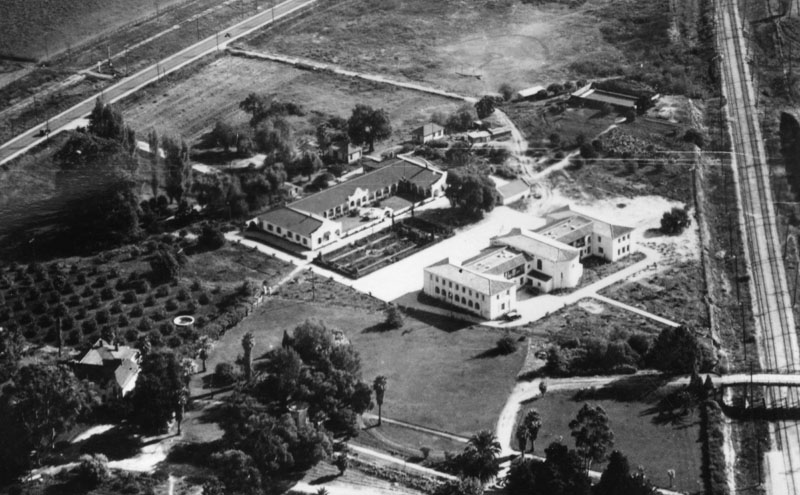 |
|
| (n.d.)* - Aerial view of the restored Dominguez adobe and the Claretian Seminary across the way on Rancho San Pedro. |
Historical Notes Upon Manuel Dominguez's death in 1882, and the passing of his wife one year later, the Rancho lands were partitioned among his six surviving children, all daughters. Three of the married daughters continued the Dominguez legacy through the Carson, Del Amo and Watson families. All of the daughters made major donations to the construction of St. Vibiana’s, the former Cathedral in downtown Los Angeles. In 1922, the two remaining daughters, Susana Del Amo and Reyes Dominguez, deeded seventeen acres adjacent to the family home to the Claretian Missionaries. In 1924, the Claretian Missionaries began using the adobe home as a graduate school for Claretians and later as a seminary. In recognition of this contribution to the Claretians, special arrangements were made to allow Susana and Gregorio Del Amo to be buried in a crypt beneath the altar of the chapel located in the modern day Claretian retirement home.^^^# |
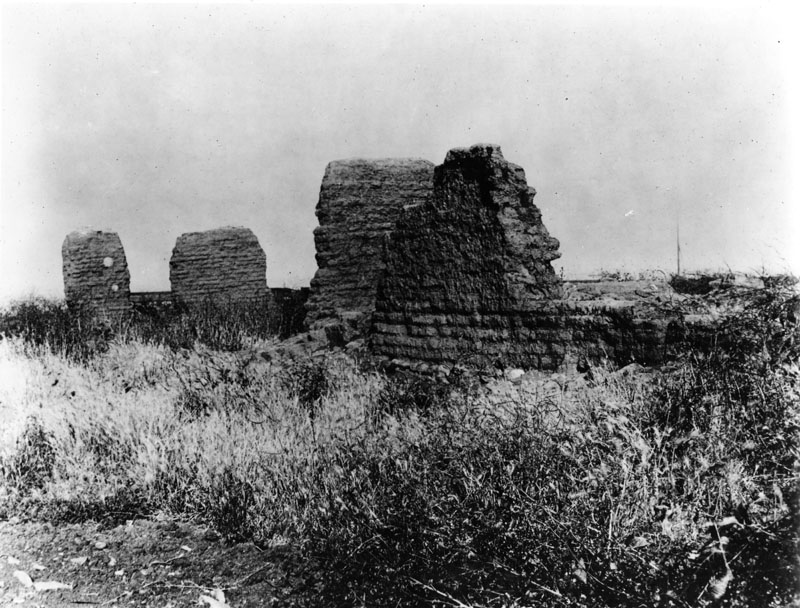 |
|
| (1900)* - In 1829 the Hide House was sold to Mission San Gabriel and five years later it was acquired by Abel Stearns and became known as Casa de San Pedro. Ruins of the Hide House, Casa de San Pedro, stood on the military reserve (Fort MacArthur). Location: Middle Reservation, Fort MacArthur, 2400 block of Pacific Ave, E side of parade field, 300 feet S of intersection of Meyler and Quartermaster Rds, San Pedro. |
Historical Notes The first known commercial structure on the shore of San Pedro Bay was built here in 1823 by the trading firm of McCulloch and Hartnell to store cattle hides from the San Gabriel and San Fernando missions. Richard Henry Dana described this adobe hide house in Two Years Before the Mast. Thus began the development of the Port of Los Angeles.*^* The Casa de San Pedro has been designated California Historical Landmark No. 920 (Click HERE to see complete listing). |
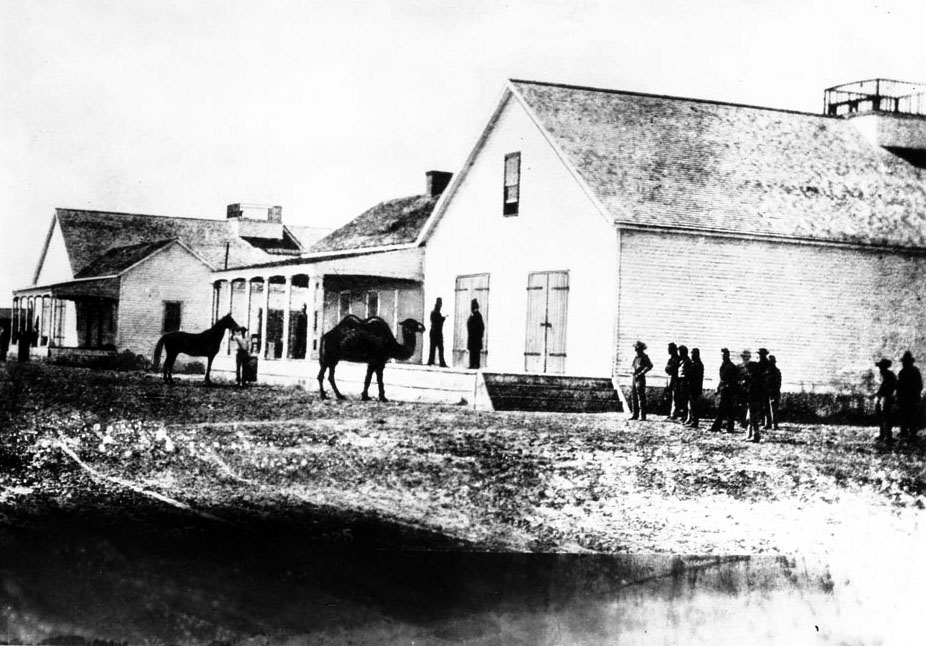 |
|
| (ca. 1865)^^ - Drum Barracks Warehouse with Camel in front ready for loading for trip to Arizona fort. |
Historical Notes During the Civil War, Phineas Banning ceded land to the Union Army to build a fort at Wilmington, the Drum Barracks. He was appointed a Brigadier General of the First Brigade of the militia, and used the title of general for the rest of his life.*^ Established in 1862, Drum Barracks became the United States military headquarters for Southern California, Arizona, and New Mexico. It was a garrison and base for supplies, and a terminus for camel pack trains operated by the Army until 1863. Abandoned in 1866, the site remains a landmark of the Civil War in California.*^* |
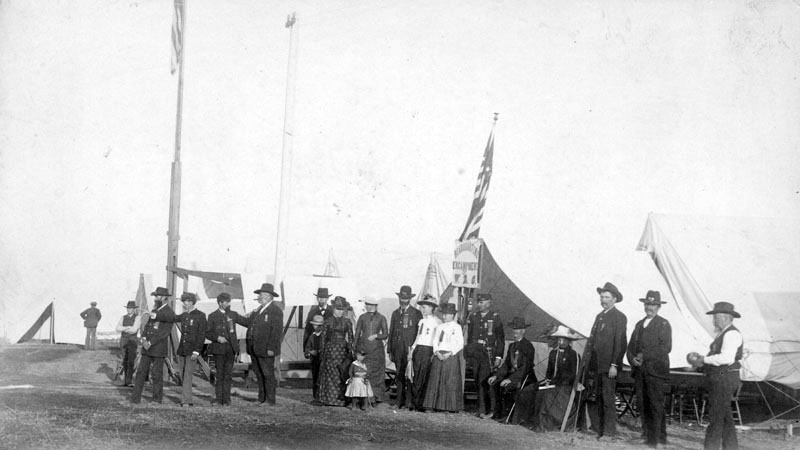 |
|
| (1889)* - Fort Drum Barracks (also possibly called Camp Burnside) encampment lasted from Aug. 10th to 19th, 1889. (Penciled on photograph are dates: 1861-1862) Photograph shows Commander Mudge, Adj't Myron F. Tarbel, comrade W. Savage among other uniformed men and women. Sign with a mounted flag reads: Headquarters encampment of W.R.C. Location: 1053 Cary St (corner Cary and Opp), Wilmington. |
Historical Notes Camp Drum and Drum Barracks get their name from Col. Richard Coulter Drum, then Assistant Adjutant General of the Army's Department of the Pacific, stationed in San Francisco, and not after a percussion instrument. There is no record that Col. Drum ever saw or set foot in the station bearing his name. During the Civil War, Camp Drum was the headquarters of the District of Southern California and the home to the California Column, commanded by Colonel James Henry Carleton. Between 2,000 and 7,000 soldiers were stationed at Camp Drum, and Wilmington became a thriving community with a population greater than Los Angeles during the war.*^ |
 |
|
| (ca. 1920)* - Fort Drum Barracks at Wilmington, which was built during the Civil War, 1051-1055 Cary Avenue. |
Historical Notes The surviving 16-room structure was the officers' quarters, which was once one of 19 similar buildings on the site. Today, the barracks is open as a museum which commemorates California's contribution to the Civil War. The building has been designated as Los Angeles Historic-Cultural Monument No. 21 (Click HERE to see complete listing).*^ The Fort Drum Barracks site, the only Civil War landmark in California, has been designated California Historical Landmark No. 169 (Click HERE to see more in California Historical Landmarks in Los Angeles County). |
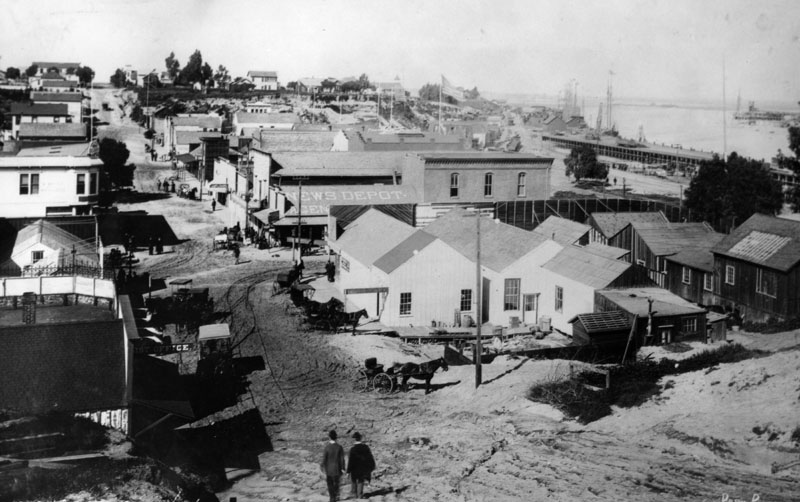 |
|
| (late 1800s)* - View of an unpaved road with horses and carriage in San Pedro. The harbor can be seen in the distance. |
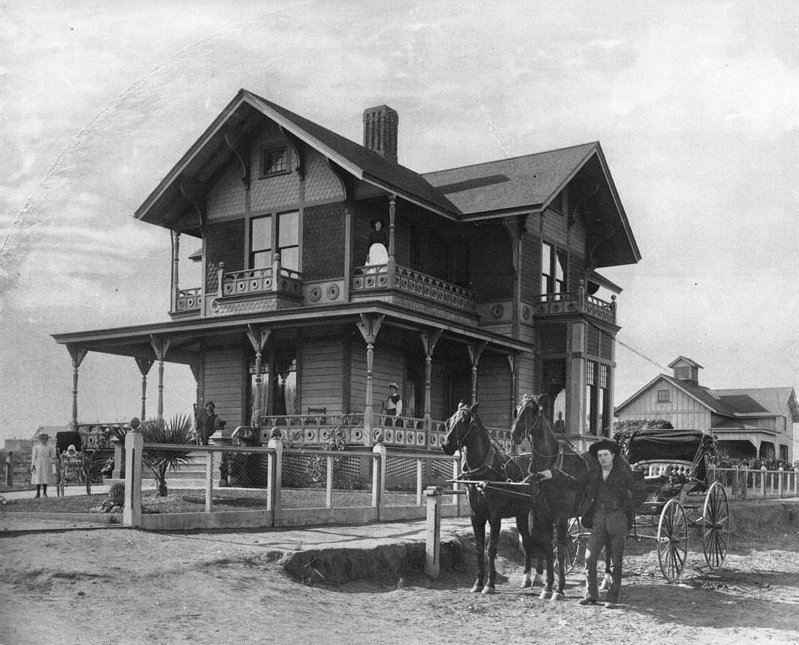 |
|
| (1880s)^^** - Home of merchant/postmaster James H. Dodson and his wife, Rudecinda Sepulveda. She is possibly the woman standing on the second floor balcony. |
Historical Notes The Victorian architecture style house was built in 1881 by the Sepulveda family as a wedding present for their daughter Rudecinda and her husband, James Dodson. It was originally located at the corner of 7th and Beacon Streets, San Pedro.*^ |
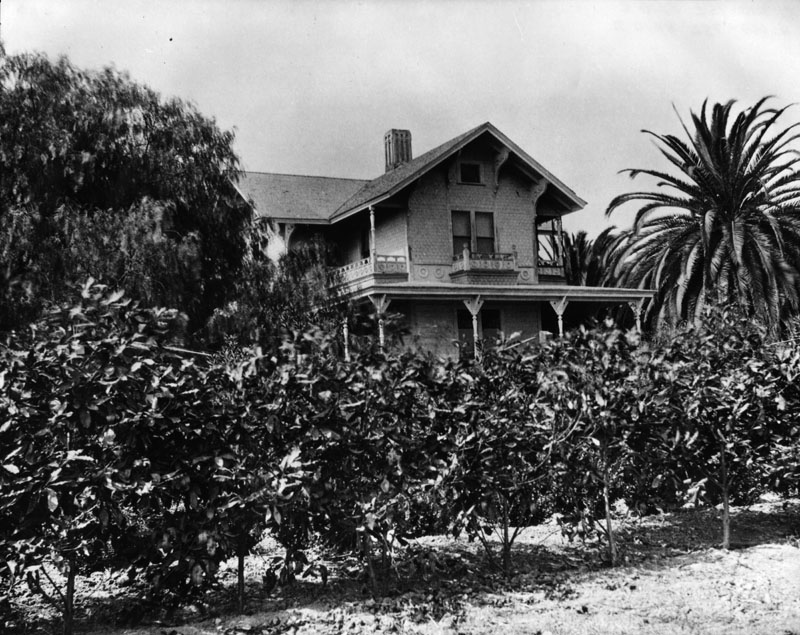 |
|
| (1890)* - A partial view of J. W. Dodson's residence can be seen above the small trees. |
Historical Notes In 1976, the James H. Dodson Residence was dedicated Los Angeles Historic-Cultural Monument No. 147 (Click HERE to see complete listing). The house is now located at 859 W. 13th St., San Pedro. It is a private residence and is not open to the public.*^ |
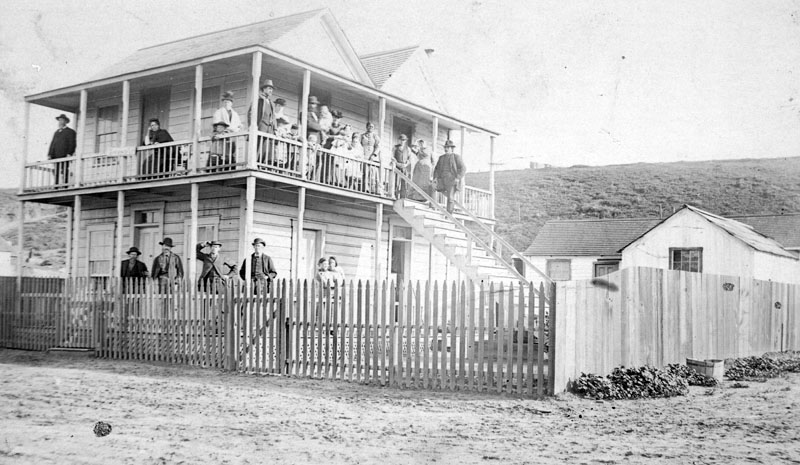 |
|
| (ca. 1890)* - Numerous people are seen outside of an unidentified two-story wooden building, which appears to be a boarding house or hotel, in San Pedro. |
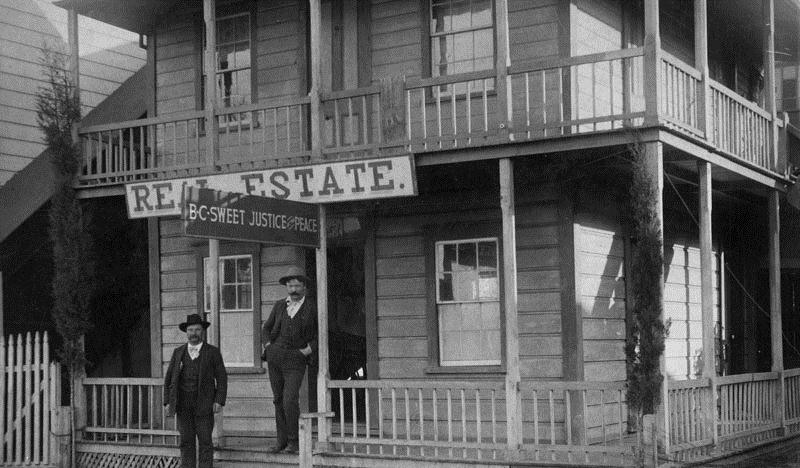 |
|
| (late 1800s)* - Two men are standing at the entrance of a real estate office in San Pedro. Additional sign above entrance reads: B.C. Sweet, justice of the peace. |
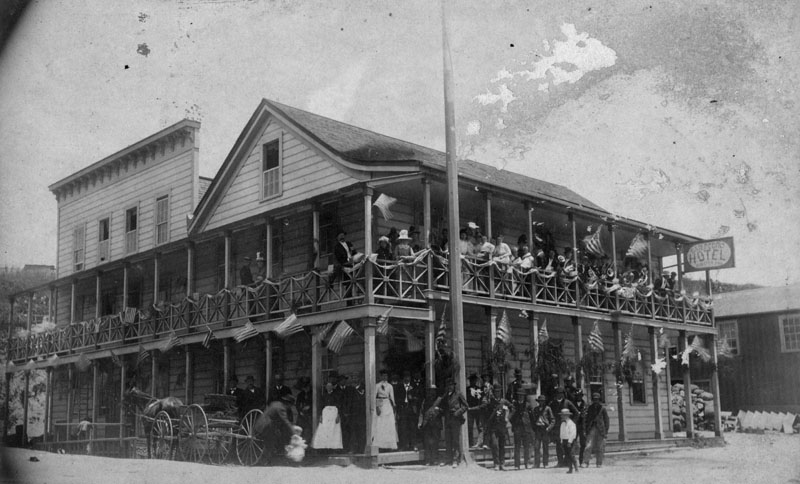 |
|
| (ca. 1898)* - Group portrait of people standing on the ground floor and along the balcony of the second floor of the San Pedro Hotel. Many flags are hanging around the hotel. A horse-drawn carriage is parked alongside the hotel. |
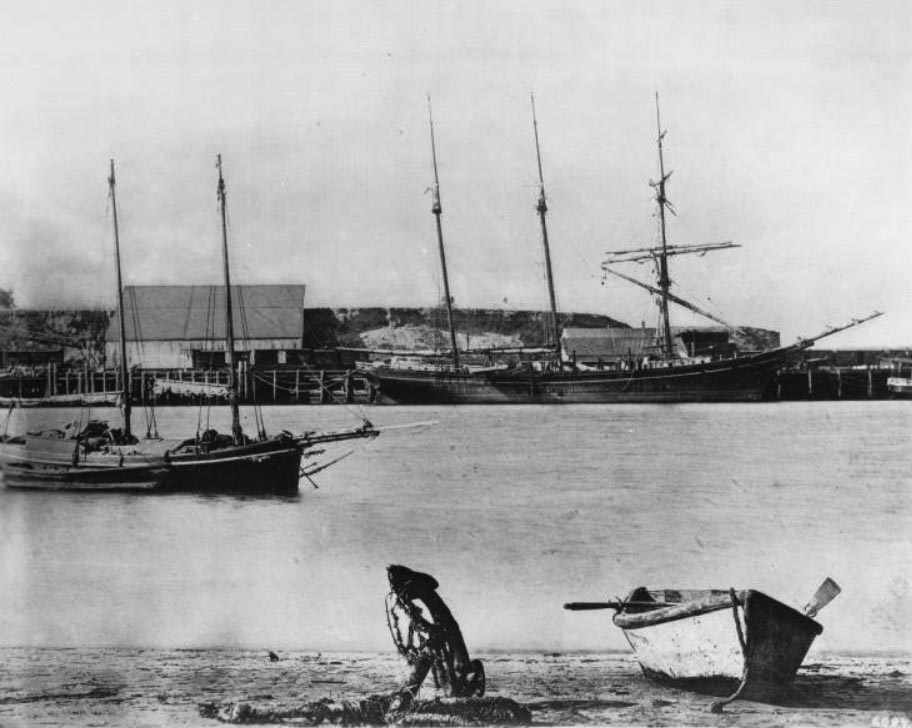 |
|
| (ca. 1885)^^ - View of San Pedro Harbor showing the shipping docks and, in the foreground, an orphaned anchor lying on the beach next to a rowboat. In the background are ships with their sails down, one of which is docked by the pier on the other side of the water. |
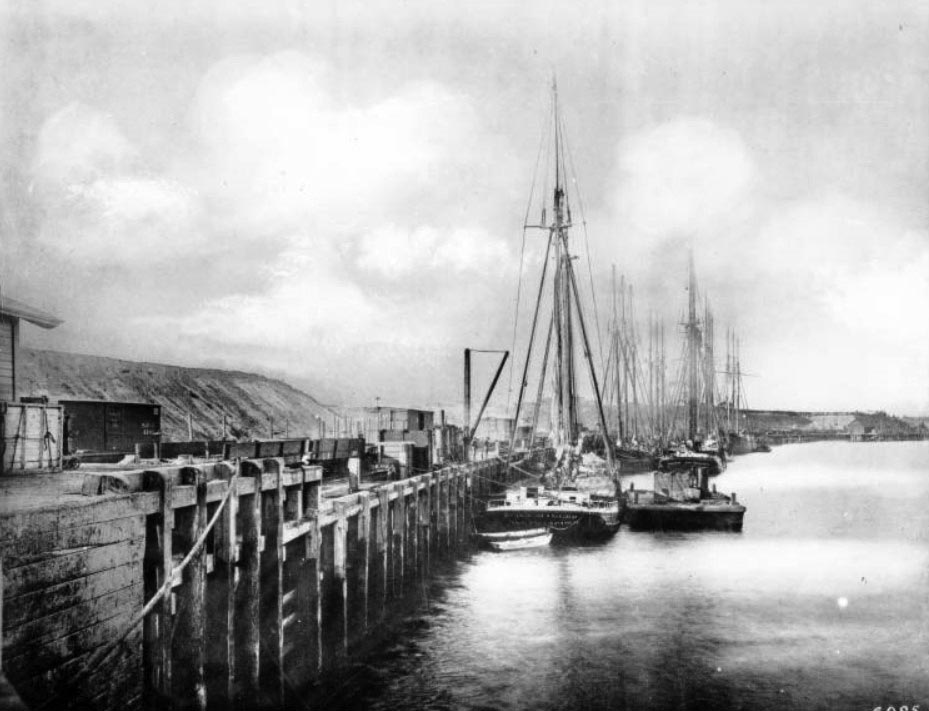 |
|
| (ca. 1885)^^ - Photograph of sailing ships tied up along the pier at San Pedro Harbor. The Eliza Miller from San Francisco is in the center. The ships are docked next to the pier in pairs and all of their sails are down. A Southern Pacific Railroad car is located on the pier to left. |
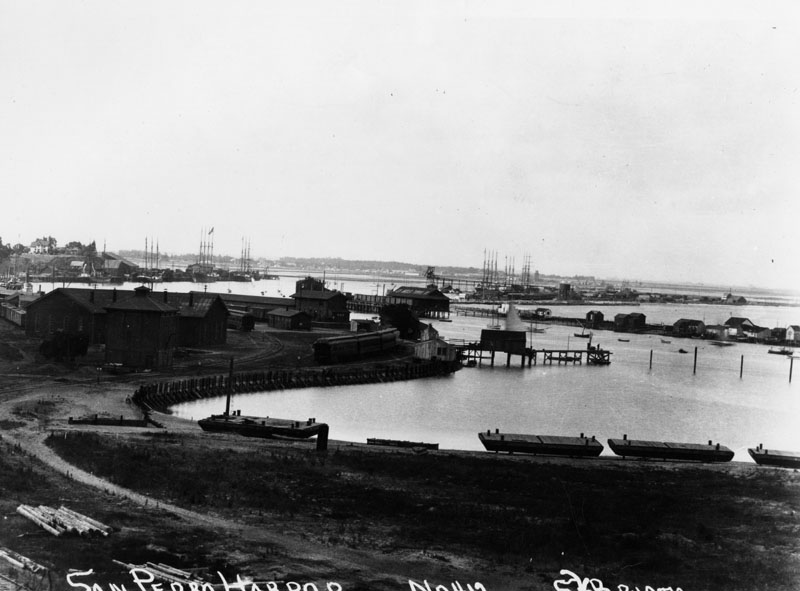 |
|
| (ca. 1890)* - Early view of San Pedro Harbor. Several ships can be seen anchored in the harbor. Train cars sit my a small wharf in the center of the photo. |
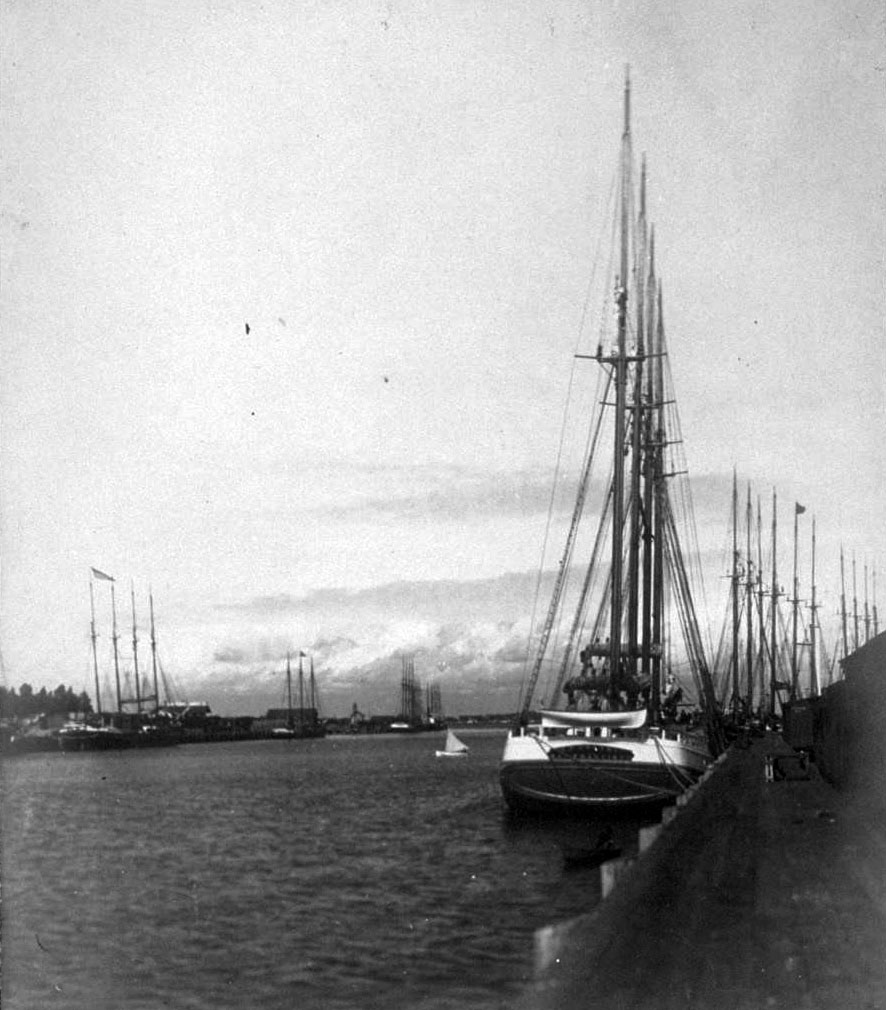 |
|
| (ca. 1890s)^#^^ - Close-up view of a crowded San Pedro Harbor, showing several “Tall Ships” docked along the wharf. |
 |
|
| (1885)^*- View of San Pedro Harbor showing two steam boats and a tall ship in the foreground with Deadman's Island seen in the distance. |
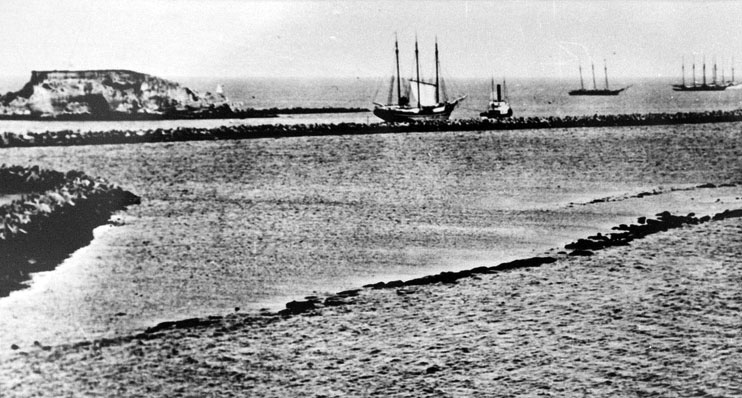 |
|
| (1880s)#^ - Every year freshwater floods would cause the harbor to fill with sediments. |
Historical Notes To solve the sediment problem two breakwaters were built during 1871-93. One connected Rattlesnake Island with Deadman's Island and the other jutted out from Timm's Landing towards Deadman's Island. Those breakwaters caused the tidal flows to scour the ocean floor removing sand and mud. The building of these breakwaters gave birth to the main shipping channel which is still in use today. |
Lumber in the Harbor
 |
|
| (ca. 1876)* - View of Deadman's Island and breakwaters in the background. Stacks of lumber is stored in a lumber yard (foreground). |
Historical Notes Lumber was one of the main imports into the San Pedro Harbor in the late 1800s and early 1900s due to the high demand for construction materials to support the rapid growth of Los Angeles. |
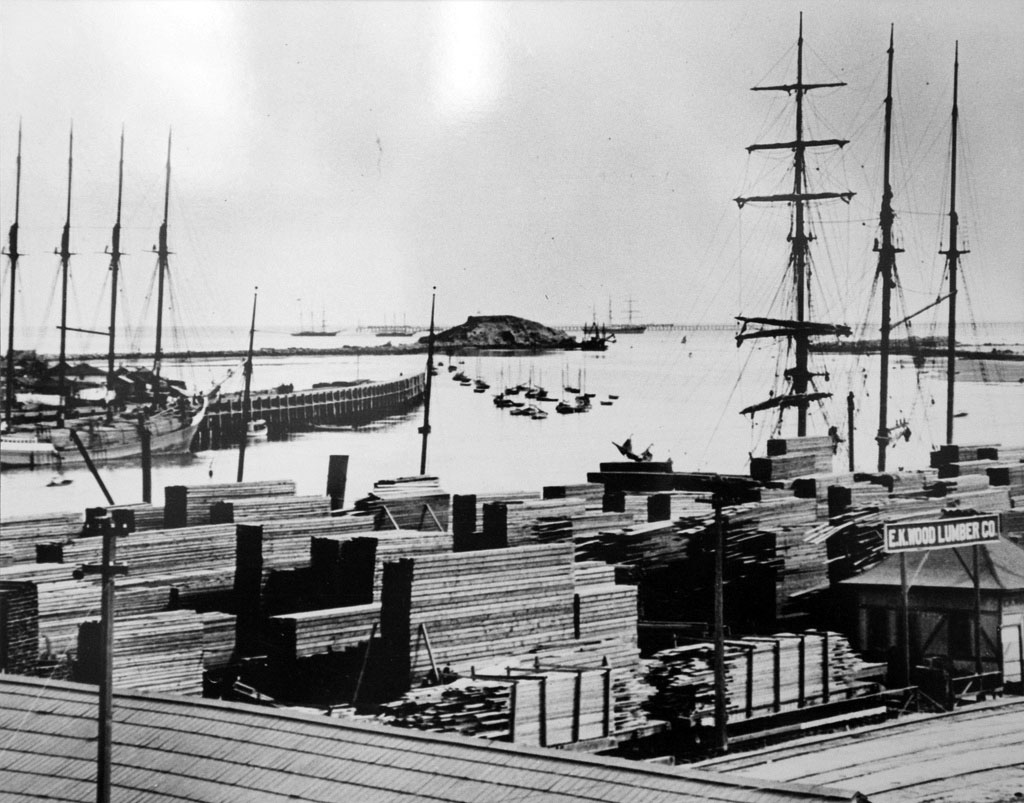 |
|
| (1880s)#^ - View of stacks of lumber sitting on the shore waiting to be transported to Los Angeles. |
Historical Notes Los Angeles grew rapidly and the need for building materials escalated. The harbor grew to meet this demand for handling ships filled with imported lumber. Wood's Lumber Company sits on what is now present day Ports o' Call. |
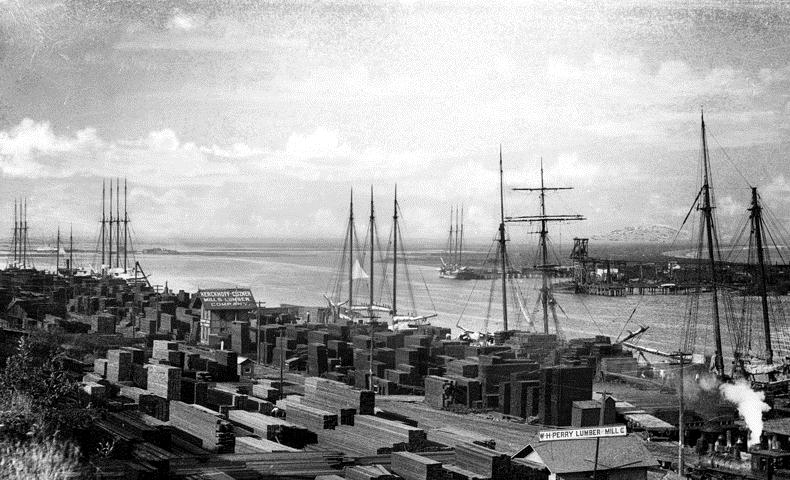 |
|
| (ca. 1888)*#* - Shipping in San Pedro Port of Los Angeles. Stacks of lumber can be seen sitting along the harbor waiting to be transported. |
Historical Notes In June and July of 1887 alone, 25 million board feet of lumber were unloaded at San Pedro Harbor. This influx of lumber imports facilitated the expansion of Los Angeles and surrounding areas, which were experiencing a population boom. |
 |
|
| (ca. 1899)* - Early view of the Inner Harbor and Terminal Island in San Pedro. Storage of lumber can be seen on both sides of the channel. A railroad track runs alongside stacks of lumber in the foreground. |
Historical Notes The harbor served as a key entry point for lumber shipments, particularly from the Pacific Northwest, to meet the building needs of the booming Los Angeles region. Stacks of lumber can be seen in many photographs of the San Pedro waterfront from that era. |
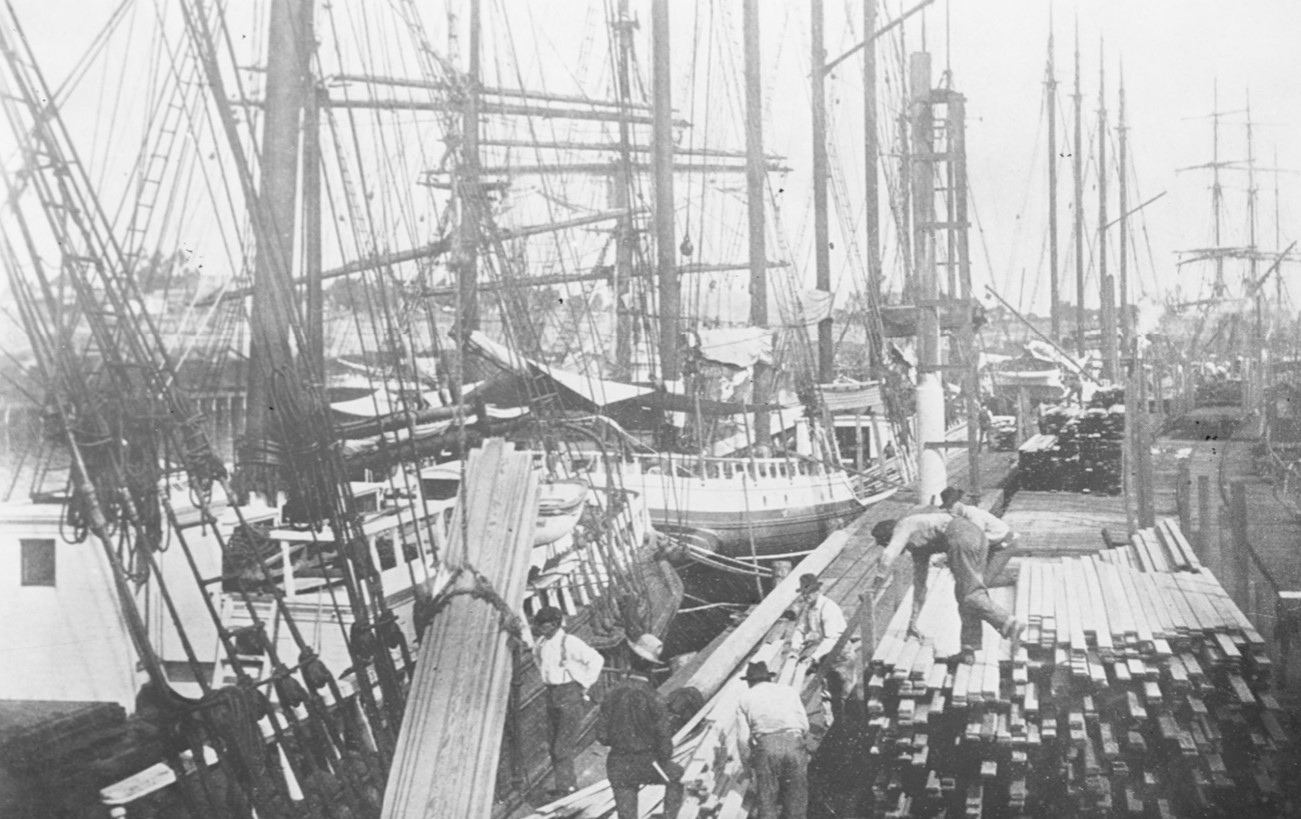 |
|
| (ca. 1896)* - Workers loading lumber on the wharf at San Pedro Harbor (present-day Los Angeles Harbor), with ships moored along the dock. |
Historical Notes The lumber trade through San Pedro continued to thrive until the Great Depression, playing a vital role in supplying construction materials for Los Angeles' rapid urbanization in the late 19th and early 20th centuries. |
Tall Masts
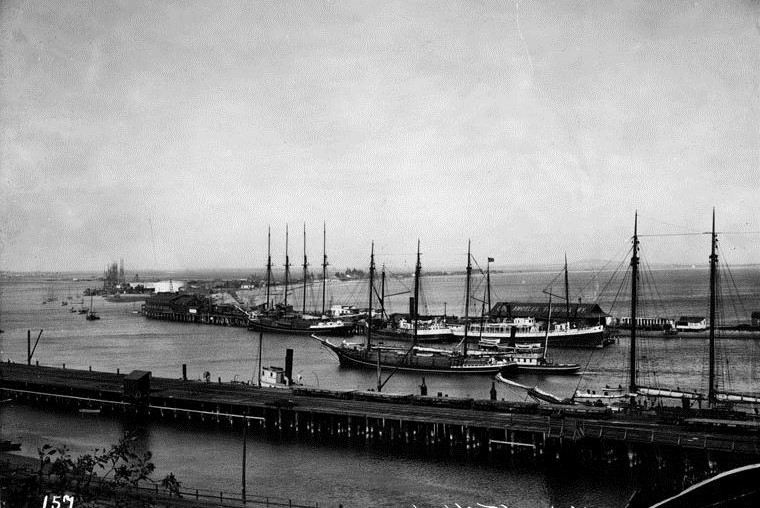 |
|
| (ca. 1890)* - Early view of L.A. Harbor showing a ship loaded with lumber navigating through the harbor. Los Angeles Terminal Ry. building is in the background. Railroad tracks can be seen on the docks in the foreground. |
 |
|
| (ca. 1890)* - A railroad train waits as workers unload lumber from their ship onto a railroad cart. |
Historical Notes After Banning's death in 1885 his sons pursued their interests in promoting the port, which handled 500,000 tons of shipping in that year. The Southern Pacific Railroad and Collis P. Huntington wanted to create Port Los Angeles at Santa Monica, and built the Long Wharf there in 1893. However the Los Angeles Times publisher Harrison Gray Otis and U.S. Senator Stephen White pushed for federal support of the Port of Los Angeles at San Pedro Bay. |
Santa Monica Long Wharf - San Pedro Harbor's Early Competition
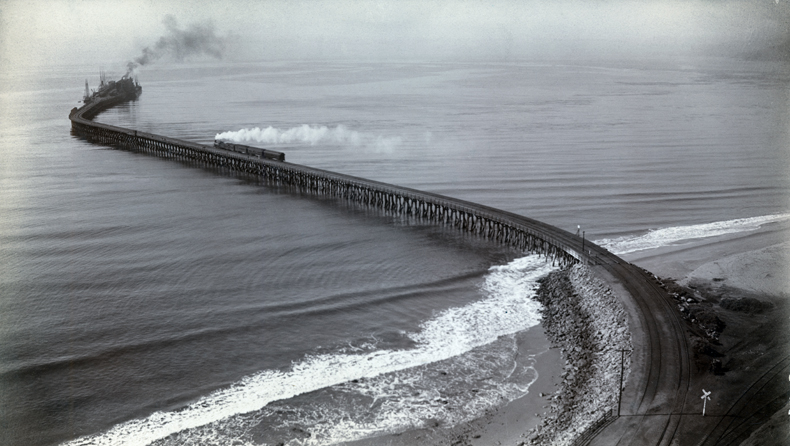 |
|
| (ca. 1893)* - Aerial view of the Southern Pacific Mammoth Wharf, Port Los Angeles, Calif. The wharf was also known as the old Santa Monica Long Wharf, north of Canyon. A white cloud of smoke can be seen from a train travelling on the tracks to the business end, at the end of the wharf. |
Historical Notes In 1893, Southern Pacific built the Long Wharf at the north end of Santa Monica to accommodate large ships and it was dubbed Port Los Angeles. At the time it was constructed, it was the longest pier in the world at 4700 feet, and accommodated a train. A controversy erupted over where to locate the seaport for the City of Los Angeles. The SP preferred Santa Monica, while others advocated for San Pedro Bay. San Pedro Bay was selected by the United States Congress in 1897. Still, the Long Wharf acted as the major port of call for Los Angeles until 1903. |
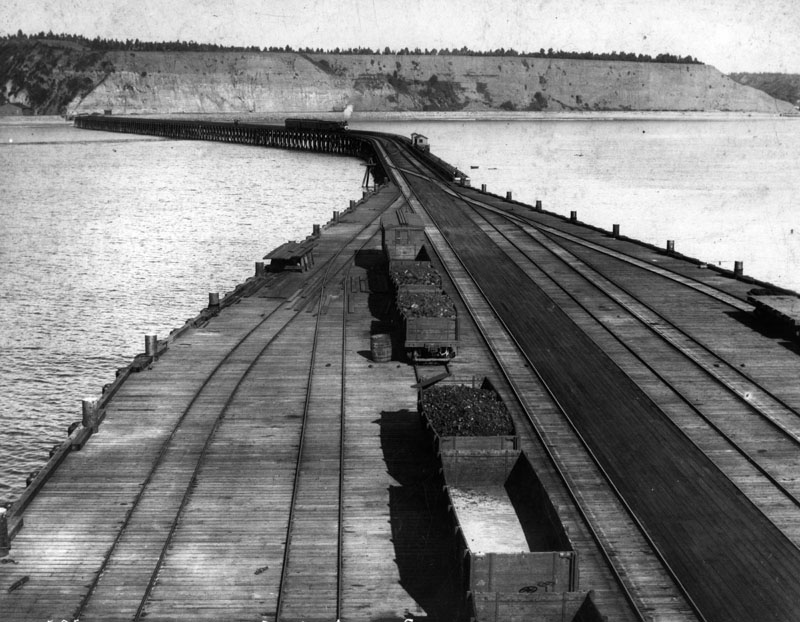 |
|
| (ca. 1893)* - Southern Pacific wharf, 4700 feet long, for the projected Port of Los Angeles, near Santa Monica, built in 1893. View is from the end of the wharf towards the shore. |
Historical Notes The Long Wharf was designated as California HIstorical Landmark No. 881 (Click HERE to see the California Historical Landmark Listing for LA County). |
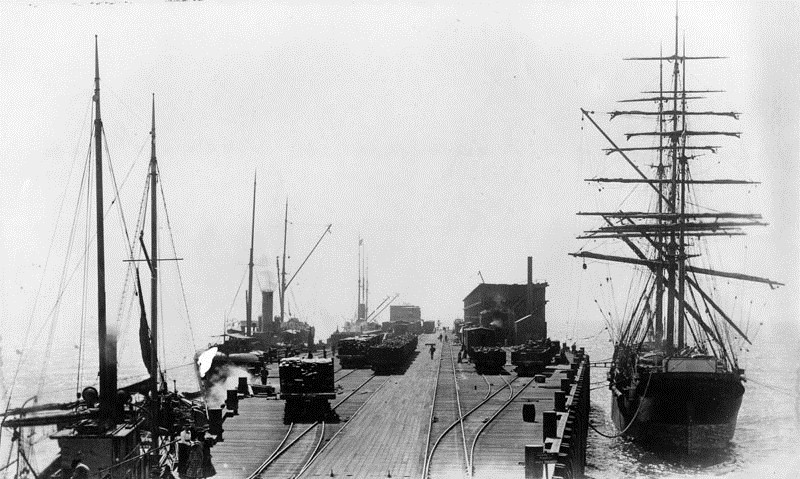 |
|
| (1898)* - Photo shows the business end of the mammoth wharf in Santa Monica. This wharf was the longest in the world at 4,700 feet long. |
Historical Notes Click HERE for more on the Santa Monica Long Wharf |
* * * * * |
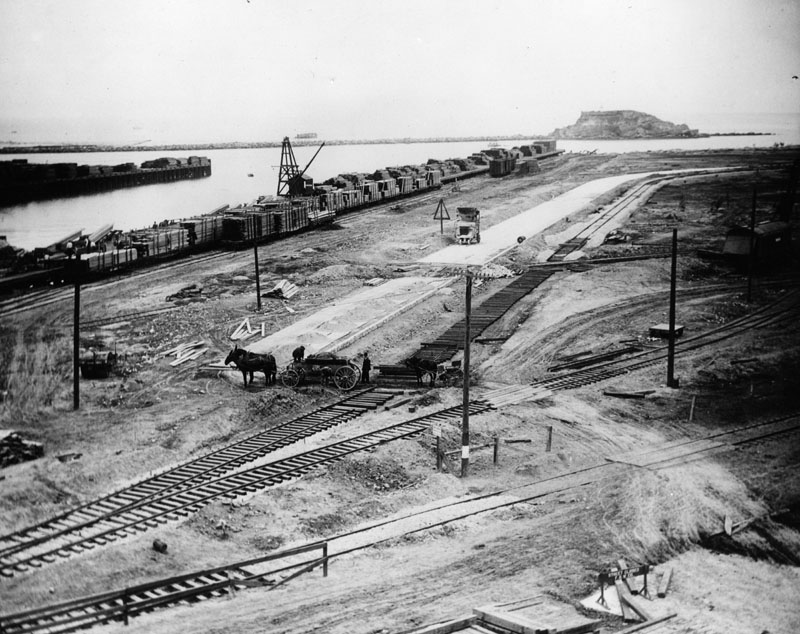 |
|
| (ca. 1880s)* - Early view of L.A. Harbor. Lumber is stacked on railroad cars along side of the channel. It appears that two men our unloading horse-drawn wagon to repair or complete the rail line. Breakwaters and Deadman's Island can be seen in the background. |
Historical Notes The Free Harbor Fight was settled when San Pedro was endorsed in 1897 by a commission headed by Rear Admiral John C. Walker (who later went to become the chair of the Isthmian Canal Commission in 1904). With U.S government support breakwater construction began in 1899 and the area was annexed to Los Angeles in 1909. |
 |
|
| (ca. 1880s)* - Early view of L.A. Harbor. Lumber is stacked on railroad cars along side of the channel. It appears that two men our unloading horse-drawn wagon to repair or complete the rail line. Breakwaters and Deadman's Island can be seen in the background. Image enhanced and colorized by Richard Holoff |
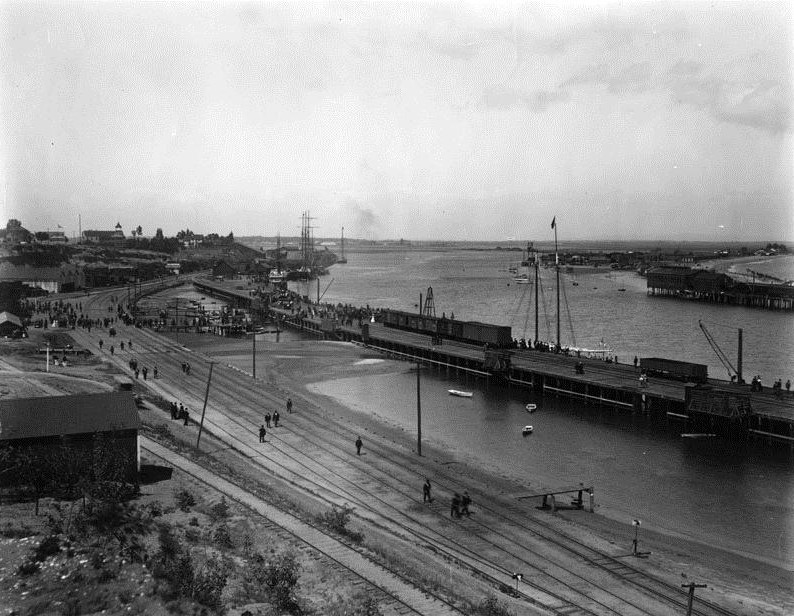 |
|
| (ca. 1890s)* - Panoramic view of L.A. Harbor showing the wharf with railroad box cars and yachts anchored. In the foreground people are walking along the waterfront. |
Point Fermin Lighthouse
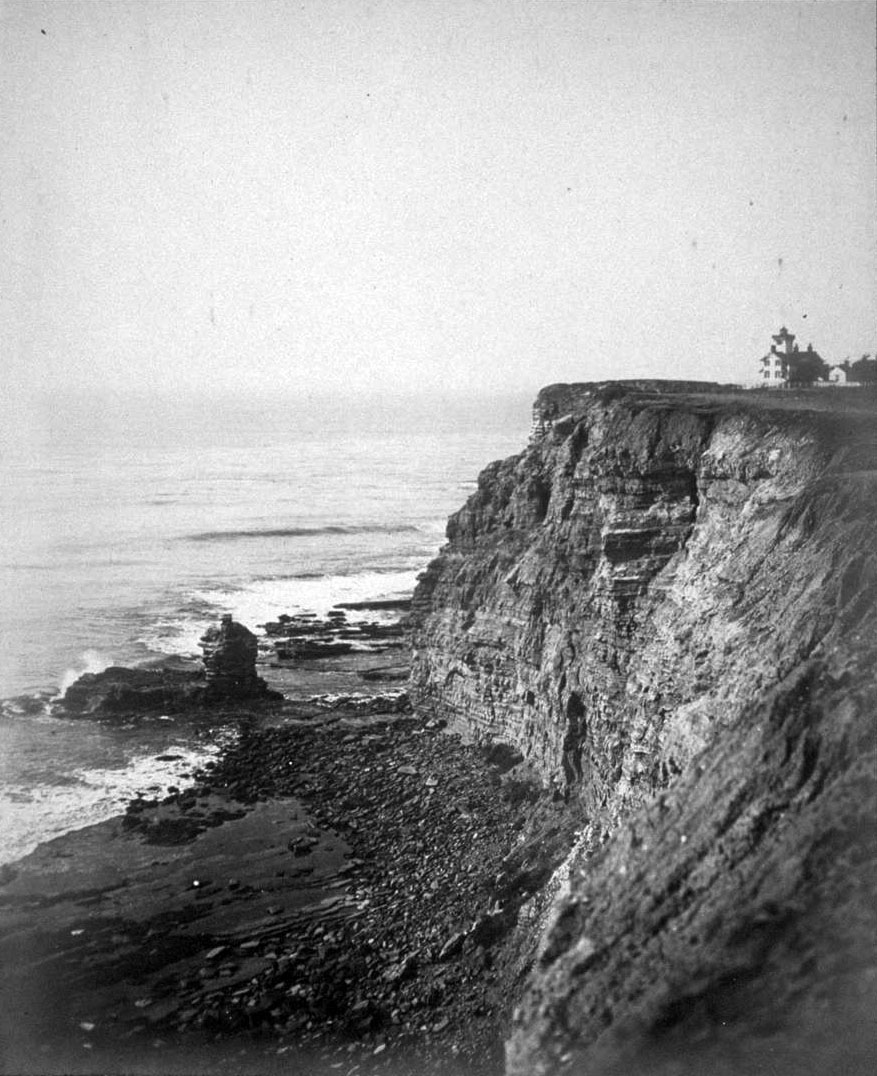 |
|
| (ca. 1870s)^#^^ - View of Point Fermin Lighthouse near the edge of the cliffs at San Pedro. |
Historical Notes Point Fermin Lighthouse was built in 1874. It was the first navigational light into the San Pedro Bay. Phineas Banning, with the support of many local businessmen, petitioned the Federal Government and the US Lighthouse Board to place a lighthouse on the point in 1854. Although the Lighthouse Board agreed funding and land, disputes delayed its construction until 1874. Point Fermin marks the southern-most point of the City of Los Angeles. It was named after Father Fermín de Francisco Lasuén by British explorer George Vancouver. When Vancouver visited in 1793 he wanted to thank the Father for his hospitality at the mission in Carmel. Father Padre Fermín de Francisco Lasuén also founded Mission San Fernando Rey de Españaon (the San Fernando Mission). Sometimes called the "forgotten friar," Padre Fermín Lasuén actually governed the California Mission system three years longer than his more famous predecessor, Padre Junipero Serra. Click HERE to see more in Early Views of the San Fernando Mission. |
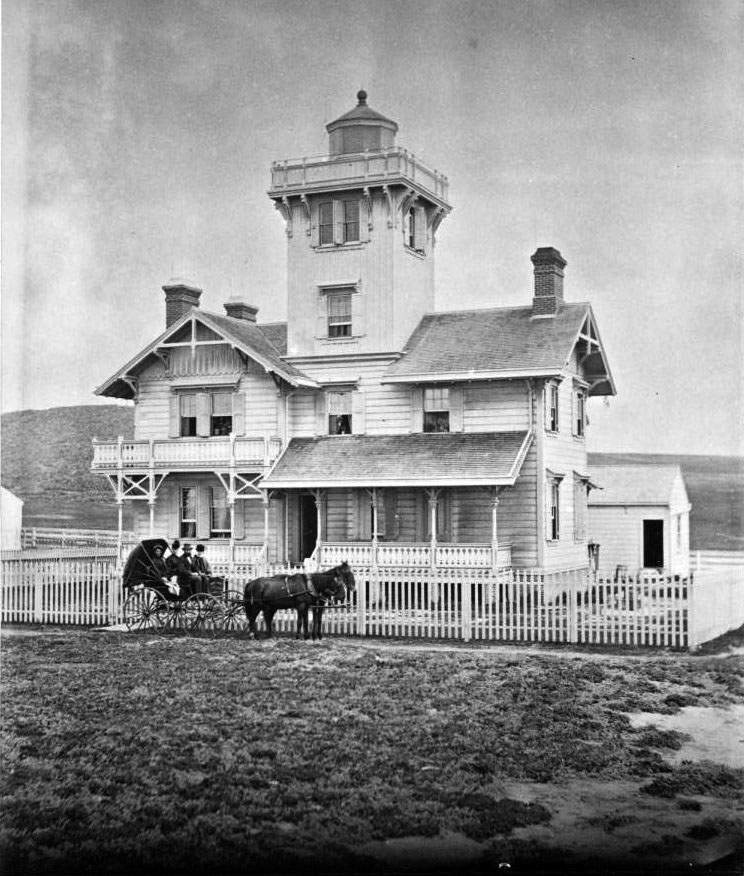 |
|
| (ca. 1875)#* - Exterior view of the lighthouse at Point Fermin, San Pedro. Four people pose for the camera as they sit in a horse-drawn carriage in front of the white picket fence. |
Historical Notes Paul J. Pelz, a draftsman for the US Lighthouse Board, designed the Stick Style Victorian lighthouse. The design was used for six lighthouses built between 1873 and 1874, of which three are still standing, East Brothers in San Francisco Bay, Hereford Light in New Jersey, and Point Fermin. The Stick Style is an early Victorian architectural style and is simpler in design and decoration than the later high Victorian period. It is characterized by its gabled roofs, horizontal siding, decorative cross beams and hand carved porch railings. The structure stands 30 feet tall and was built in 1874 at Point Fermin to guide mariners. The Lighthouse has a brick foundation and a wood frame, which was built with lumber from the California Redwoods. |
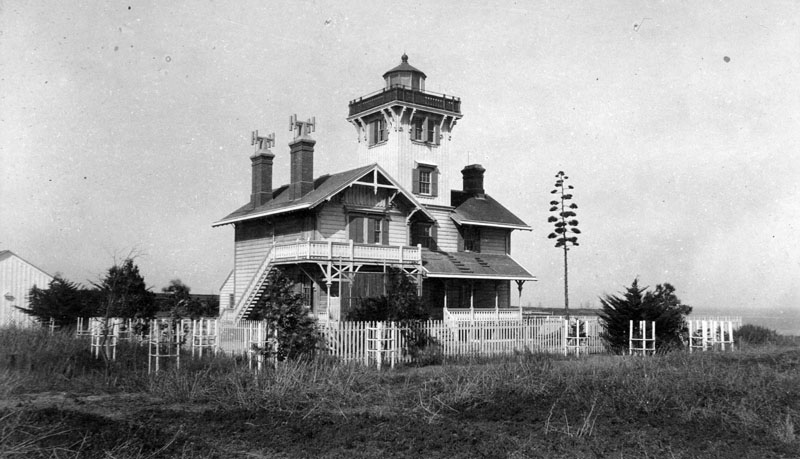 |
|
| (ca. 1890)** - Exterior view of the Victorian-style Point Fermin Lighthouse, located at 807 W. Paseo Del Mar in San Pedro on the Palos Verdes Peninsula. |
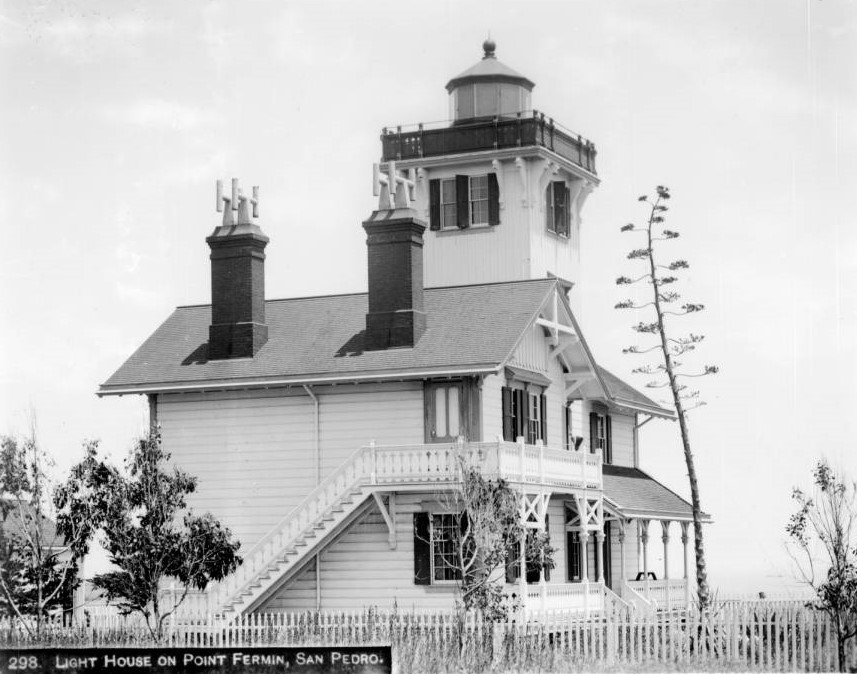 |
|
| (1890)* - Profile view of the lighthouse on Point Fermin, San Pedro. A picket fence surrounds the wooden two-story house with the square tower supporting the light. Several trees are in the yard. |
Historical Notes In 1941 the light was extinguished due to the bombing of Pearl Harbor. There was fear that the light would serve as a beacon for enemy planes and ships. Later, the lantern room and gallery were removed. They were replaced by a lookout shack that remained for the next 30 years, and was referred to as "the chicken coop" by locals. |
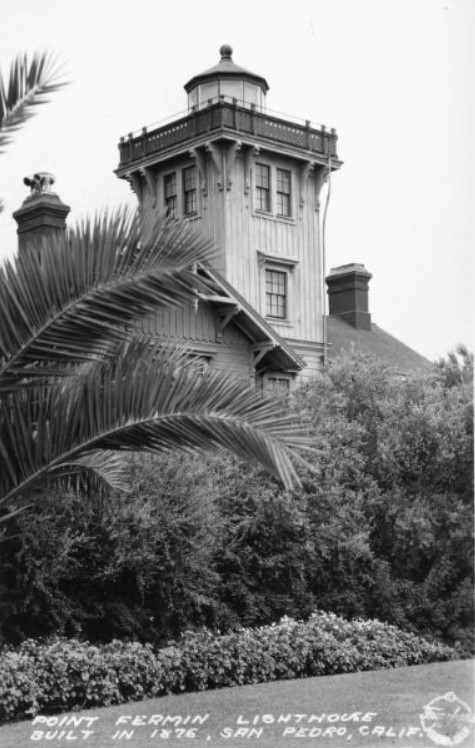 |
|
| (1937)^#^^ - Postcard view of the Point Fermin Lighthouse. Note on postcard reads: "Built in 1876", however, all other records indicate it was built in 1874. |
Historical Notes Point Fermin Lighthouse was saved from demolition in 1972 and the light was added to the National Register of Historic Places. It was refurbished in 1974, and a new lantern room and gallery were added.** In 2002, the lighthouse was restored, retrofitted, and rehabilitated for public access with funds from the City of Los Angeles, the Port of Los Angeles, and the State of California. The lighthouse was opened to the public on November 1, 2003 under the management of the Department of Recreation and Parks for the City of Los Angeles. Volunteers from the Point Fermin Lighthouse Society serve as tour guides and help to keep the lighthouse open to the public. |
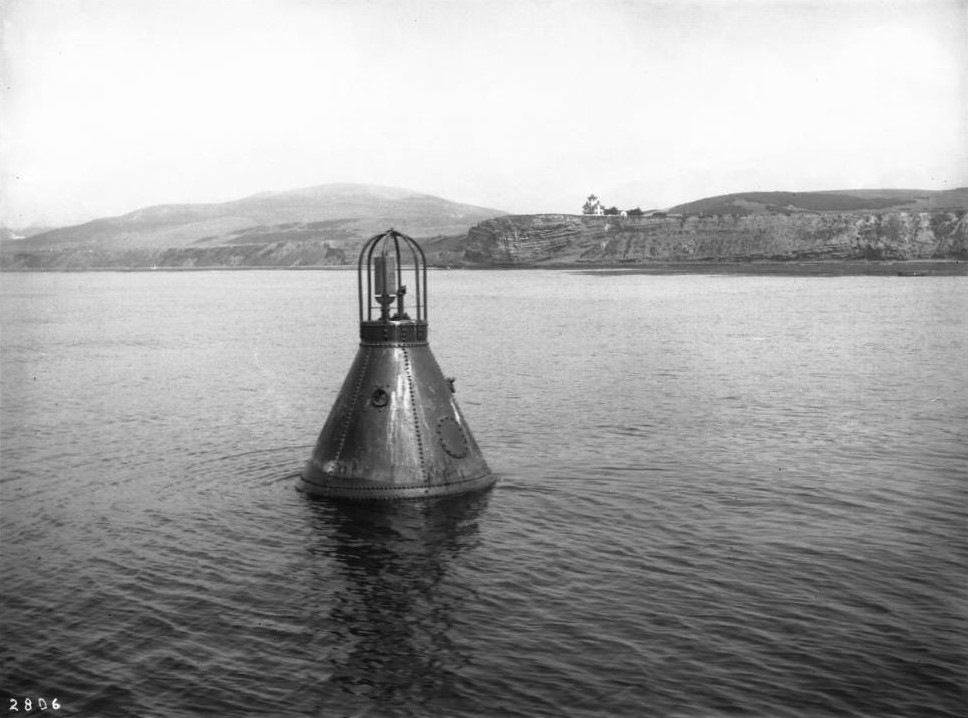 |
|
| (1890)#^ - Close-up view of a whistling buoy in calm water off Point Fermin. The Point Fermin lighthouse can be seen at the top of a cliff in the background. |
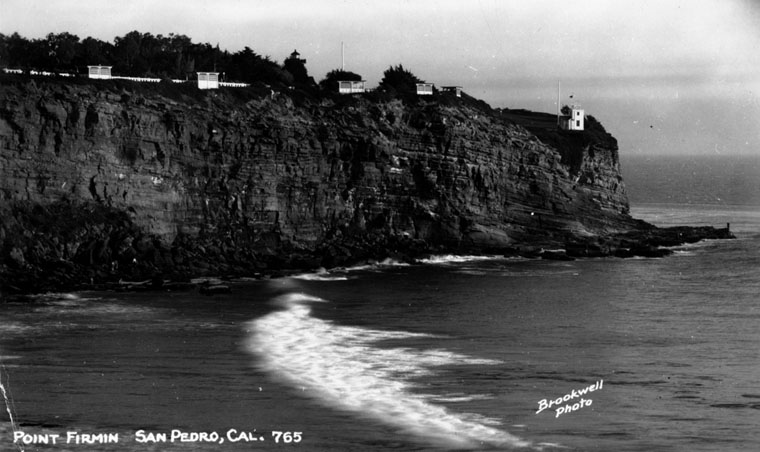 |
|
| (n.d.)* - A postcard view of the scenic Point Fermin, showing the cliffs and ocean. |
* * * * * |
Before the Port: San Pedro & Los Angeles Harbor (1885–1900)
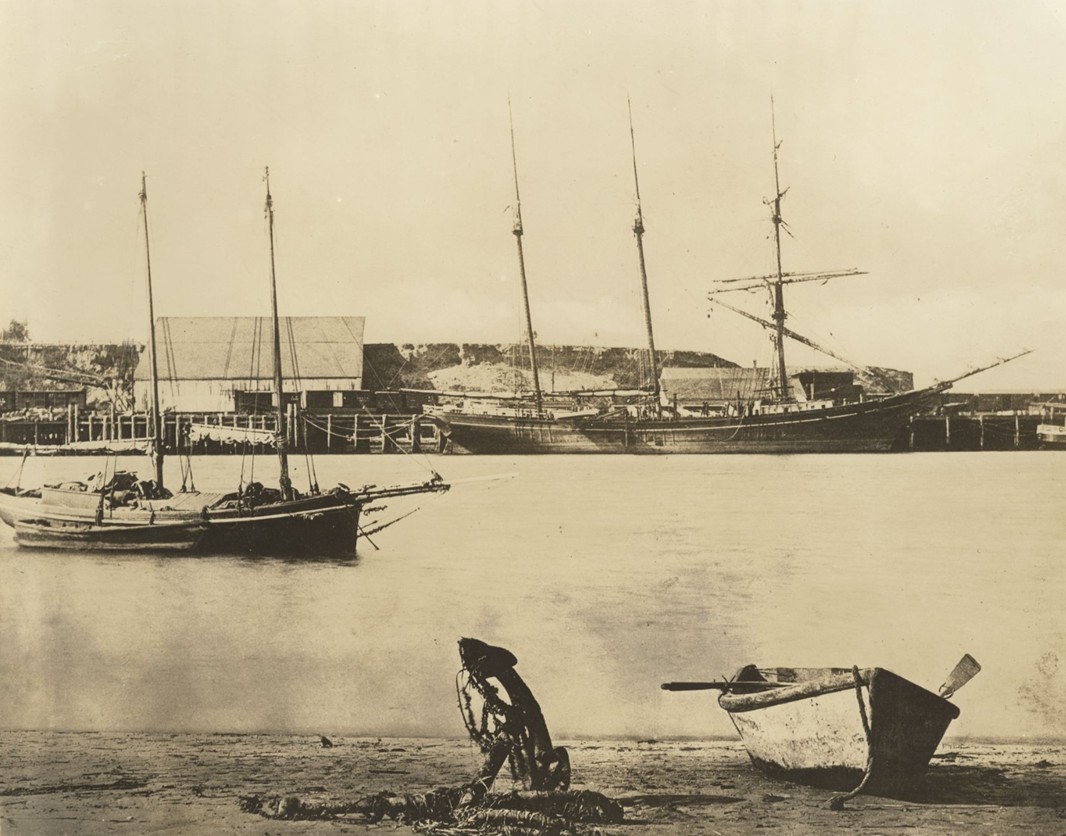 |
|
| (ca. 1885)* - A three-masted sailing ship is moored at the early San Pedro wharf. In the foreground, a small rowboat rests with oars visible, and a ship’s anchor stands upright in the sand. The scene shows the simplicity of harbor operations prior to any major infrastructure. Photo by C. C. Pierce. |
Historical Notes In the 1880s, San Pedro’s harbor remained largely undeveloped, relying on shallow-draft vessels and hand-loaded cargo. Deep water access was limited, which made transferring goods inefficient. This early image captures the modest scale of operations before federal investments began to reshape the harbor. |
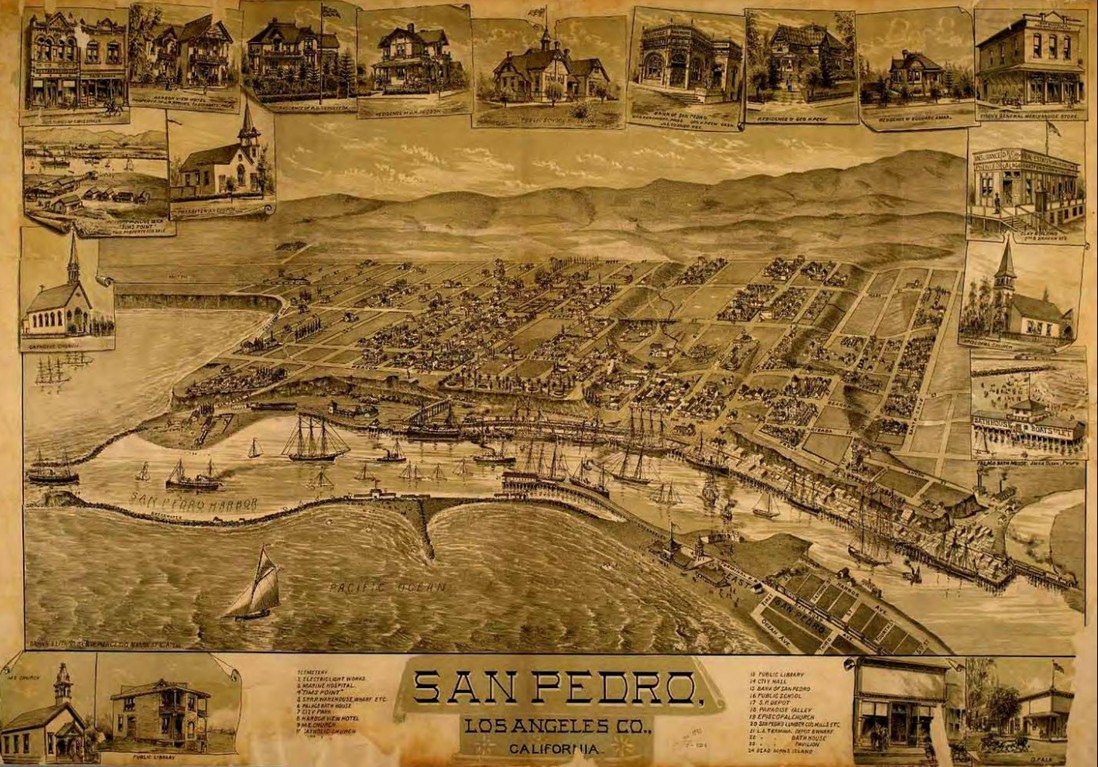 |
|
| (1893)* - This early map of San Pedro, drawn by Bruce W. Pierce, shows the town layout before major dredging and breakwater work began. |
Historical Notes This 1893 map shows San Pedro before its integration into the larger Los Angeles Harbor complex. At the time, shipping interests were vying for federal support to dredge the channel and construct protective breakwaters. The town’s strategic location near the Los Angeles basin made it a natural candidate for port development. |
 |
|
| (ca. 1890)* - Rowboats wait to ferry passengers to a nearby bath house. Signs reading “Boats to Let” reflect a mix of leisure and utility, while the storefronts and bluff behind hint at a town just beginning to grow. Photo from the Ernest Marquez Collection. |
Historical Notes In addition to freight activity, early San Pedro served as a modest seaside destination. Bath houses were popular in the 1880s–90s, and small boats ferried visitors from larger vessels or docks. These casual scenes would soon give way to more industrial waterfront development. |
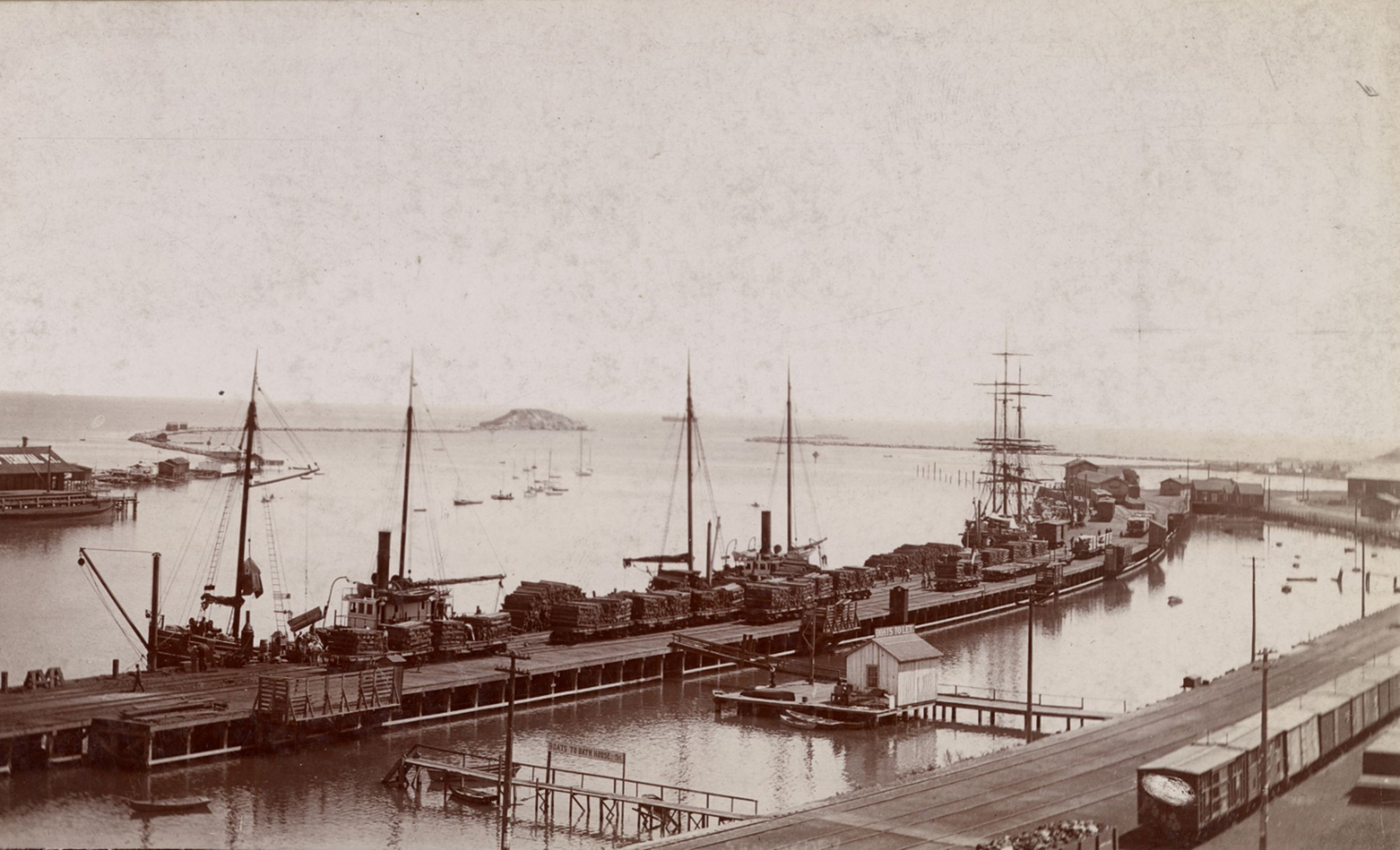 |
|
| (ca. 1890)* - Freight and Rail Activity at the Wharf. Freight operations in full swing along the San Pedro waterfront. Loaded pallets sit beside rail tracks, and small boats are docked along the wooden pier. |
Historical Notes By 1890, informal freight operations had begun integrating with rail systems. Before the Harbor Commission existed, several private companies extended tracks along the waterfront to connect with arriving ships. This marked the beginning of intermodal transport in San Pedro. |
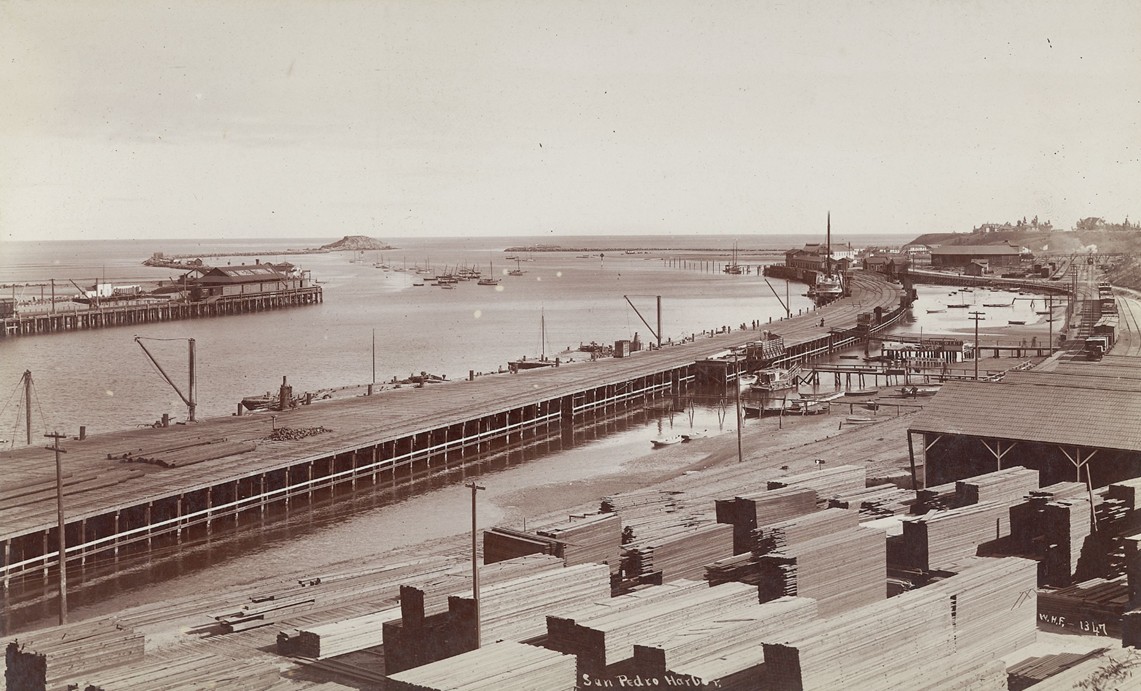 |
|
| (ca. 1895)* – Stacked lumber and rail tracks dominate the San Pedro wharf scene. These materials supported Los Angeles’s construction boom of the 1890s. Photo by William H. Fletcher. |
Historical Notes As Los Angeles expanded rapidly in the 1890s, lumber became the harbor’s most critical import. San Pedro served as a staging area for building materials shipped from the Pacific Northwest and offloaded directly into Southern California’s growing rail network. |
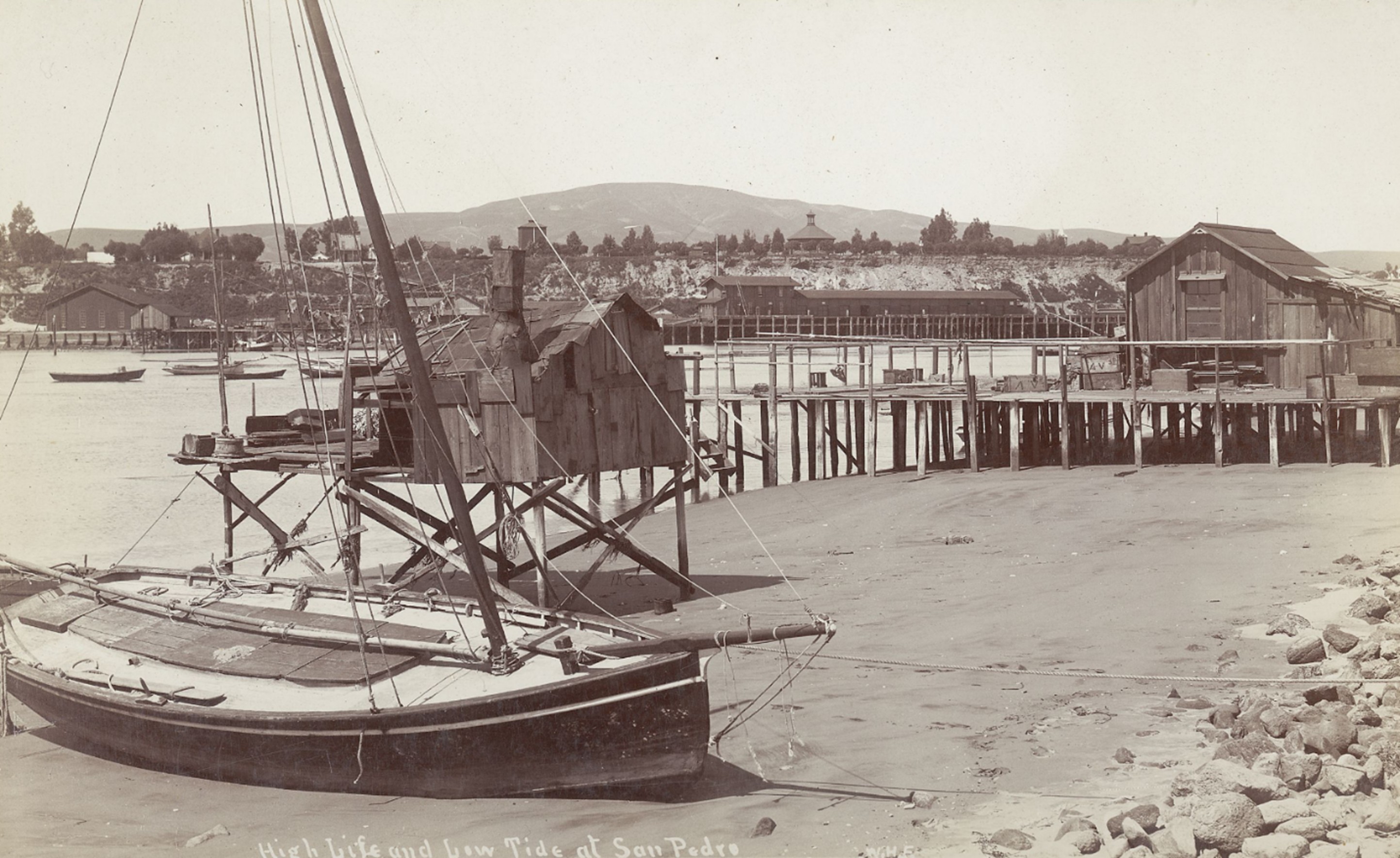 |
|
| (1895)* - A beached sailboat sits on the San Pedro shoreline during low tide. In the background: piers, simple buildings, and the bluffs lining the bay. Photo by William H. Fletcher. |
Historical Notes The unprotected coastline and lack of adequate piers often left smaller vessels stranded at low tide. Before breakwaters were built, tidal shifts and unpredictable surf posed constant threats to early shipping efforts in the harbor. |
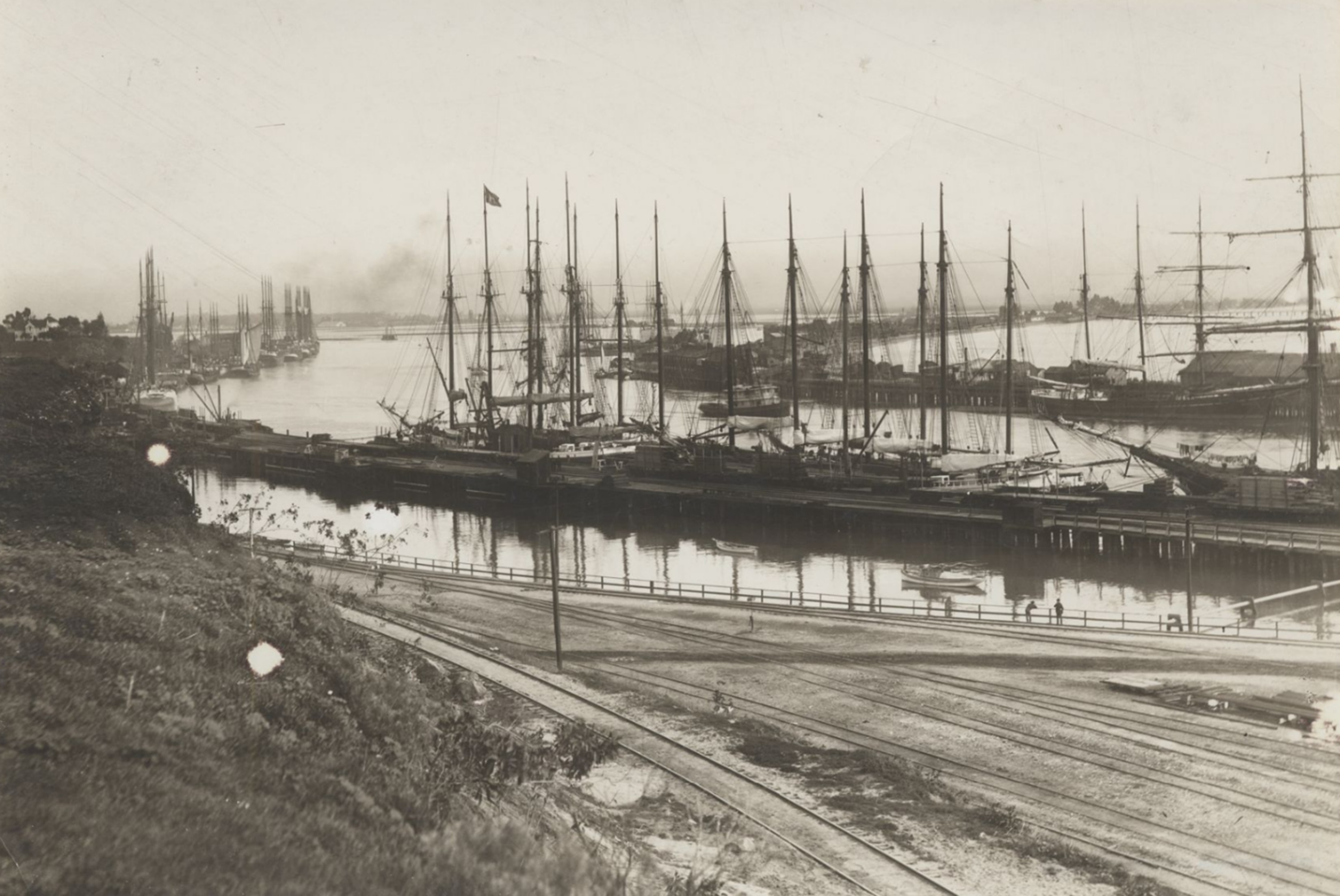 |
|
| (ca. 1895)* - An elevated view of the San Pedro waterfront reveals dozens of tall-masted ships along the docks, with rail tracks in the foreground. |
Historical Notes This view highlights the dense maritime traffic that defined the mid-1890s. Multiple tall ships are visible at anchor, while rail spurs run along the dock—evidence of the harbor’s growing importance in coastal shipping, especially before containerization. |
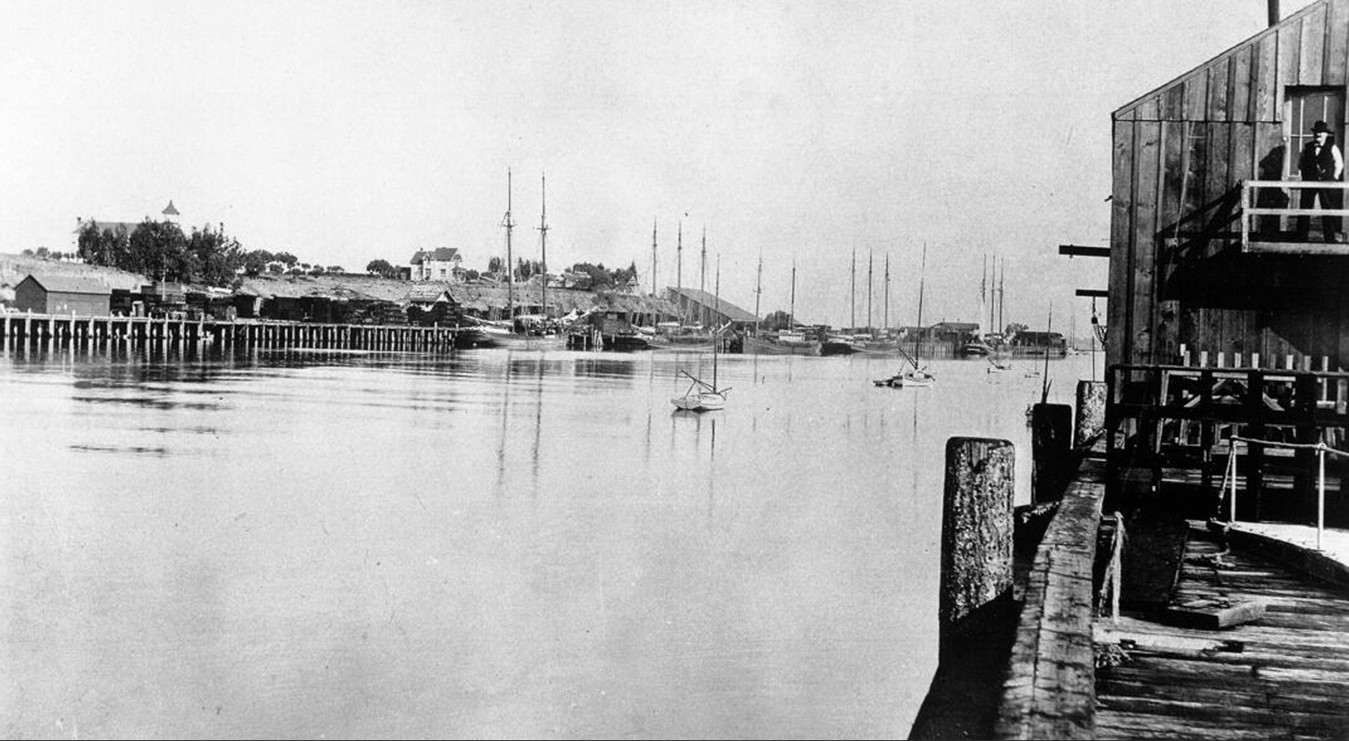 |
|
| (ca. 1896)* - Photograph taken from Terminal Island shows San Pedro Harbor looking inland. The Knob Hill Hospital sits on the bluff to the left, and the cupola of the Clarence Hotel (later the Hotel San Pedro) can be seen in the distance. |
Historical Notes This perspective from Terminal Island shows Knob Hill Hospital and the Clarence Hotel overlooking the harbor. By the early 20th century, Terminal Island would evolve from a small sandbar into a major industrial and naval facility, thanks in part to harbor dredging efforts that began in 1899. |
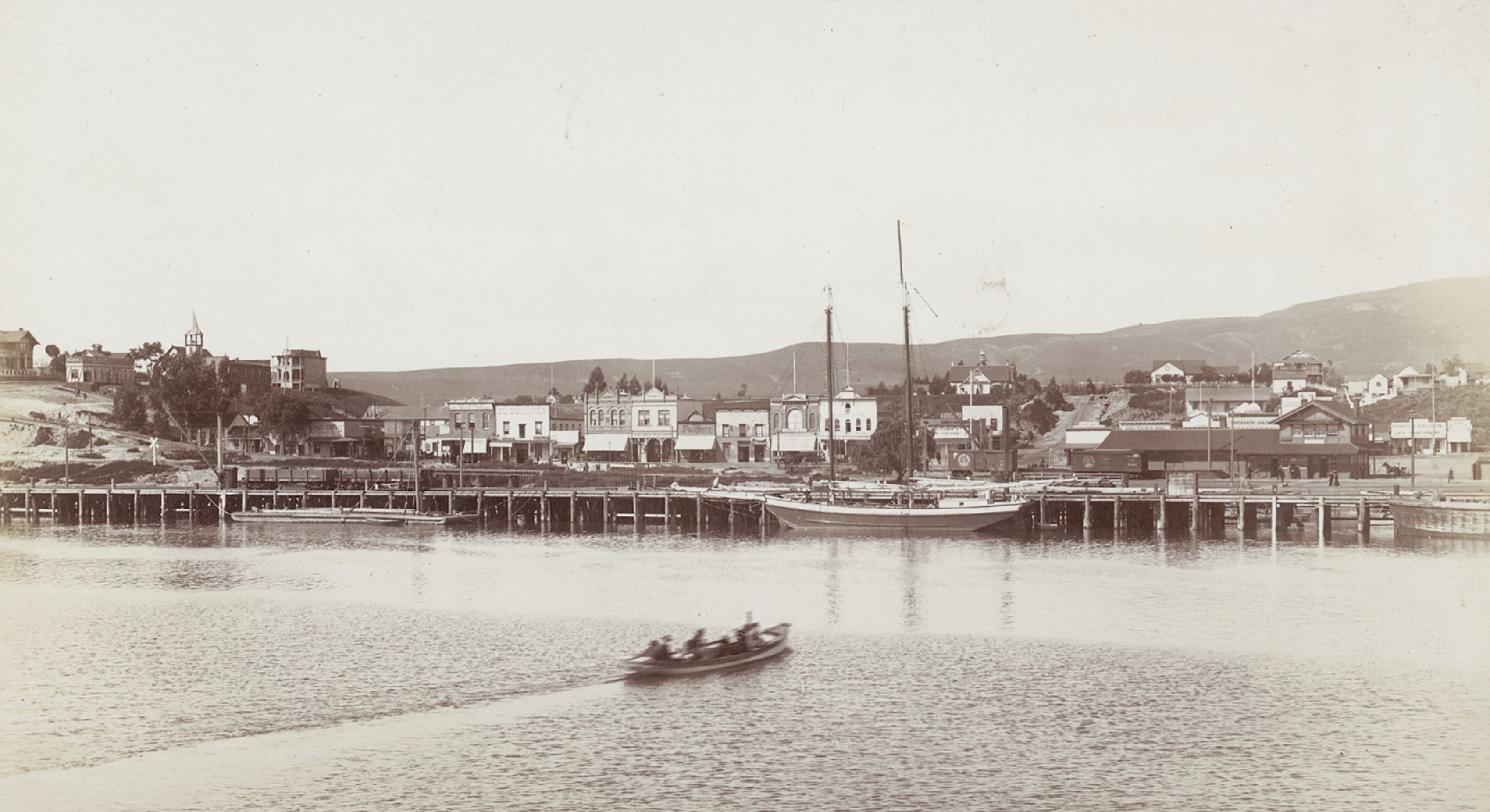 |
|
| (1897)* - View of waterfront. Shows main street and bordering buildings, wharf with railroad tracks. By 1897, San Pedro’s Main Street faced the growing harbor. Rail lines ran alongside the dock, supporting maritime commerce and industry. Photo by W. H. Fletcher. |
Historical Notes As the port town grew, Main Street developed into a modest commercial hub. Rail access directly to the water enabled faster transfer of goods and passengers—a critical step in securing San Pedro’s future as a competitive deep-water port. |
 |
|
| (1898)* - A vast quantity of lumber awaits transport at the San Pedro waterfront, a reflection of Los Angeles’s explosive building boom during the late 1890s. In the distance, a four-masted schooner is docked near Terminal Island. The harbor’s growing infrastructure—piers, rail spurs, and freight sheds—helped set the stage for its designation as the official Port of Los Angeles in 1907. Photo by C. C. Pierce. |
Historical Notes By 1898, the U.S. Army Corps of Engineers had begun initial work on dredging and constructing breakwaters. The scale of lumber shipments visible here reflects booming regional demand for housing and infrastructure—key forces that justified federal investment in a formal port. |
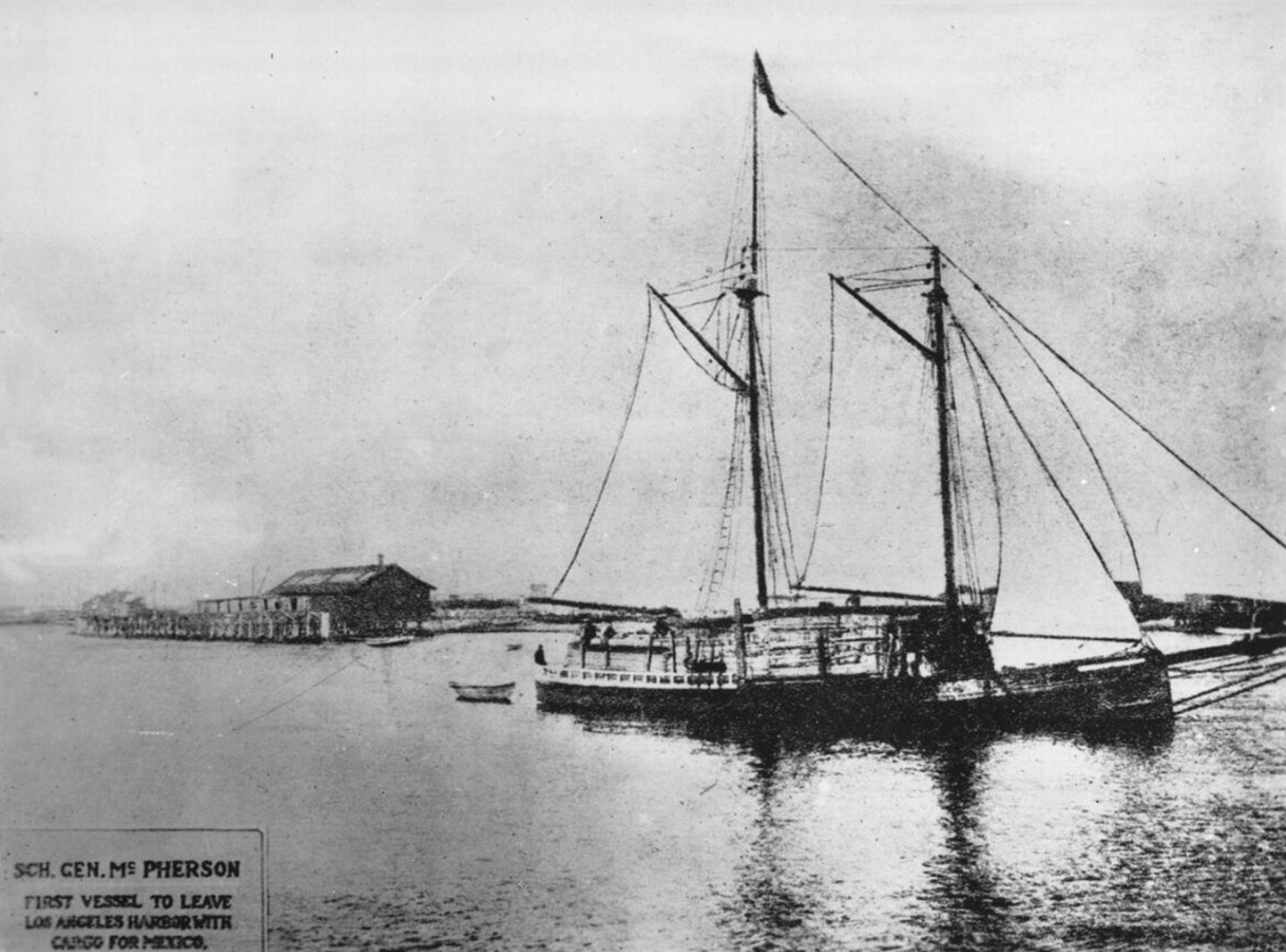 |
|
| (1898)* - The schooner General McPherson in full sail departs Los Angeles Harbor—the first vessel to carry cargo to Mexico from the newly functioning harbor. |
Historical Notes The General McPherson was the first vessel to leave Los Angeles Harbor with cargo bound for Mexico, symbolizing the beginning of international trade through San Pedro. This was a milestone in Los Angeles’s rise as a Pacific commerce hub, just prior to its designation as an official port in 1907. |
* * * * * |
City Hall
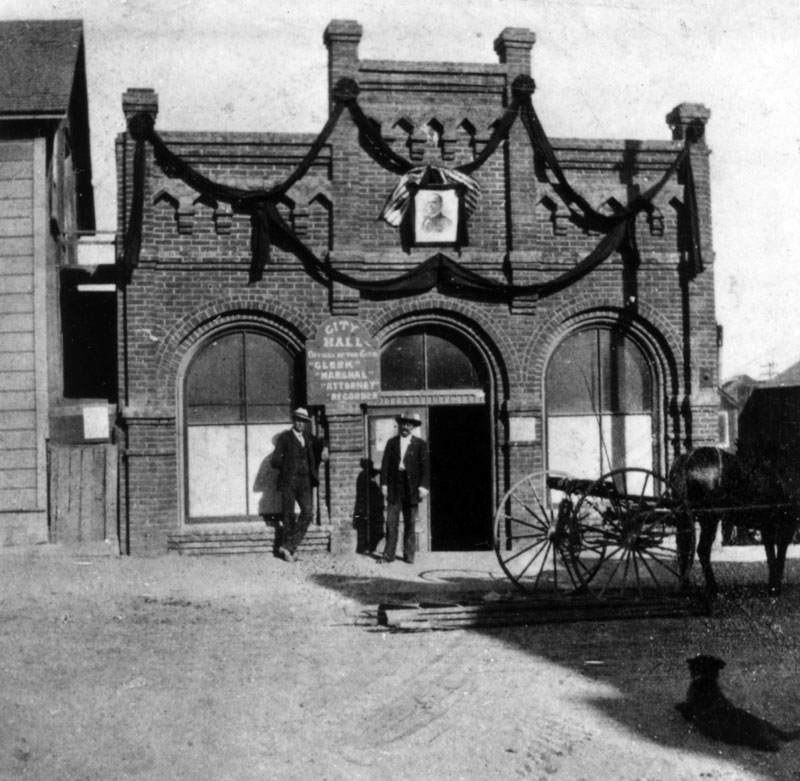 |
|
| (1900)* - Los Angeles city clerk O.C. Abbott (left) and Ben Baker stand outside of the San Pedro City Hall, a rented building on Beacon between 4th and 5th streets. |
Historical Notes In 1906, the City of Los Angeles annexed the Harbor Gateway, a long narrow strip of land connecting the city to the coast, and in 1909, the city annexed San Pedro and the adjacent town of Wilmington. The odd shape is still seen in the map of the city. Click HERE to seeSan Pedro City Hall No. 2 (1905 - 1908). |
* * * * * |
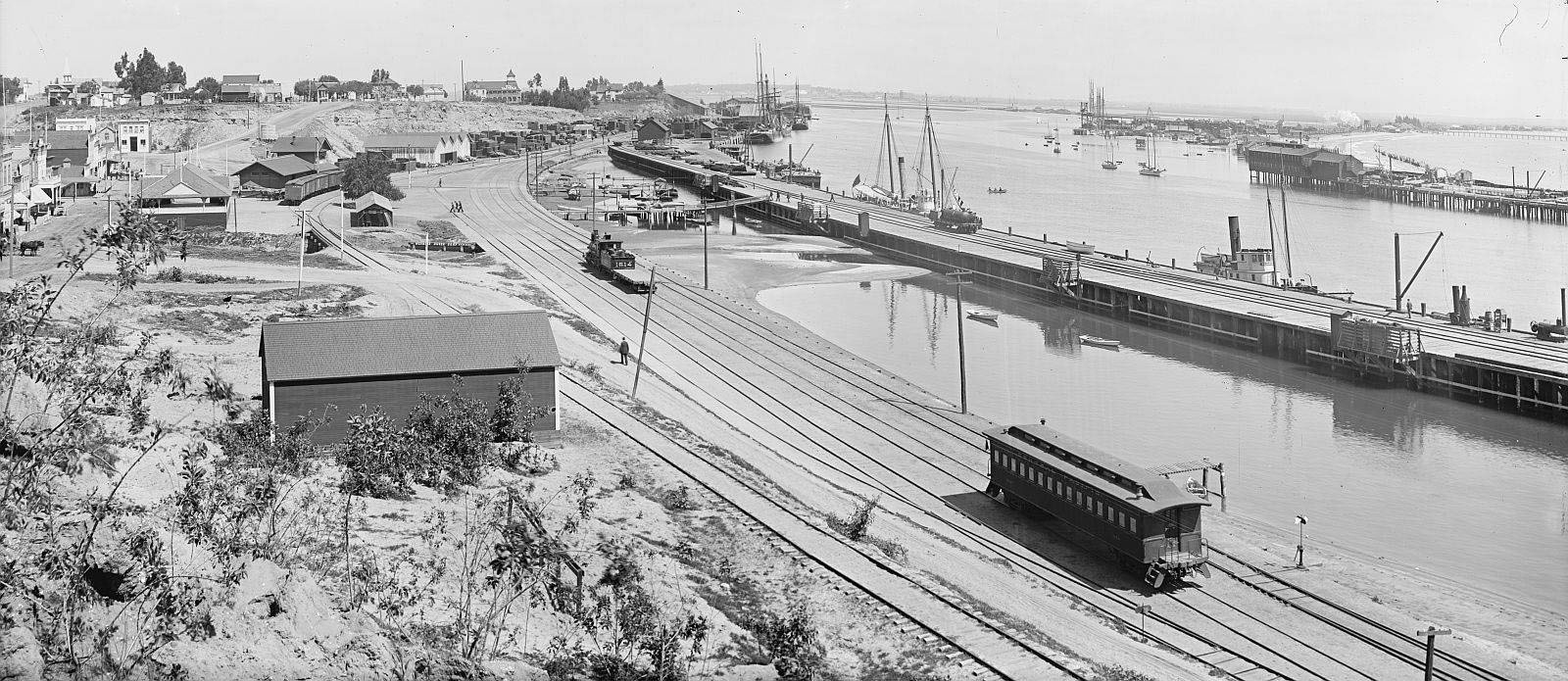 |
|
| (1890s)^* - View of San Pedro Harbor circa 1890s. Two images from the Library of Congress stitched together with the freeware Microsoft Image Composite Editor. |
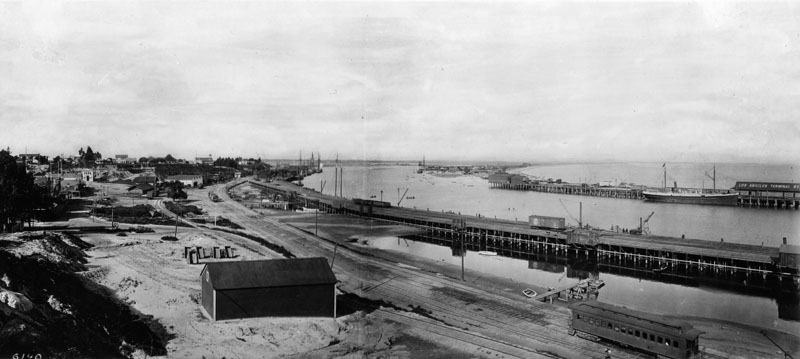 |
|
| (ca. 1900)* - View of L.A. Harbor at San Pedro showing a large ship anchored alongside the Los Angeles Terminal Railway across the channel. A railroad passenger car can be see on the tracks in the foreground. |
Historical Notes In 1890 the Pasadena/Altadena Railway was assumed by a couple of other failing rail lines that connected it to Los Angeles. It became an immediate success. In July 1891 it was joined again with a line that connected it to San Pedro. The line was renamed the Los Angeles Terminal Railway, and subsequently so was its San Pedro terminus at Rattlesnake Island, now Terminal Island. |
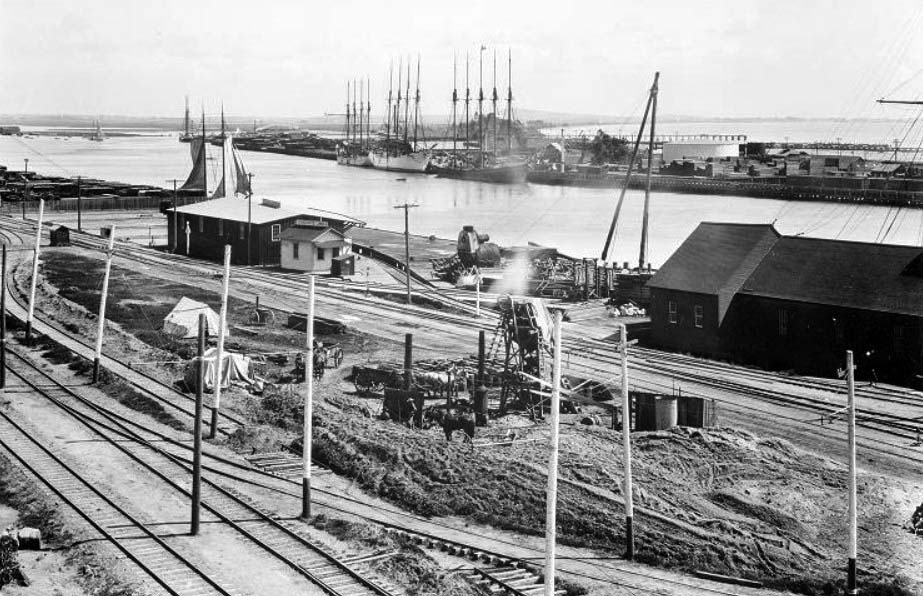 |
|
| (ca. 1900)#* - View of several tall ships at dock in San Pedro Harbor. |
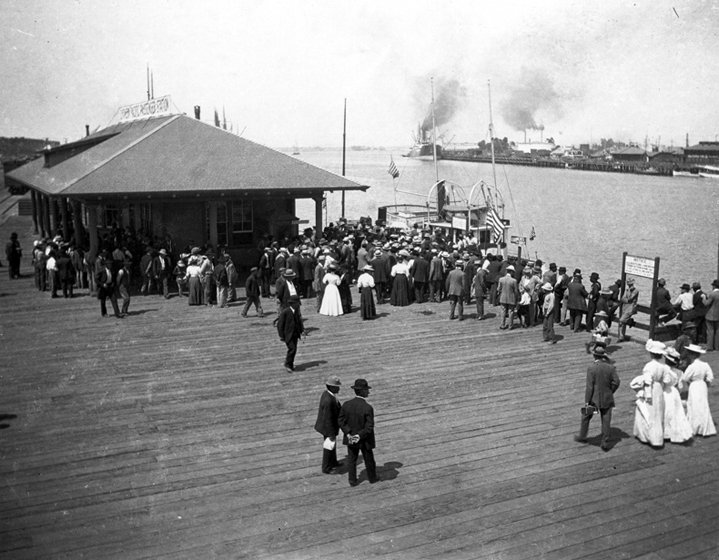 |
|
| (ca. 1899)*#* - View of the Port of Los Angeles circa 1899. Crowds of people are dressed up and appear to be viewing the arrival of a vessel. |
* * * * * |
Front Street (now Avalon Blvd)
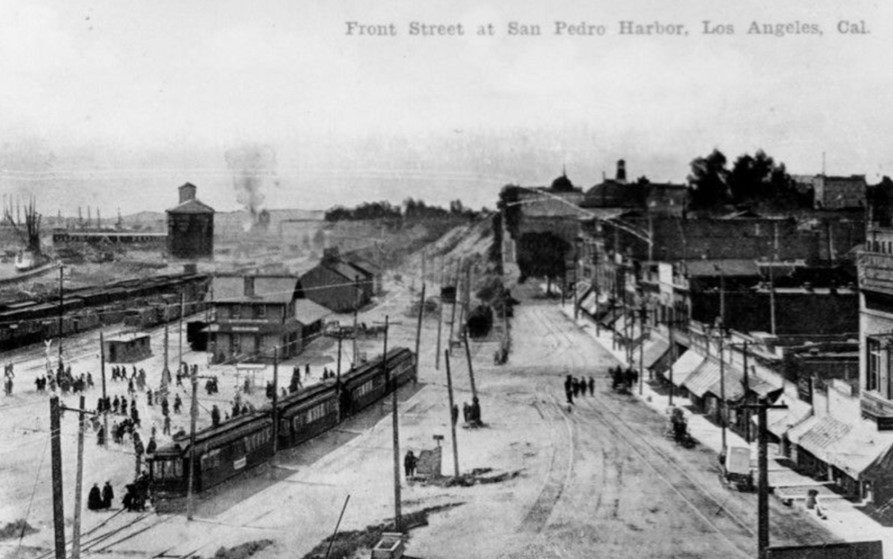 |
|
| (ca. 1900)* - Postcard view of Front Street (now Avalon Boulevard) at San Pedro Harbor showing a multitude of passengers disembarking from streetcars. Commercial storefronts can be seen acroos the unpaved road to the far right of the photo. |
Historical Notes The establishment of the Port of Los Angeles in the early 1900s spurred the development of San Pedro, and electric streetcars provided local transit services for workers and later military personnel. |
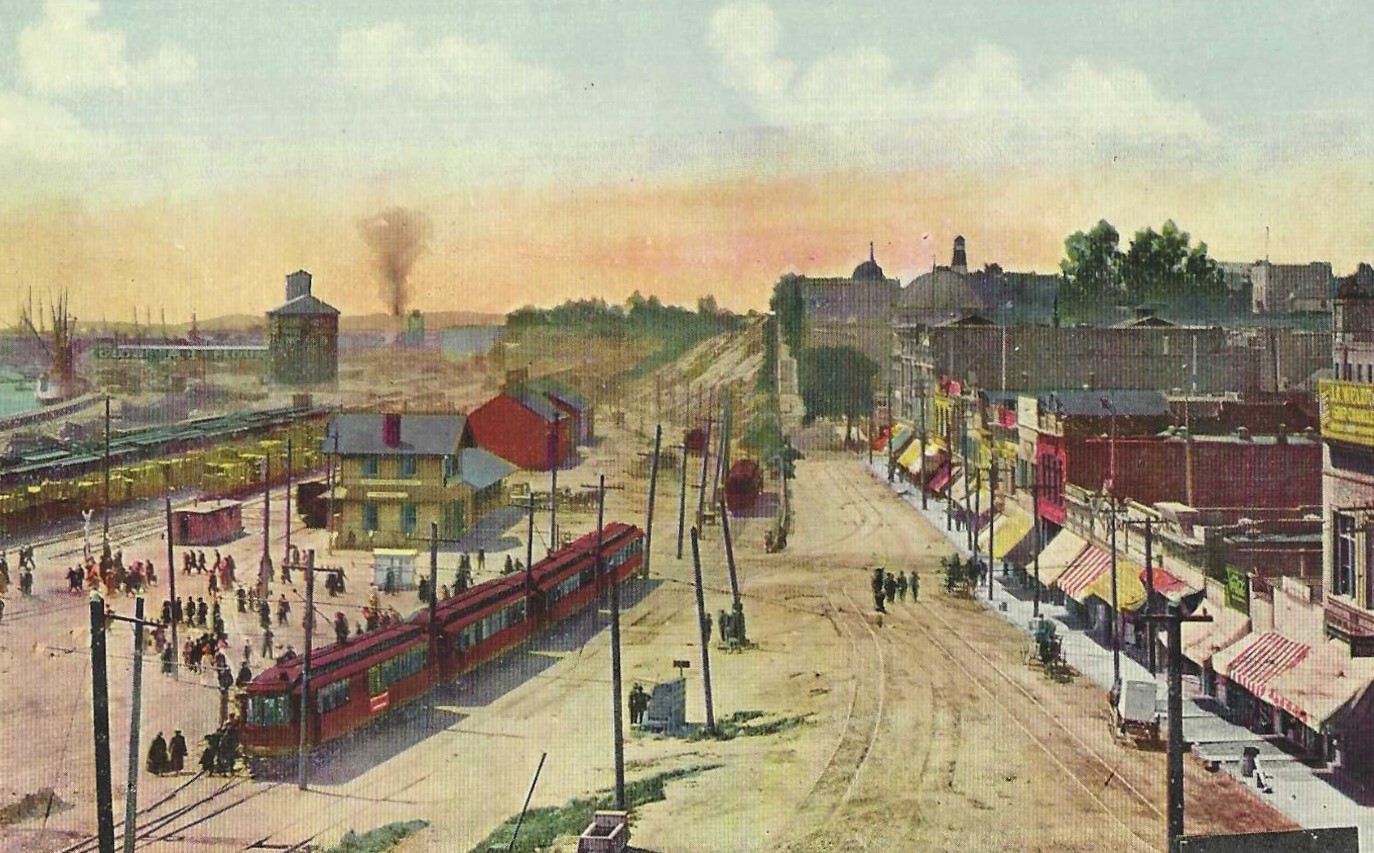 |
|
| (ca. 1900)* - Postcard view of Front Street (now Avalon Boulevard) at San Pedro Harbor showing a multitude of passengers disembarking from streetcars. Commercial storefronts can be seen acroos the unpaved road to the far right of the photo. |
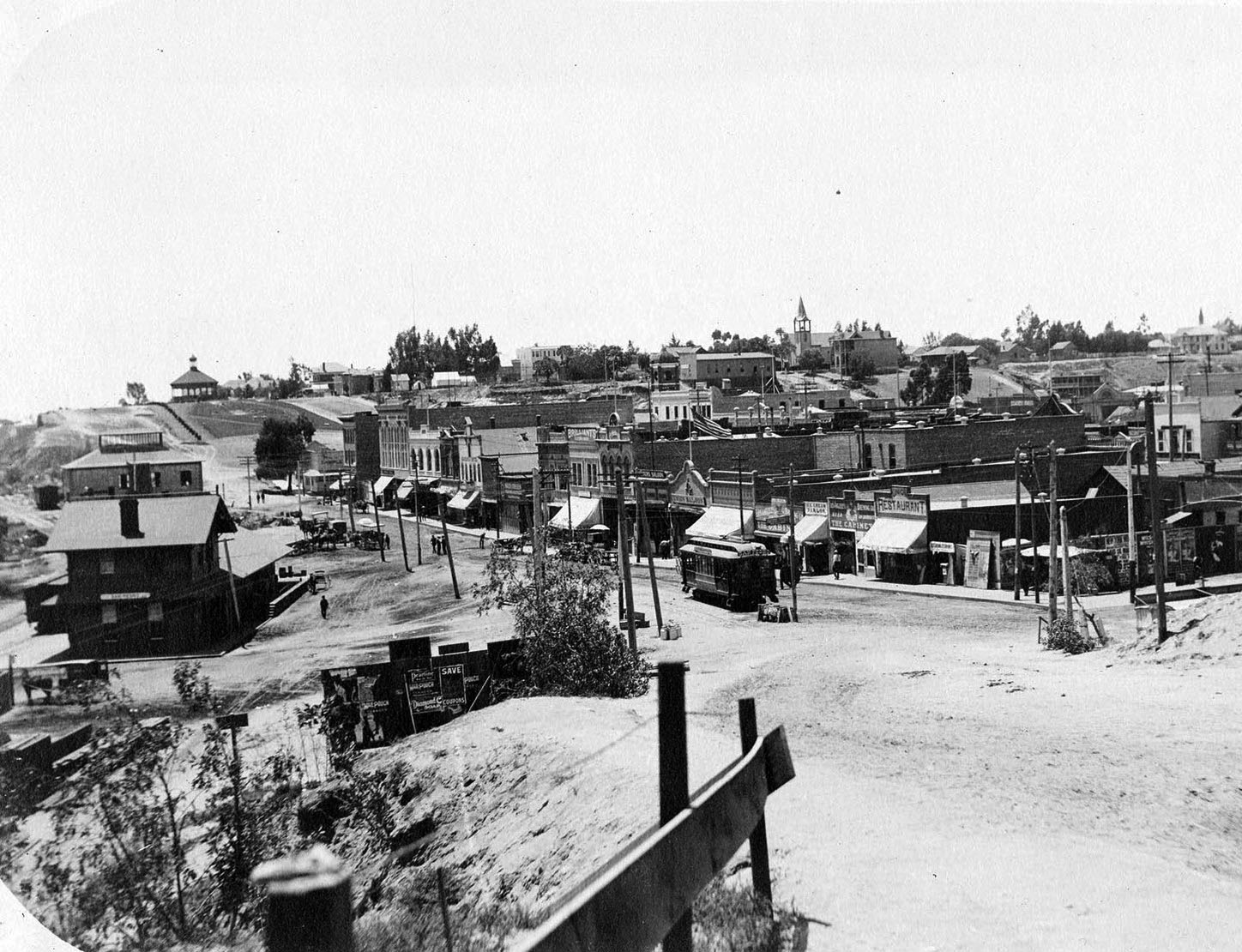 |
|
| (1904)* - View looking south on Front Street, from 4th. The gazebo atop the hill in the distance (center left) is sitting where the Carnegie Library would be built a couple years later, at 820 S. Beacon St. Photo from the California Historical Society |
Historical Notes Streetcar lines in San Pedro included the Front Street line, which ran from the Pacific Electric depot at Sixth and Palos Verdes to Point Firmin via Sixth and Pacific. |
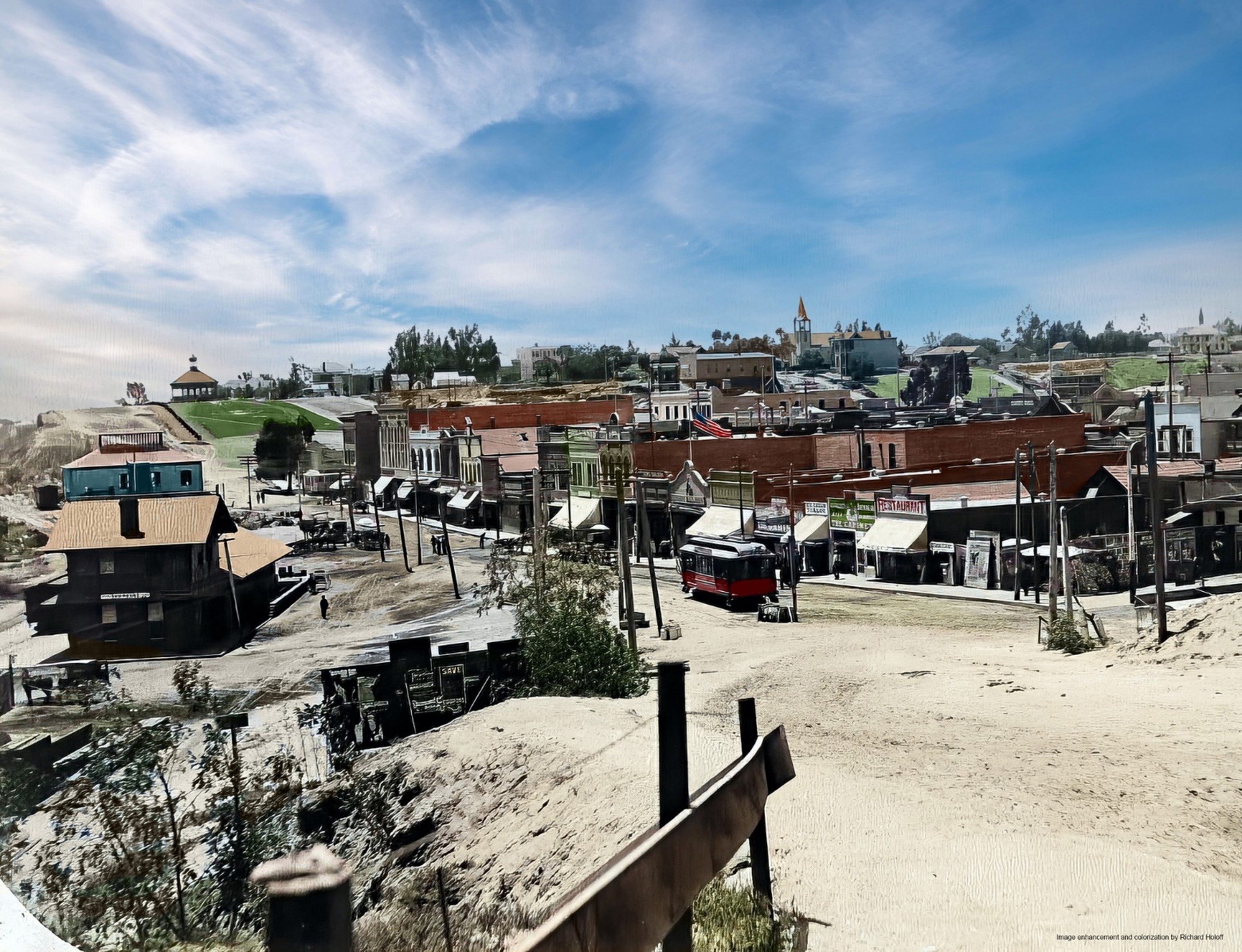 |
|
| (1904)* - View looking south on Front Street, from 4th. The gazebo atop the hill in the distance (center left) is sitting where the Carnegie Library would be built a couple years later, at 820 S. Beacon St. Photo from the California Historical Society. Image enhancement and colorization by Richard Holoff |
 |
|
| (1905)* - Panoramic view of Front Street in the Port of Los Angeles. A horse-drawn carriage moves down the dusty, unpaved street perpendicular to the streetcar behind in front of which the silhouette of a man can be seen crossing. Parked rail cars sit in a yard to the right, while a row of commercial shopfronts of varying size line up end to end along the street to the left. A tall building in the lefthand foreground corner reads "Mission" on the side. Flagpoles line the harbor close to the water in the background at right. Photo by C.C. Pierce |
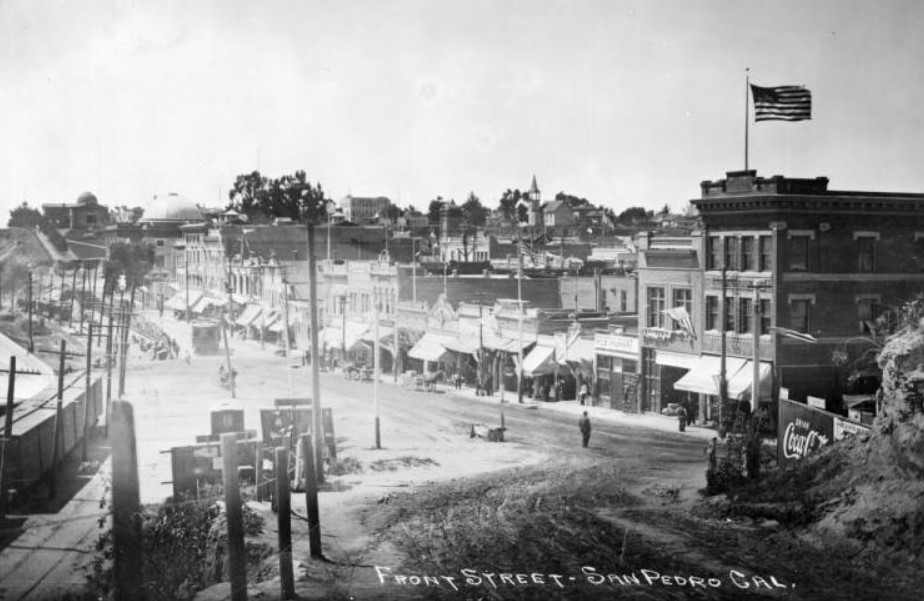 |
|
| (ca. 1906)* - View of Front Street looking south in San Pedro. A section of post-and-wire fence is pictured in the left foreground, guarding the edge of a steep incline that leads down into the unpaved Front Street. To the right of center, a man can be seen walking towards a side of the street lined with commercial buildings, while farther in the foreground at right, a billboard for Coca Cola can be seen. To the left, the tail end of a set of railroad cars can be seen behind a line of utility poles. The domed building of the Carnegie Library building can be seen on the hill in the distance, while farther in the foreground, a second domed building is City Hall.; Legible signs from left to right include: "Cannon's [...]", "Coasters Saloon", "M. Brown San Francisco Store", "Union Saloon", "Restaurant", "Emergency Hospital" and "Hotel Spokane". Photo by C.C. Pierce |
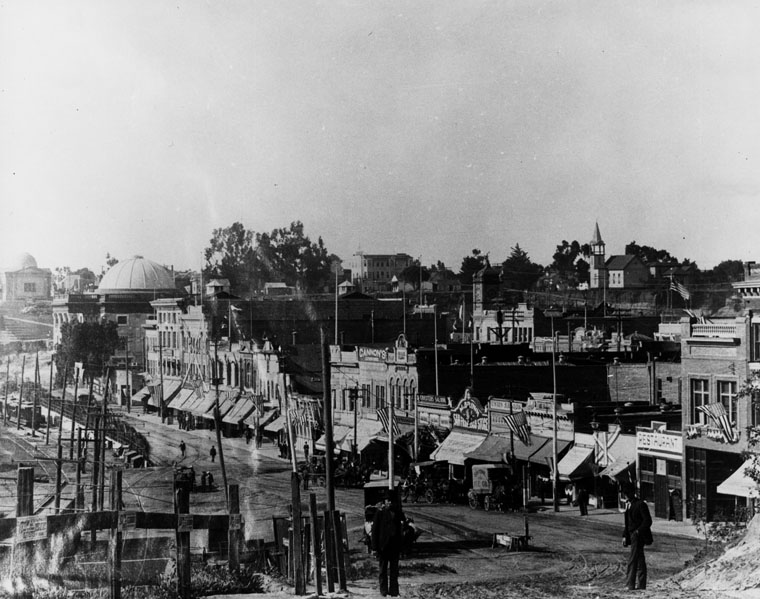 |
|
| (1910)* - San Pedro waterfront looking south along Front Street from 4th Street. City Hall is the building with the large dome; the smaller dome belongs to the Carnegie Library building. |
Historical Notes The San Pedro Carnegie library seen above opened on June 5, 1906 and was located on the Public Plaza in San Pedro, with an entrance on what is now Harbor Boulevard, across from the San Pedro Main Post Office. The library building featured a distinctive gilded dome and temple-front design, and was known as "The Lady of Beacon Street". |
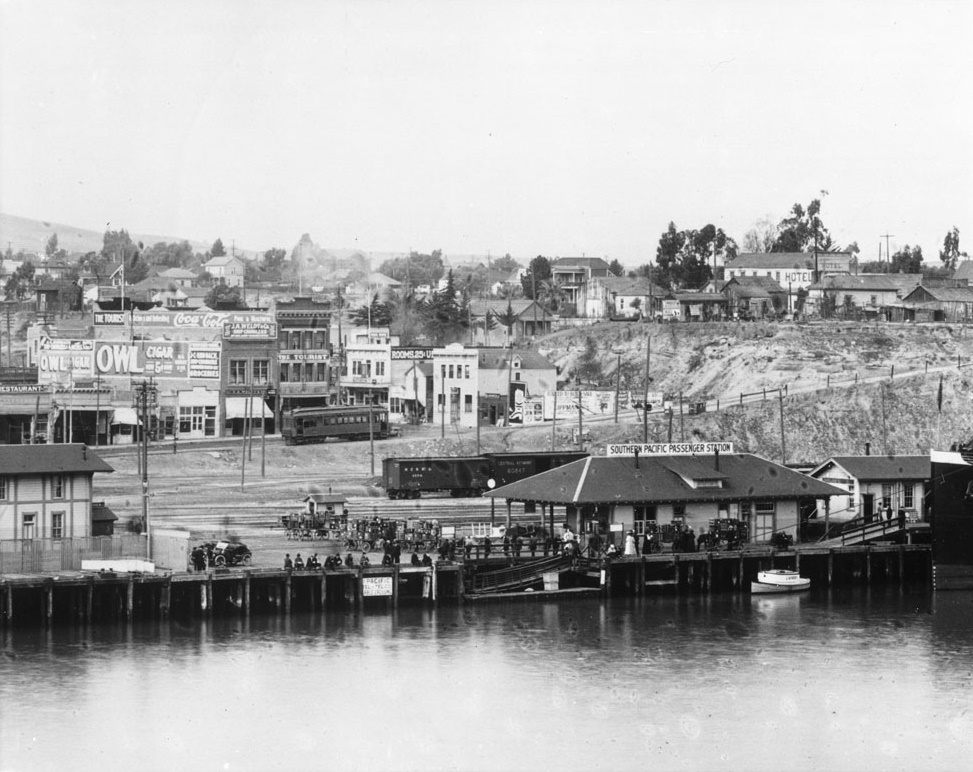 |
|
| (ca. 1913)* - View showing the Southern Pacific Passenger Station on the San Pedro waterfront. A Streetcar is seen at center-left on Front Street. |
Historical Notes Tracks on Front Street were abandoned around 1915 and the line was likely routed through to the Outer Harbor Line. |
* * * * * |
Free Harbor Jubilee
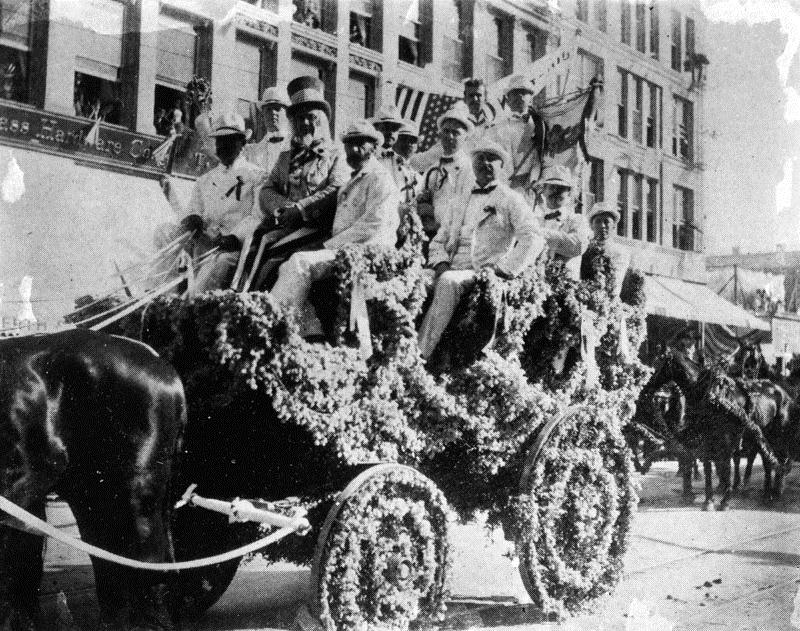 |
|
| (ca. 1899)* - Group of men ride in a decorated carriage celebrating Harbor Day in San Pedro. |
Historical Notes The Free Harbor Jubilee officially began on April 26, 1899, when President McKinley pushed a button in Washington, D.C. that signaled a barge 3,000 miles away in San Pedro to dump a load of large boulders into the sea, marking the beginning of the construction of the new port’s breakwater. |
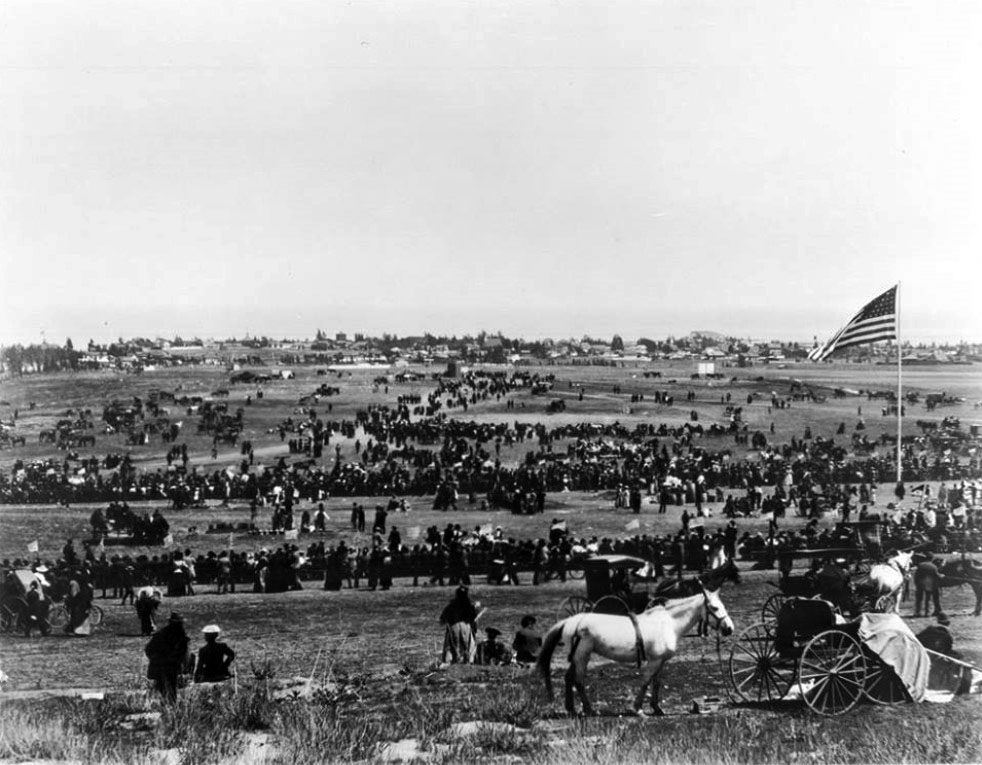 |
|
| (1899)* - The whole town came out to celebrate the Free Harbor Jubilee on April 26, 1899. |
Historical Notes The ceremony was the culmination of a 7-year battle that pitted two Southern California business titans against each other. At stake: the location of the official deep-water harbor for Los Angeles. San Pedro came out on top.* |
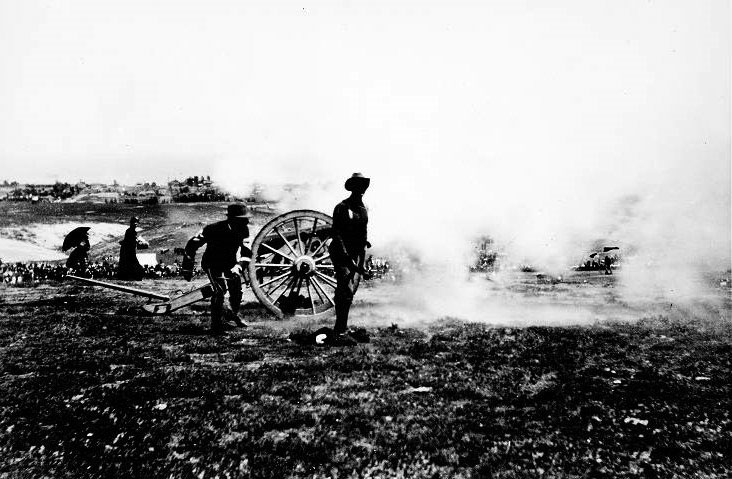 |
|
| (1899)#* - View of the firing of a cannon at the San Pedro Free Harbor celebration. |
* * * * * |
Banning Residence
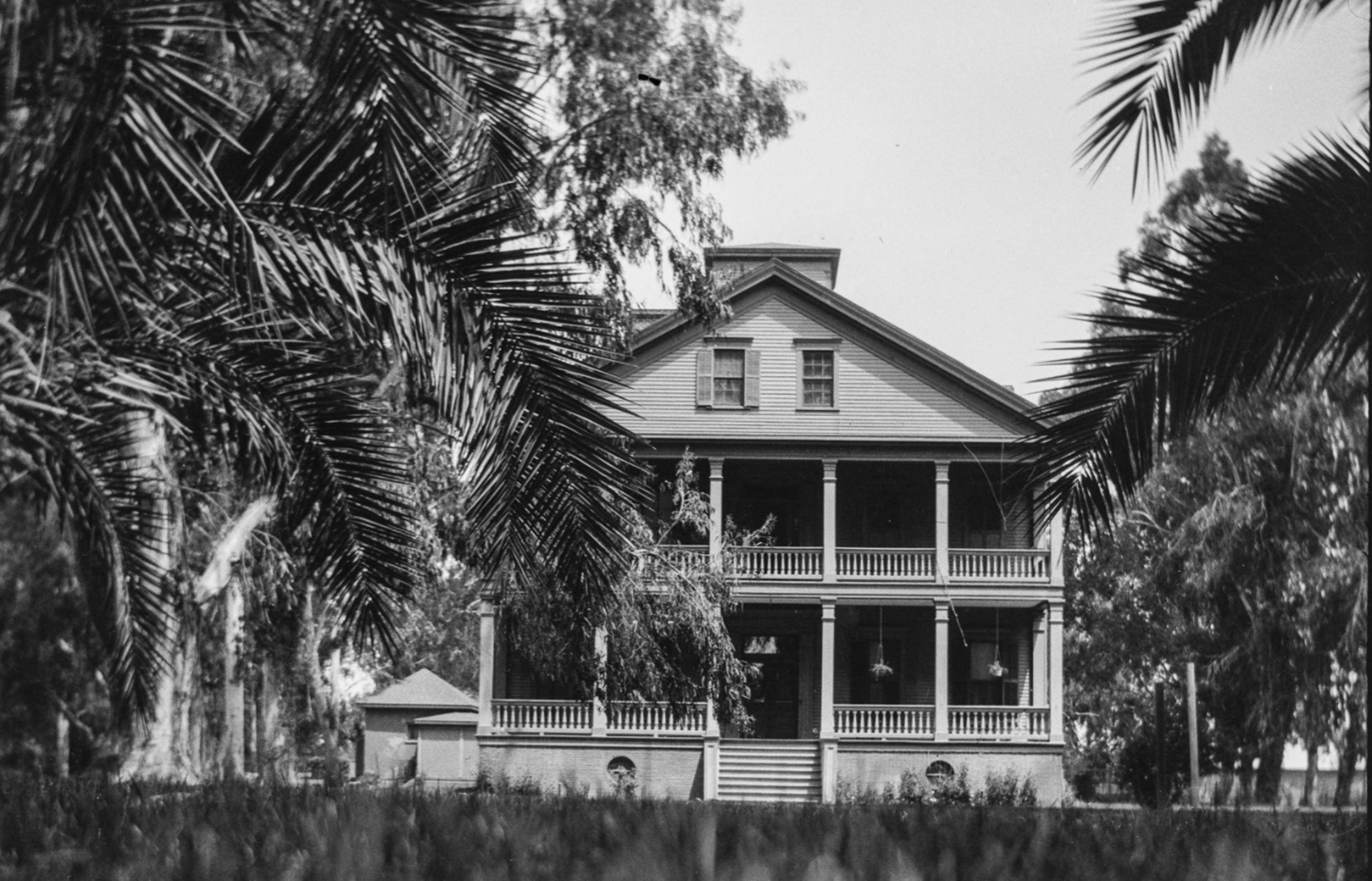 |
|
| (1890s)* – The home of Phineas Banning at 401 East M Street in Banning Park, Wilmington. Best as the founder of Wilmington, which he named after his birthplace in Delaware, Banning was also a successful entrepreneur who significantly contributed to the development of the Port of Los Angeles, earning him the title of "The Father of the Port of Los Angeles." Today, the Banning House operates as a museum. Photo by George Washington Hazard from the Ernest Marquez Collection. |
Historical Notes In 1864, Phineas Banning built this elegant Greek Revival home within sight of the harbor. It was one of the most impressive in the region – and still is. Here he enjoyed hosting visiting dignitaries and socializing with family and friends. Today the 23-room Banning Mansion and a surrounding 20 acre park are open to visitors. Phineas Banning (1830 – 1885) is known as "The Father of the Port of Los Angeles," he was one of the founders of the town of Wilmington, which was named for his birthplace. His drive and ambition laid the foundations for what would become one of the busiest ports in the world. Besides operating a freighting business, Banning operated a stage coach line between San Pedro and Wilmington, and later between Banning, California, which was named in his honor, and Yuma, Arizona. |
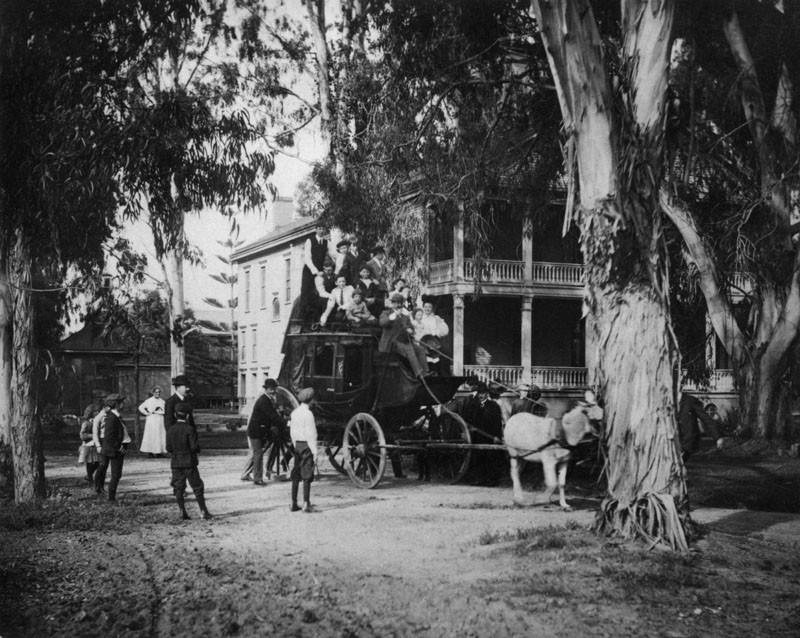 |
|
| (ca. 1900)* - Tree-shaded residence of Phineas Banning in Wilmington. In front is a mule-drawn coach piled high with people. |
Historical Notes Click HERE to see more early views of the Banning Residence. |
* * * * * |
 |
|
| (ca. 1900)* - View of a man sitting on the hillside of Dead Man’s Island looking north toward Pt. Fermin. Visible on the left is a ship approaching the breakwater. |
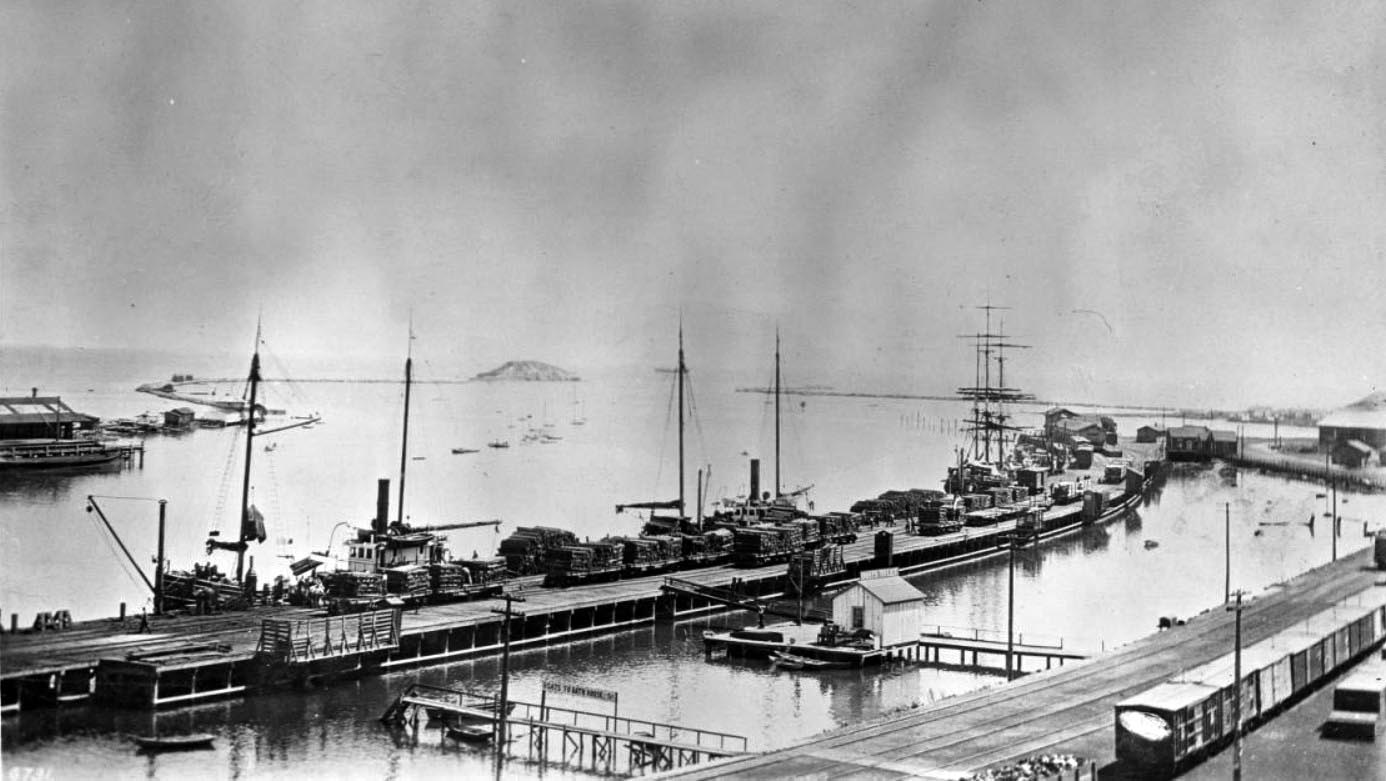 |
|
| (1900)^^ - Panoramic view of the San Pedro Harbor looking west. A collection of tall-masted ships are docked along the edge of the harbor with a three-masted ship docked towards the right. Dock buildings are situated along the planks. Legible signs read "Boats to Let" and "Boats to Bath House. 5¢". The breakwater can be seen along the horizon in the distance, moving right towards Dead Man's Island. |
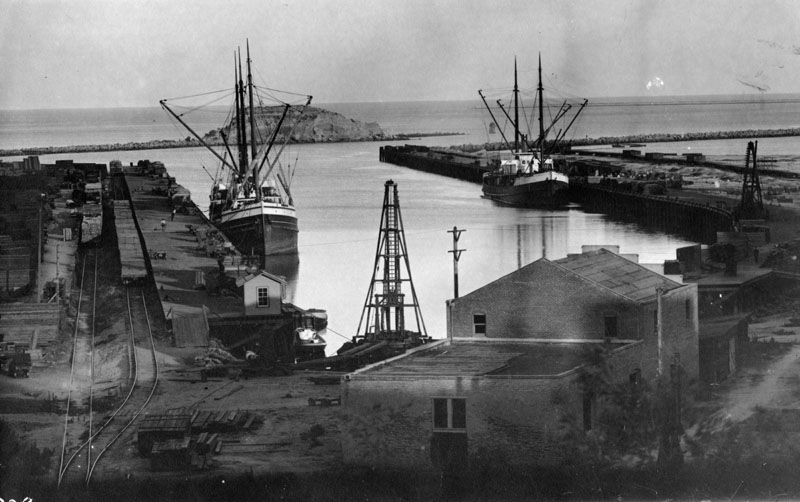 |
|
| (Early 1900s)* - View of L.A. Harbor showing fishing boats anchored in the harbor at San Pedro. Deadman's Island is behind. Railroad cars are on tracks at left, between stacks of lumber and the wharf. There are buildings in the foreground and a wharf circling around at right. In the near center is a dredge. |
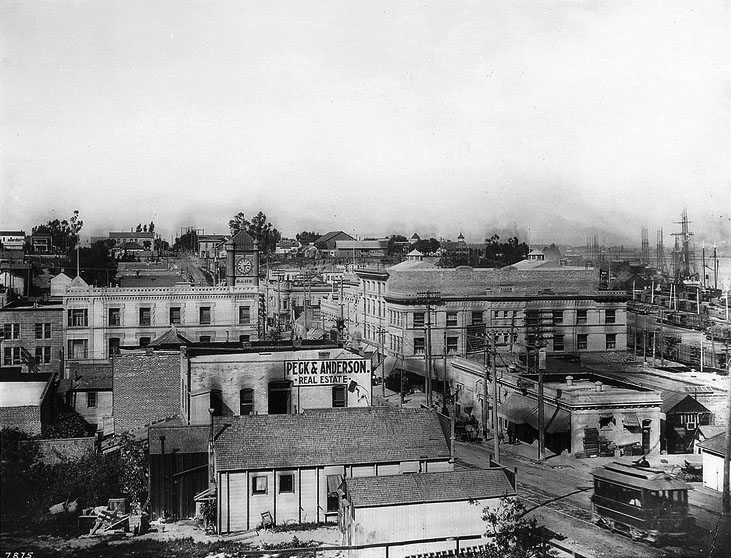 |
|
| (ca. 1903)^^ - Birdseye view of San Pedro looking north towards Wilmington from Beacon Street. A streetcar is in the lower right. The clock tower of the San Pedro Bank can be seen center-left. |
| (ca. 1903)^^ - Looking south on Beacon from Fifth Street circa 1903. Streetcar can be seen down the road. |
 |
|
| 1903)#* - San Pedro waterfront and Terminal Island panorama. In the foreground are the lumber docks and a sailing ship. |
 |
|
| (ca. 1903)#* - San Pedro Harbor docks are filled with tall ships. Lumber is stacked in the lumber yard near the tracks. Dead Man’s Island is seen in the distance. |
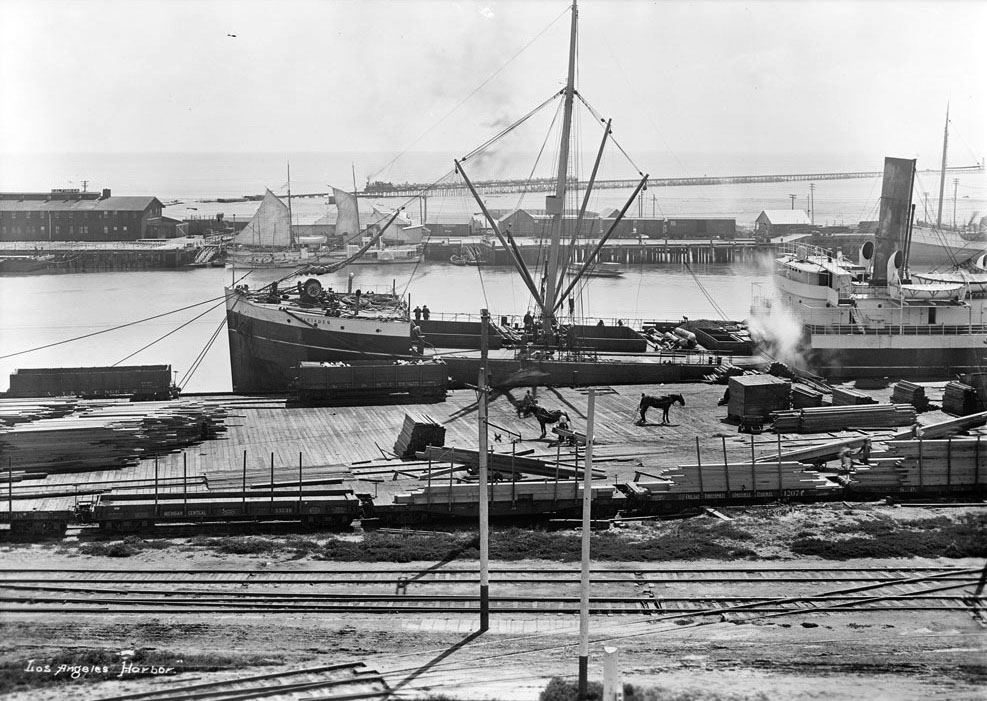 |
|
| (ca. 1903)^^ - Looking easterly up the main channel and showing the East San Pedro ferry landings. Two horses can be seen in the foreground by the lumber yard. Note the train on trestle in the background is holding rock for the new jetty construction. |
Harbor Breakwater (Constructed 1899-1911)
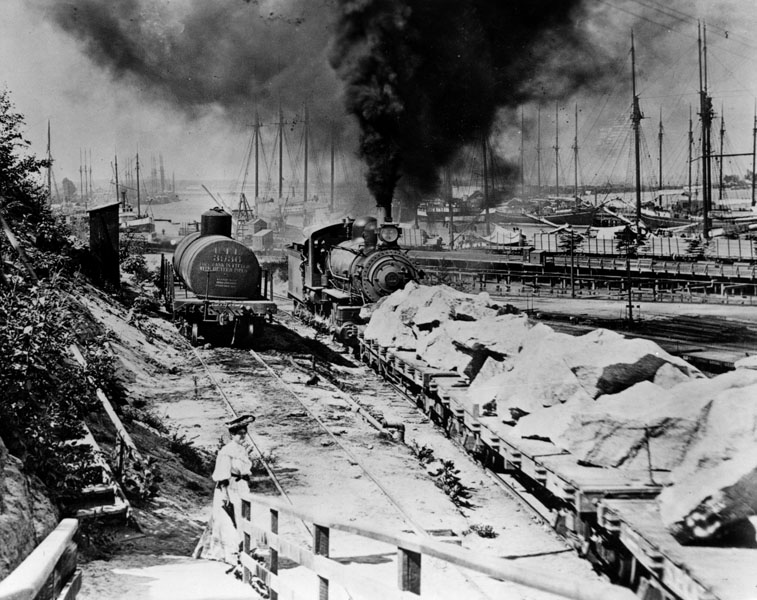 |
|
| (ca. 1904)* - A finely dressed lady stands in front of the railyard watching a train push a load of boulders to be used for construction of the harbor's new breakwater. |
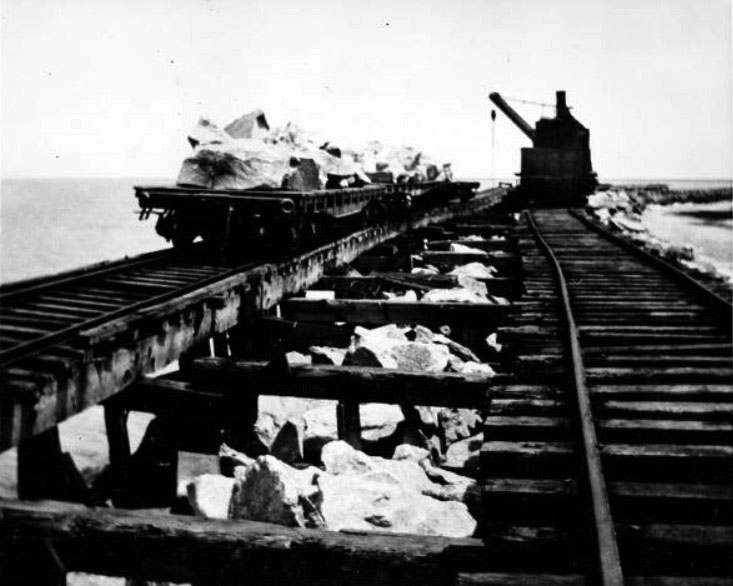 |
|
| (ca.1904)#*- Flat cars topped with rocks and railroad crane on trestles above the breakwater. |
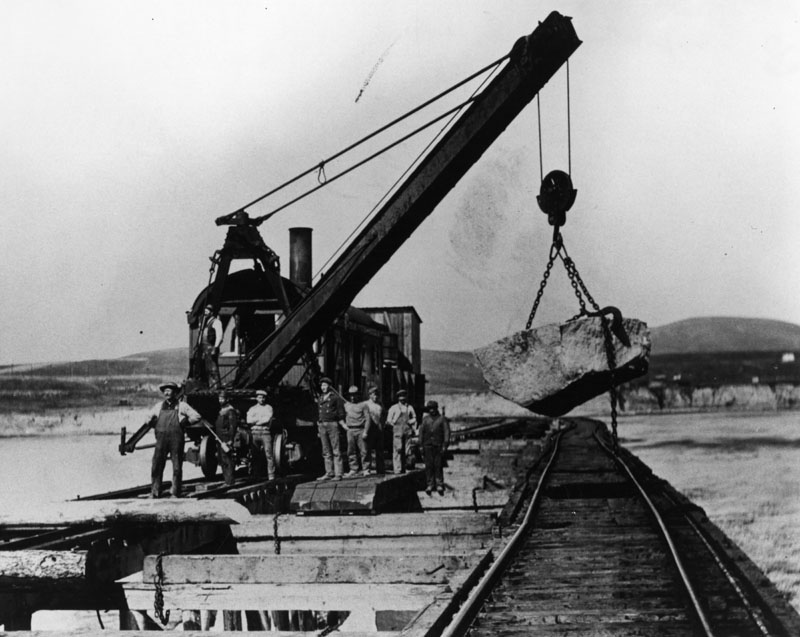 |
|
| (1904)* - Photo of workers building the breakwater in the San Pedro Harbor. Work was started in 1899. |
Historical Notes Most of the boulders used to construct the breakwater in San Pedro Harbor came from the mountains of west San Fernando Valley. Between 1898 and 1904, Southern Pacific was grading, cutting, and tunneling through the Santa Susana Mountains near Chatsworth Park as they establshed their new Coast Line connection from Ventura to Burbank. This provided San Pedro with an ample supply of boulders for their new breakwater. Click HERE to see more in Early Views of the San Fernando Valley. |
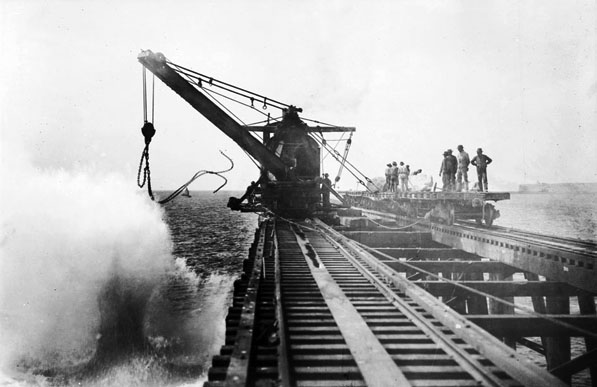 |
|
| (ca. 1900)^^ - Construction of the breakwater in San Pedro. |
Historical Notes Today, an 8.5 miles long breakwater stretches across most of the bay, with two openings to allow ships to enter the port areas behind it. The initial western section of the breakwater, called the San Pedro Breakwater, was constructed between 1899 and 1911 at San Pedro; the Middle breakwater was completed over the next twenty-five years, and the Long Beach breakwater was finished after World War II.*^ |
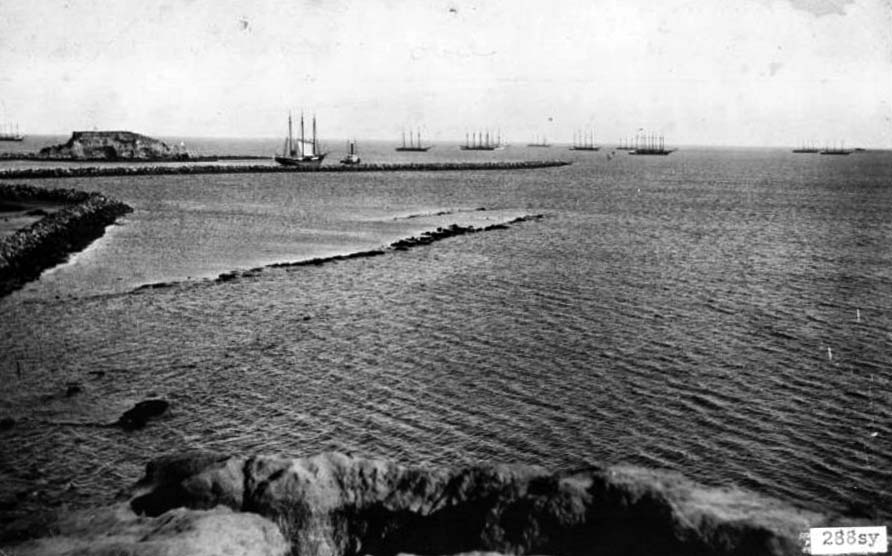 |
|
| (ca. 1905)^^ - View of the outer harbor at San Pedro, showing several sailing ships and Deadman's Island. Eleven tall wooden ships are visible in the distance. All have several masts, but none has any sails up. There is a small steam tug pulling one of the ships at left. At left, the small rocky top of Deadman's Island is visible, connected to the shore by a narrow rocky strip of land. A large breakwater cuts into the ocean from left, and the rocky shoreline is visible in the foreground. |
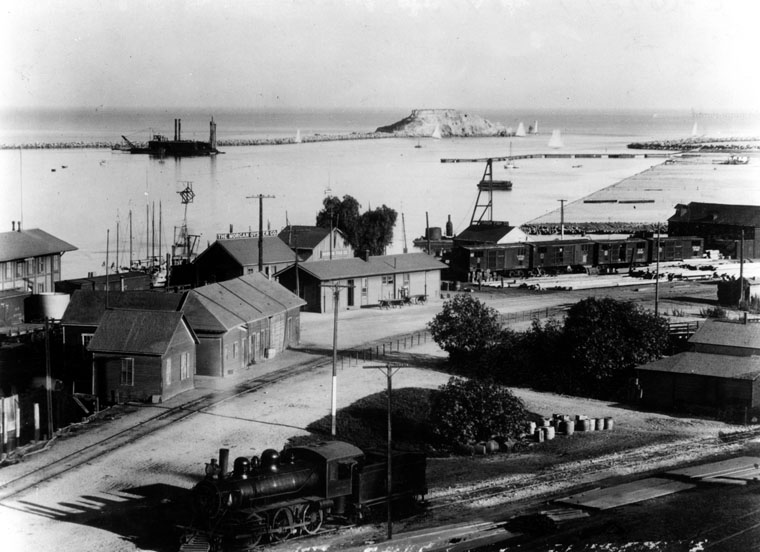 |
|
| (1905)* - View looking over a portion of San Pedro, toward Deadman's Island, and the beginning harbor. Building at extreme left is the Southern Pacific depot. In the distance is a dredge at work along the breakwater. |
Historical Notes Deadman's Island was one of two islands near San Pedro in the 19th century. The land, sometimes referenced as Deadman's Island, Isla Del Muerto, and Reservation Point, was dredged away in 1928 as part of a harbor development effort. Rattlesnake Island, the other islet in the area, became Terminal Island.*^ |
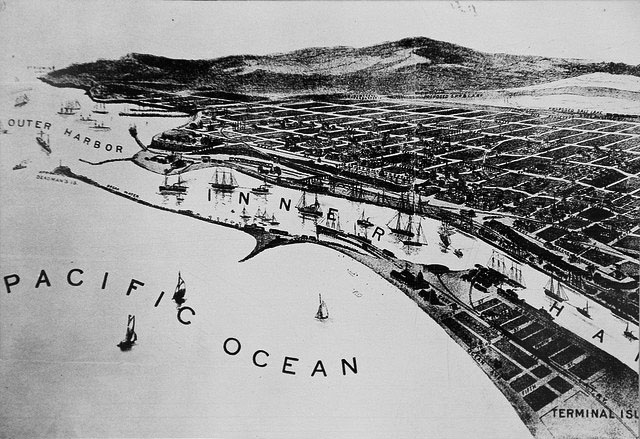 |
|
| (1905)#* - Photo of a lithograph of plan of San Pedro and its inner and outer harbors. |
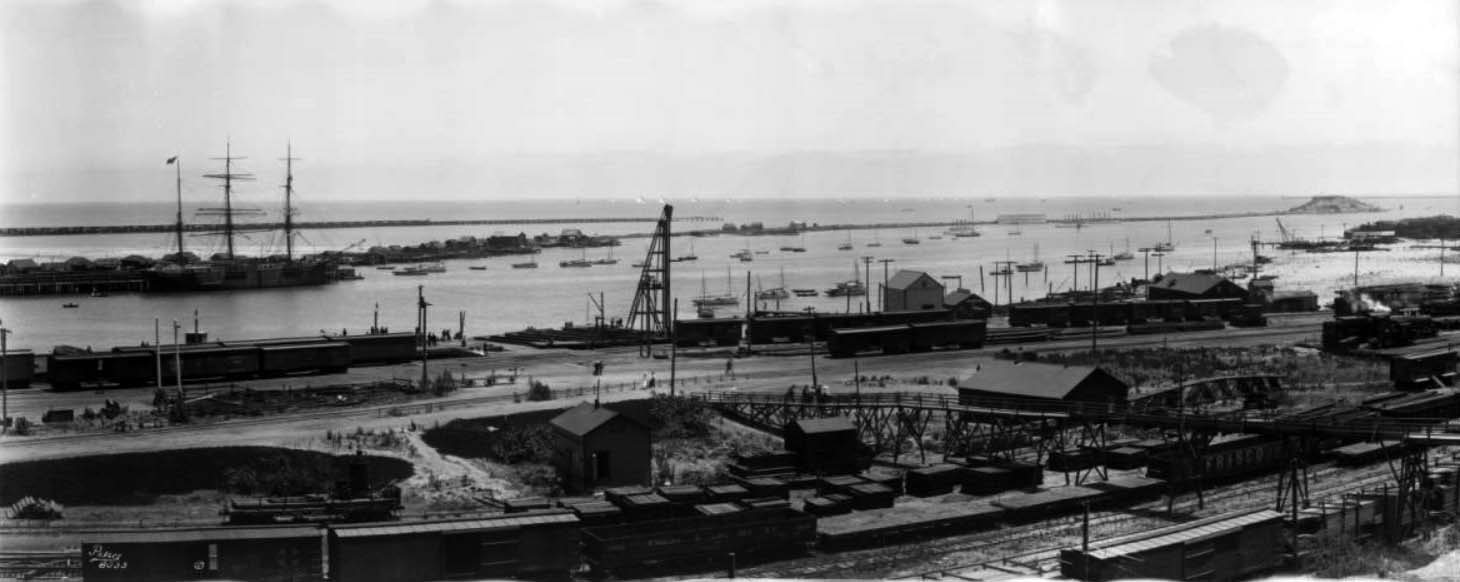 |
|
| (1905)* - A panoramic view of a part of the docks of Los Angeles Harbor in San Pedro. Railroad tracks run across the immediate foreground, as well as alongside the docks, and there are cargo and flatbed train cars on many of the tracks. There are two long breakwaters, one in the distance that is low and simple, and another closer to the shore that is lined with buildings. A three mast tall ship is docked at a pier along the inner breakwater. There are a couple dozen small sailboats anchored inside the breakwaters. |
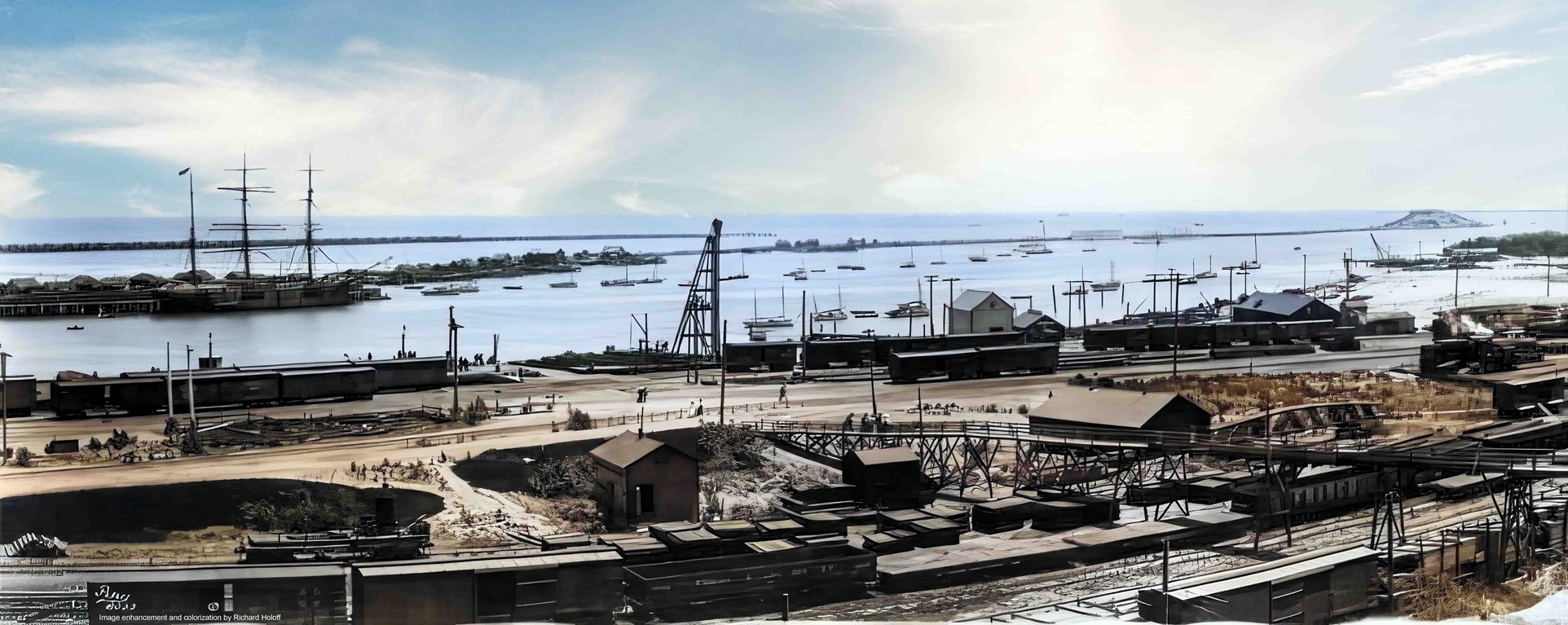 |
|
| (1905)** - A panoramic view of the Los Angeles Harbor in San Pedro. Photo by C.C. Pierce; Image enhancement and colorization by Richard Holoff. |
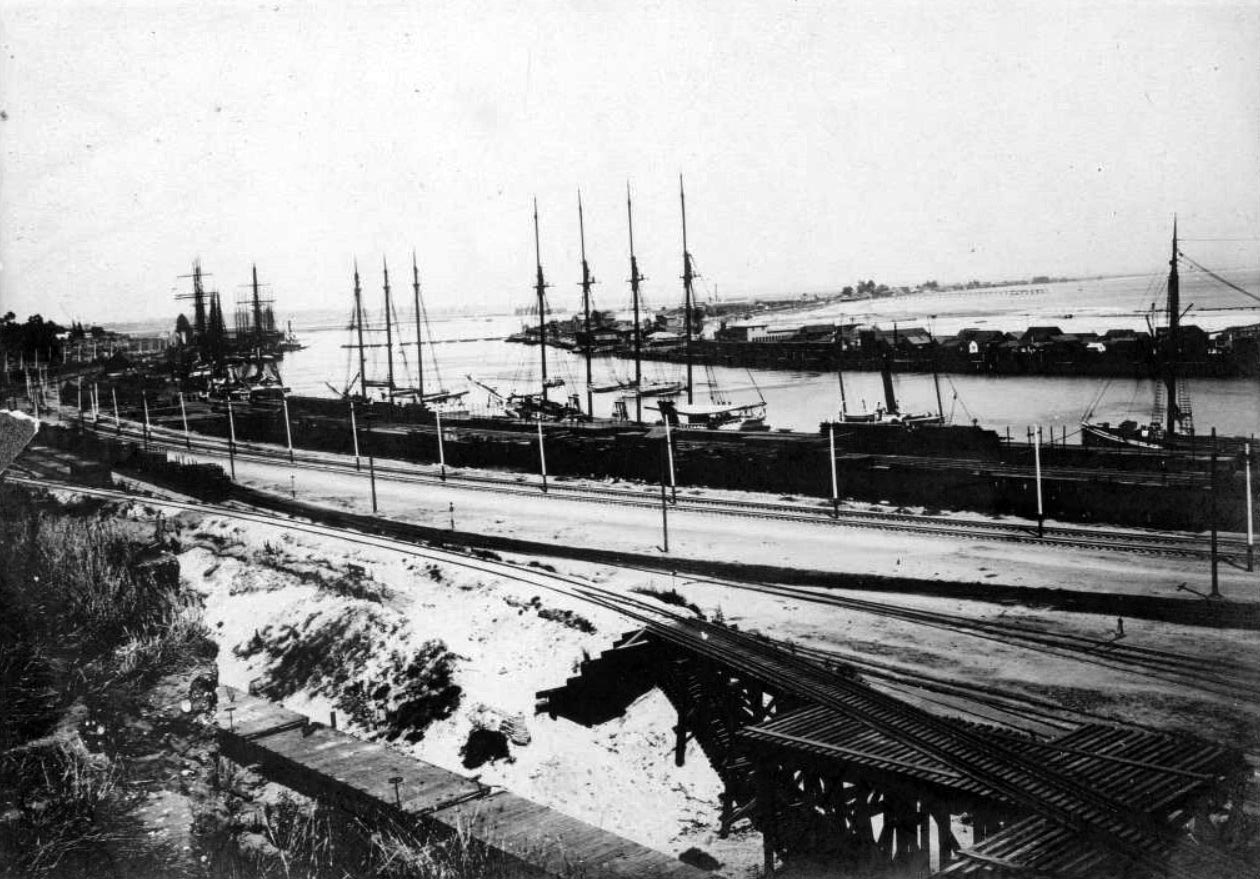 |
|
| (1906)^^ – View showing the entrance to San Pedro Harbor with Terminal Island in the distance. Railroad tracks can be seen running along a wharf from the foreground at right into the distance at left. Note the rail bridge in the lower right. Several tall ships and a steamship are docked along the wharf at left. A section of the harbor curves around in a semicircular path in the background at left. |
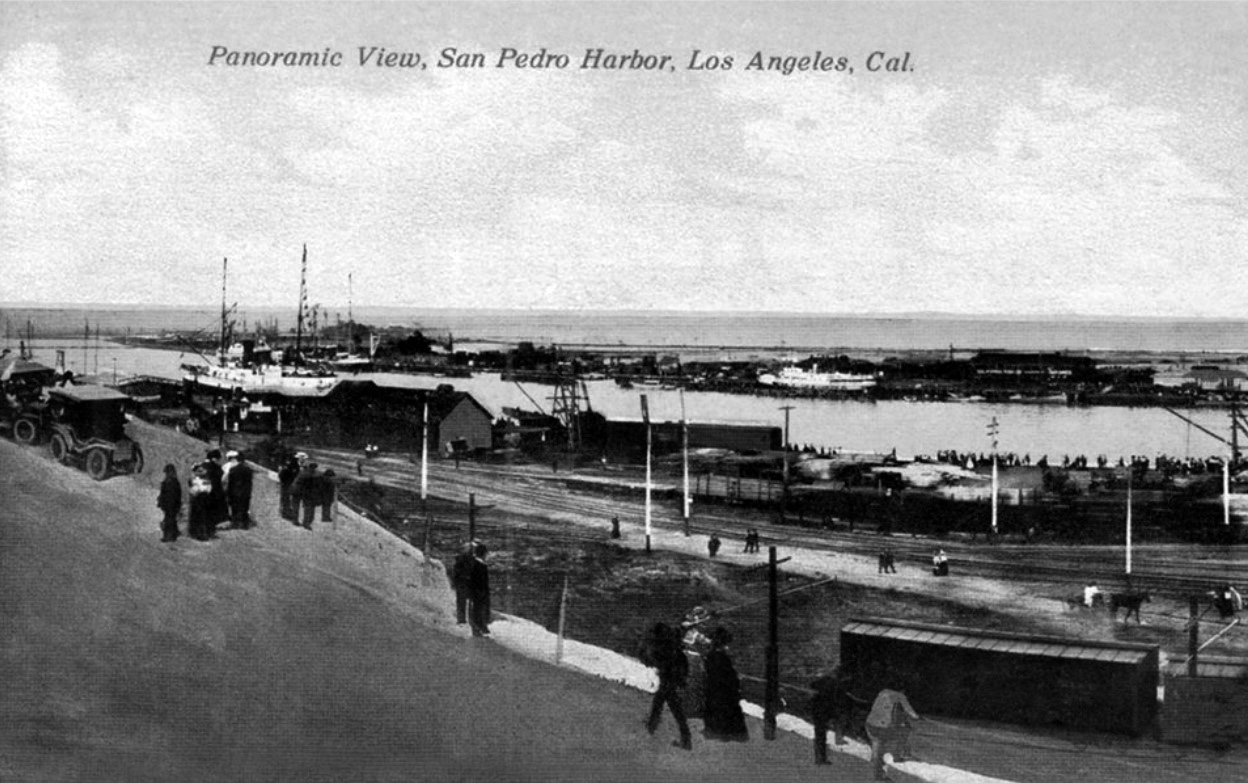 |
|
| (ca. 1907)^ - Panoramic postcard view showing people looking down toward the San Pedro Harbor. |
Wilmington Transportation Company
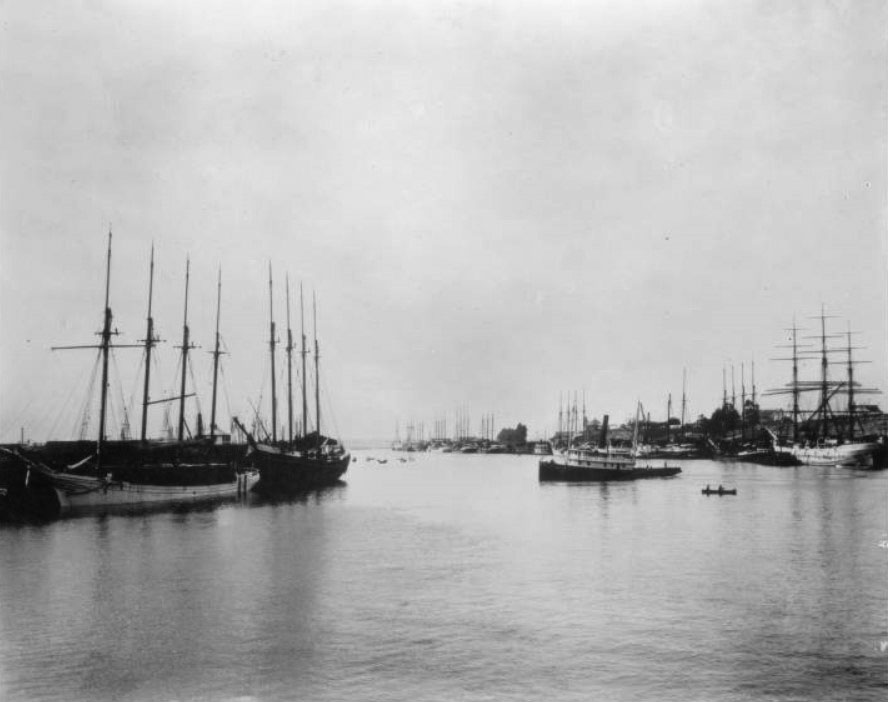 |
|
| (Early 1900s)^ – View showing the main channel of the Los Angeles Harbor. Both sides of the channel are lined with large, docked sailing vessels. Most of these have at least three masts, and both ships in the foreground on the left have four. There is a steam tugboat in the middle of the channel, traveling from the right side to the left. To the right of the tugboat is a small skiff occupied by two people. The Wilmington Transportation Company owned many of the steamboats that would transport passengers from San Pedro to Catalina. |
Historical Notes Wilmington Transportation Company (WTC) was founded in 1877 by the Bannings, and incorporated by Phineas Banning in 1884. In 1887, Santa Catalina Island owner George Shatto asked Captain William Banning to schedule one of his coastal steamers to make three weekly trips between Avalon and San Pedro to accommodate his vision of turning the island into a tourist destination. Banning’s Wilmington Transportation Company’s earliest vessels included the Cricket, Ferndale, Amelia, and Nellie. Each of these carried passengers between San Pedro and Avalon. In 1892 the Banning brothers, William, Hancock, and Joseph Brent, purchased the island for $128,740. WTC was deeded to the newly incorporated Santa Catalina Island Company, allowing the Bannings to enforce a monopoly of only WTC boats landing tourists on the island. With the success of WTC came the development of outside competitors.* |
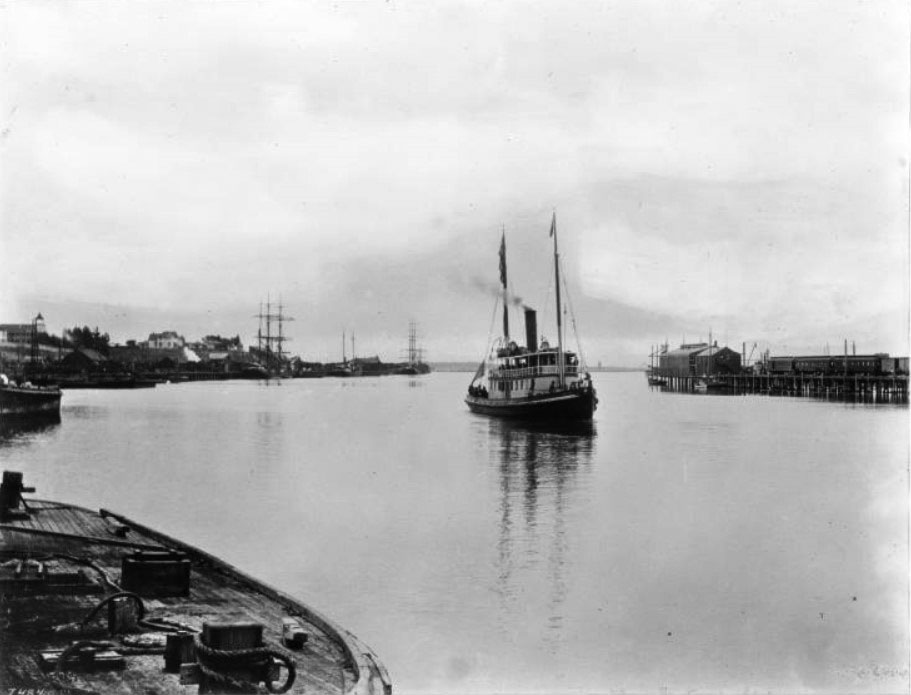 |
|
| (ca. 1905)^ – View of the Wilmington Transportation Company's steamboat "Falcon" in San Pedro Harbor. The boat, engaged in service to Catalina Island, is visible at center in the middle of the harbor. Harbor buildings are visible to the right, and town buildings are visible to the left. What is either a small dock, or the deck of a flat boat is visible in the lower left foreground. The boat itself sports a two-leveled cabin and two masts. People lean along the edges of the deck. |
Historical Notes The S.S. Falcon along with the S.S. Warrior played a significant role in Catalina Island’s early transportation history. They were an important part of the Wilmington Transportation Company fleet for many years. They carried hundreds of passengers across the channel to Catalina Island as well as freight and fresh water for the Island residents. |
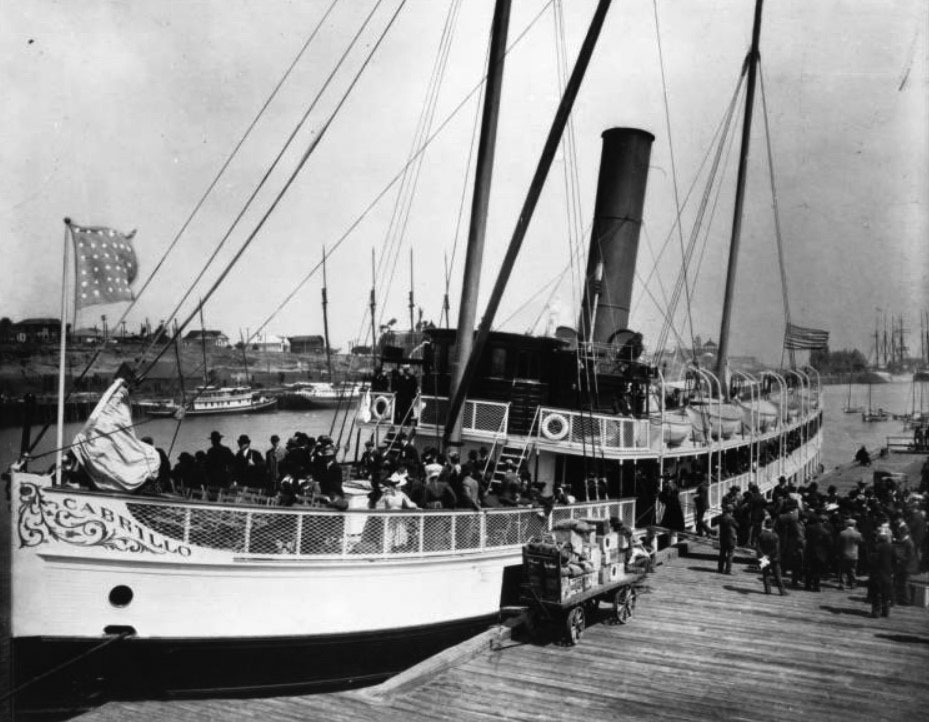 |
|
| (ca. 1904)^^ – View showing the Catalina passenger steamer S.S. Cabrillo loading passengers and freight alongside a Wilmington wharf in San Pedro. In addition to the prominent smoke stack rising from behind the pilothouse, the ship has two tall masts. A dark flag with light stars flies from the bow, and an American flag is on the stern. In the background there is one other unidentified steamer, along with numerous unidentified sailing vessels and several small sail fishing vessels. |
Historical Notes The S.S. Cabrillo, built at the Banning Company's shipyards at Port Los Angeles, was launched in 1904. Other vessels operated by the Banning Company were the gasoline screw Cricket, the gasoline screw Catalina, and the steam yacht Companero. |
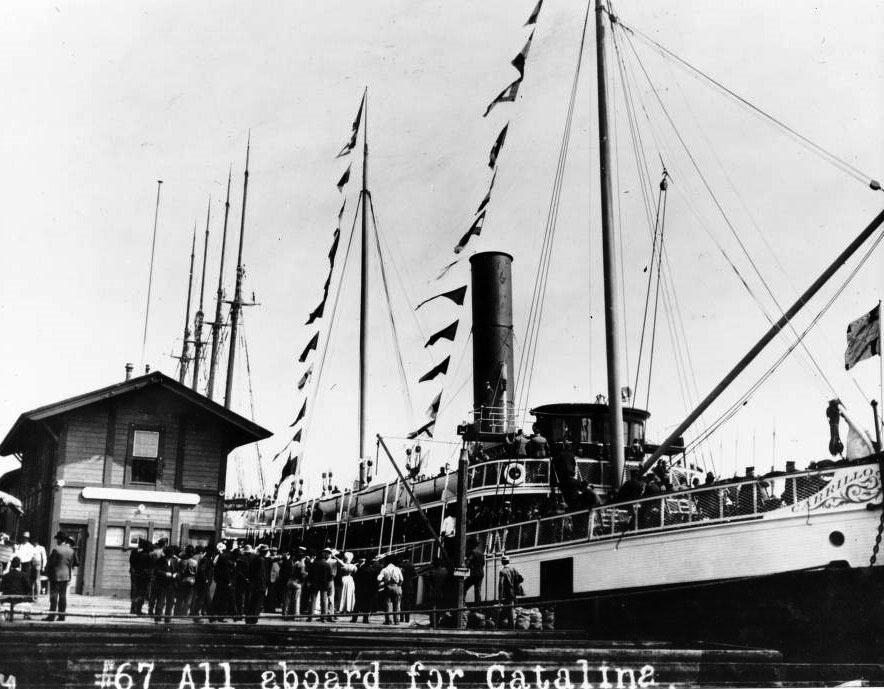 |
|
| (1907)^^ - View of Shriners boarding the S.S. Cabrillo steamboat ferry to Santa Catalina Island at the LA Harbor. |
Historical Notes After Phineas Banning passed away in 1885, the business was carried on by his three sons, William, Joseph Brent, and Hancock. The company purchased Santa Catalina Island, developed it as a resort and provided the ships for transportation. Wilmington Transportation Company, Santa Catalina Island Company, and Wilmington Development Company were subsidiary firms of the Banning Company. The company's real estate interests also grew and included land in Los Angeles, Pasadena, Newport Beach, as well as petroleum leases near Wilmington and Newport. The final dissolution of the company came in 1920 at the time of the death of Joseph Brent Banning. After this period, business papers are in the names of William Banning or Hancock Banning individually. |
Click HERE to see more in Early Views of Catalina |
San Pedro City Hall (1905 - 1908)
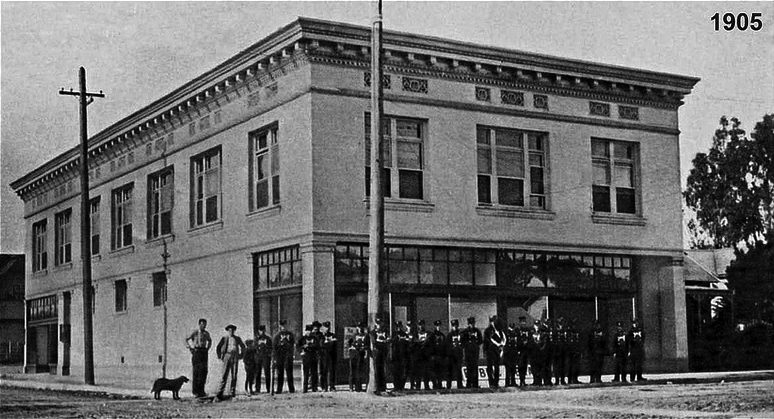 |
|
| (1905)^* - San Pedro's finest pose in front of their new City Hall with headquarters for the fire and police departments. |
Historical Notes The above building was San Pedro's City Hall from 1905 to 1908. It was built in 1905 at the northwest corner of 11th Street and Palos Verdes Street. The mayor at the time was Edward Mahar and he lived only one block south of there. The building served as San Pedro's city hall for only 3 short years when a new building was constructed on Beacon Street shortly after San Pedro was consolidated with Los Angeles in 1909. The building still stands today and is now the City Hall Market and the Alhambra Bar.^*^ |
 |
|
| (ca. 1904)#^*– Panoramic view showing Beacon Street on the left and the harbor with Tall Ships on the right. The San Pedro City Hall would be built in 1909 at the end of the park in the foreground. |
San Pedro City Hall (1909 - 1928)
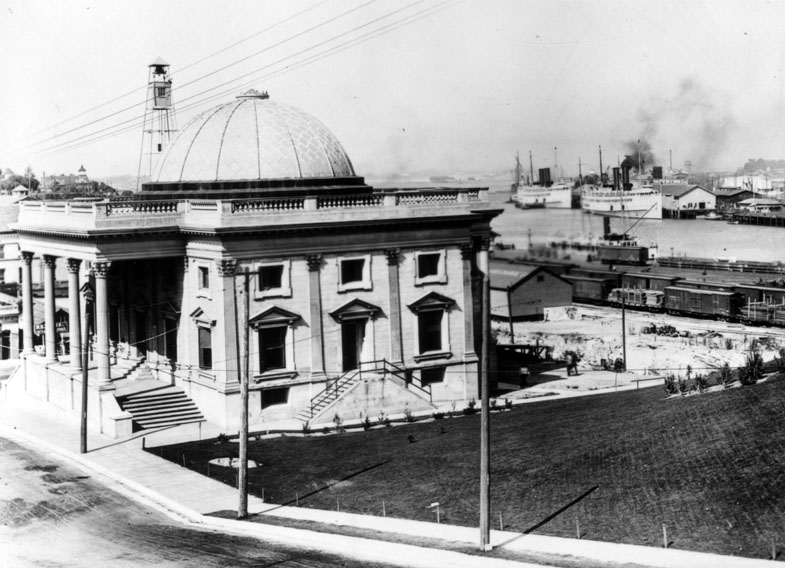 |
|
| (ca. 1909)* - View showing San Pedro City Hall located on Beacon between Wall and 5th streets. A rail yard and the Los Angeles Harbor are visible in the background on the right. |
Historical Notes The Classical Revival style City Hall building was constructed in 1909, the year San Pedro was annexed by the City of Los Angeles. It was designed by F.E. Allen of Pasadena and cost $40,000 to build.* |
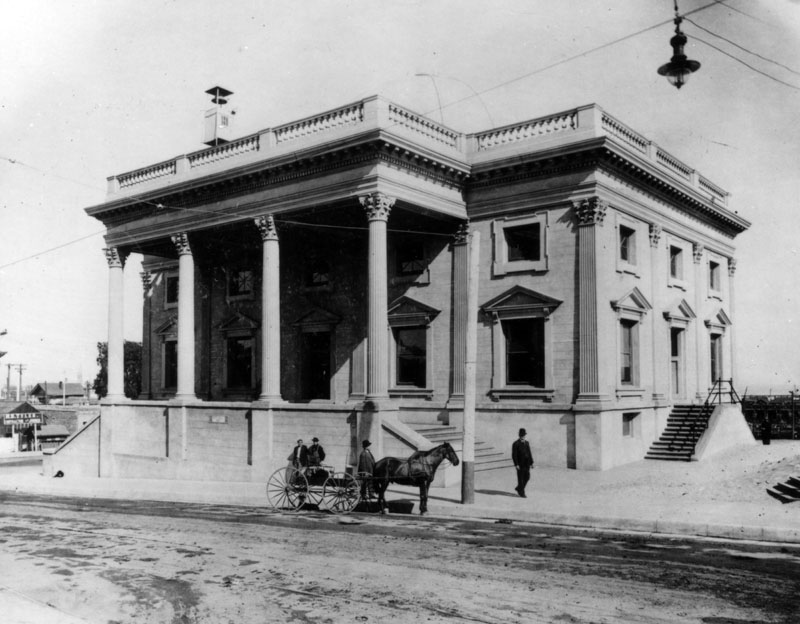 |
|
| (ca. 1909)* - Front view of the San Pedro City Hall. A horse-drawn wagon is parked in front of it on an upaved Beacon Street. |
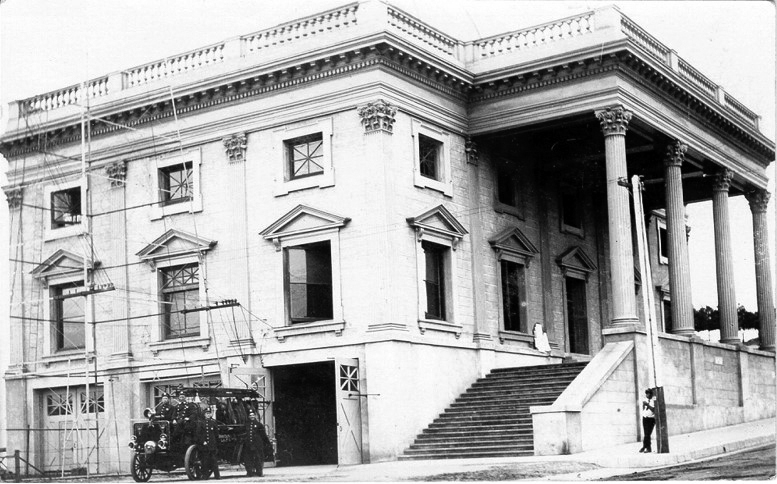 |
|
| (ca. 1909)^#* - Side view of San Pedro City Hall showing firemen posing in front of their new LAFD Engine and Station. |
Historical Notes After San Pedro was annexed by Los Angeles in 1909, LAFD Hose Co. 6 was incorporated into the new San Pedro City Hall building at 630 Beacon Street. |
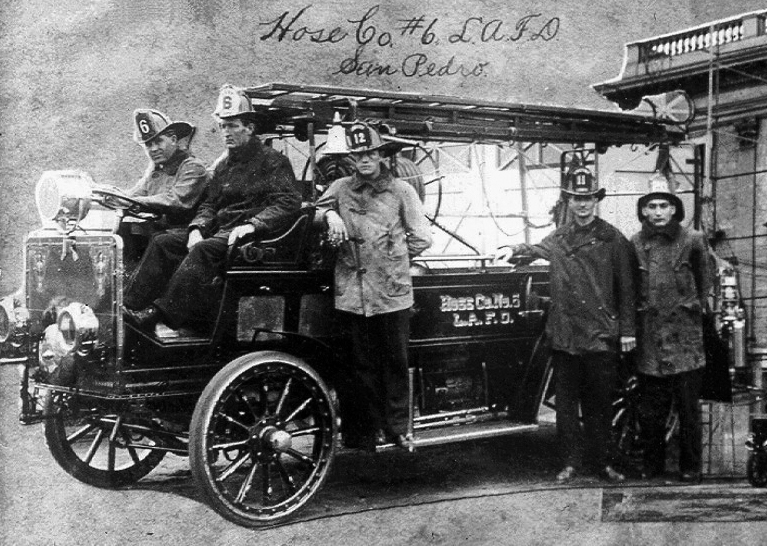 |
|
| (ca. 1909)^#* - Close-up view of Hose Co. #6, LAFD, San Pedro adjacent to their new station at San Pedro City Hall. |
Historical Notes The first San Pedro fire volunteers formed in 1889. Their fire house was located on Sixth Street, across from Crockers’ Hall. In 1905 they moved to the northwest corner 11th Street and Palos Verdes Street, into the building used, for just a brief period time, as San Pedro’s City Hall. On August 28, 1909, Hose Company No. 6 was organized. The fire house was located at 630 Beacon Street (Wall & Beacon) which was part of the new San Pedro City Hall. In 1915, Hose Company No. 6 was disbanded to organize Engine Company No. 36. Their new location was 638 Beacon Street, again site of San Pedro's City Hall.^#* |
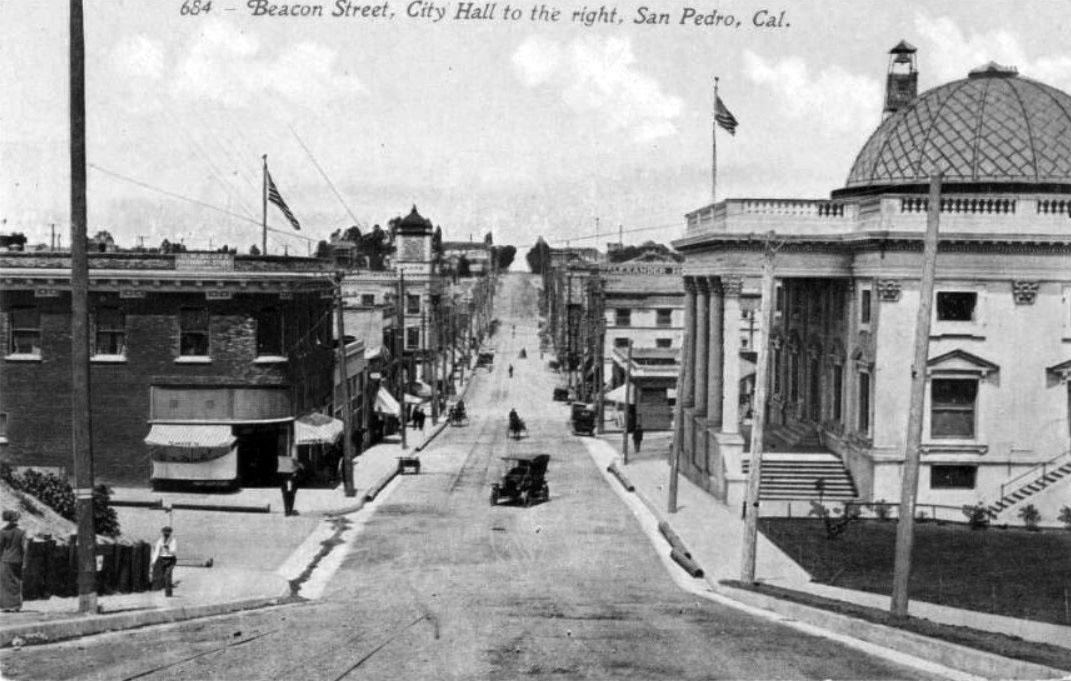 |
|
| (ca. 1910)^#^^ - Postcard view looking down Beacon Street with City Hall at right. Horse-drawn wagons and an early model car share the street. |
 |
|
| (1909)* – (Left Panel) Panoramic view of San Pedro with City Hall at left and harbor on the right. |
Historical Notes The beautiful Classical Revival style City Hall building would be demolished in 1928 to make room for the current San Pedro City Hall and Municipal Building. |
.jpg) |
|
| (1909)* – (Right Panel) Panoramic view of San Pedro Harbor with Deadman's Island at right. |
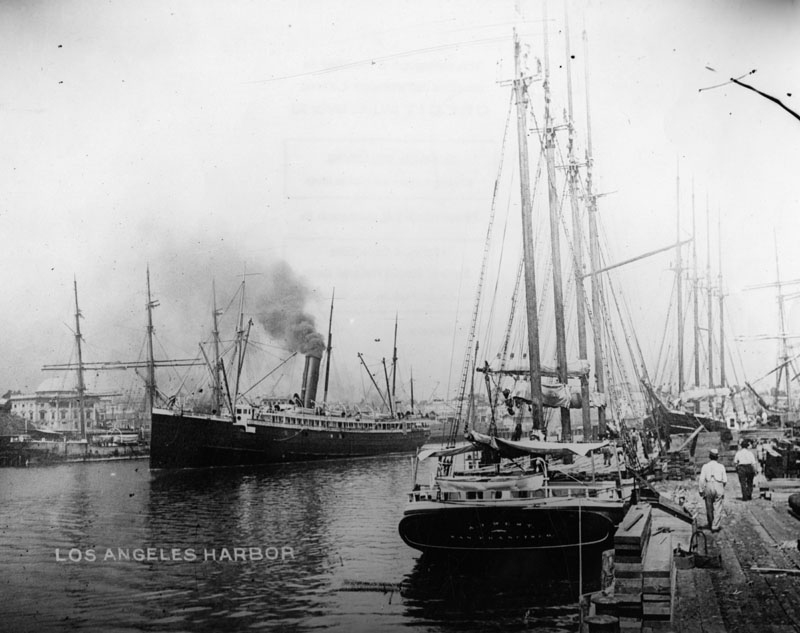 |
|
| (ca. 1909)* - A steam ferry and sailing freighters in the Los Angeles Harbor at San Pedro. The new City Hall can be seen in the background (left side of photo). |
Great White Fleet
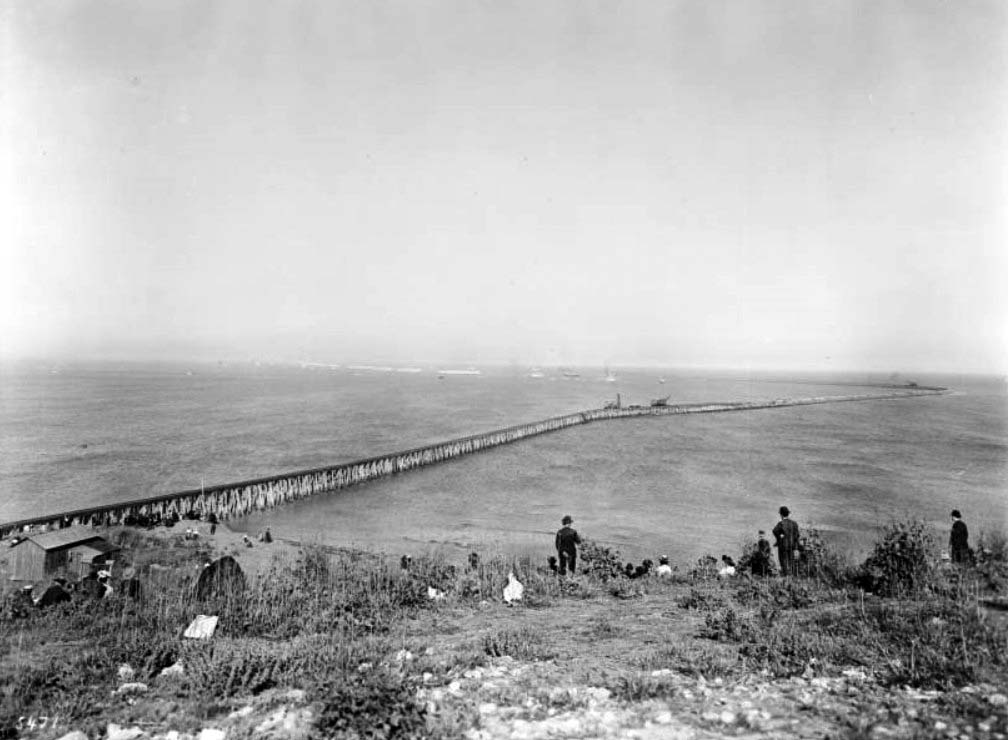 |
|
| (1908)^^ - Photograph of spectators watching the "Great White Fleet" enter the Los Angeles Harbor, April 1908. Spectators crowd the base of the breakwater to get a better view of the ships, as they will soon pass the area and head towards the piers. |
Historical Notes The U.S. Atlantic Battle Fleet, nicknamed the Great White Fleet, debuted on the world stage during the Spanish-American War and was one of the markings of President Theodore Roosevelt's "Big Stick" diplomacy.^^ |
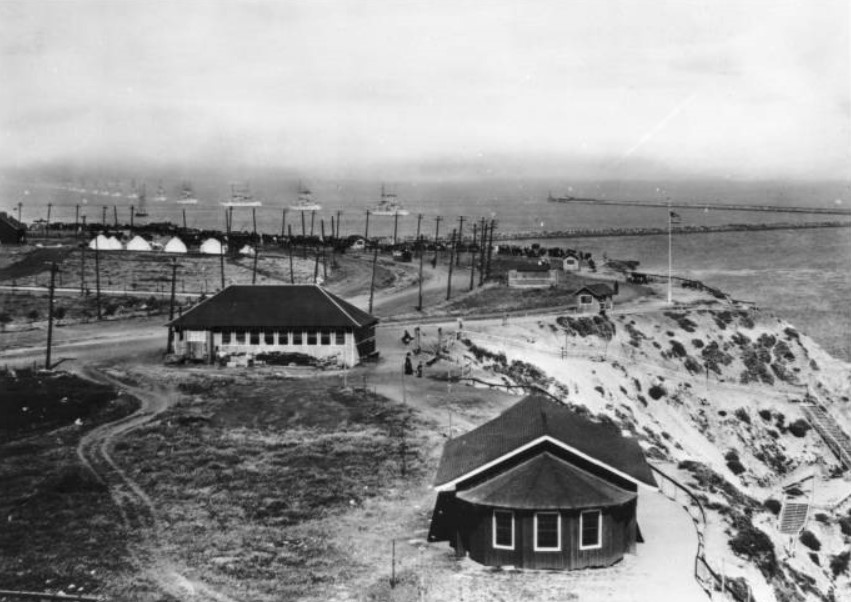 |
|
| (1908)^^ - Photograph of the America's Great White Fleet passing the San Pedro breakwater to enter Los Angeles Harbor. Beach houses are visible scattered along the side of a winding road lined by utility poles, while the United States Atlantic Battle Fleet steams across the harbor in formation. The breakwater is visible to the right, in front of some wooden steps built as a way to climb the dunes. |
Historical Notes From December, 1907 to February, 1909 the US Atlantic Fleet steamed around the world on a mission of 'Gunboat Diplomacy'. The ships, commonly known as the 'Great White Fleet' due to their white-painted hulls, called in ports the world over, impressing foreign dignitaries with the appearance of great power. The entire affair was designed to impress, and everything was done to make sure the fleet's appearance was perfect. The ships, however, were not all they appeared to be. HMS Dreadnought had been in commission for a year, effectively rendering all the US ships obsolete. Two of the ships had such severe mechanical problems that they could not complete the cruise, and two more were obsolete and unfit for battle. It was great show, but the military value of the fleet was questionable.^^ |
.jpg) |
|
| (1908)* - Groups of people on shore, watch as the "Great White Fleet" enters the L.A. Harbor. The tressle for the breakwater is in the foreground. Breakwaters can be seen in the background (right side). |
 |
|
| (1908)^x^ - Visitors line up in San Pedro to tour a US Navy battleship, one of a number of war vessels of the Great White Fleet, which circumnavigated the globe between 1907 and 1909. |
Historical Notes This was the last great hurrah for the age of white ships, buff masts and high diplomacy on the high seas. As soon as the ships returned from the cruise they were stripped of their fancywork and much of their bridgework, painted gray, and had their pole masts replaced by functional but unsightly cage masts.^^ |
* * * * * |
.jpg) |
|
| (1909)* - Local school kids stand along an unpaved Pacific Avenue waving Americal flags as President Taft and his motorcade drive by. |
Historical Notes On August 28, 1909, San Pedro and Wilmington were annexed into Los Angeles and became Los Angeles Harbor. On October 9,1909, President Taft visited San Pedro to see the harbor and to see the land which would become Fort MacArthur. His motorcade went down Pacific Avenue and the local school kids stood along the unpaved road and waved American flags. Taft was the only Sitting President to visit San Pedro. |
| (ca. 1907)^^ - Photograph of Spectators watching a bicyclist on Beacon Street, between Fifth Street and Sixth Street looking east. The lone cyclist occupies the dirt street which is lined with a sparse crowd of onlookers standing in front of the commercial facades. A man watches from a balcony. One legible sign reads "Restaurant". |
| (ca. 1905)^^ - View of Beacon Street looking north. The sign on the building on the left reads “GEO. H. PECK & CO. REAL ESTATE”. The building with the clock tower in the background is the San Pedro Bank Building. |
| (1910)^*^* – View of Beacon Street with American flags seen throughout in what appears to be 4th of July. Streetcars share the street with horse-drawn wagons. |
| (1910)^^ - Beacon Street in San Pedro looking north. Horse-drawn carriages can be seen throughout. A man crosses the street and walks towards the San Pedro Bank Building with its prominent clock tower |
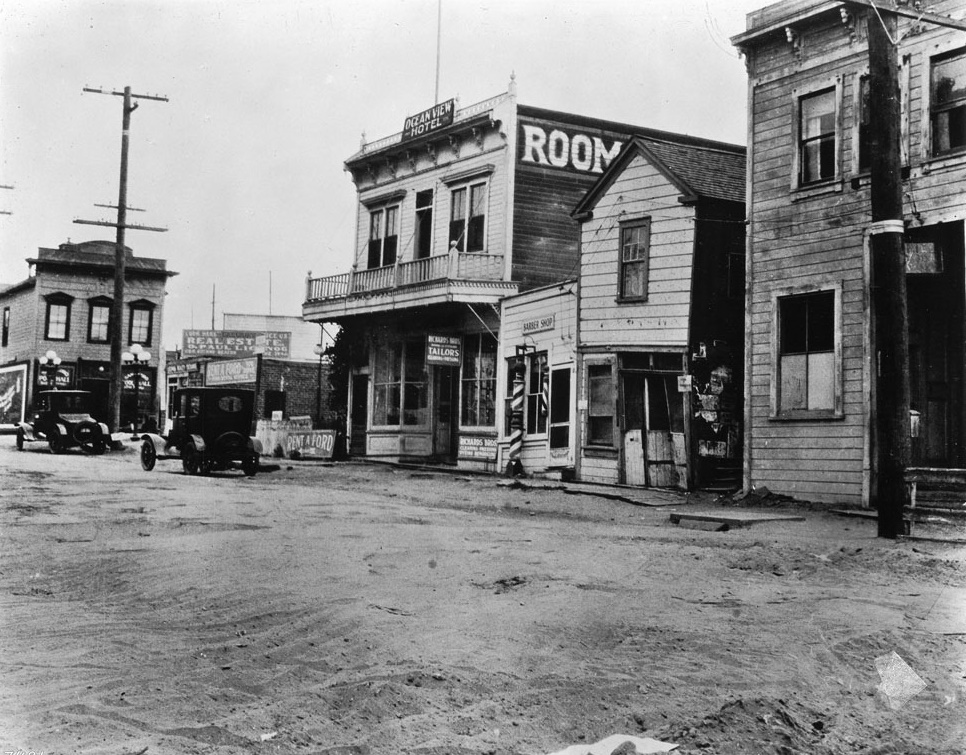 |
|
| (1910s)^^ - View of Front Street (the site of 'new' City Hall) in San Pedro, Los Angeles. |
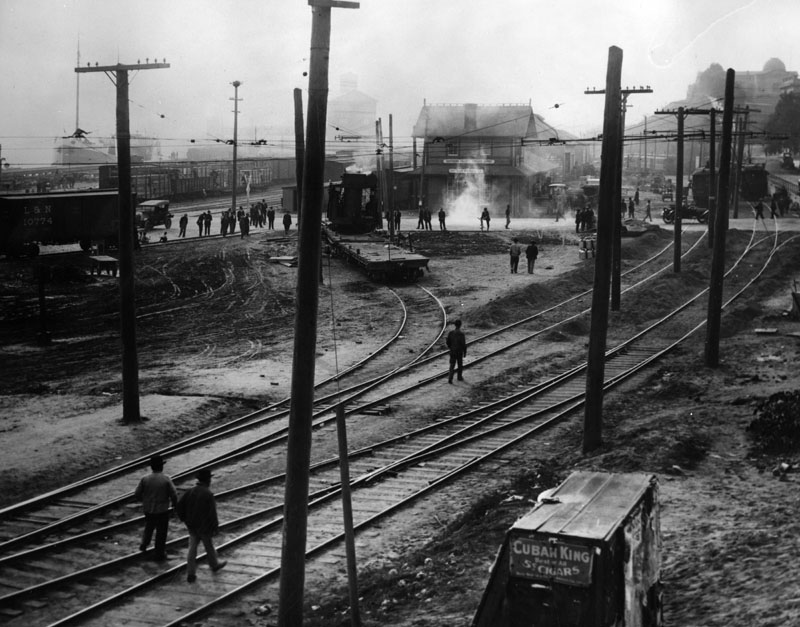 |
|
| (1910)* - View of the Southern Pacific freight yard and depot looking south from 4th Street and Harbor Boulevard in San Pedro. |
 |
|
| (ca. 1911)* - Elevated boardwalk over water runs along a street on the waterfront. Mud from dredging the harbor was used to elevate the land along the waterfront. |
Historical Notes “Wilmington streets have all been renamed. Well, not all, but almost all of them have been renamed. And Canal Street is the most obvious. Because Canal Street was literally a canal. The buildings were built up high, they were on stilts because this was a mud flat and it flooded all the time. So they ended up filling in the street so that when you look at it now, the buildings that are there, some of the old buildings, the first floors are now the basements." Canal Street is gone. It's now known as Avalon Boulevard.^*# |
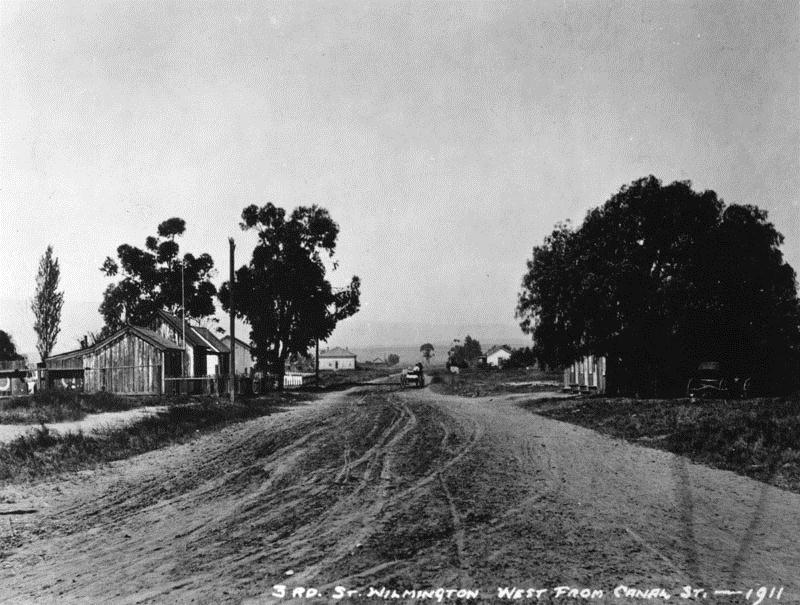 |
|
| (1911)* - View of Third Street west from Canal Street (now Avalon). A horse-drawn wagon can be seen down the unpaved road. |
.jpg) |
|
| (1911)* - View of Canal (now Avalon Blvd.) and 3rd Streets in Wilmington. St. John's Episcopal Church is seen on the right. A railroad track cuts across the foreground. |
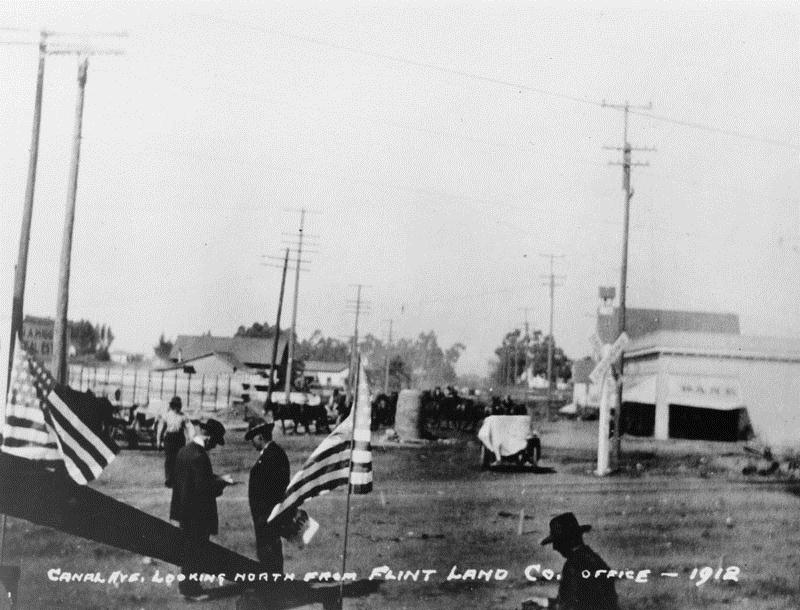 |
|
| (1912)* - Canal Ave (now Avalon Blvd), Wilmington, looking north from the Flint Land Co. office. |
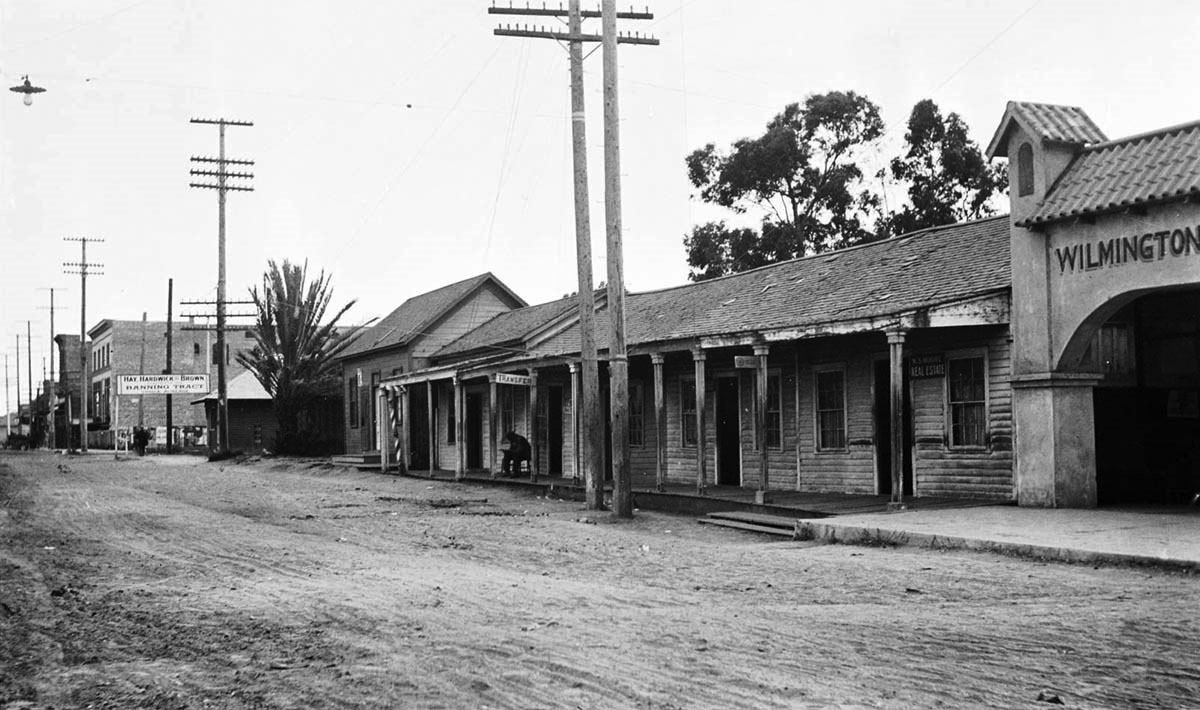 |
|
| (ca. 1900)^^ – View of Canal Street (later renamed Avalon Boulevard) looking toward C Street from south of D Street. There is a long, low wooden building at right with a covered porch held up by rectangular posts with a sign for the W. S. Moore Real Estate. To the far right is the Wilmington Chamber of Commerce. |
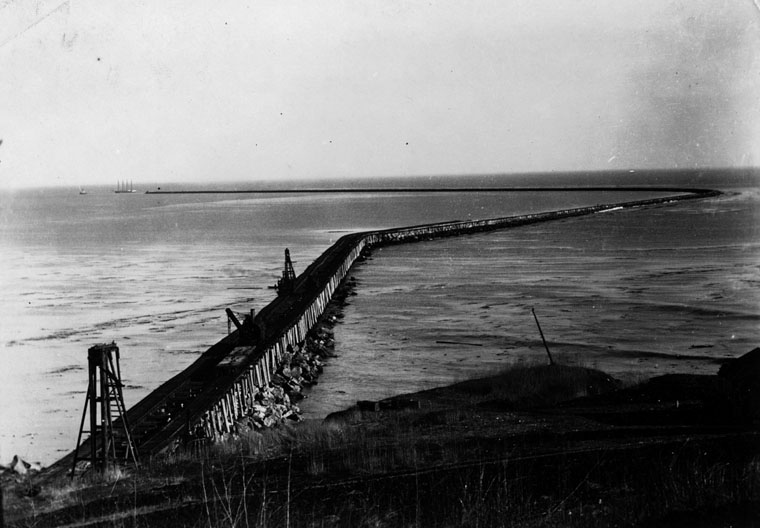 |
|
| (ca. 1910s)* - Breakwaters at San Pedro which is 9,250 feet in length. |
Historical Notes Between 1911 and 1912 the first 8,500-foot section of the breakwater was completed, and the Main Channel was widened to 800 feet and dredged to a depth of 30 feet to accommodate the largest vessels of that era.*^^ |
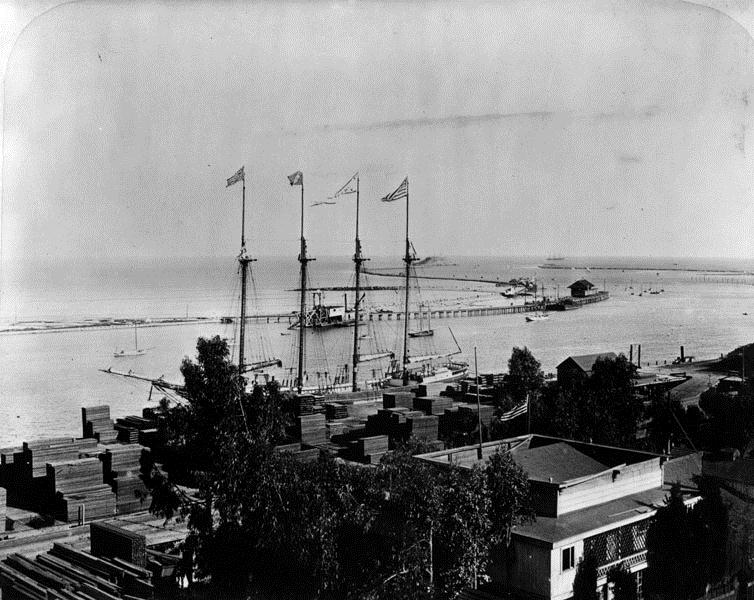 |
|
| (ca. 1910s)* - View of a large four masted ship anchored alongside a lumber dock at L.A. Harbor. Breakwaters and Deadman's Island can be seen in the background. |
Historical Notes Over the years the harbor would see additional improvements and expansions: In 1912 the Southern Pacific Railroad completed its first major wharf at the port. In 1913, the Los Angeles Angels Lighthouse was constructed at the end of the breakwater. During the 1920s, the port passed San Francisco as the west coast's busiest seaport. In the early 1930s a massive expansion of the port was taken with the construction of a breakwater three miles out that was over 2 miles in length. In addition to the construction of this outer breakwater an inner breakwater was built off of Terminal Island with docks for sea going ships and smaller docks built at Long Beach.*^ |
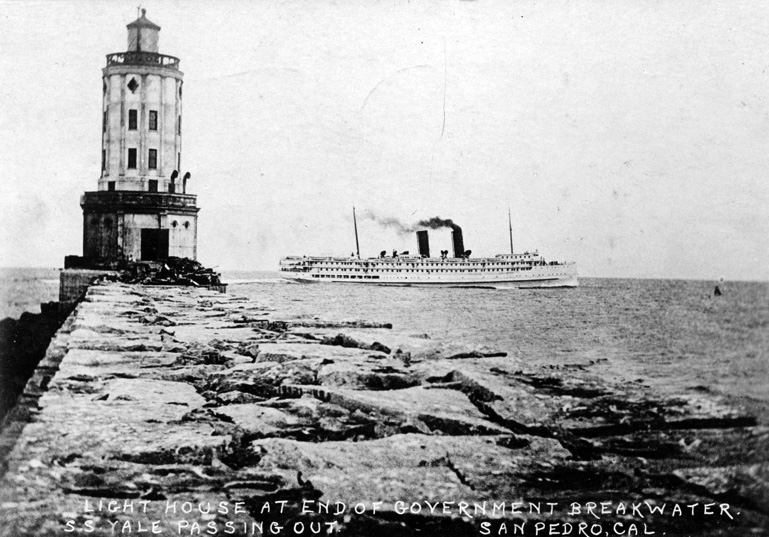 |
|
| (1918)* - Postcard view of the steamboat S.S. Yale passing by the Los Angeles Harbor Lighthouse. |
Historical Notes The Los Angeles Harbor Light (also known as Angels Gate Light) was built in 1913 at the end of the San Pedro breakwater. The original plan for the lighthouse was a wooden, square, two-story building like those constructed for Oakland Harbor and Southampton Shoals. However, the plans were changed and the Los Angeles Light was firmly anchored to the concrete block and built of steel reinforced concrete. It is the only lighthouse ever built to this design. The original paint on the lighthouse was only white which caused a problem with seeing the lighthouse building during fog. Vertical black stripes were added for increased visibility.
SS Yale, a coastal passenger steamship, was built by the Delaware River Iron Shipbuilding and Engine Works in 1906. In March 1918 the U.S. Navy acquired her from the Pacific Steamship Company of Seattle, Washington, placing her in commission later in that month as USS Yale. USS Yale served between March 1918 and September 1919. During World War I, the steamboat made 31 round-trip voyages transporting troops between Britain and France. Yale was decommissioned in early September 1919 and, in June 1920, sold for commercial operation along the Pacific Coast.*^ Click HERE to see more on the S.S. Yale. |
.jpg) |
|
| (1937)* - Los Angeles Harbor Light, lighthouse with octagon base and vertical stripes, photographed from ocean, with crowd of people on breakwater and rocks at base, with water in foreground, hills in background, ship partially visible at right. Los Angeles Times Photo |
Historical Notes The Los Angeles Harbor Light, also known as the Angels Gate Lighthouse, was built in 1913, automated in 1972, and refurbished in 2012. The bottom story of the lighthouse originally housed the station’s fog signal equipment along with water and fuel tanks, and the floor above this contained storage space and a bathroom. The third story housed a kitchen, pantry, and living room, while the fourth story had a bathroom and two bedrooms for the keepers, whose families were housed on shore, and the fifth story had a third bedroom and the watchroom.* |
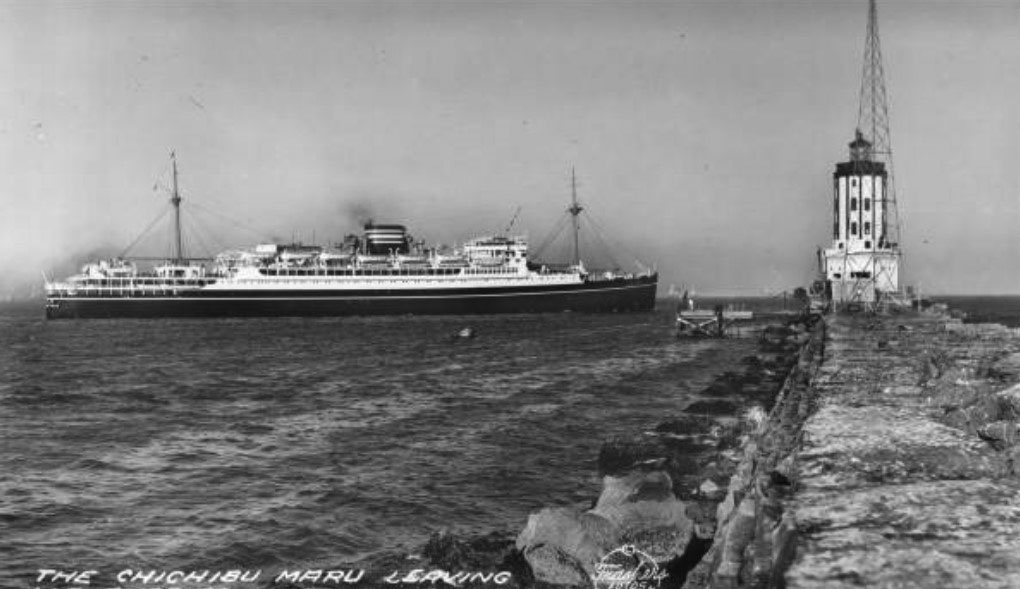 |
|
| (1938)**** – Postcard view showing the Chichibu Maru passing by the Harbor Lighthouse as it leaves Los Angeles Harbor. |
Historical Notes Since 1913, the light has stood, but a 5-day storm in 1939 caused it to tilt inland a bit.
Built in 1930, the Chichibu Maru was a Japanese passenger, later renamed Kamakura Maru. Before the war, the ship carried passengers between Yokohama and San Francisco. In 1942 she was confiscated by the Imperial Japanese Navy to serve as a troop transport ship, and also as hospital ship. On April 28, 1943, the Kamakura Maru, sailing from Manila to Singapore and carrying some 2,500 soldiers and civilians, was torpedoed by the US submarine USS Gudgeon. The ship was hit by two torpedoes and sank within 12 minutes. Four days later, 465 survivors were rescued from the sea by Japanese ships, meaning some 2,035 people were killed.*^ |
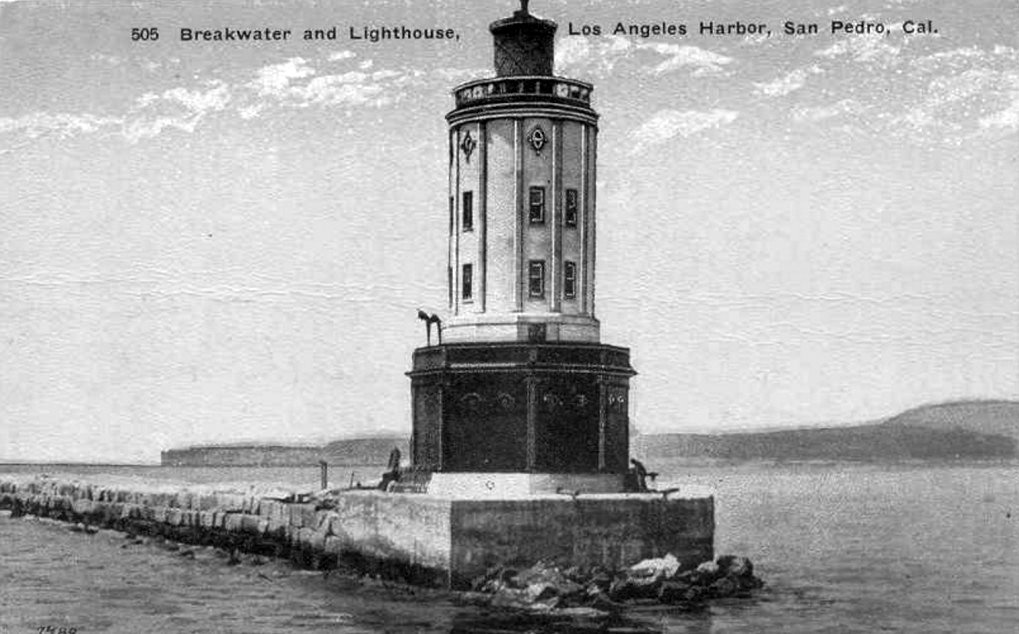 |
|
| (n.d.)^* - Postcard view showing the Breakwater and Lighthouse at Los Angeles Harbor. |
Historical Notes The lighthouse was built around twelve steel columns and sits at the end of the 9,250-foot San Pedro breakwater. The base of the structure is octagonal and covered with steel plates, while the upper section is cylindrical and built using cement plaster on metal lath. ^* |
.jpg) |
|
| (1949)* - A party touring by boat views the Los Angeles Harbor Lighthouse, also known as the Angels Gate Lighthouse. In 1949, the lighthouse still had its wartime walkway collar and a small bridge to a boat landing; these were later removed. |
Historical Notes Note bridge to boat landing and walkway around upper portion of tower. This walkway was removed in 1957. |
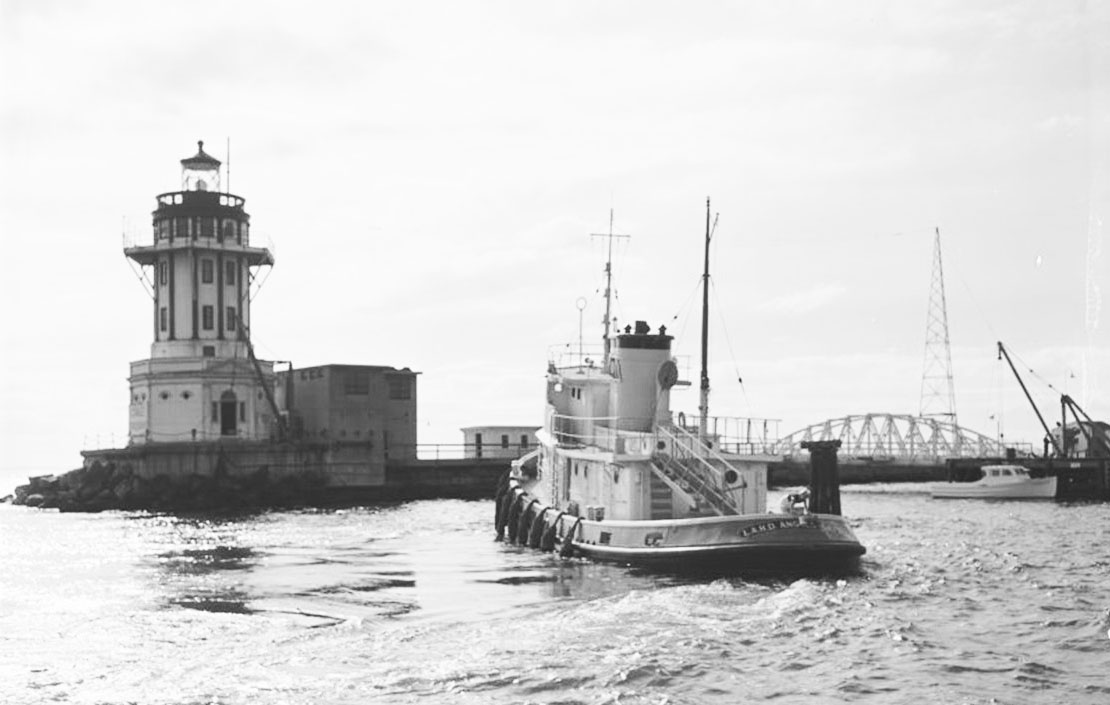 |
|
| (1955)* – A tugboat approaches Angels Gate Light. |
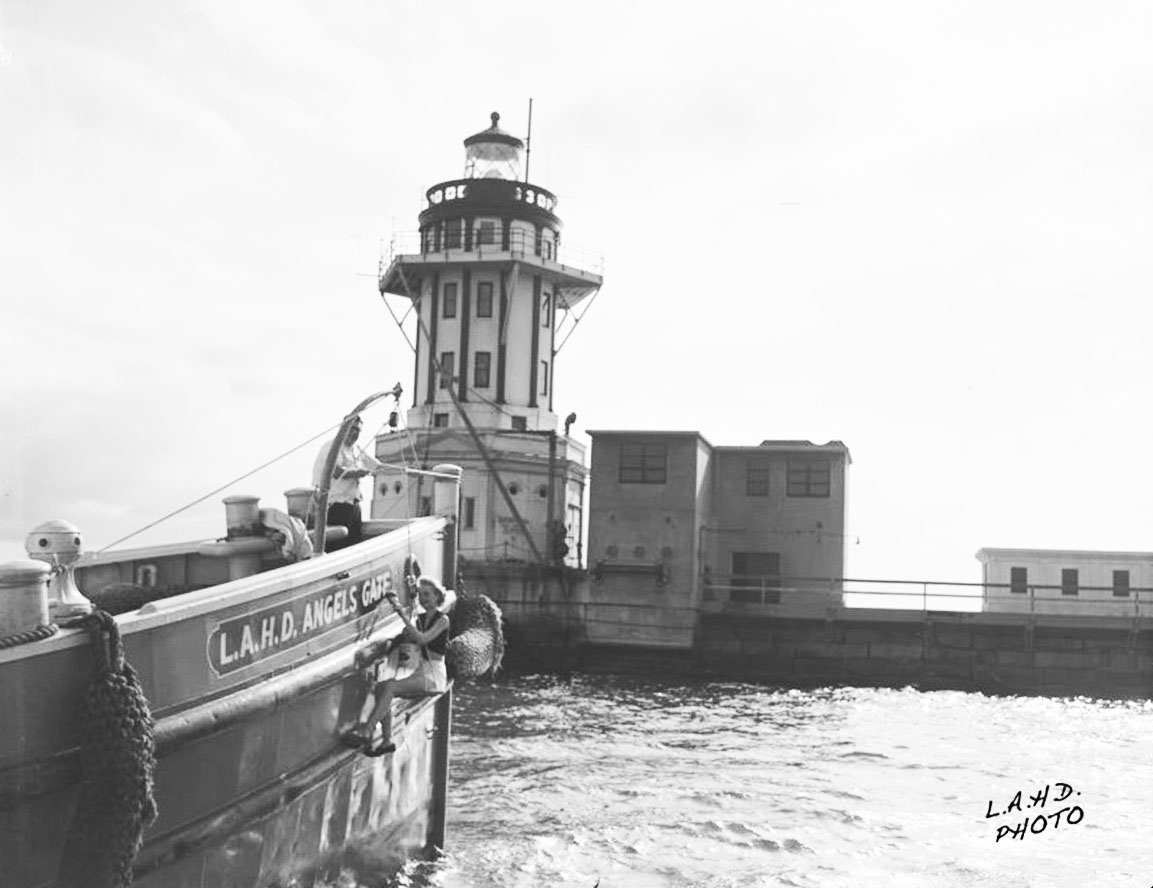 |
|
| (1955)*– Angels Gate Light and tugboat of same name. |
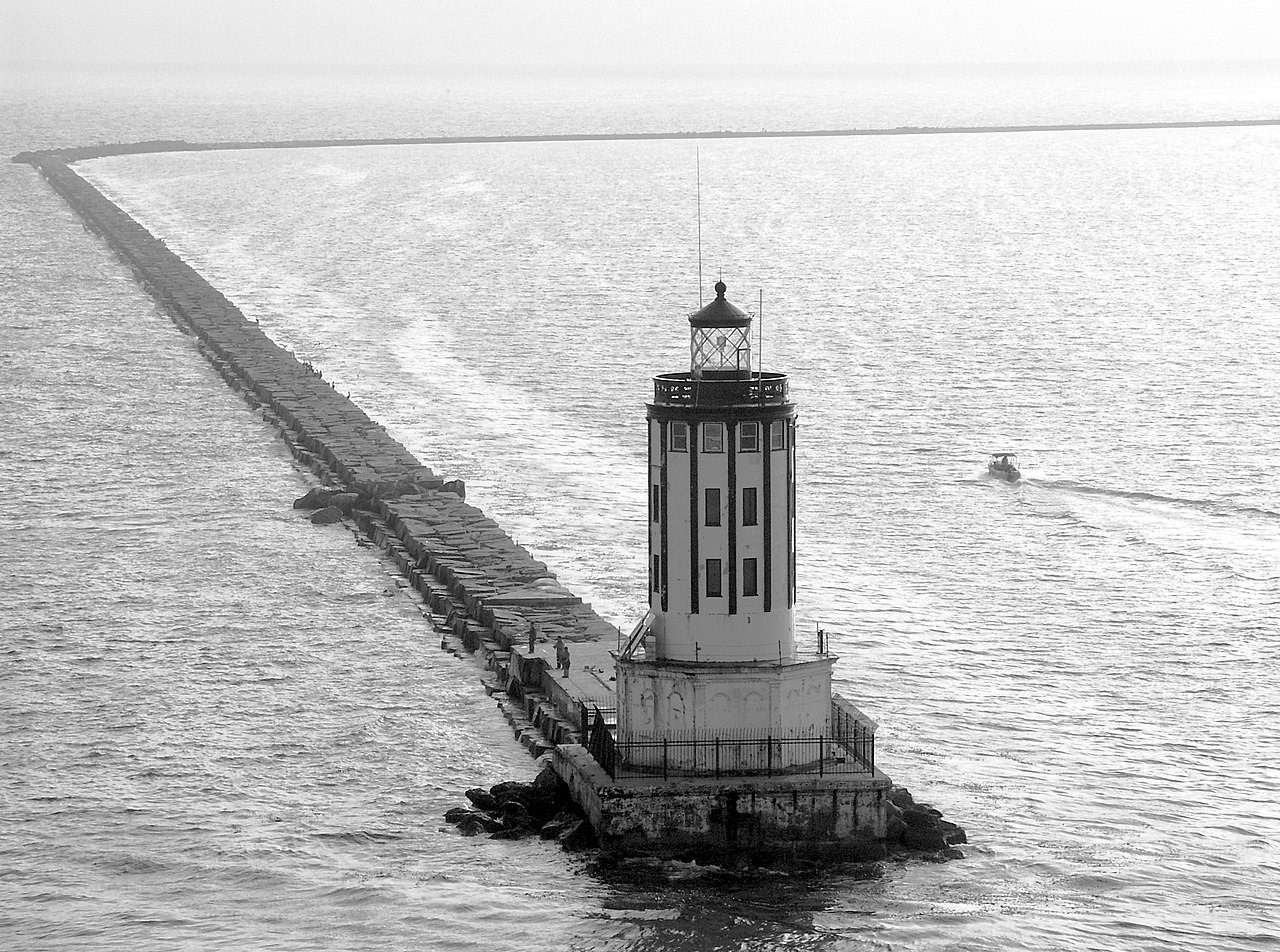 |
|
| (2006)^ - Los Angeles Harbor Light (aka Angels Gate Light). Photo by Steve Hedin |
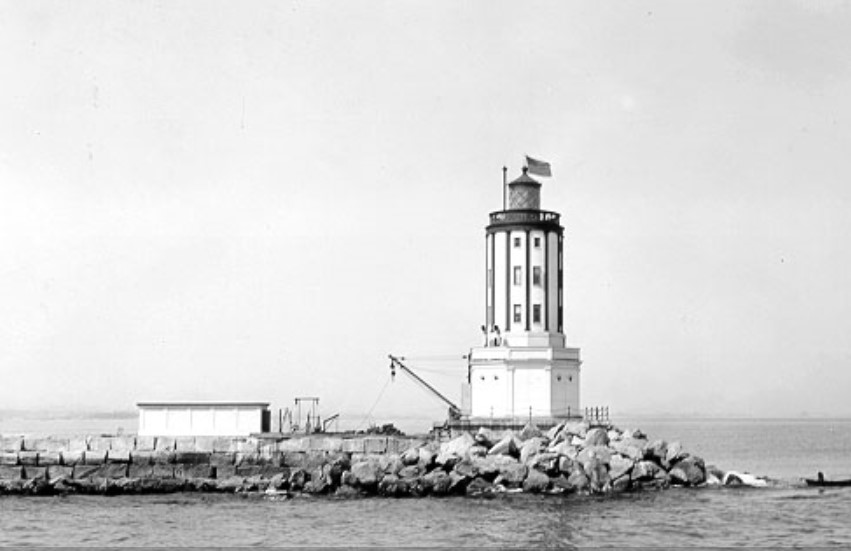 |
|
| (2008)* – View of the Los Angeles Harbor Light, also known as lighthouse, at San Pedro Breakwater in Los Angeles Harbor. |
Historical Notes The original paint on the lighthouse was only white which caused a problem with seeing the lighthouse building during fog. Vertical black stripes were added for increased visibility. |
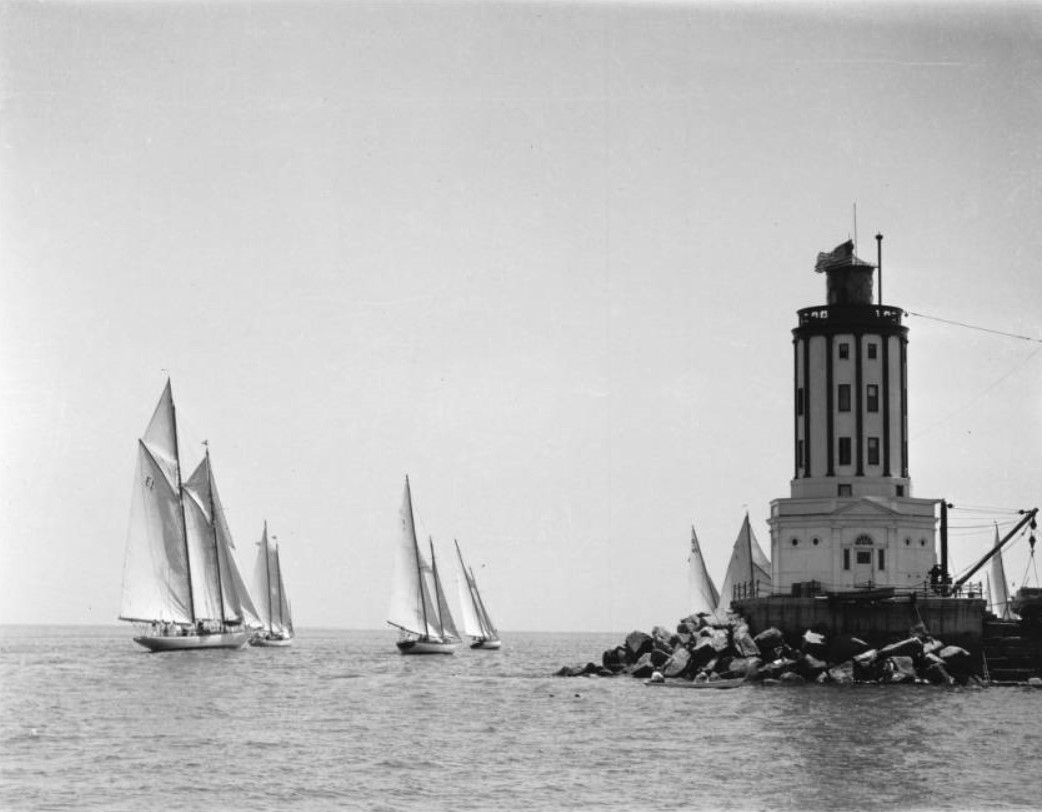 |
|
| (n.d.)^^ – Picturesque view showing yachts sailing around the Los Angeles Harbor Lighthouse. |
Historical Notes In 1980, the lighthouse was listed on the National Register of Historic Places. It is also listed as Los Angeles Light in the USCG Lights list. |
Then and Now
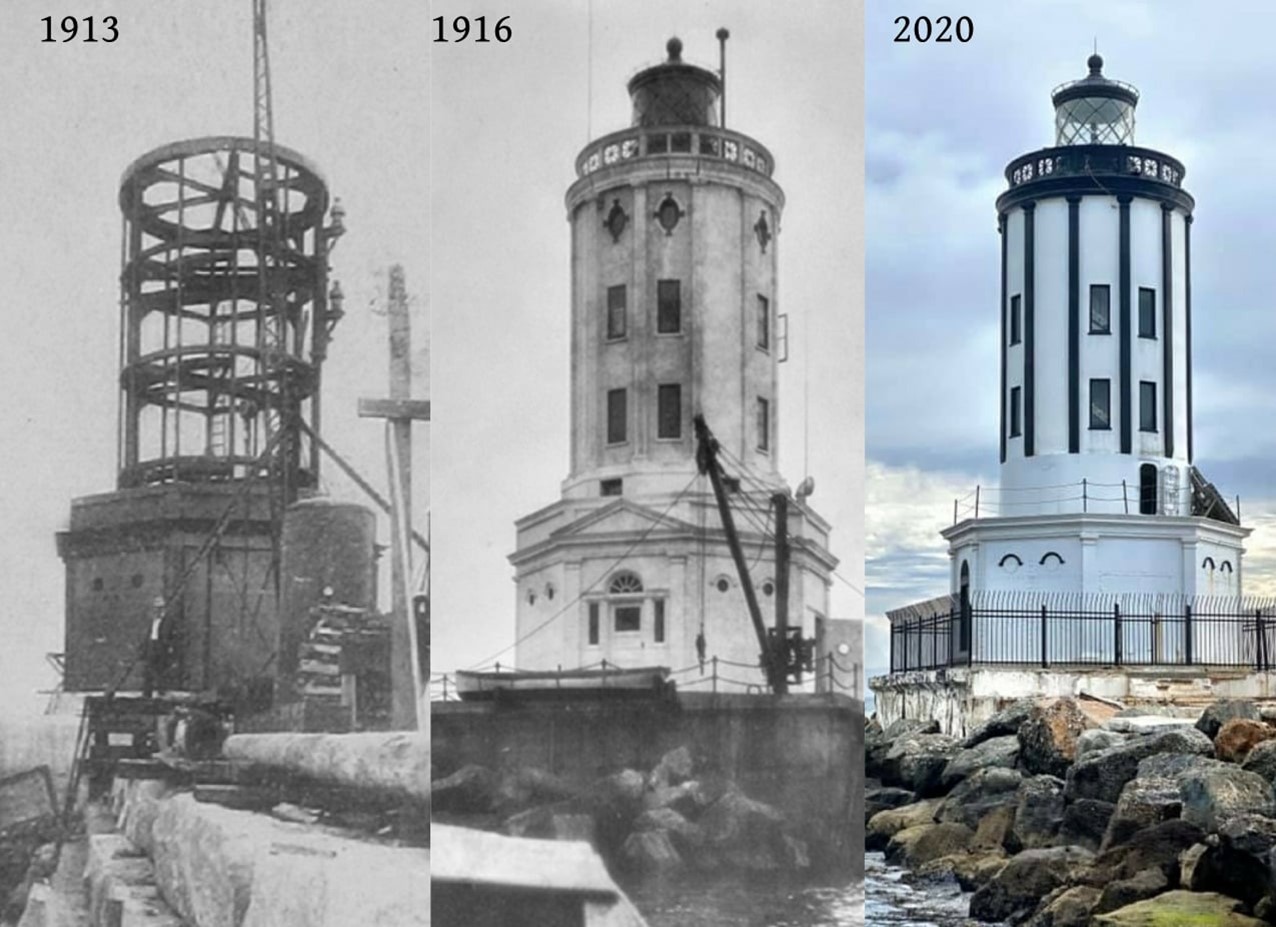 |
|
| Los Angeles Harbor (Angels Gate) Lighthouse* |
Historical Notes By 2011, the years of exposure had led to rusted through walls, broken windows, cracked masonry, and leaks during storms. In cooperation with the Coast Guard, the Cabrillo Beach Boosters Club completed a $1.8 million overhaul of the exterior, funded by the Port of Los Angeles. The overhaul was completed in May of 2012. A $1.2 million overhaul of the interior is planned.* |
* * * * * |
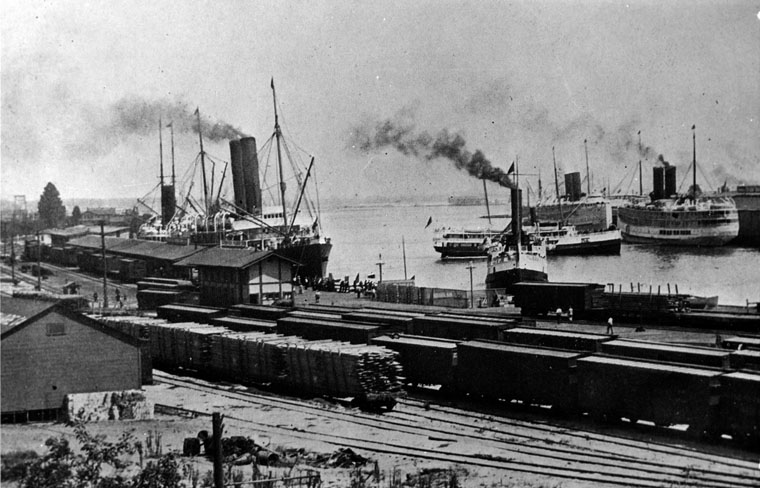 |
|
| (1913)* - The Port of Los Angeles in 1913. The harbor appears to be filled to capacity with steam ships and train cars are full of cargo. |
Historical Notes Lumber was in enormous demand as a result of the growing towns surrounding San Pedro.*^^ |
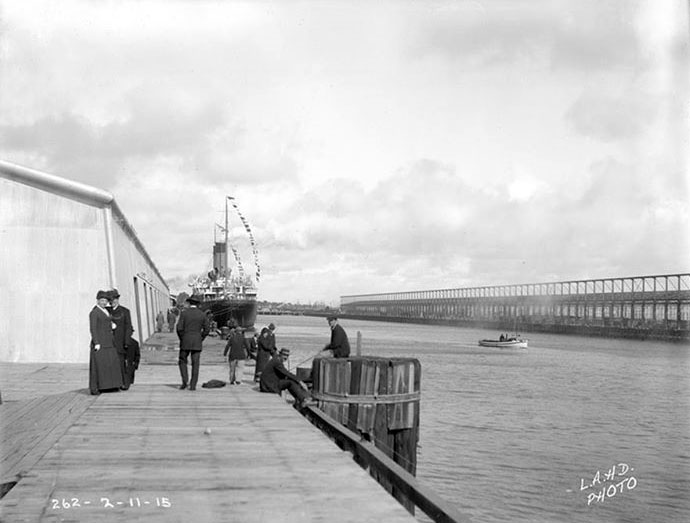 |
|
| (1915)#*^ - View looking north up the East Channel toward 22nd Street in San Pedro, showing spectators on the wharf between Berths 51-53, February 11, 1915. |
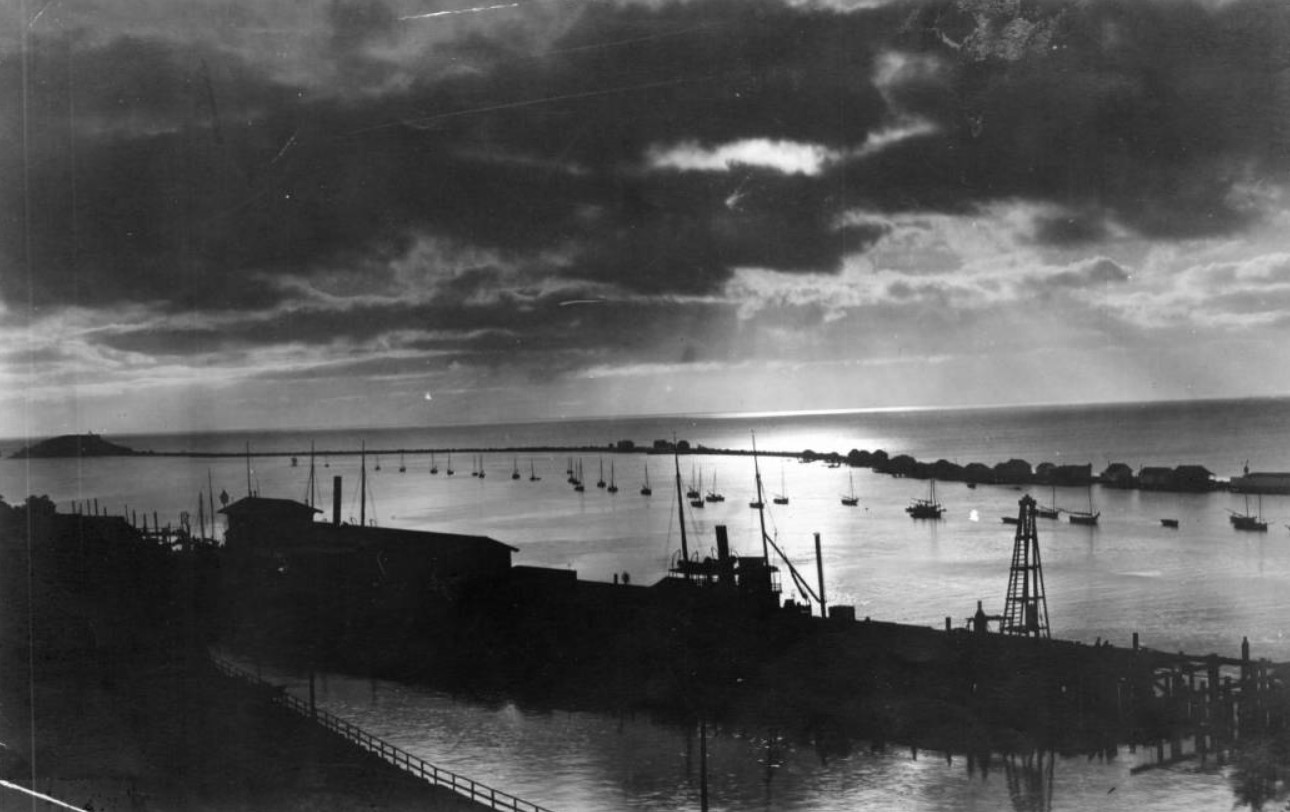 |
|
| (ca. 1915)^^ - View of the Los Angeles Harbor at night. The silhouette of maintenance and shipping buildings are visible on a small wharf in the foreground, while small schooners and sloops can be seen anchored out in the harbor behind them. Dead Man's Island is visible at left at the end of the breakwater, while a smaller patch of water is visible in the foreground, edged by a guard rail. The moon is hidden by the clouds. |
* * * * * |
S.S. Yale and S.S. Harvard
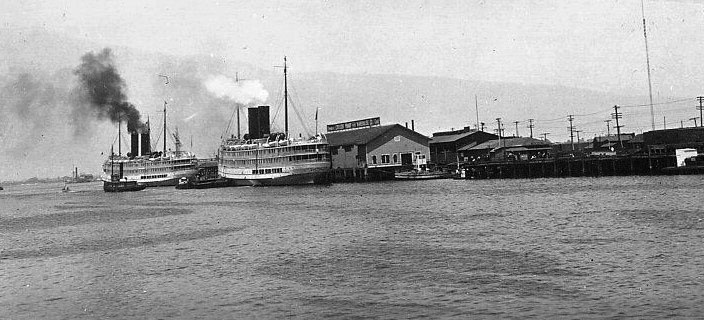 |
|
| (1915)^.^ - SS YALE and SS HARVARD from their San Francisco and San Diego routes docked together in San Pedro (Los Angeles). |
Historical Notes The SS Yale and SS Harvard became known as “white Flyers of the Pacific”. The sister ships each made four sailings a week, carrying 565 First Class passengers at an average speed of 23 knots between the Los Angeles and San Francisco, and later San Diego. |
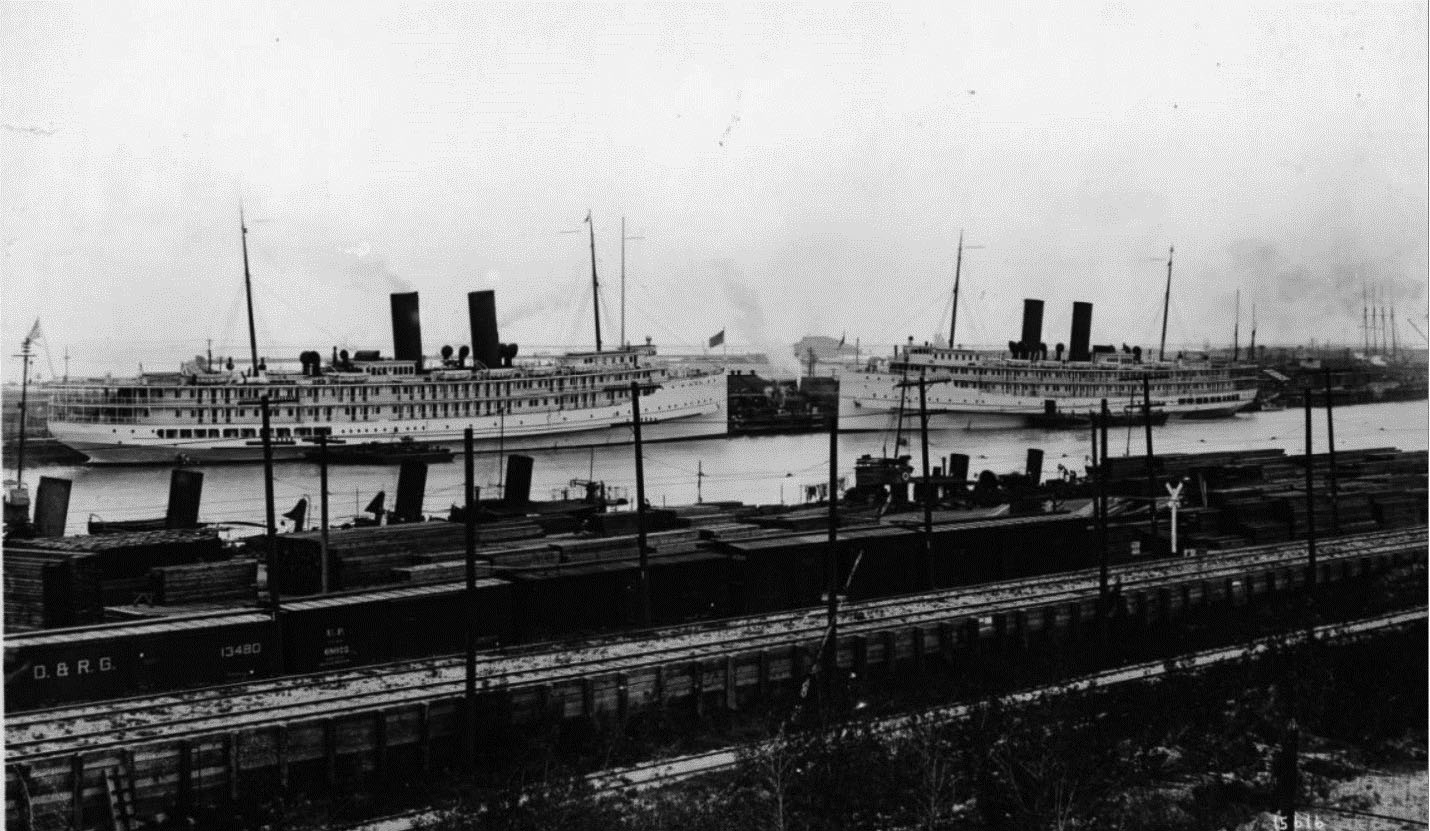 |
|
| (1910s)^^ – View showing the two large steamships, the “Yale” and the “Harvard”, dockside. Lumber piles and railroad cars can be seen in the foreground. |
Historical Notes The ships began their careers on the East Coast in 1907. Built for the Metropolitan Steamship Company of New York, in the shipyards of Chester, Pennsylvania, the identical twins were both 407 feet long and 62 feet in the beam. Coal-fired, triple-screw steam engines powered the ships to top speeds of 23 knots. They were among the first ships built in this country with steam turbine engines. Yale and Harvard boasted plush interiors with staterooms on the lower decks for 275 people. Outside cabins opened to promenade decks, with inside cabins accessed from passage ways. The ships were built to carry as many as 800 passengers. “In the matter of interior decoration and fittings the ships strike a new note,” announced one published account. The new ships were painted white but trimmed in the colors of their namesake universities: Harvard crimson and Yale blue. The number of private parlors and bathrooms put the ships “in a class by themselves,” remarked the New York Times as the Yale was launched in December 1906, adding, the ships were “the fastest and most luxurious vessels in the American coasting trade.* |
 |
|
| (1910s)^.^ – Postcard view showing Steamers Harvard and Yale docked at LA Harbor. |
Historical Notes Yale and Harvard spent three years making fast runs between New York and Boston before they were acquired by the Pacific Steam Navigation Company for service on the West Coast. The two ships made the long voyage to California via the Straits of Magellan, arriving in Los Angeles on December 16, 1910. They were immediately put into service on the Los Angeles to San Francisco route. San Diego was added to the schedule the next year. Carrying freight and hundreds of passengers, the swift steamers outclassed the West Coast competition. They could make the Los Angeles to San Francisco run in nineteen hours—four to six hours faster than rival steamers. Los Angeles to San Diego took five hours. The speedy service came to an abrupt halt toward the end of World War I. The U.S. Navy purchased both ships for one million each and refitted them in San Francisco for use as troop transports. The steamers ended up in Southampton, England in July 1918. In the next few months they made over one hundred crossings of the English Channel, carrying soldiers and supplies to the French ports of Le Havre and Brest. The ships were decommissioned in June 1920 and offered for sale. In Los Angeles, where the twin steamers were well-remembered from before the war, a group of businessmen formed the “Yale-Harvard Syndicate” and bought the ships from the Navy. The Yale and Harvard returned to California and underwent extensive reconditioning. The engines were converted from coal to oil burning. The interiors were refurbished and ballrooms added to create more cruise-like experience.* |
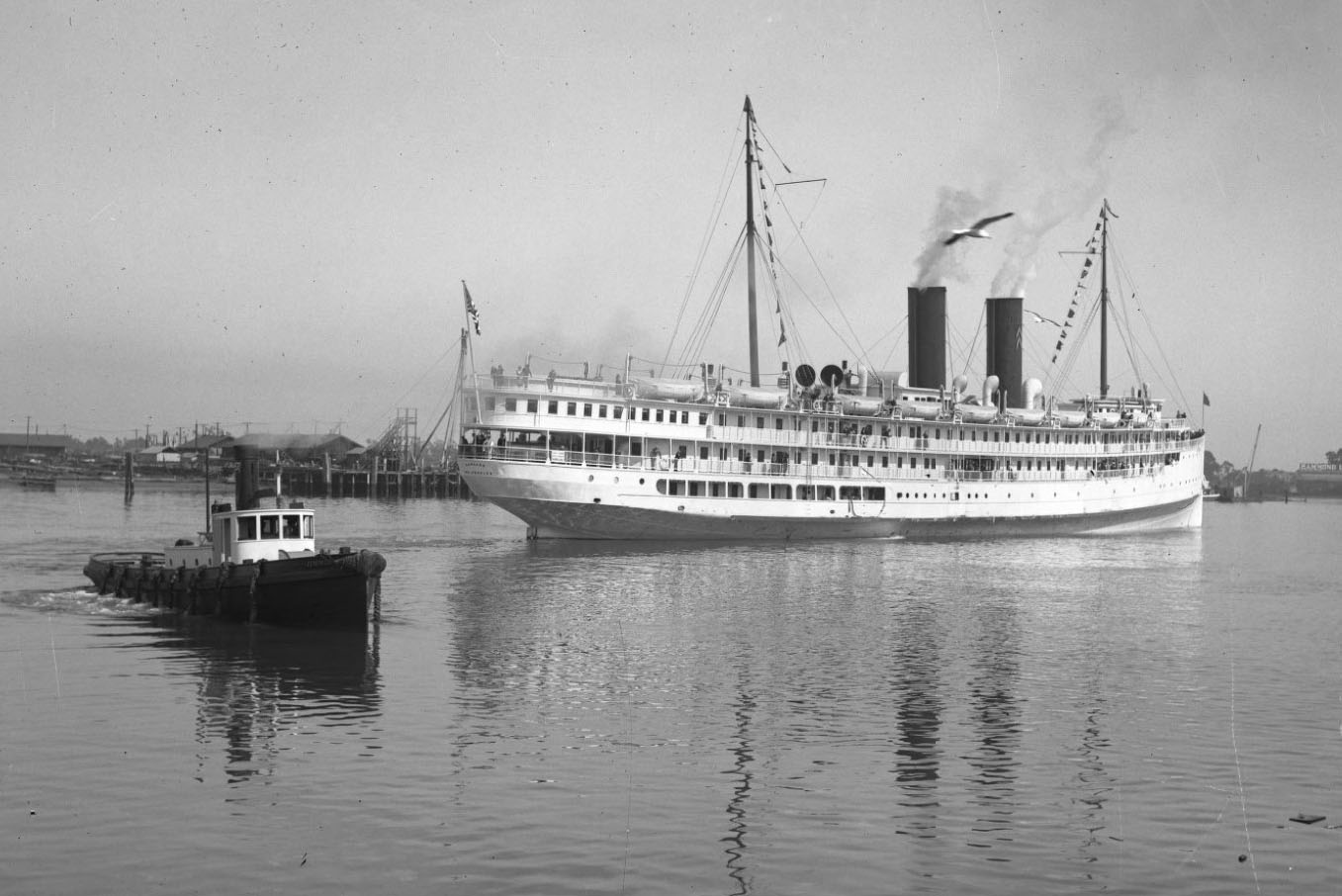 |
|
| (ca. 1921)^# - Side view of the steamship Harvard in Los Angeles Harbor with tugboat in front. |
Historical Notes The Harvard, would see its last voyage (No. 972) on May 30, 1931. Traveling southbound in a thick fog in the early morning, the white liner hit the rocks off Point Arguello, the feared “Graveyard of the Pacific.” Fortunately, the seas were calm. An SOS from the ship was answered by the Navy cruiser Louisville, and all 530 passengers and crew were rescued from lifeboats.* |
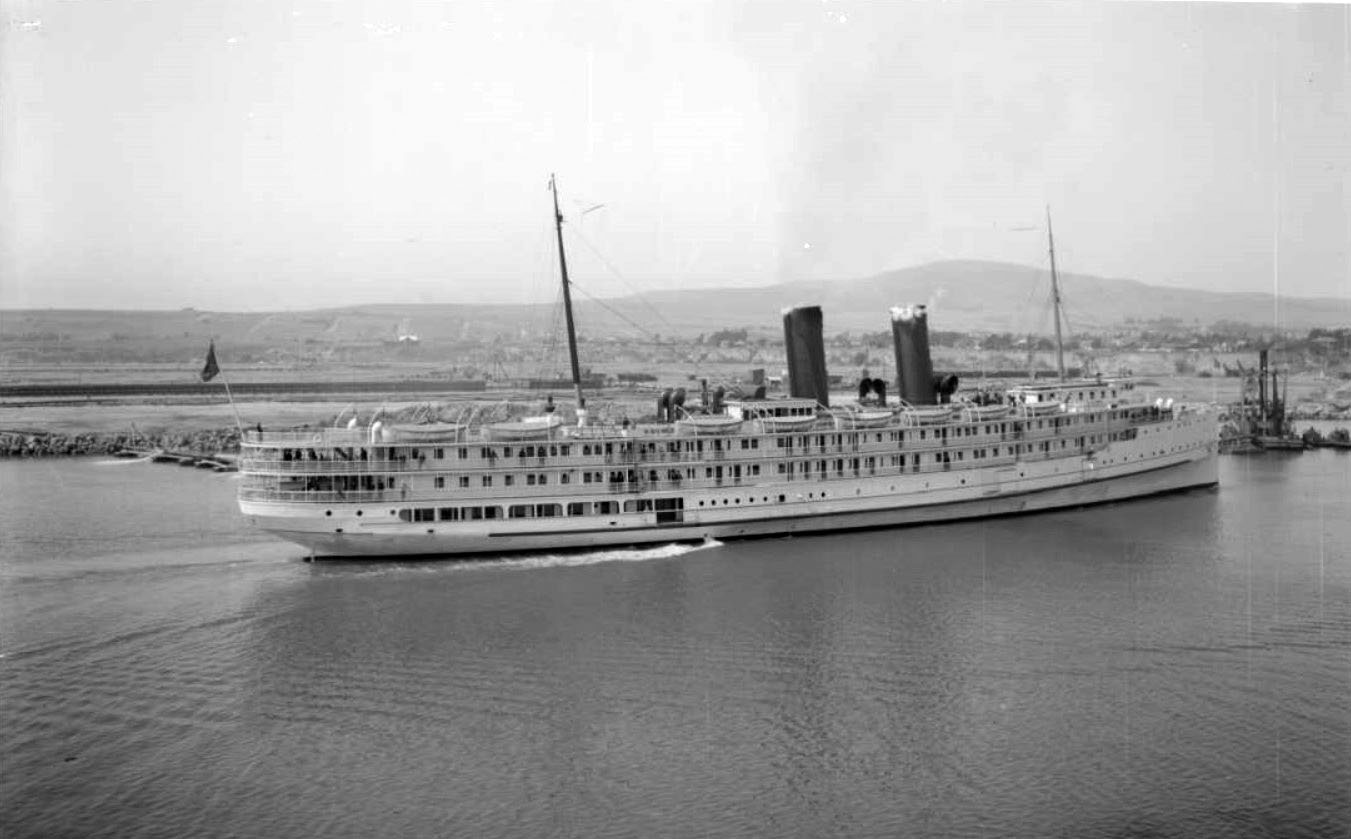 |
|
| (ca. 1913)^^ – Passenger steamer S.S. Yale entering the main channel of Los Angeles Harbor as seen from Deadman’s Island. |
Historical Notes In November 1930, the Yale marked her 1000th voyage between Los Angeles and San Francisco by flying a 60-foot pennant. The Yale continued its coastal runs without its running mate, but the tough economic times of the Great Depression meant fewer passengers and declining profits for the ship’s operators. Maritime strikes in 1934 and 1936 hurt even more and the Yale was withdrawn from service in July 1936. In 1940, the Yale was sent to Alaska for service as a dormitory for construction workers in Sitka. The Navy bought the Yale in 1943 for a second stint of wartime service. Renamed the USS Greyhound, the steamer became a floating barracks for Navy personnel in Puget Sound. The end came in 1949 when the old steamer was towed to a Stockton scrap yard. The salvaged hull was sent to a steel mill in Pittsburg.* |
* * * * * |
U.S. Naval Fleet at San Pedro Harbor
.jpg) |
|
| (1919)#^* - (Left Panel) Panoramic view showing the U.S. Naval Fleet docked at San Pedro Harbor. |
Historical Notes Woodrow Wilson transferred half of the 200 United States Navy ships from the Atlantic to the Pacific in 1919 when tension arose between the United States and Japan over the fate of China. San Diego Bay was considered too shallow for the largest ships, so the battleships anchored in San Pedro Bay on August 9, 1919. Local availability of fuel oil minimized transportation costs, and consistently good weather allowed frequent gunnery exercises off the nearby Channel Islands of California. ##* |
.jpg) |
|
| (1919)#^* - (Right Panel) Panoramic view showing the U.S. Naval Fleet docked at San Pedro Harbor. |
Historical Notes From 1919 until 1940, San Pedro Harbor was the U.S. Naval Fleet home port. ##* |
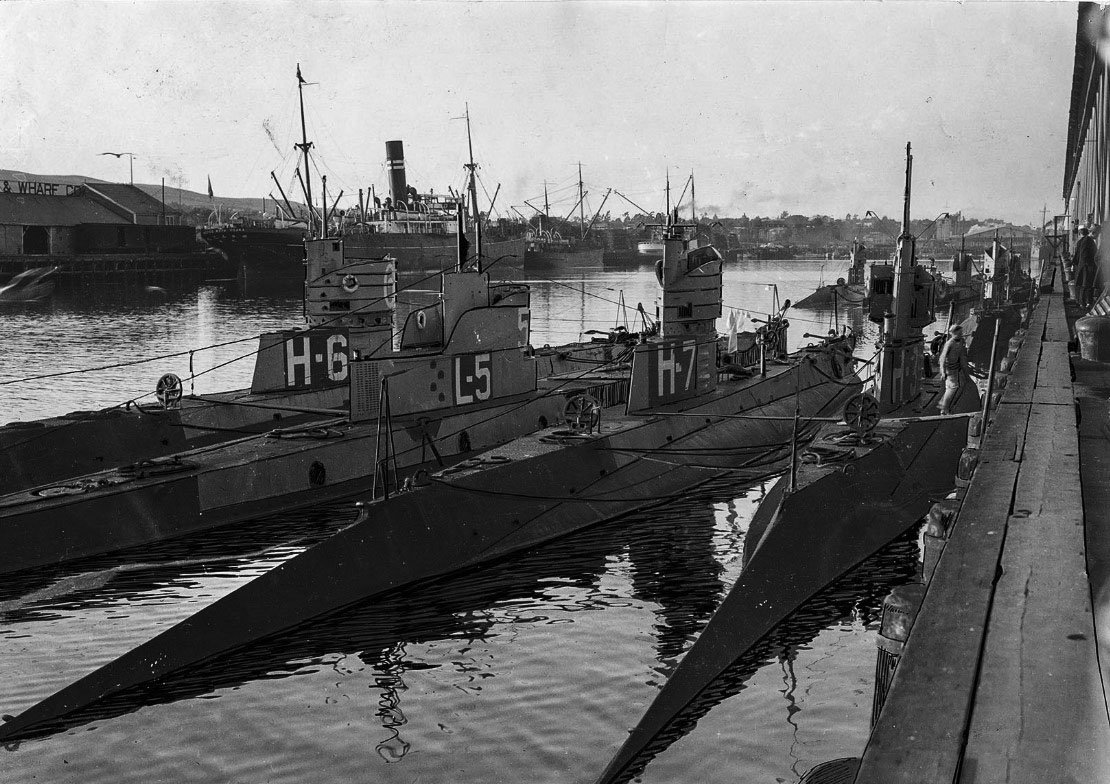 |
|
| (1920)^** – View showing U.S. Navy submarines at San Pedro. LA Times Photo date: Feb. 20, 1920 |
Historical Notes The submarine base at San Pedro was closed in 1923. |
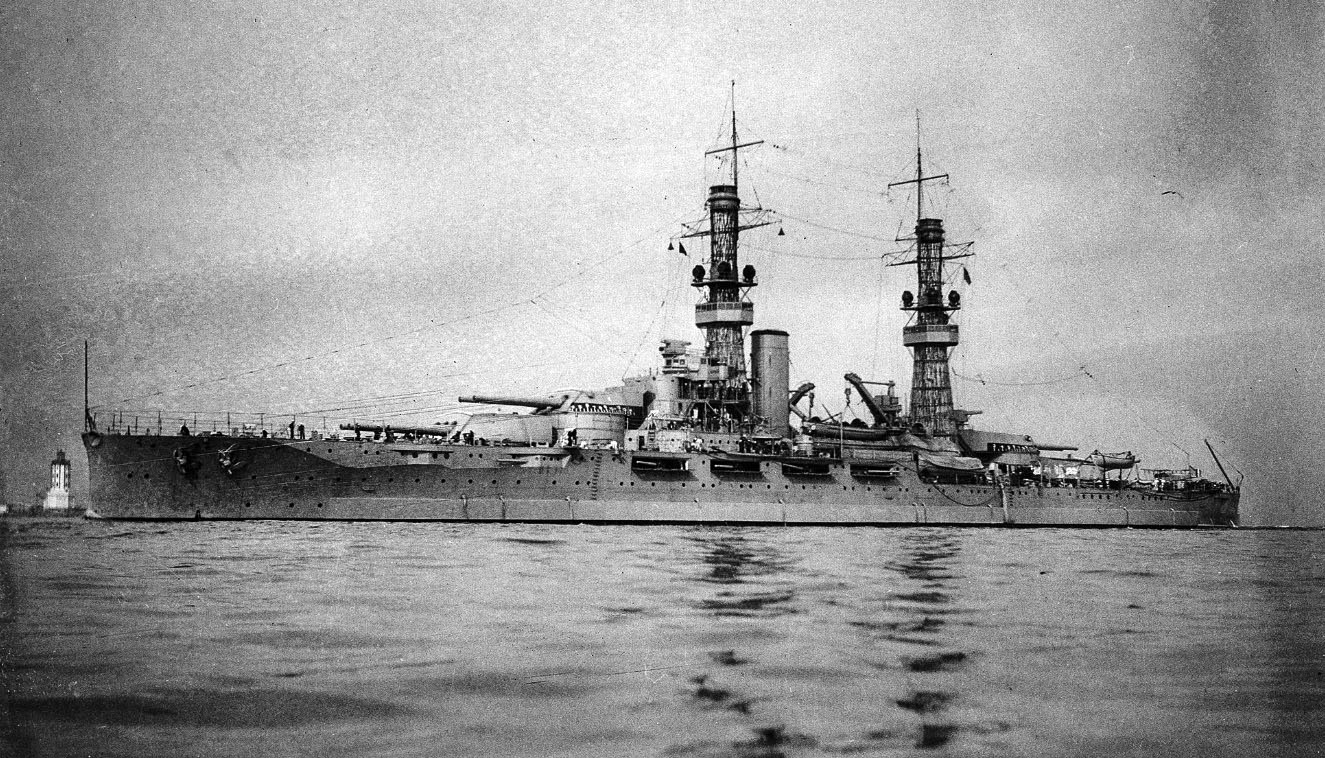 |
|
| (ca. 1925)^** – View showing the battleship Oklahoma in Los Angeles Harbor with the Harbor Lighthouse in the background on the left. |
Historical Notes Between 1927 and 1929 the ship was modernized with new tripod masts and five-inch guns. The Oklahoma was sunk at Pearl Harbor and too badly damaged to be repaired, ^** |
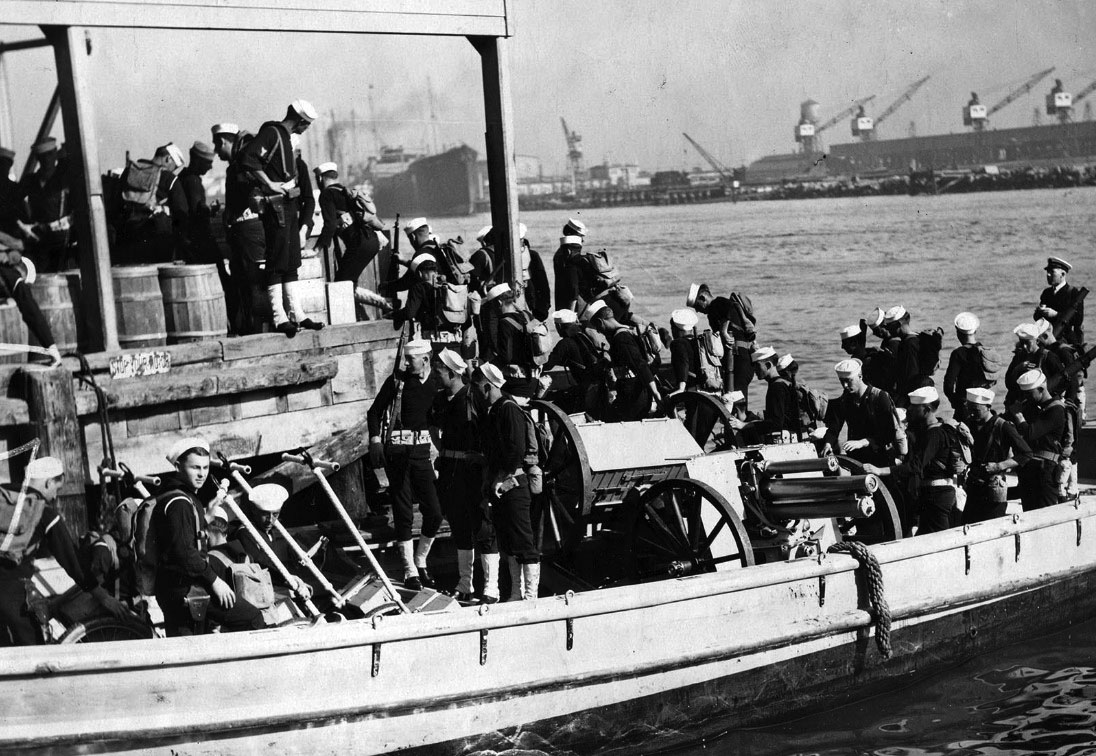 |
|
| (1926)^** - Sailors disembark from craft during mock invasion of the harbor in San Pedro. Eight thousands sailors and Marines landed with machine guns and artillery. Photo appeard in the Jan. 23, 1926, Los Angeles Times. |
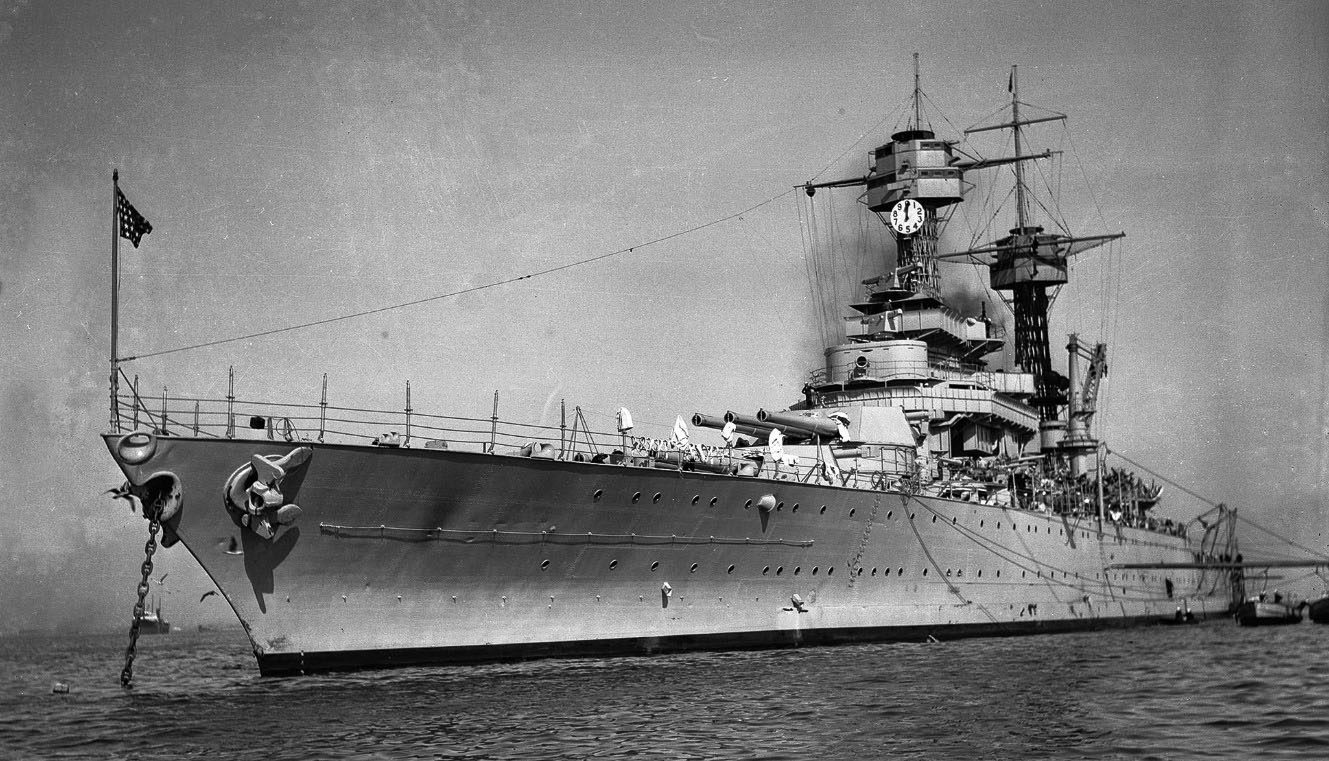 |
|
| (ca. 1920)^** – Photo of the battleship California at anchor at Los Angeles Harbor in San Pedro. |
Historical Notes The ship was sunk during the attack on Pearl Harbor, but rebuilt and participated in World War II. ^** |
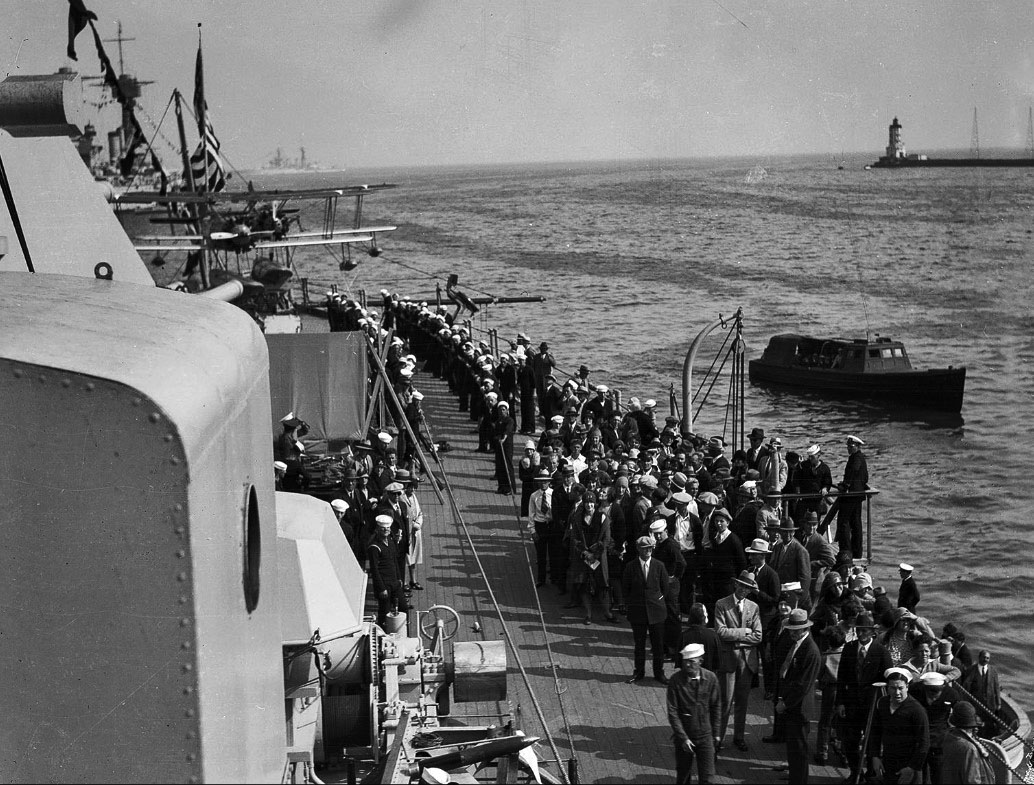 |
|
| (1929)^** – Visitors mix with sailors on the battleship California during Navy Day. The Harbor Lighthouse is seen in the background. This photo appeared in the Oct. 29, 1929, Los Angeles Times. |
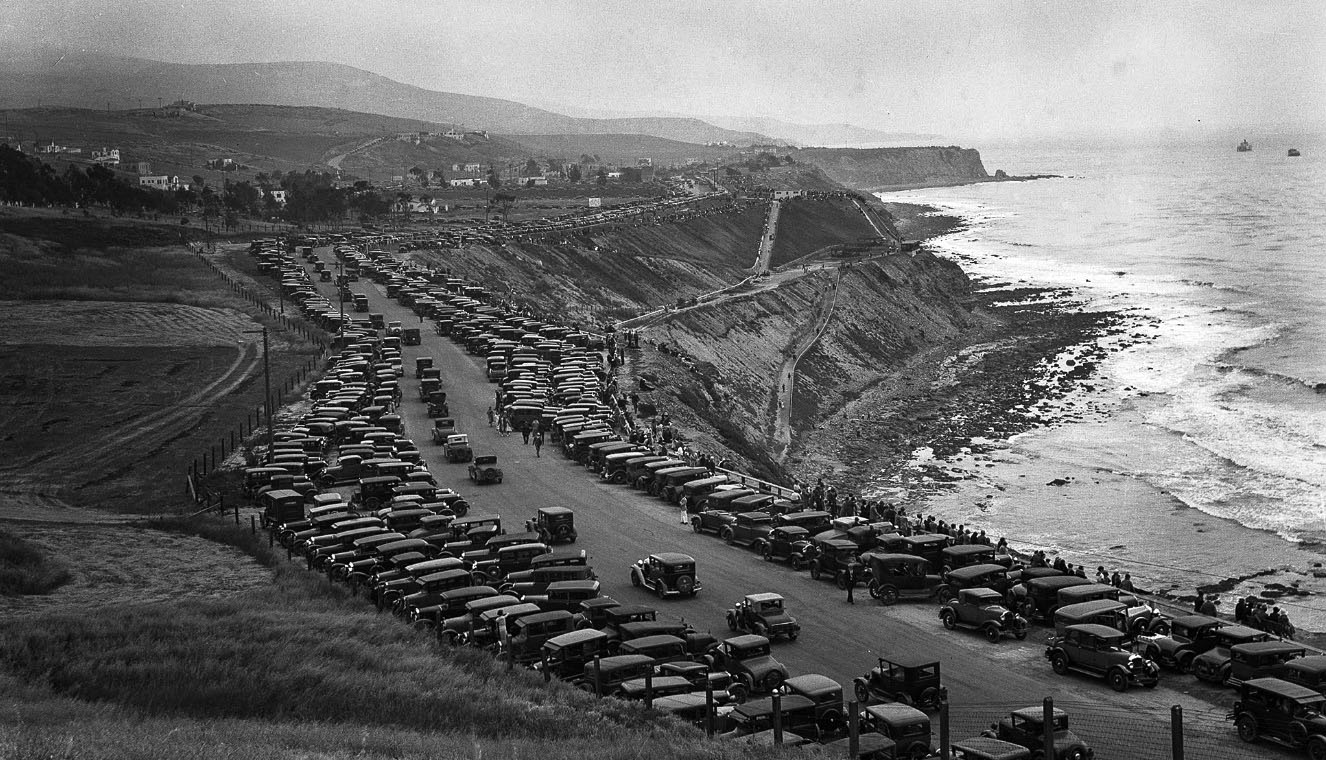 |
|
| (1932)^** – Panoramic view showing cars parked between Point Fermin and White Point in San Pedro during the annual Navy Fleet Parade along the Southern California coast. |
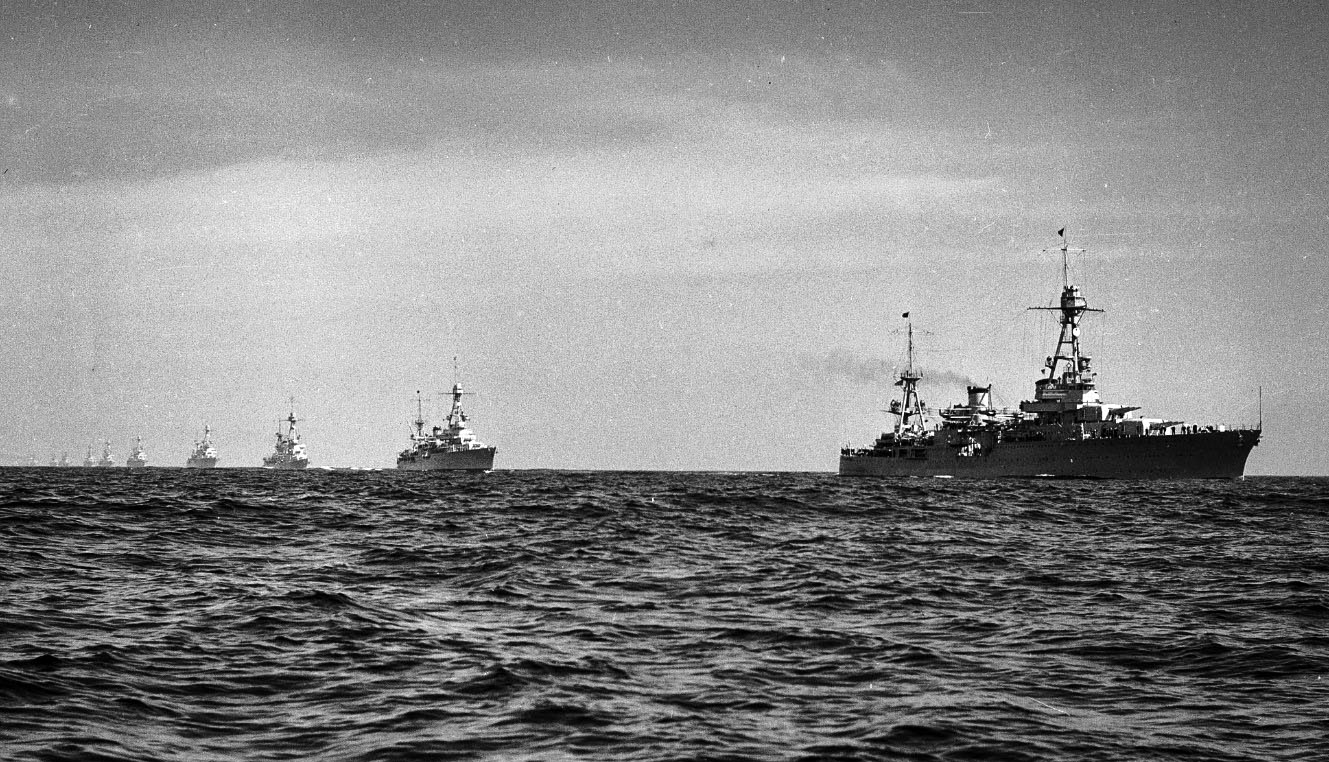 |
|
| (1932)^** – View showing a column of warships during the annual Fleet Parade at San Pedro. |
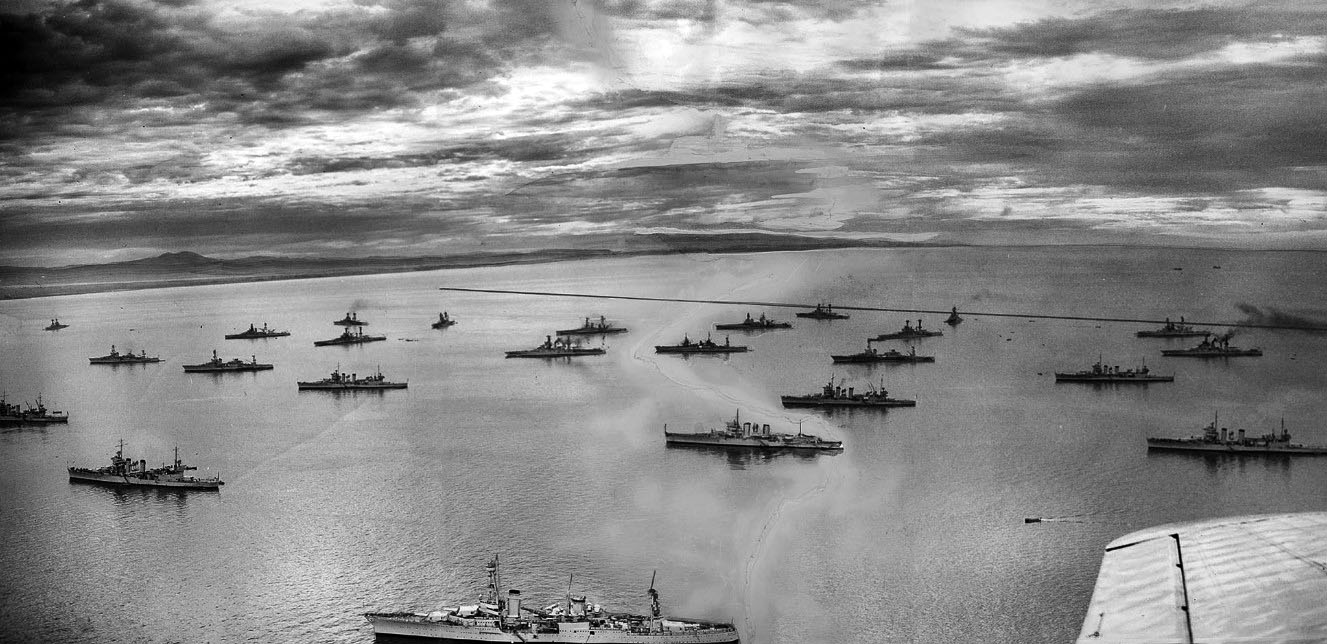 |
|
| (1938)^** - Panoramic aerial view showing a portion of the 100 U.S. Navy ships anchored behind the 26,000-foot breakwater off San Pedro. Photo Date: Jan. 31, 1938 |
Historical Notes A large portion of the Pacific Battle Fleet would call the Port of Los Angeles its home port from 1919 until 1940, San Diego being another home port. The San Pedro port featured local availability of fuel oil – saving money – and good weather allowing frequent gunnery exercises. During the summer of 1940, as part of the U.S. response to Japanese expansionism, the Pacific Fleet was instructed to take an "advanced" position at Pearl Harbor, Hawaii. The rest is history. |
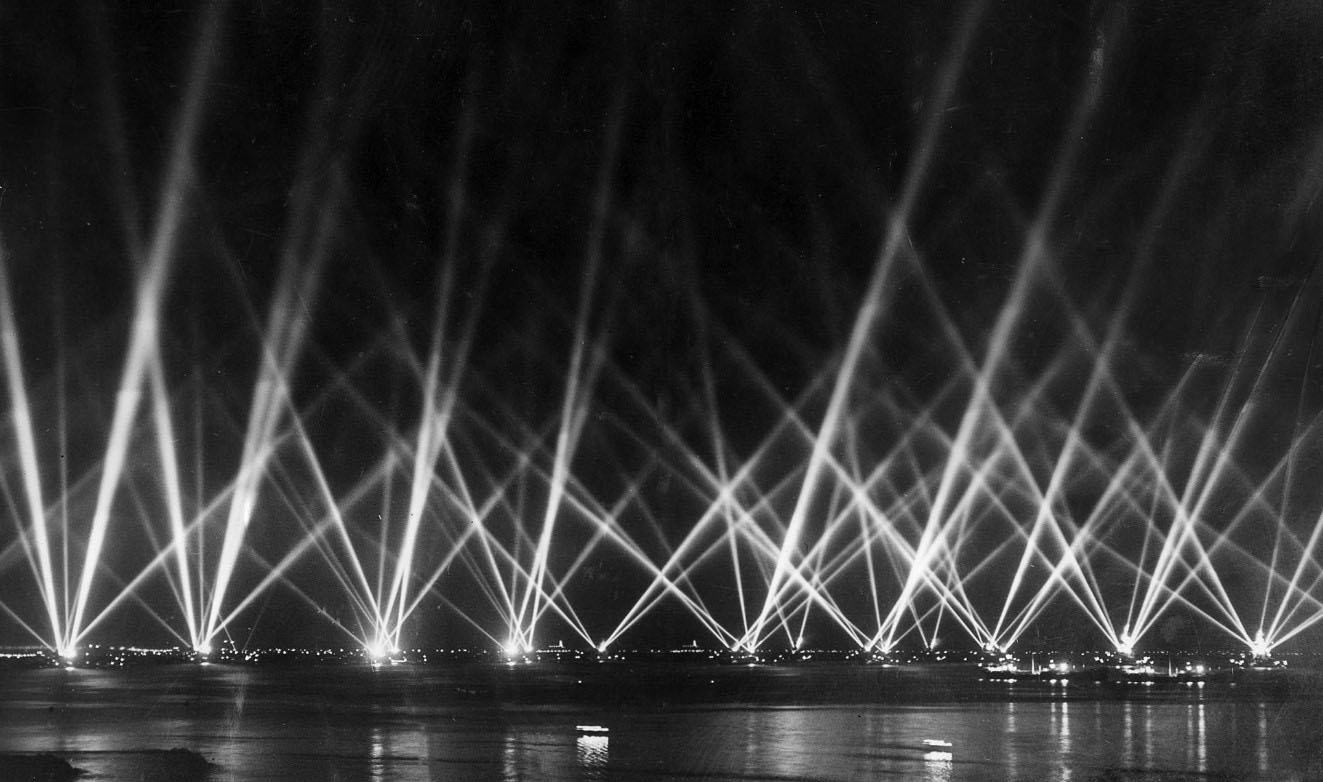 |
|
| (1938)^** – U.S. Navy ships light up the sky during annual Harbor Day ceremonies in San Pedro. |
* * * * * |
San Pedro Fishing Industry
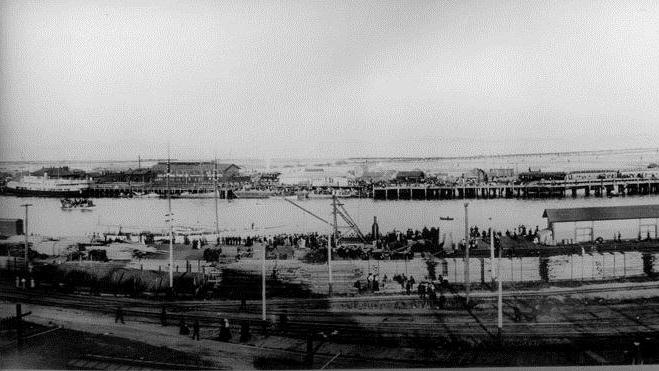 |
|
| (ca. 1900)* - Crowds of people can be seen on both sides of the harbor, possible event in the harbor. California Fish Co. is in the middle of the photo. Stacks of lumber is piled on railroad cars that are parked in foreground. |
Historical Notes The fishing industry was beginning to pick up steam around the turn of the century. In 1893, Golden Gate Packing Company moved its operations from San Francisco to Los Angeles and reestablished itself as the California Fish Company. This became L.A. Harbor's first cannery.*^^ In 1903, a technique of preparing and canning was developed to can sardines, mackerel, bluefin tuna, yellowfin tuna and albacore. In 1912 the first fresh fish market was introduced in San Pedro and along with other markets that followed, they eventually supplied fresh and iced fish throughout our nation.^^# |
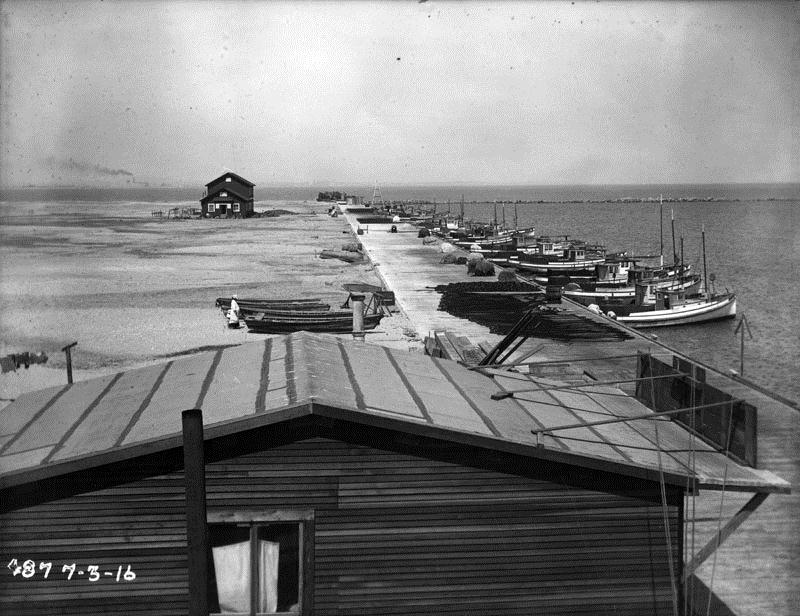 |
|
| (1916)* - View of fishing boats anchored along the docks in the harbor, with fishing nets drying on the docks. The breakwaters can be seen on the right. A house stands alone in the background. |
Historical Notes In 1912, Wilbur Wood opened the California Tuna Canning Company at Los Angeles Harbor. Two years later, Frank Van Camp bought the company and renamed it Van Camp Sea Food Company. This new company became best known for its Chicken of the Sea product line.*^^ |
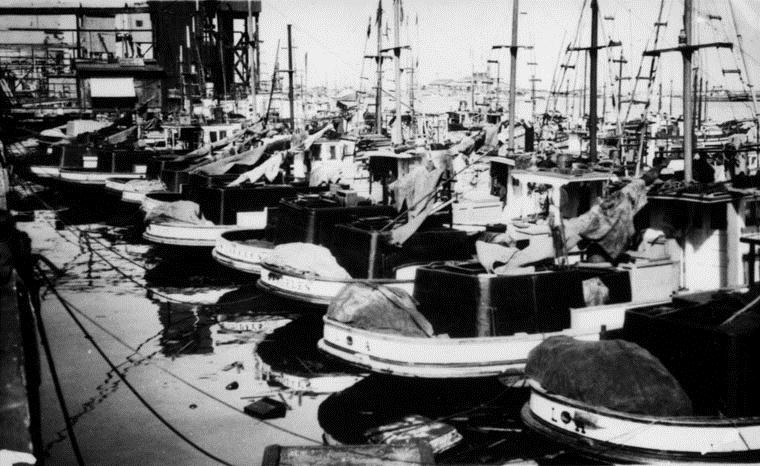 |
|
| (ca. 1920s)* - View of fishing boats anchored in L.A. Harbor. |
Historical Notes Before long, flotillas of purse seine boats were sailing down from northern waters to fish in San Pedro. By 1920 there was a large fleet of fishing boats and methods of fishing such as purse seine, lampara, jig, live bait, gill net, mackerel scoopers and long line boats. Los Angeles Harbor became the largest fishing port in the nation. The fishing industry in San Pedro was originated primarily by European and Asian fishermen each bringing fishing knowledge from their native lands.^^# |
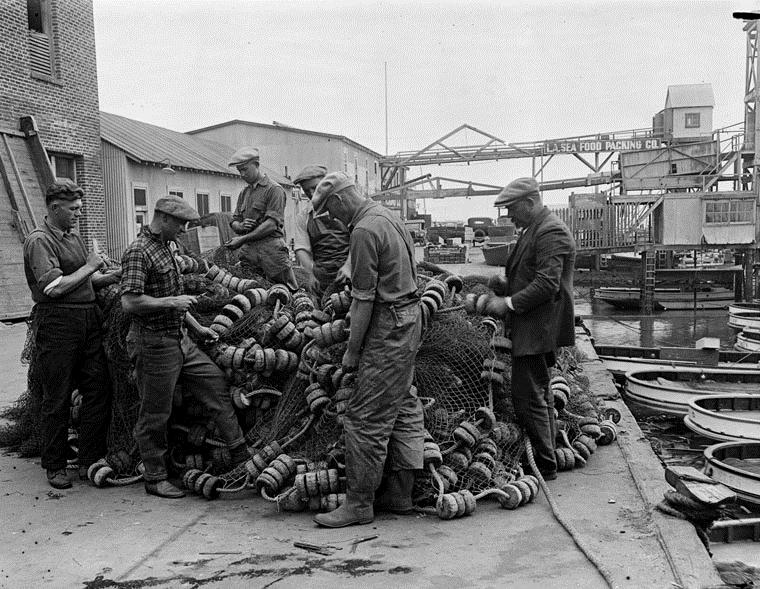 |
|
| (ca. 1920s)* - Group of fishermen mending their nets on the docks. |
Historical Notes In 1935, following the depression, 6,000 people were directly employed in the fishing industry. Its payroll was the largest in San Pedro, approximately three-quarters of a million dollars per month. The industry was at its peak during World War II. During the fifties, sardines and mackerel gradually diminished causing the decline of the industry in San Pedro.^^# |
* * * * * |
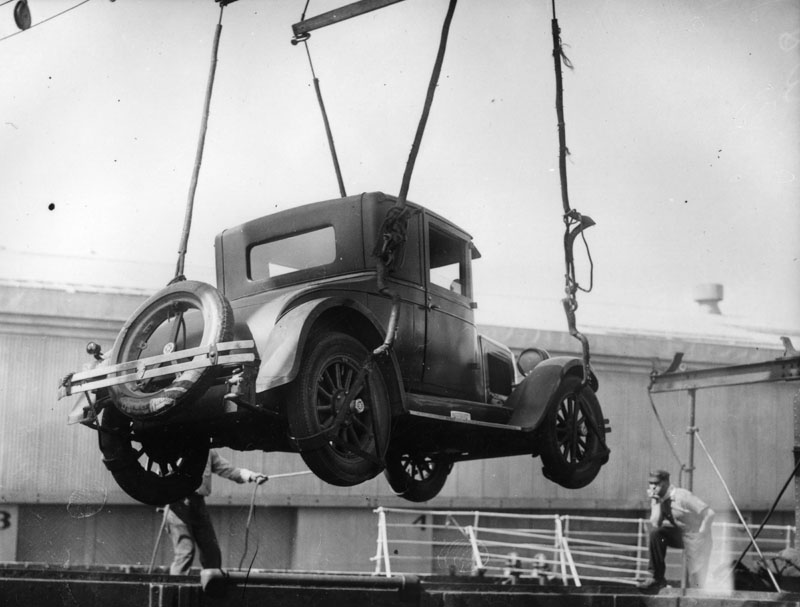 |
|
| (ca. 1920)^*^* - An early model auto is being loaded onto a ship in the San Pedro Harbor. |
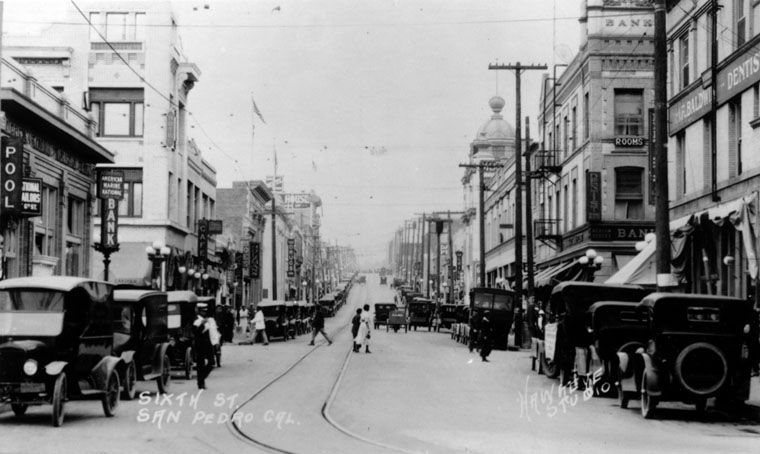 |
|
| (ca. 1920)* - Scenic view of 6th Street in San Pedro. This street is a busy area with many retail stores on both sides of the street. There are two banks, two pool halls, a cafe, shoe store, drug store, a dentist, and even rooms for rent. Automobiles can be seen parked up and down the street. |
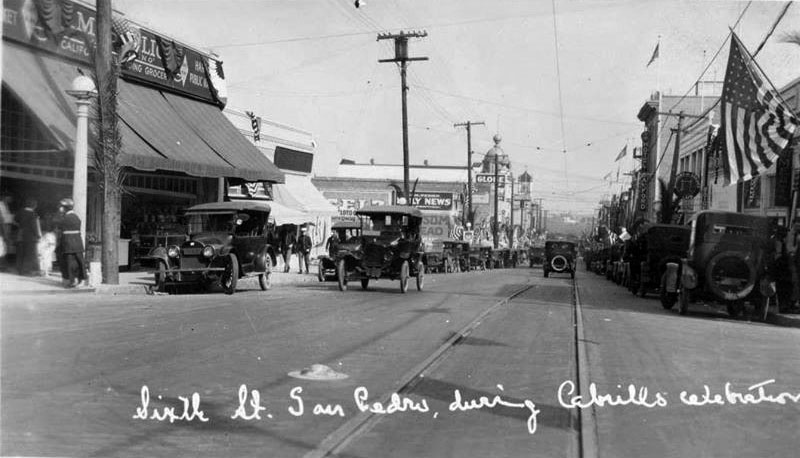 |
|
| (ca. 1920)#*^ - View of 6th Street in San Pedro, during the Cabrillo Day celebration. |
Historical Notes Every September, San Pedro celebrates the discovery of its bay. September 28 is the official “Cabrillo Day” in the state of California. |
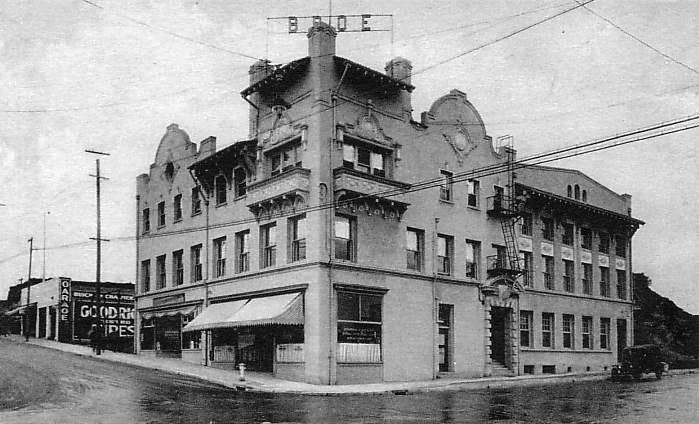 |
|
| (ca. 1920s)#^** – Postcard view showing the Elks’ Club on the corner of Palos Verdes and 7th streets, San Pedro. |
Historical Notes August 7, 1910 Los Angeles Herald article announcing the completion of the new Elks’ temple: The new Elks’ temple just finished at San Pedro is one of the best buildings erected for several years in the harbor district. It is built of brick, with red tile roof, and is plastered on the outside. Complete with furniture, the structure represents an outlay of about $50,000. Hudson & Munsell were the architects, and the contract was awarded on their specifications the first of the year. The lower floor has two large store rooms facing on Palos Verdes, a billiard room, café, kitchen and pantry. From Seventh Street through the main entrance a grand staircase leads to a large alcove on the second floor. On one side is the lodge hall, 36x36 feet, with a stage 13x38 feet, ante rooms and a reading room. On the other side is a large smoking room and the ladies’ reception room and parlor. The third floor contains apartments for members of the lodge. The formal dedication of the new building has been postponed until some of the furniture, damaged in shipment, has been repaired, but the club rooms are now open and San Pedro lodge, No. 966, is holding meetings in the new hall. |
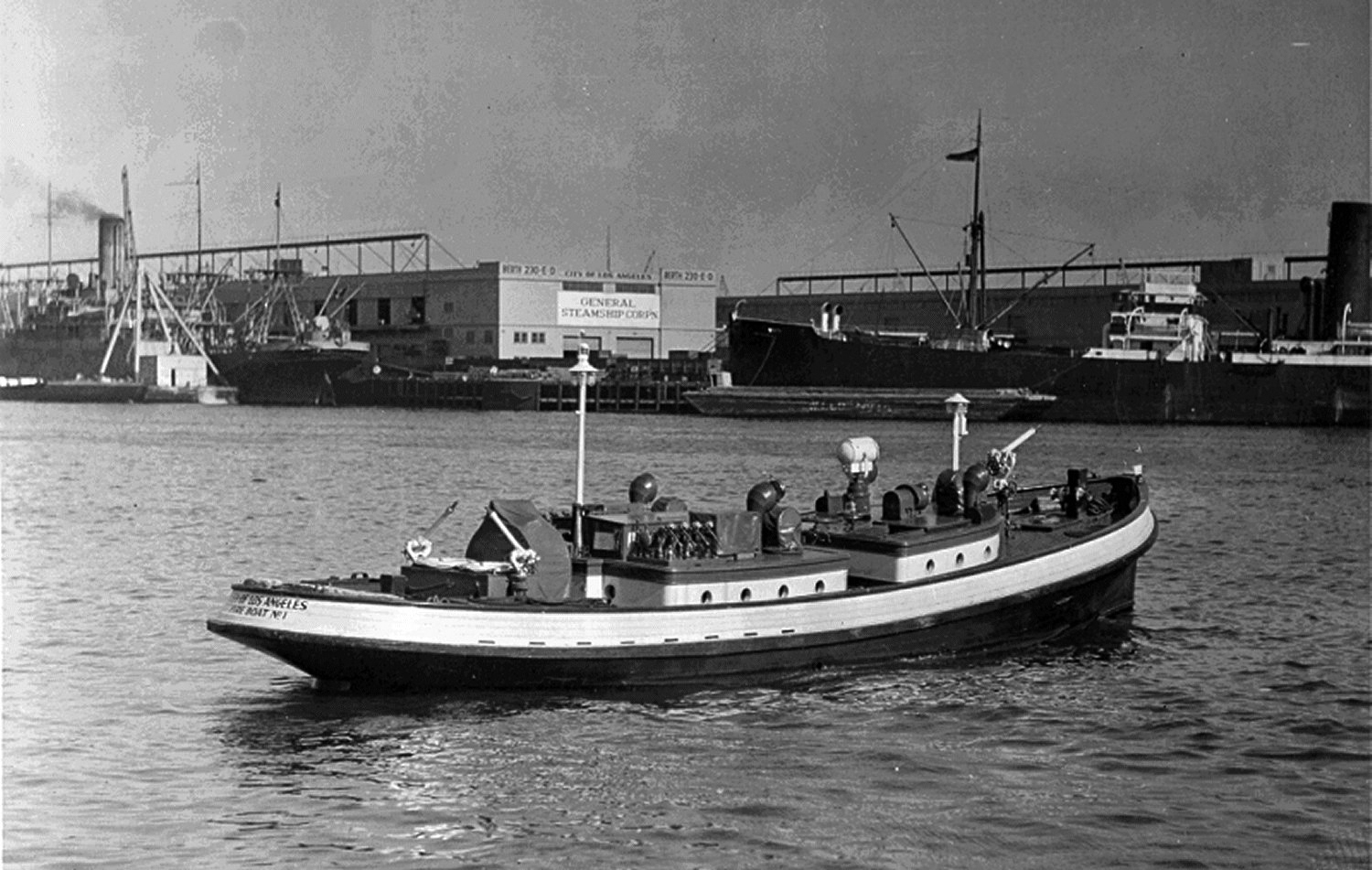 |
|
| (1919)^#* - View of Fire Boat No. 1, commissioned August 1, 1919. |
Historical Notes Fire Boat No. 1 was purchased for $33,000 and is all wood construction, 65' long, 17.7' beam, 39.65 gross tons with a 400 gallon fuel capacity. Powered by a 275 H.P. Hall Scott Invader for propulsion and 2 275 H.P. Hall Scott Invaders each driving a 4 stage pump rated at 1000 G.P.M. for a total pumping capacity of 2000 G.P.M^#*. |
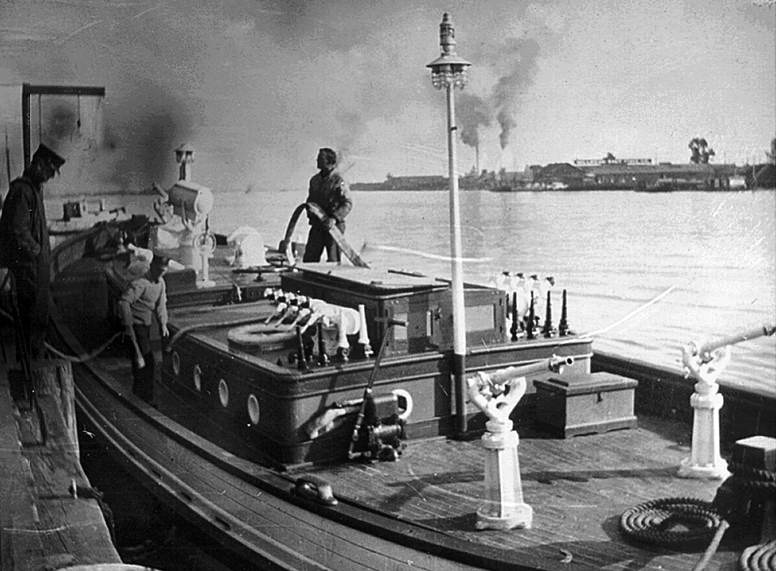 |
|
| (ca. 1919)^#* - Close-up view of Fire Boat No. 1 showing detail of hose equipment. |
Historical Notes Originally stationed at the foot of First Street in San Pedro, Power Boat No. 1 was moved to Berth 260, Fish Harbor, Terminal Island On May 2, 1927.^#* |
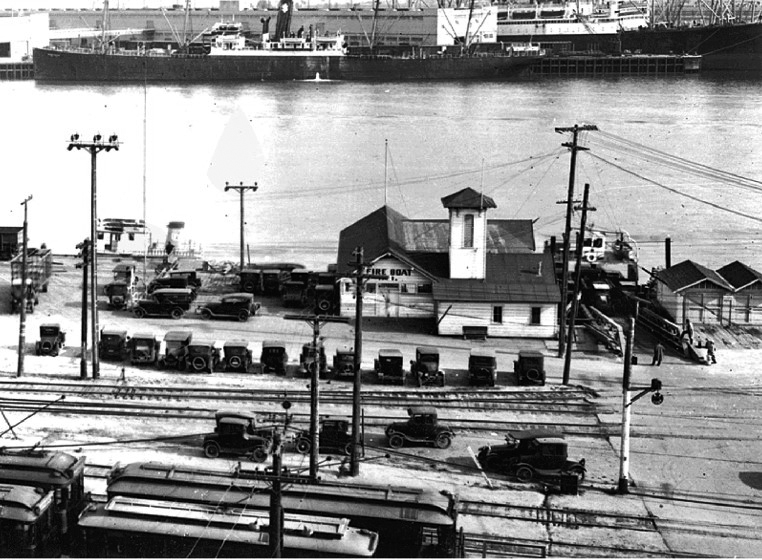 |
|
| (1927)^#* - View of Fire Boat No. 1 Quarters on Terminal Island. |
Historical Notes On April 25, 1927, Los Angeles Fire Boat No. 1 was moved from its old location at the foot of the First street wharf, San Pedro, to the new location in Fish Harbor. A new building and slip were erected to serve as new quarters for the boat.^#* |
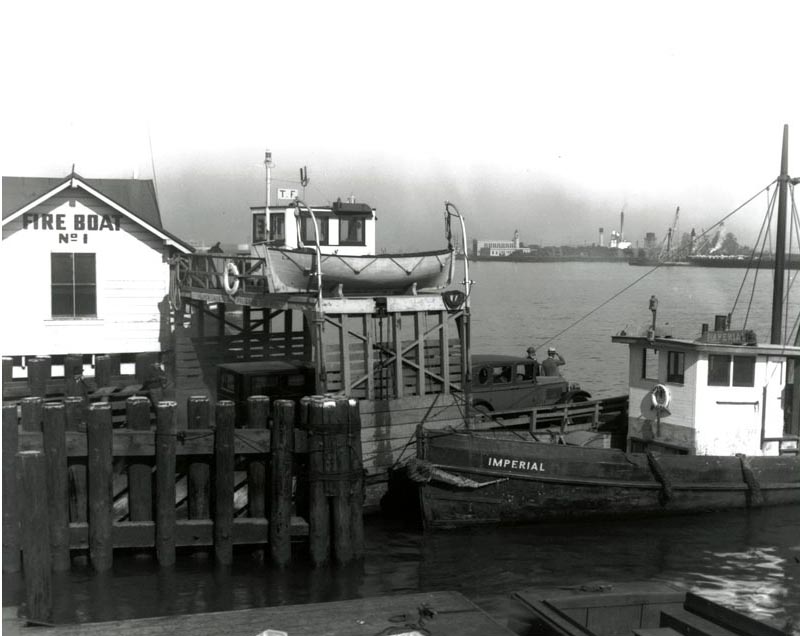 |
|
| (ca. 1927)^#* - Side view of the new quarters for Fire Boat No. 1 on Terminal Island. |
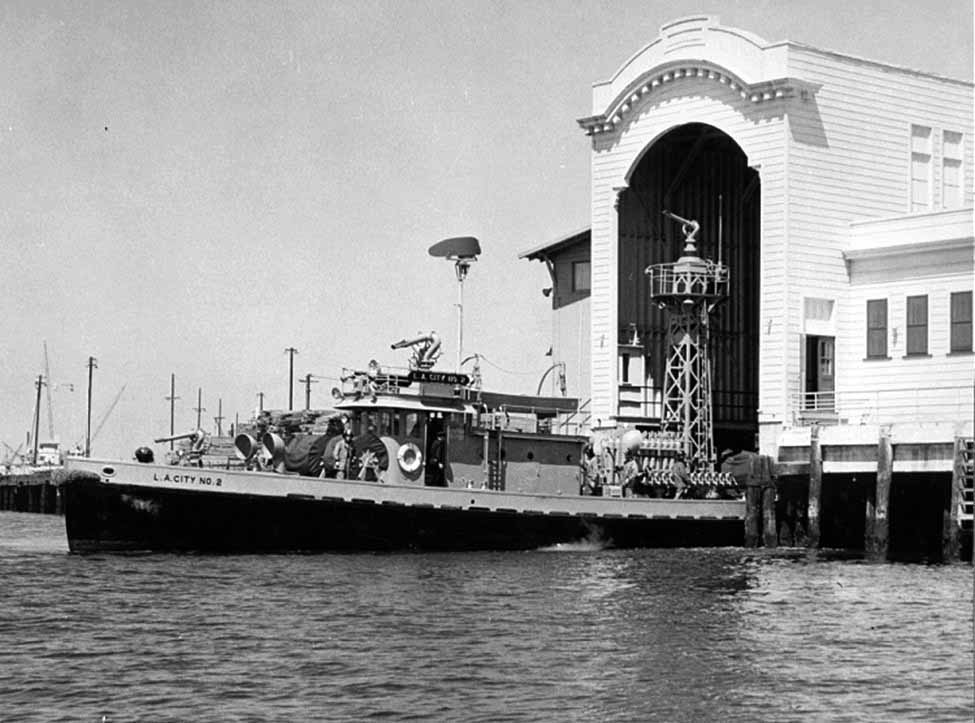 |
|
| (ca. 1955)^^** - View of Fire Boat No. 2 and Fire House No. 112. |
Historical Notes The firehouse, completed in 1926, demolished in 1986, was located at Berth 227 on San Pedro's Terminal Island. It served as the homebase for Fire Boat No. 2, launched on October 20, 1925. Renamed the Ralph J. Scott in 1965, the boat today sits on land behind the new Fire House No. 112 at Berth 86.^^** In 1976, both Fire Boat No. 2 and Fire House No. 112 were designated Los Angeles Historic-Cultural Monument No. 154 (Click HERE to see complete listing). |
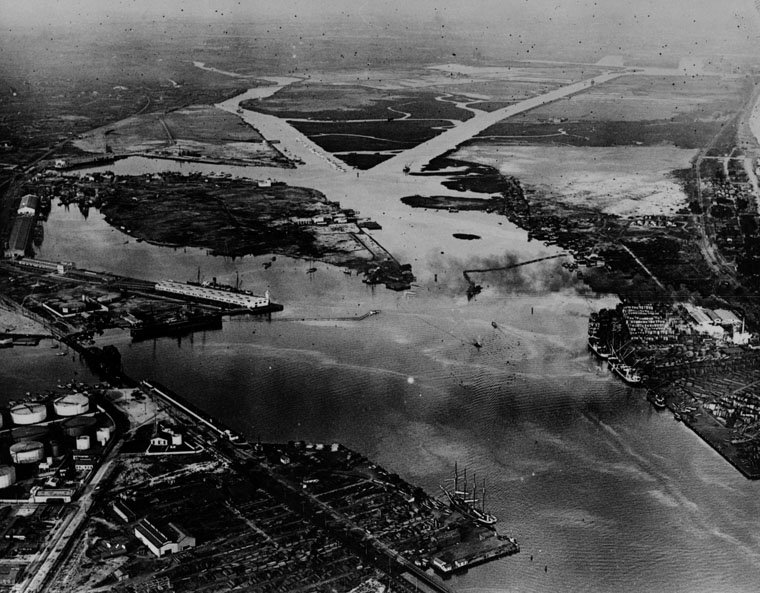 |
|
| (1921)^ - Aerial view of San Pedro Harbor in 1921. The port continues to expand and becomes the busiest seaport on the west coast. |
Historical Notes After the Panama Canal opened in 1914, the Port of Los Angeles became the natural port-of-call for most transpacific and coastal users.^^# |
 |
|
| (1923)**# – Birdseye view of the Southland showing the beachfront communities between Santa Monica and Long Beach with the San Pedro Harbor in the foreground. Note the undeveloped land between Los Angeles and the ocean. At left can be seen the proposed site of a new Universtiy in Palos Verdes. Turns out this was one of the sites proposed for the UCLA campus. |
Historical Notes UCLA as well as Cal State Dominquez were both almost located in Rancho Palos Verdes: A section of 1,000 acres was originally set aside by the planners of the Palos Verdes Project for a University campus, In November 1921, a proposal was made for the relocation of the southern branch of the University of California , which later became UCLA. This land was in the center of the Palos Verdes Peninsula where Peninsula High School, the Peninsula Shopping Center, and the Avenue of the Peninsula Shopping Center is located.**# |
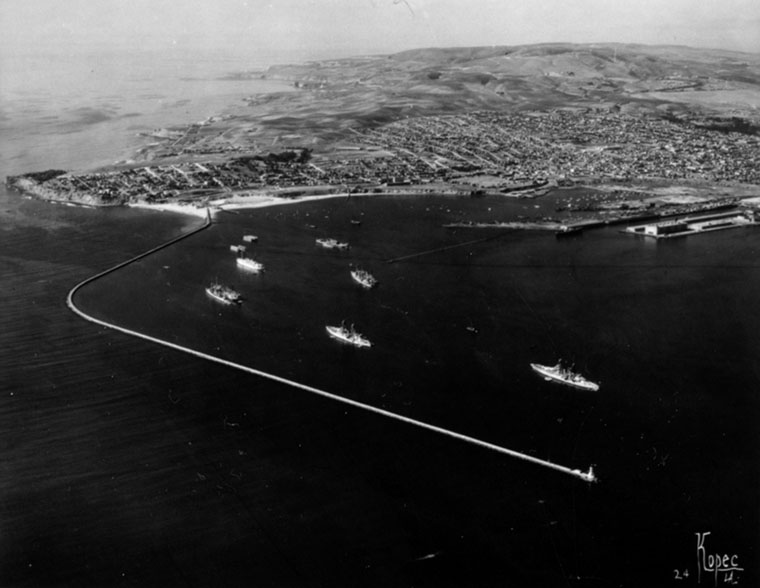 |
|
| (1920s)* - Aerial view of Point Fermin, Palos Verdes and hills, government breakwaters and the outer harbor. Ships can be seen in the harbor. |
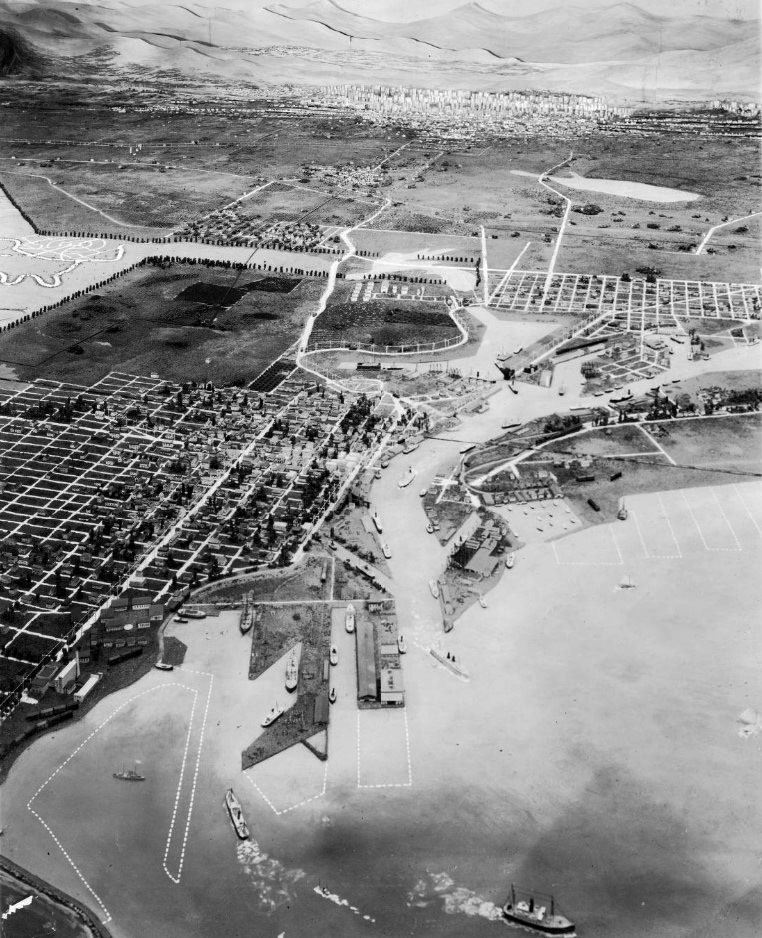 |
|
| (1921)^.^ - Image shows a partial view of a diorama of Wilmington Harbor and San Pedro, looking northwest toward the cities of Torrance and Redondo Beach. |
Historical Notes Howard H. Towle (1891-1972), an early salesperson in the Palos Verdes Project, notes in his oral history at having seen the model installed in the Auditorium Building (also known as the Temple Auditorium) on Fifth Street and Olive across from Pershing Square in downtown Los Angeles in October of 1921, in an early meeting for the development of the Palos Verdes Project. |
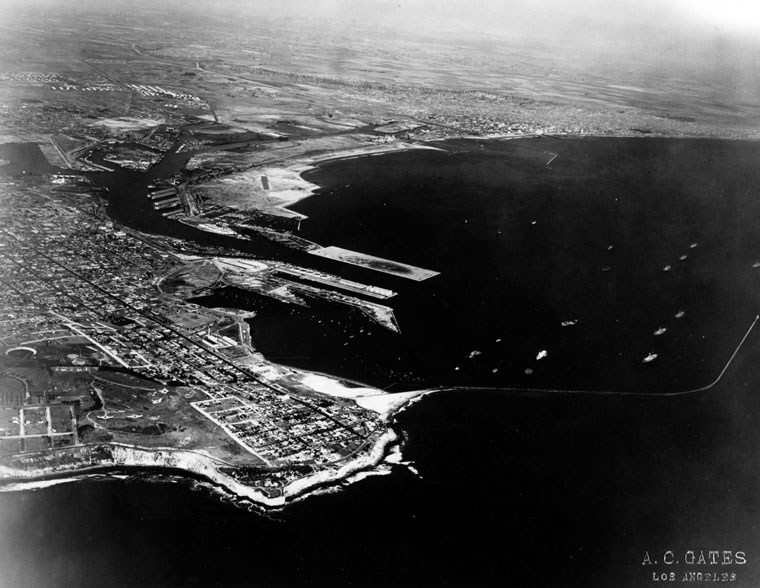 |
|
| (1929)* - Aerial view of San Pedro, the LA Harbor, and the coastline. |
.jpg) |
|
| (ca. 1929)^^ - Close-up aerial view showing two of the piers at Los Angeles Harbor with a few large and small ships docked at center. Smoke can be seen coming from a building or ship towards the background, while buildings can be seen into the distance. |
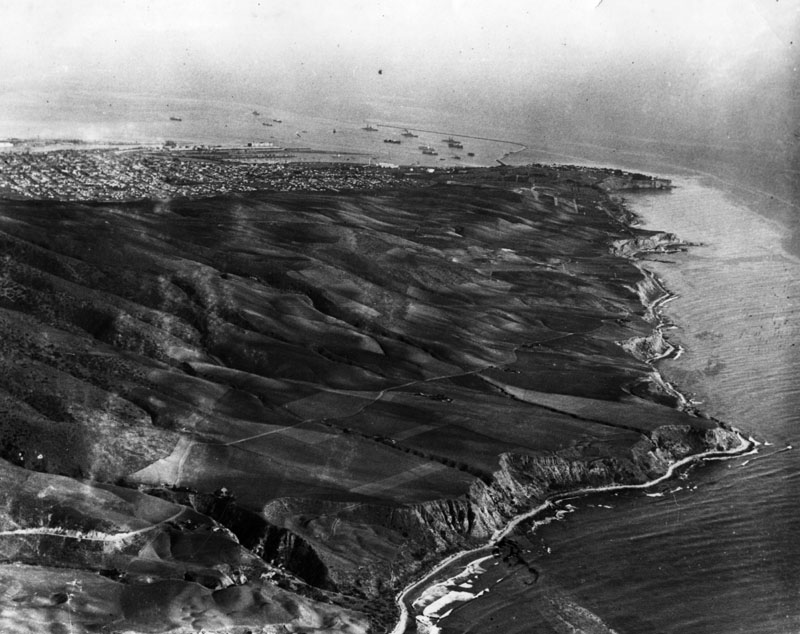 |
|
| (1924)* - Aerial view of the Palos Verdes Peninsula, looking southeast towards Point Fermin. San Pedro Harbor can be seen in the background. |
Point Fermin Park
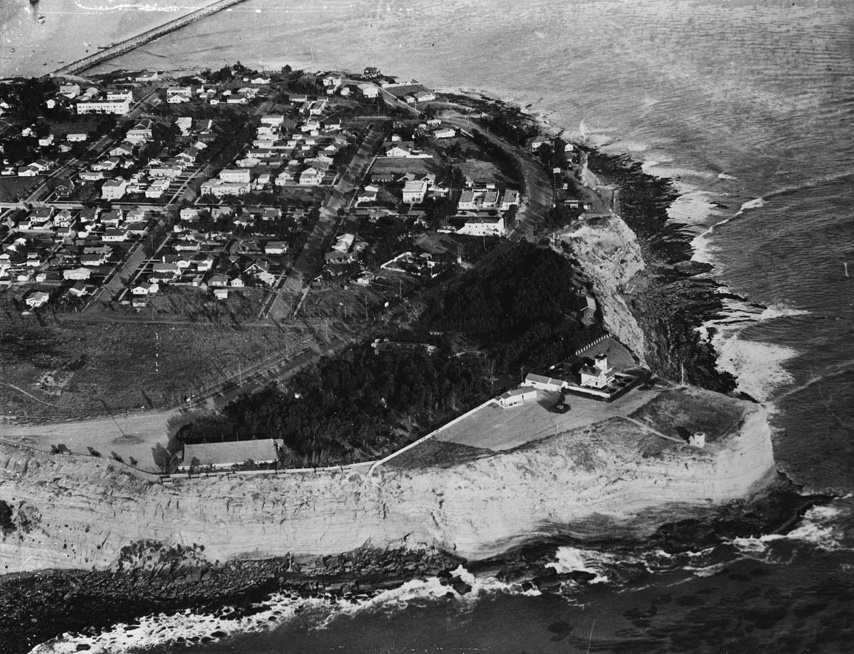 |
|
| (1934)* - Aerial view of Pt. Fermin showing Pt. Fermin Park and Lighthouse. |
Historical Notes Point Fermin Park is the southernmost point in Los Angeles. The area was given its name by the British explorer George Vancouver, who visited here in 1793 and decided to thank Father Fermin Francisco de Lasuen for his hospitality at the mission in Carmel. The point itself was a popular site for picnicking and social activities, especially as the town of San Pedro grew larger toward the late 1880s. Many visitors rode the Red Car to the end of Pacific Avenue and then walked the short distance to the park and lighthouse. The park is one of the few places on the peninsula where Monarch butterflies spend their winters.^ |
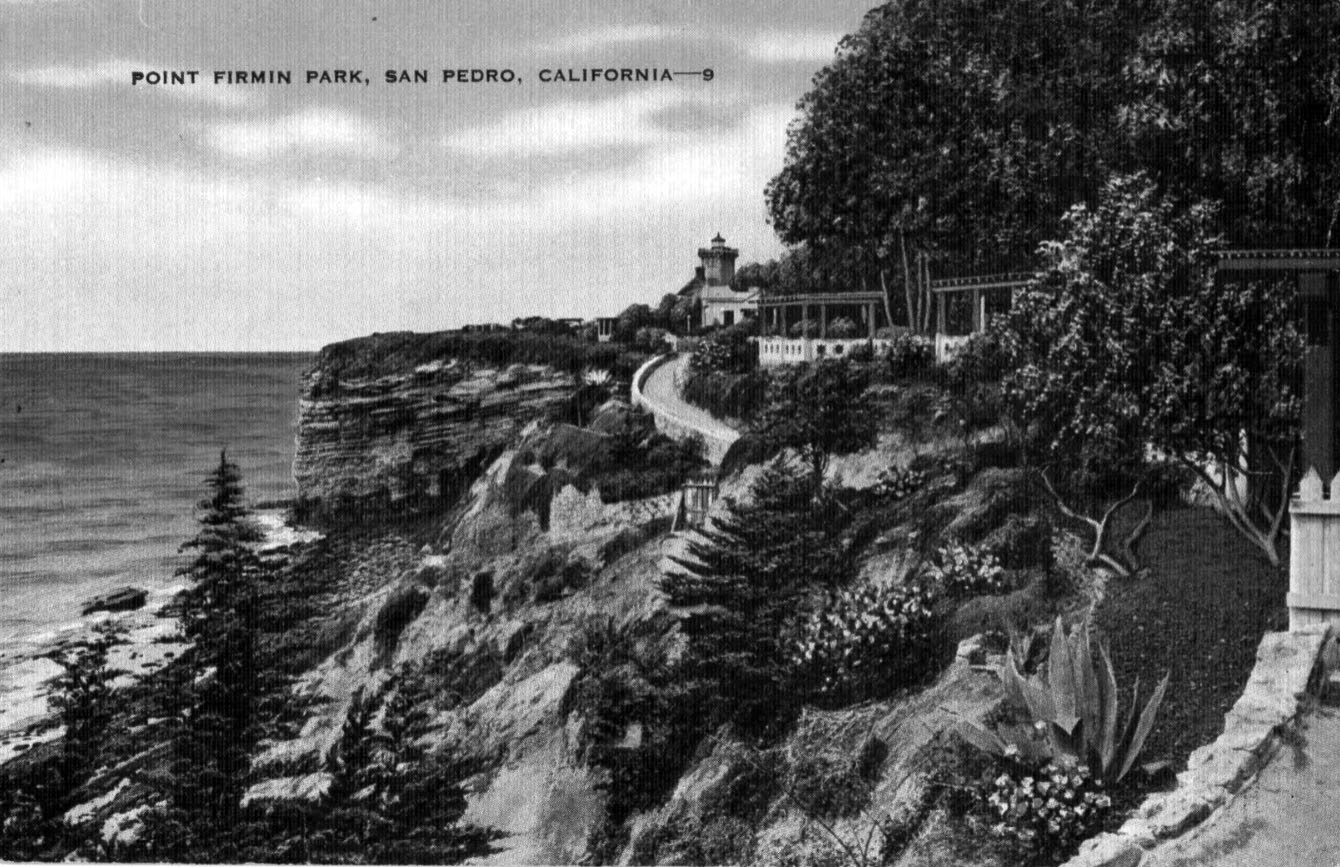 |
|
| (ca. 1930)^.^ – Postcard view showing Point Fermin Park with Point Fermin Lighthouse seen in the background. |
 |
|
| (1938)**** - Point Fermin Park Showing Lighthouse, San Pedro. |
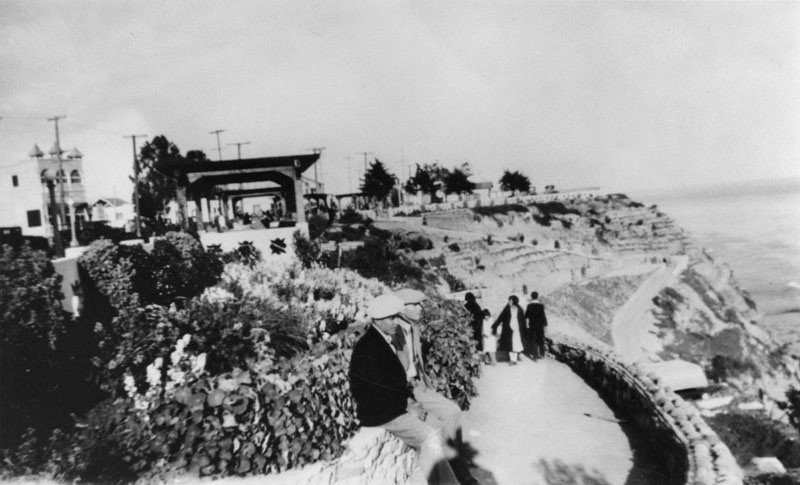 |
|
| (ca. 1930)* - People enjoying a leisurely day at Point Fermin Park in San Pedro. |
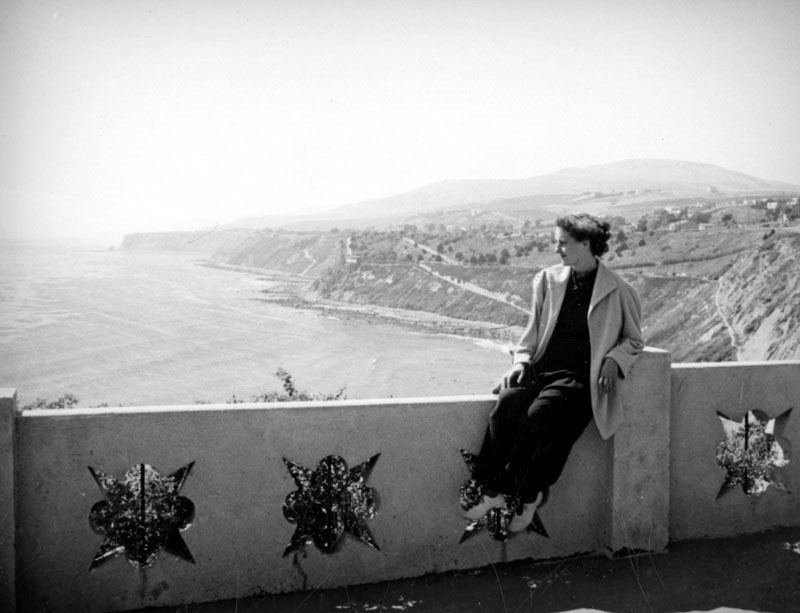 |
|
| (ca. 1937)* - Ethel Schultheis enjoys the coastal view from Point Fermin Park in San Pedro. |
Point Fermin Café
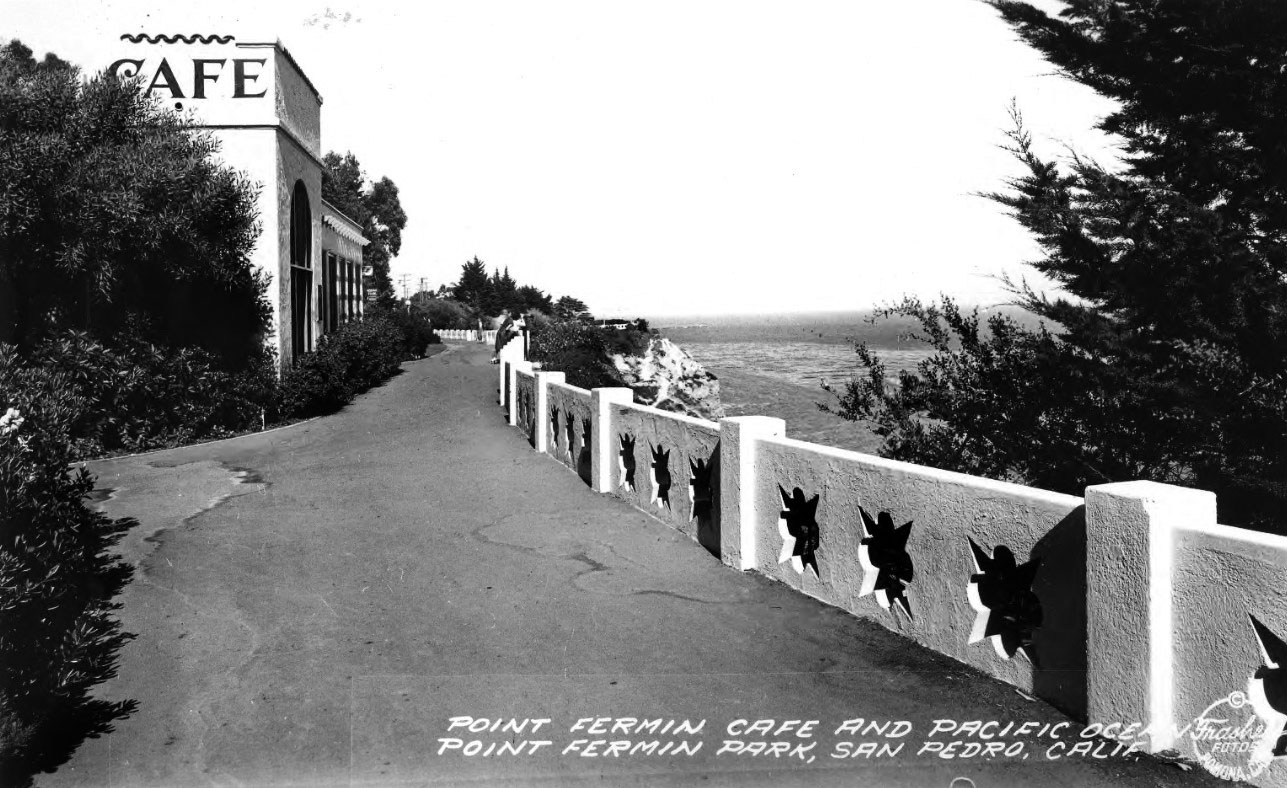 |
|
| (1938)**** – Postcard view showing Point Fermin Café and Pacific Ocean Point Fermin Park. |
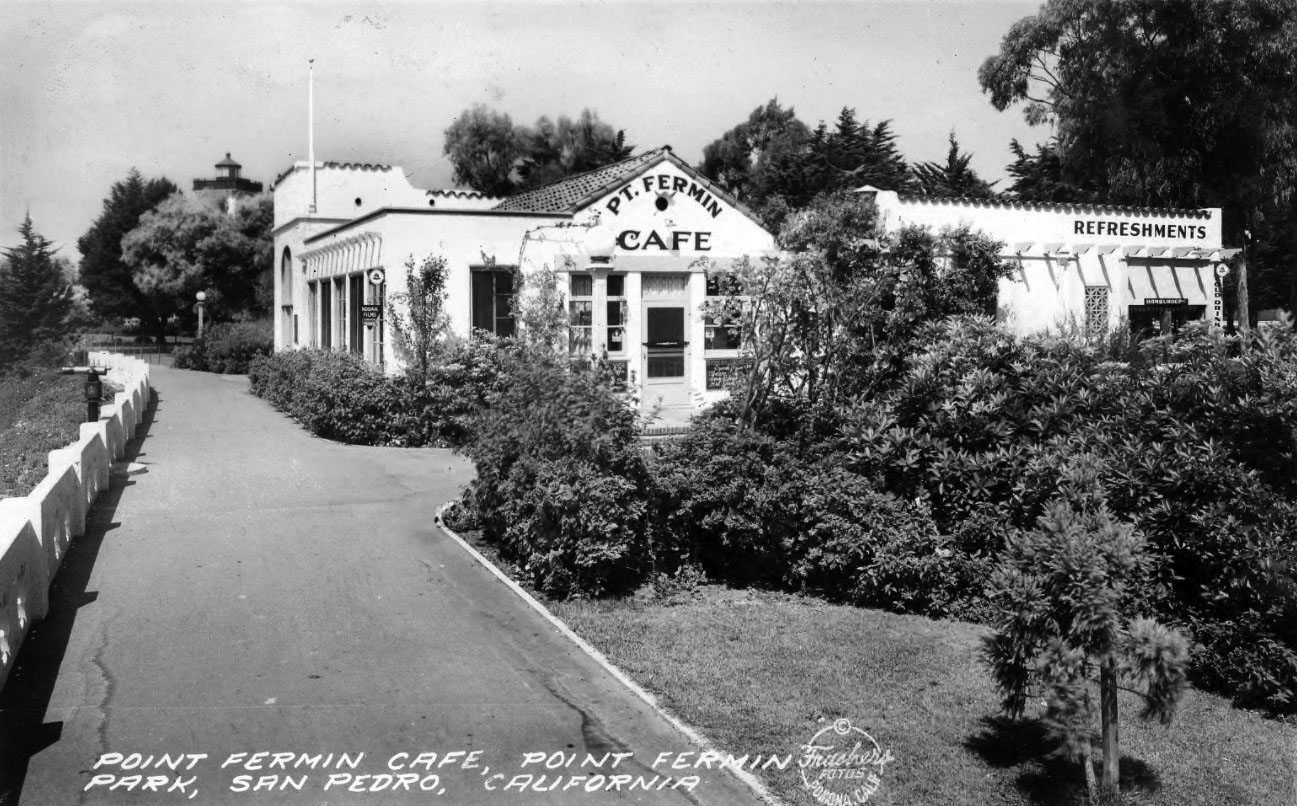 |
|
| (1938)**** – Postcard view showing the front entrance to Point Fermin Café located at Point Fermin Park. Point Fermin Lighthouse can be seen in the background. |
Historical Notes This building is now home to the American Cetacean Society, a nonprofit organization dedicated to protecting whales, dolphins, and porpoises. Click HERE for contemporary view. |
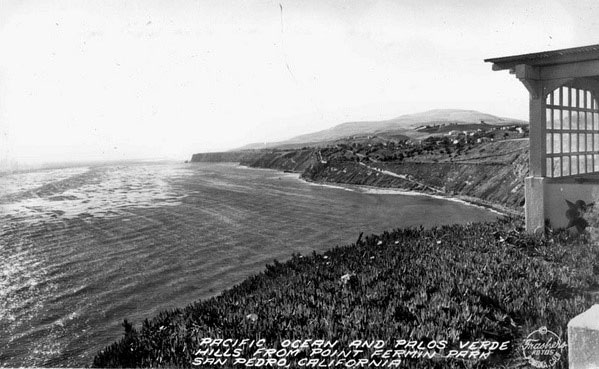 |
|
| (1938)**** - Panoramic view of the Pacific Ocean and Palos Verde Hills from Point Fermin Park, San Pedro. |
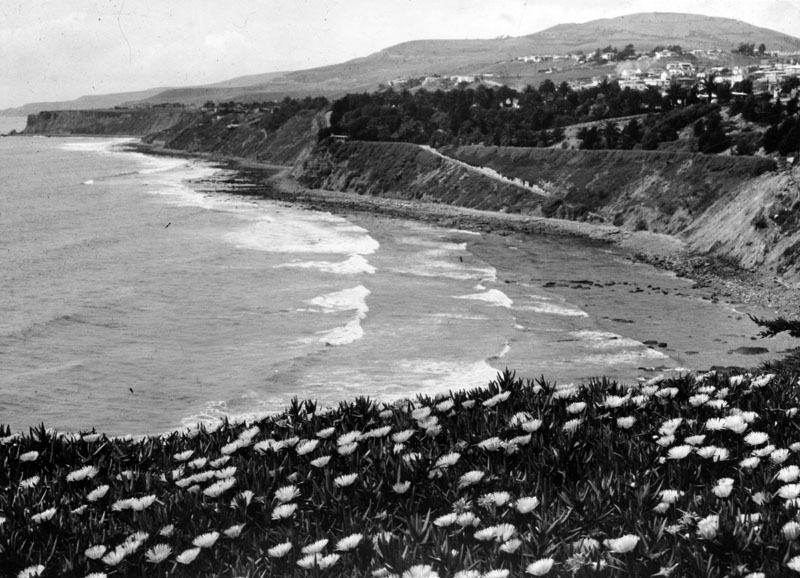 |
|
| (ca. 1938)* - Looking northwest from Point Fermin, showing the palisades and coastline of the Palos Verdes Peninsula. San Pedro residences are visible on the hillsides in the background on the right. |
* * * * * |
LA Harbor Dredging
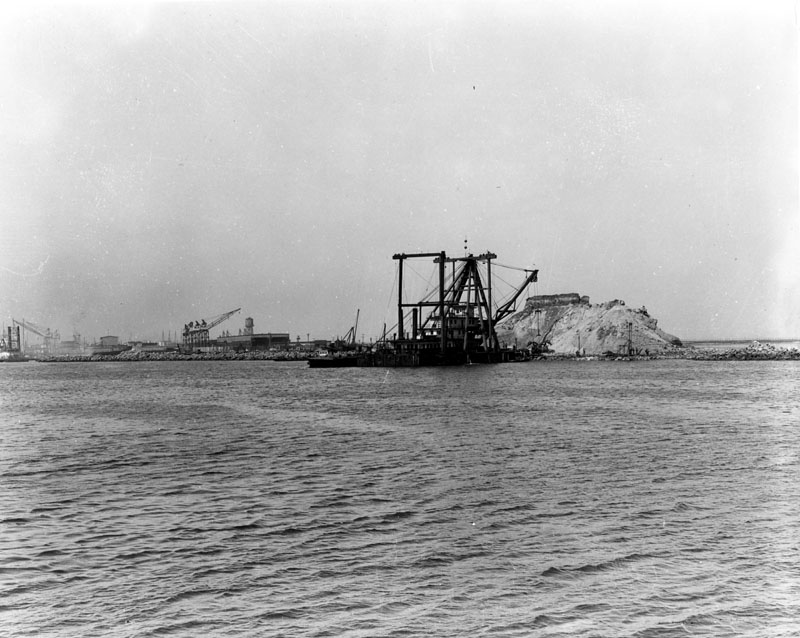 |
|
| (1920s)* - Photo shows the dredging work going on at Deadman's Island. |
Historical Notes Deadman’s Island was a San Pedro landmark, a rocky isle about 800-feet long, 250-feet wide, and over 60-feet high that guarded the entrance to Los Angeles Harbor. It was removed in the late 1920s to make room for large ships in the growing harbor. |
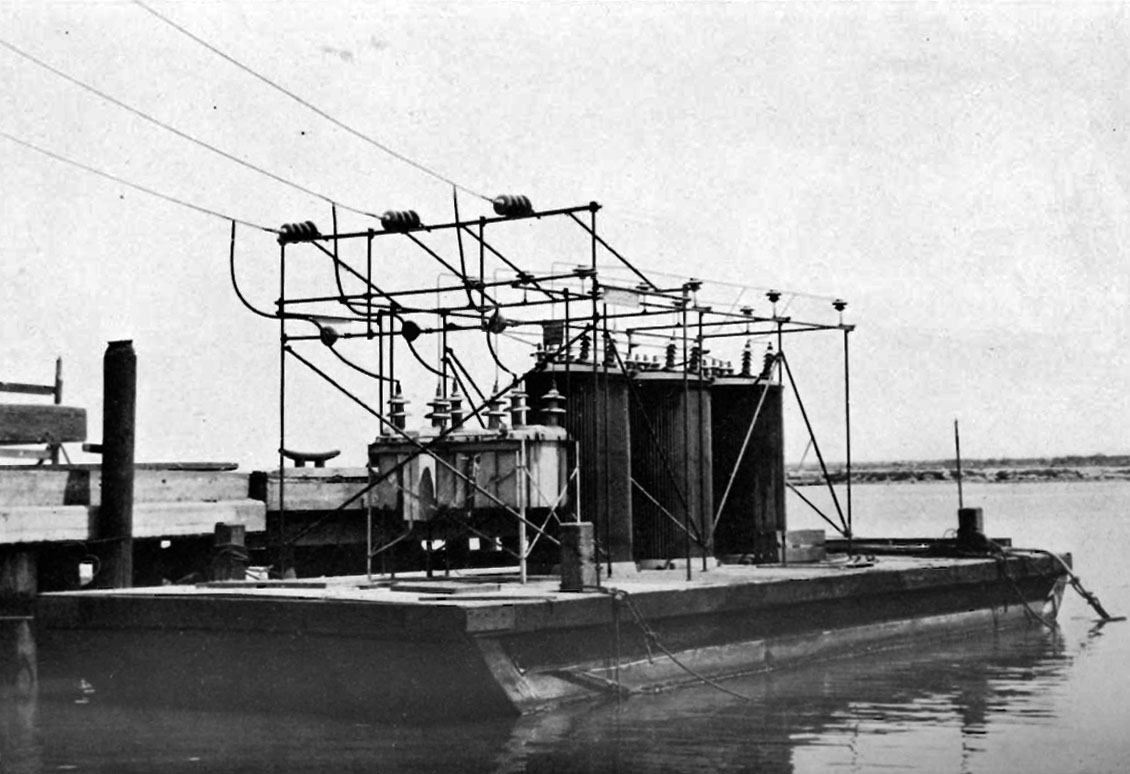 |
|
| (1924)*# – View showing a 33,000 volt Floating Distribution Station used for dredging operations at Los Angeles Harbor. Click HERE to see more in Early Views of Early Power Distribution Stations. |
Historical Notes Large electric-powered dredging equipment was used to clear and deepen the harbor. A moveable and floating source of power was needed to provide the electricity necessary to operate such machines. |
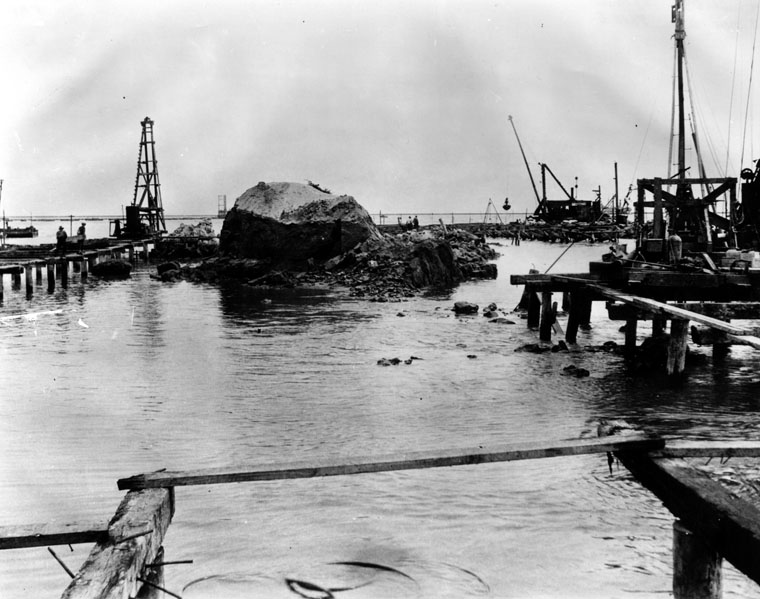 |
|
| (1928)* - Photo shows dredging machines hard at work at Deadman's Island. |
Historical Notes The land, sometimes referenced as Deadman's Island, Isla Del Muerto, and Reservation Point, was dredged away in 1928 as part of a harbor development effort. |
* * * * * |
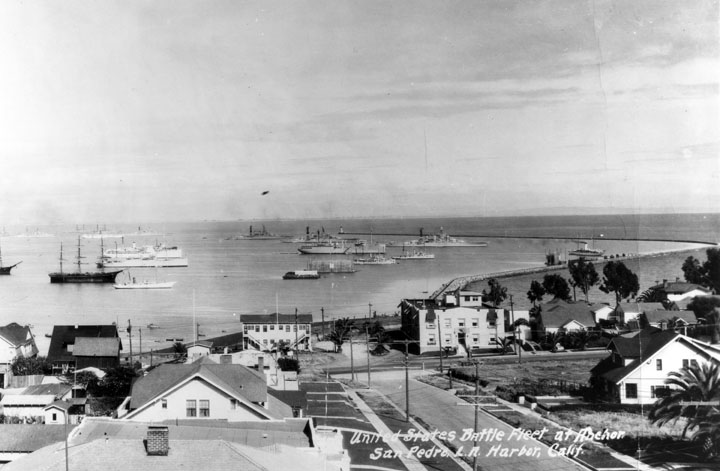 |
|
| (1926)* - Panoramic photo of San Pedro Harbor in 1926. The United States Battle Fleet is anchored in the harbor. |
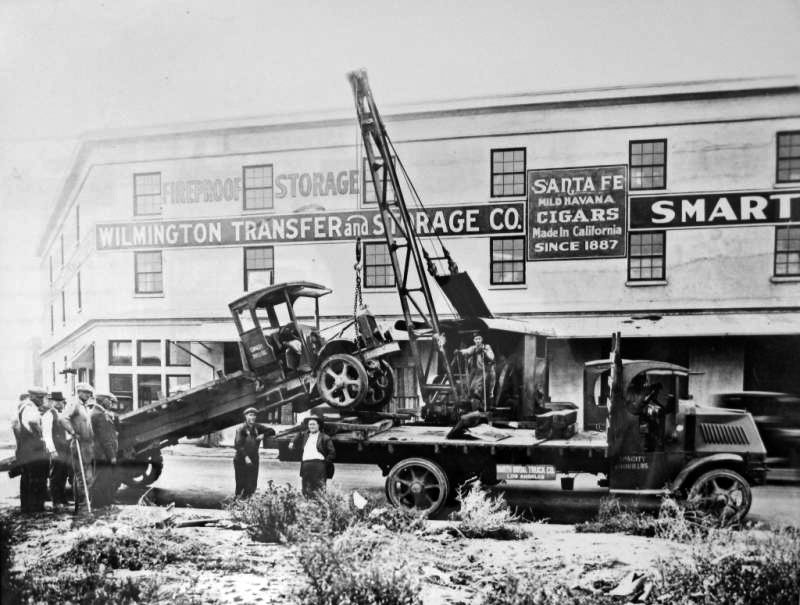 |
|
| (1920s)^* - View of a half dozen men standing in front of a crane rig lifting a truck onto the bed of a larger truck. In the background is the Wilmington Transfer and Storage Co. building (now Bekins), located on the corner of West C Street and Fries Avenue. |
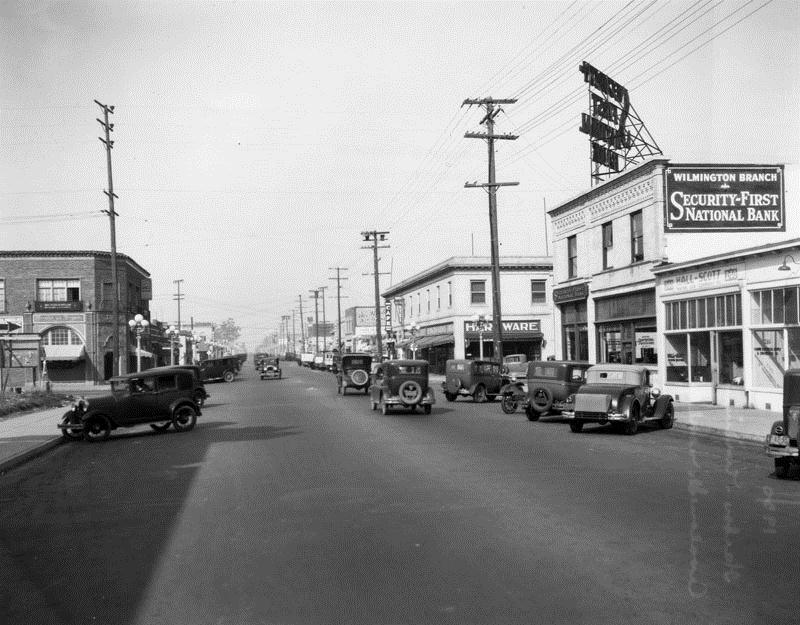 |
|
| (ca. 1920s)* - Avalon Boulevard in Wilmington with the Wilmington Branch of the Security-First National Bank on the right side. |
Historical Notes In 1921, Canal Street was renamed Avalon Boulevard. It is believed it took the name of the S.S. Avalon that was at the time tied up to the Catalina terminal, at the foot of Canal Street.*^# |
Pacific Electric Depot
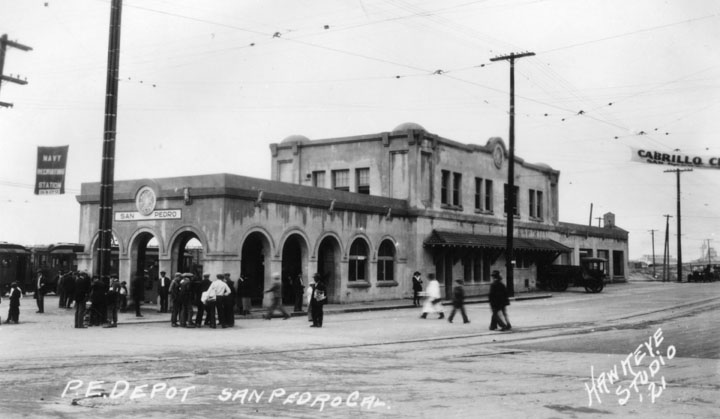 |
|
| (1921)* - View showing a couple of dozen people outside the new Pacific Electric Railway station in San Pedro. |
Historical Notes PE's two-story San Pedro depot was opened in 1920, and succumbed to the wrecking ball in 1961. The new 6th Station on the Port of Los Angeles Waterfront Red Car Line is located just east of the former PE station site, adjacent to the entrance of the Maritime Museum. |
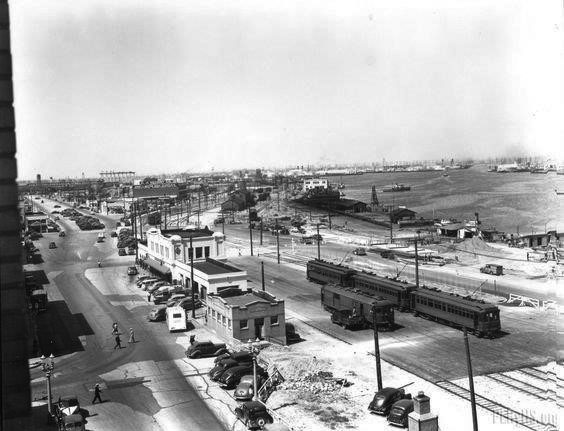 |
|
| (1935)^.^ – View of the Pacific Electric’s San Pedro Station showing 3-car train waiting for passengers before departing as a former Portland Electric Express motor loads “LCL” cargo. |
Historical Notes The San Pedro Station was one of PE’s larger suburban stations. It remained in service until after the abandonment of the San Pedro Line in December of 1958. Today, there is no trace of this impressive station. |
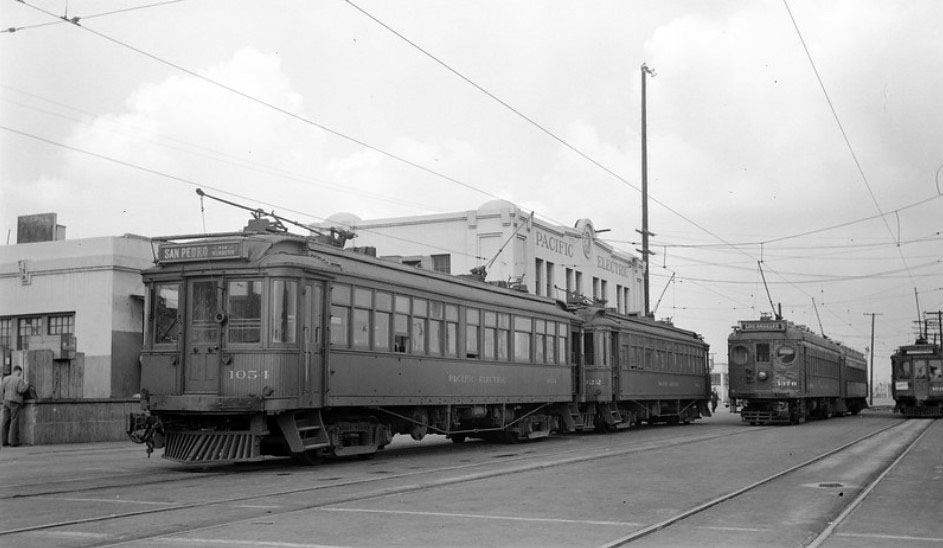 |
|
| (1946)^*^ - Train Time at PE San Pedro Station. |
Historical Notes With the Port of Los Angeles at its doorstep the San Pedro Line was a heavy source of traffic for Pacific Electric. Not only was it the busiest freight line on the PE, it was also no slouch for passenger ridership. On October 29, 1946 photographer Al Haij shot this busy scene at the San Pedro Station. On the left the Station Agent checks the LCL express that the Box Motor has left. Cars 1054 and 1022 are just in from LA with Combo 1376 and another 1200 soon to leave for the City. Car 1018 to the right will run on the Long Beach - San Pedro Line through Wilmington. |
* * * * * |
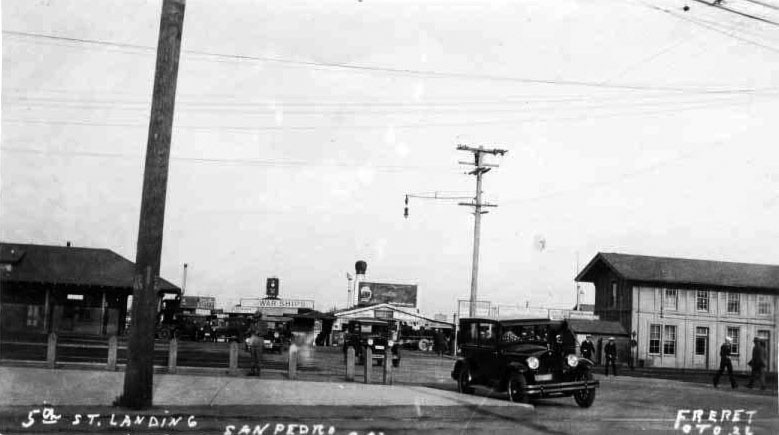 |
|
| (ca. 1928)^* - View of the 5th Street Landing at San Pedro Harbor. Several sailors in uniform are seen walking at right. Sign on top of building in the distance reads: War Ships |
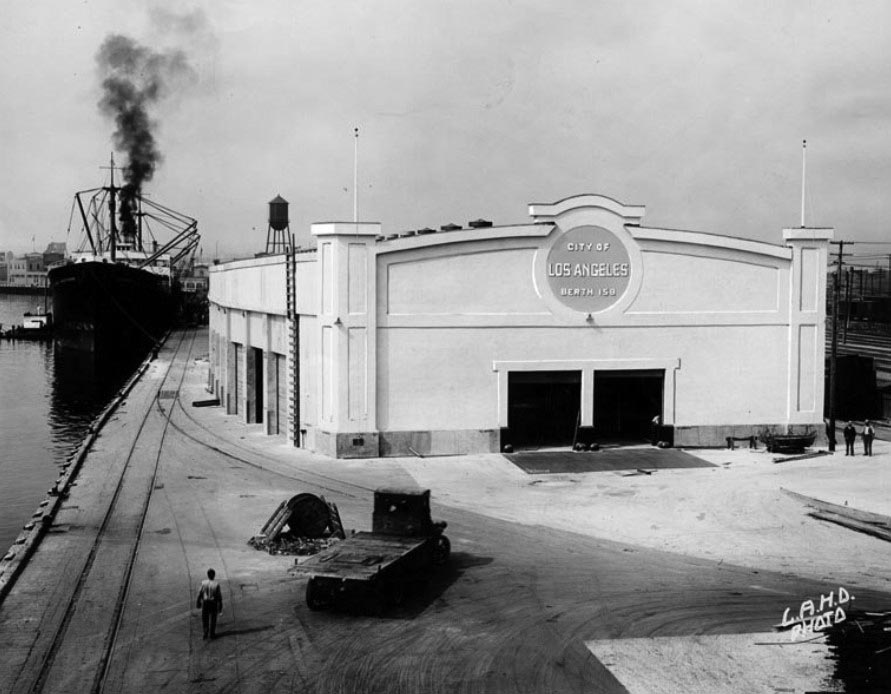 |
|
| (1928)#** – View showing Berth 158 at Los Angeles Harbor with cargo ship docked at left. |
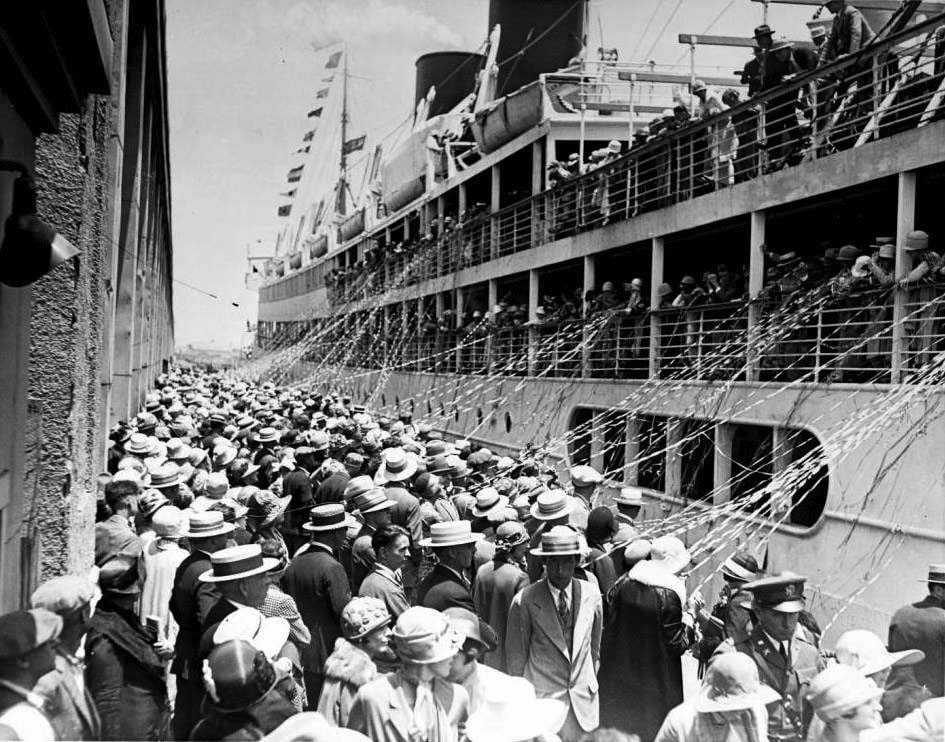 |
|
| (1920s)* - Port of Los Angeles filled with well-wishers seeing the SS City of Los Angeles as it heads toward Hawaii. |
Historical Notes The SS City of Los Angeles was part of the Los Angeles Steamship Company line that sailed the highly competitive California-Hawaii market. |
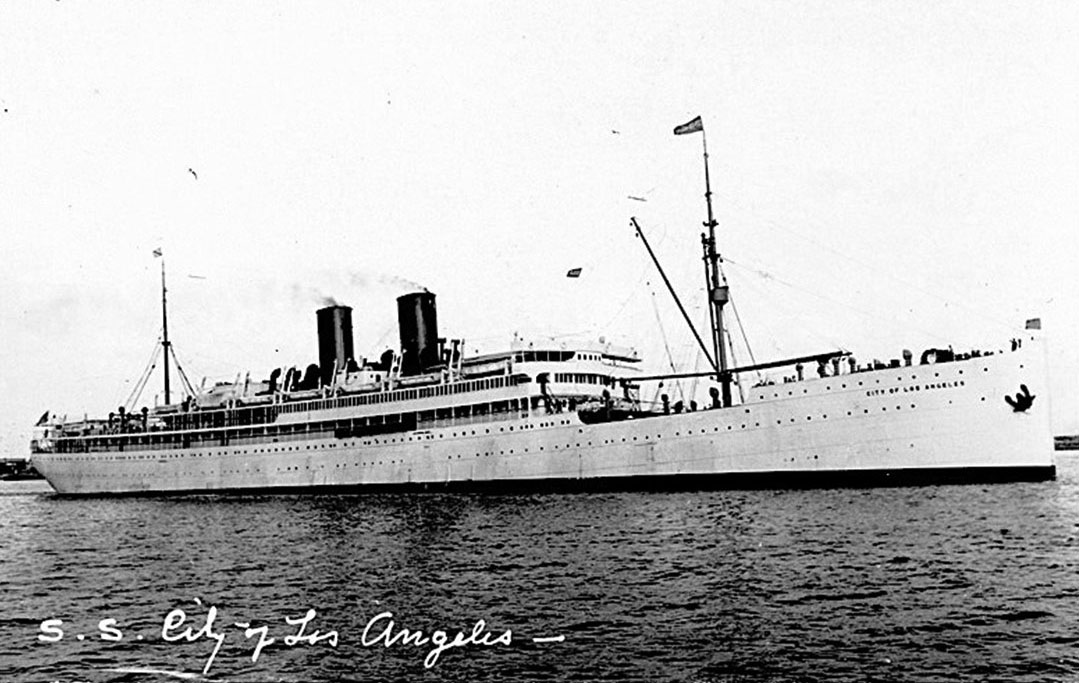 |
|
| (1920s)* - SS City of Los Angeles as it heads toward Hawaii. |
Historical Notes Originally commissioned as USS Grosser Kurfürst, the ship was renamed Aeolus — after the god of wind in Greek mythology — while undergoing repairs and conversion at a U.S. Navy yard. The ship carried almost 25,000 men to France during the hostilities, and returned over 27,000 healthy and wounded men after the Armistice. After decommissioning by the U.S. Navy, the ship was turned over to the United States Shipping Board and underwent a $3,000,000 refit in Baltimore, Maryland, and was transferred to the Munson Steamship Company for whom she carried passengers and freight to and from South American ports as SS Aeolus. In 1922 the ship was assigned to the Los Angeles Steamship Co. and renamed SS City of Los Angeles and sailed to and from Los Angeles and Honolulu. In 1937, the ship was sold for scrapping in Japan.^ |
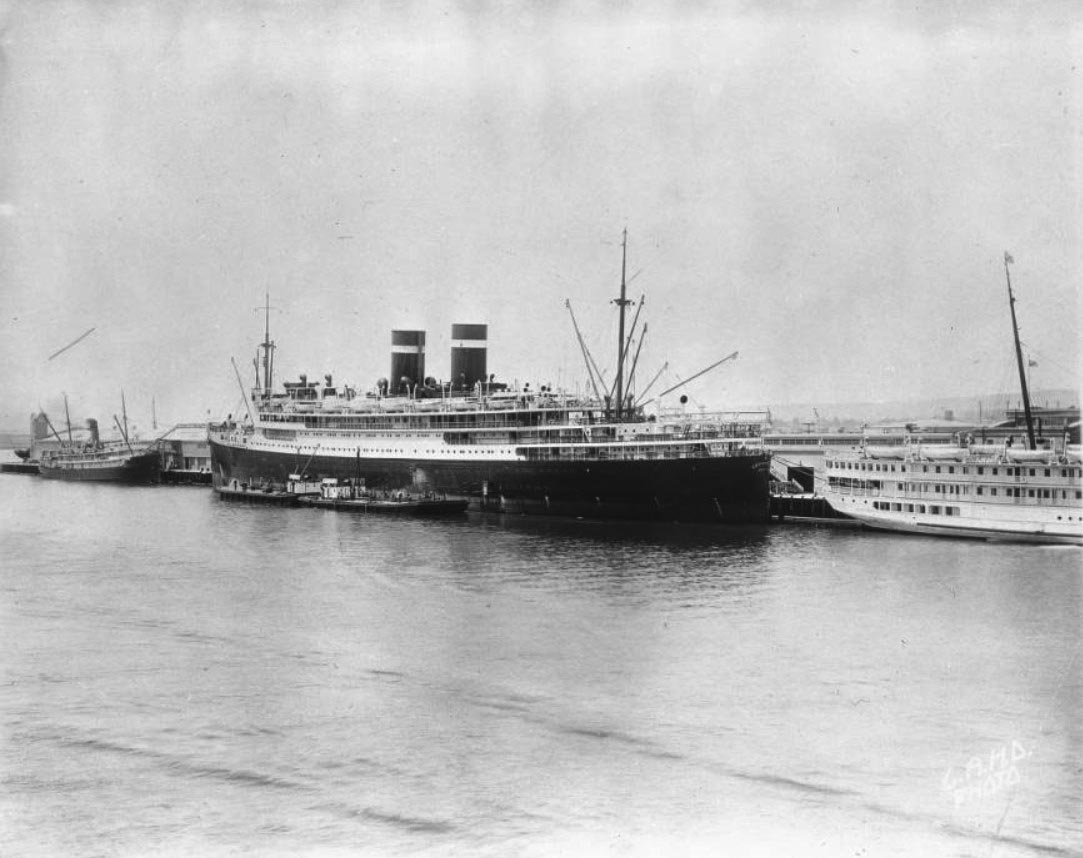 |
|
| (1928)^^ – View showing the S.S. California in Los Angeles Harbor. The large ship floats in the rippling water at center with the long harbor behind her and smaller ships to either side. |
Historical Notes The SS California was the World's first major ocean liner built with turbo-electric transmission. When launched in 1927 she was also the largest merchant ship yet built in the US, although she was a modest size compared with the biggest European liners of her era. In March 1936 an unofficial strike aboard SS California in port at San Pedro, held without the sanction of the International Seamen's Union, led to the foundation of the National Maritime Union. In 1938 California was renamed SS Uruguay. From 1942 to 1946 she was operated through agents by the War Shipping Administration as the troopship Uruguay. She was returned to civilian service as SS Uruguay in 1948, laid up in 1954 and scrapped in 1964.*^ |
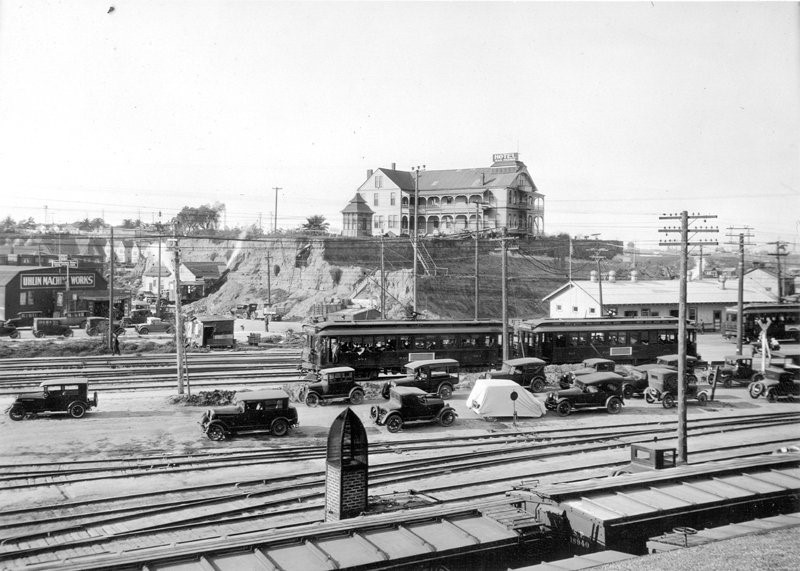 |
|
| (1928)#*^* – View looking northwest from the roof of the First Street wharf. Cars are seen parked between the Pacific Electric tracks and train. In the distance on top of First Street, sits the Hotel San Pedro. |
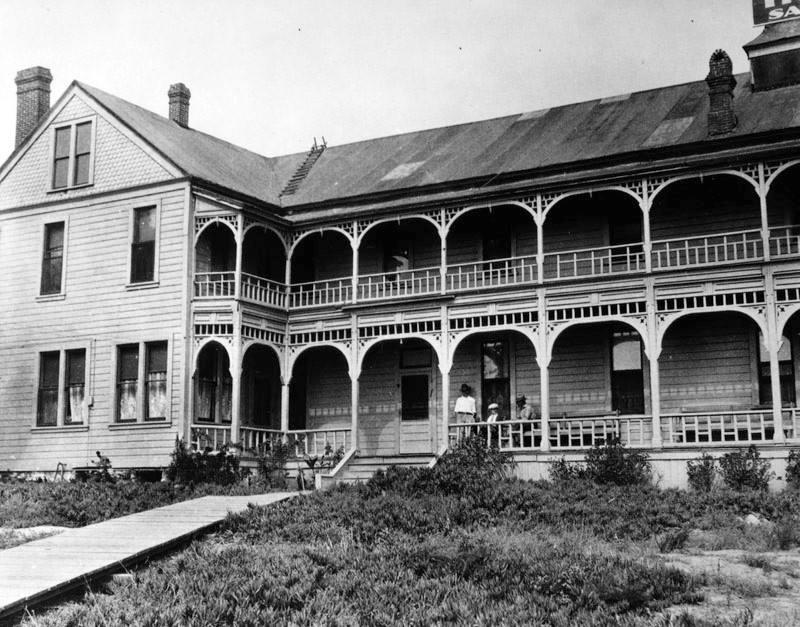 |
|
| (ca. 1903)^^ – Close-up view of the Hotel San Pedro (formerly the “Clarence Hotel”) with three people seen lounging on the porch. The hotel was later used as San Pedro Peninsula Hospital. |
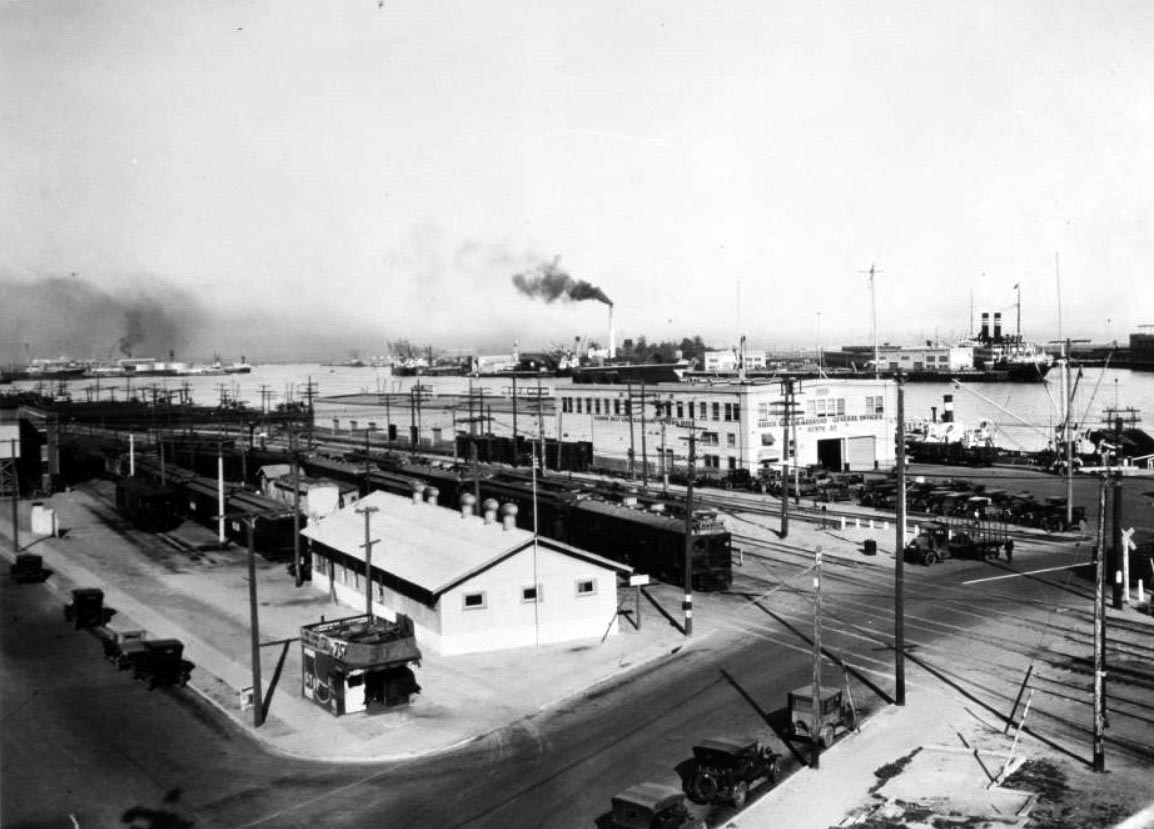 |
|
| (ca. 1930)^^ - View of Los Angeles Harbor showing a street car sitting on the tracks that intersect the road in the center. An intersection can be seen in the left foreground while smoke is seen billowing out of a smokestack in the center background. A large building behind the tracks sits next to the water and reads: "Harbor Belt Line Railroad General Office Berth 90". Photoprint reads: "Los Angeles Harbor 1930 --with tonnage second only to New York Harbor.” |
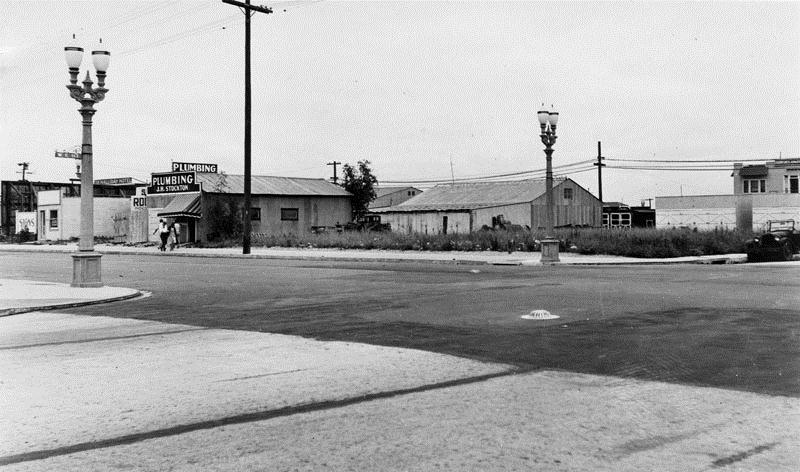 |
|
| (1930)* - The northeast corner of Avalon Boulevard and West E Street, Wilmington. J. H. Stockton Plumbing is seen, as well as the Halliday Hotel. |
Cabrillo Beach
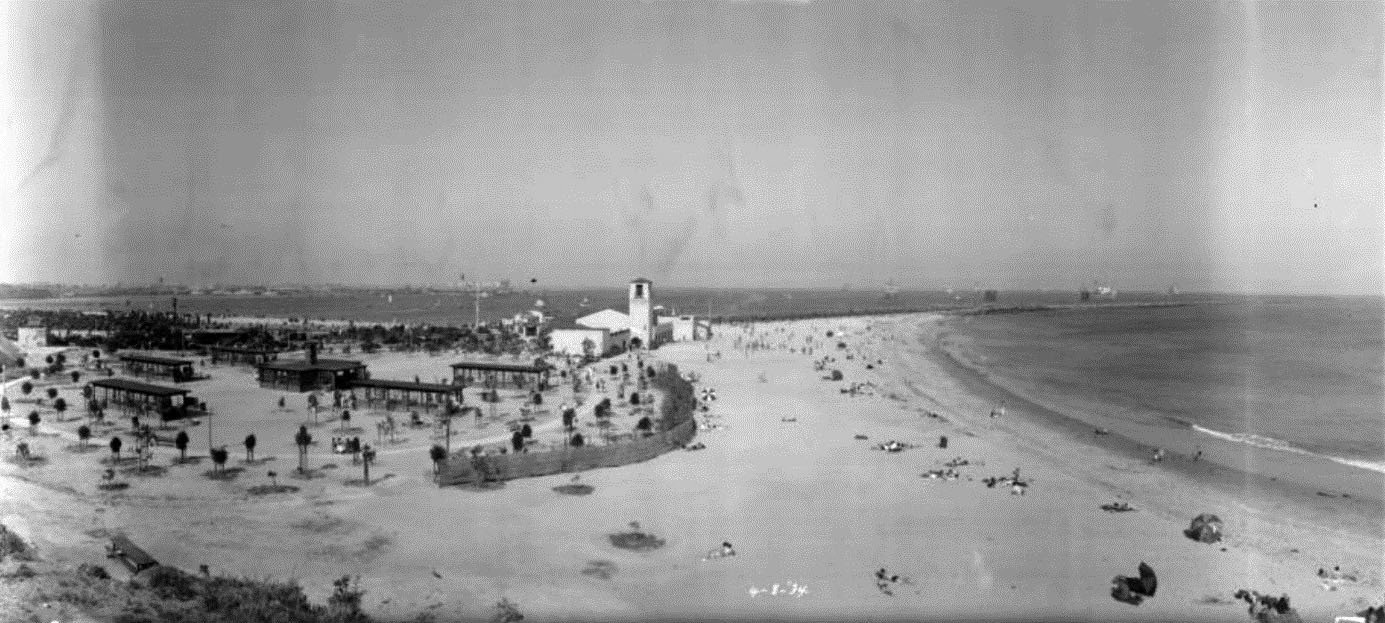 |
|
| (1934)#* - Panoramic view of Cabrillo Beach in San Pedro on April 8, 1934. The beach is divided into two curved strands, one on each side of the breakwater. In between the two stretches of sand is a picnic area and the Cabrillo Beach Bath House. |
Historical Notes Cabrillo Beach is named after Juan Rodriguez Cabrillo, who was the first European to sail along the coast of California. |
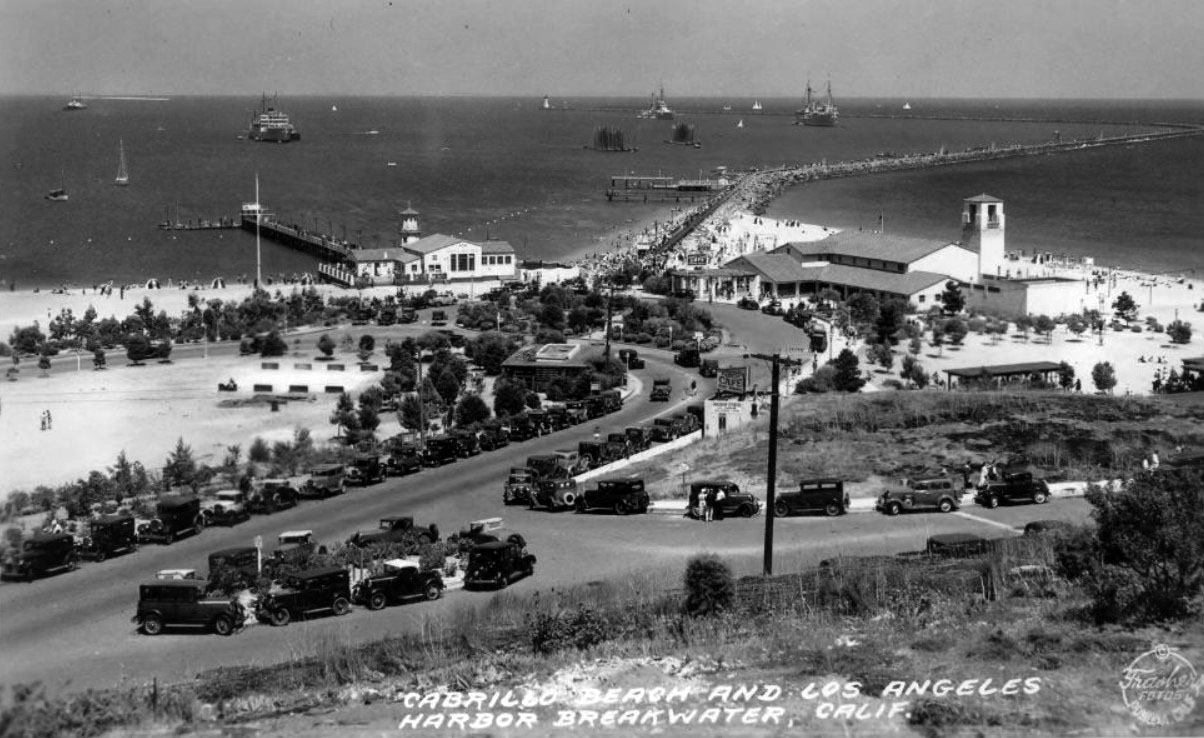 |
|
| (1936)^ – Postcard view of Cabrillo Beach and Bath House on a busy day with the Los Angeles Harbor breakwater in the background. |
Historical Notes The Cabrillo Beach Bath House was originally built in 1932 and used for the 1932 Olympic Games. It was rehabilitated in 2002. |
 |
|
| (1936)* - Cabrillo Beach with full parking lot.^ |
Historical Notes In the early 1900s, the ocean water traveled right up to the cliffs; there was no sand between the cliffs of San Pedro and the ocean. So after completion of the breakwater, sand was added in 1927 in order to create the outer beach. The addition of sand was from the harbor dredging. As a result of the addition of sand, the expansive outer beach of Cabrillo was created. Cabrillo Beach opened in 1928, and residents of San Pedro, Wilmington, and Los Angeles flooded to it to enjoy the new Southern California beach. The San Pedro city leaders were excited to have a newly added destination for visitors and residents to enjoy in San Pedro.* |
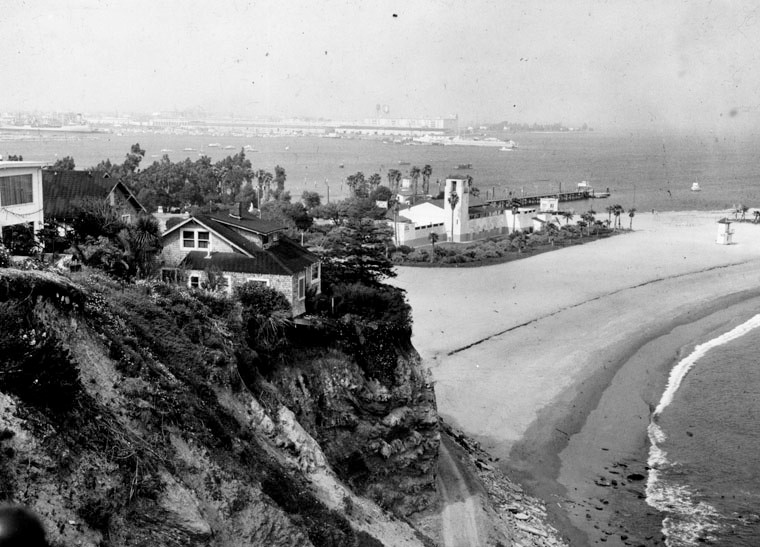 |
|
| (1930s)* – View of Cabrillo Beach with the bathhouse in the distance as seen from up on the cliffs. |
Historical Notes In 1993, the Cabrillo Beach Bathouse, located at 3720 Stephen White Drive, was dedicated LA Cultural-Monument No. 571 (Click HERE for complete listing). |
Then and Now
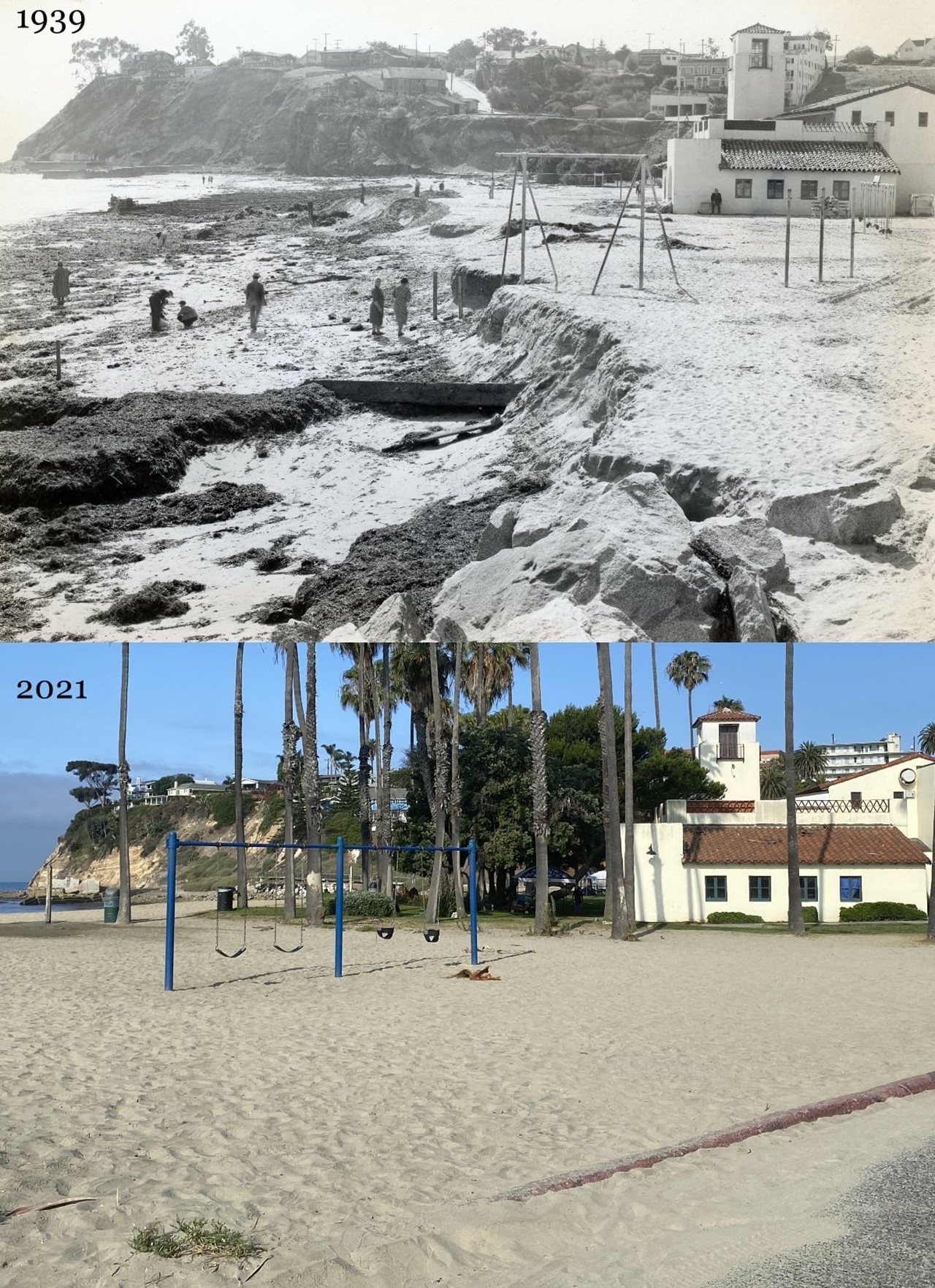 |
|
| (1937 vs. 2021)* |
Historical Notes September 1939 - The top photo shows erosion and clean up efforts at Cabrillo Beach in San Pedro after a tropical storm hit Southern California. |
* * * * * |
San Pedro Branch of the LA Public Library
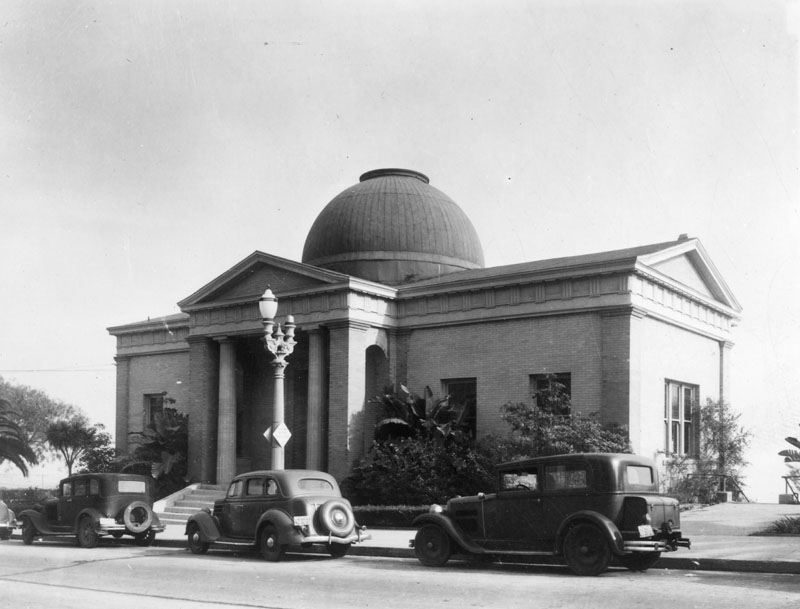 |
|
| (ca. 1935)* - View of the second building to serve as the San Pedro Branch of the Los Angeles Public Library, located at 820 S. Beacon St. |
Historical Notes Originally the San Pedro Branch of Los Angeles Public Library from 1906-1923, this structure was built with an initial grant of $10,000 from Andrew Carnegie, followed by a supplementary $375 from Carnegie and $500 from the city. Architects Edelsvard and Saffell, as well as H. V. Bradbeer, have been credited with the design of the Classical Revival style building. After it served as the office of the San Pedro Chamber of Commerce, it was the Seamen's Library until 1966, when it was demolished to make way for the Maritime Industry Memorial.* |
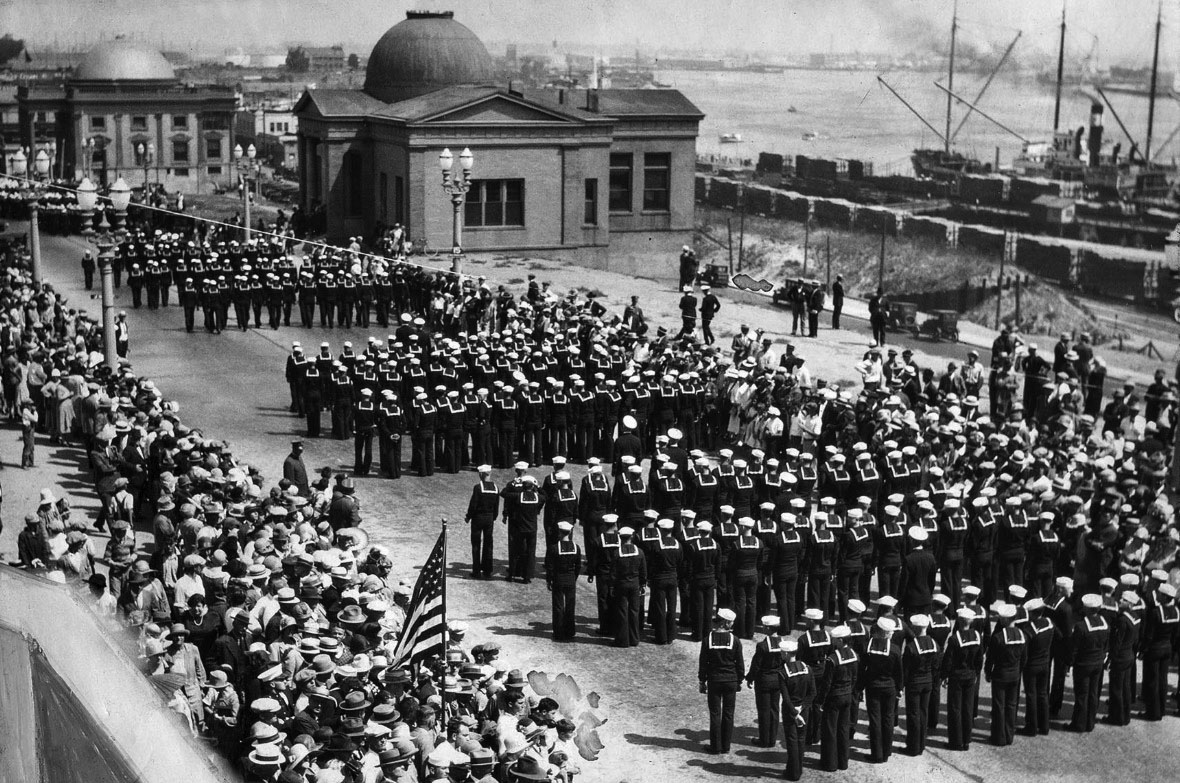 |
|
| (1926)^** – Five thousand Marines and sailors from the U.S. Navy battle fleet march on Beacon Street in San Pedro. City Hall (built in 1909) is in the upper left corner. The other domed-building is the old San Pedro Branch of the LA Public Library building, seen here when it was occupied by the San Pedro Chamber of Commerce. |
Historical Notes The San Pedro City Hall Building seen above would be domolished in 1927 to make way for a new 7-story City Hall and Municipal Building (1928). |
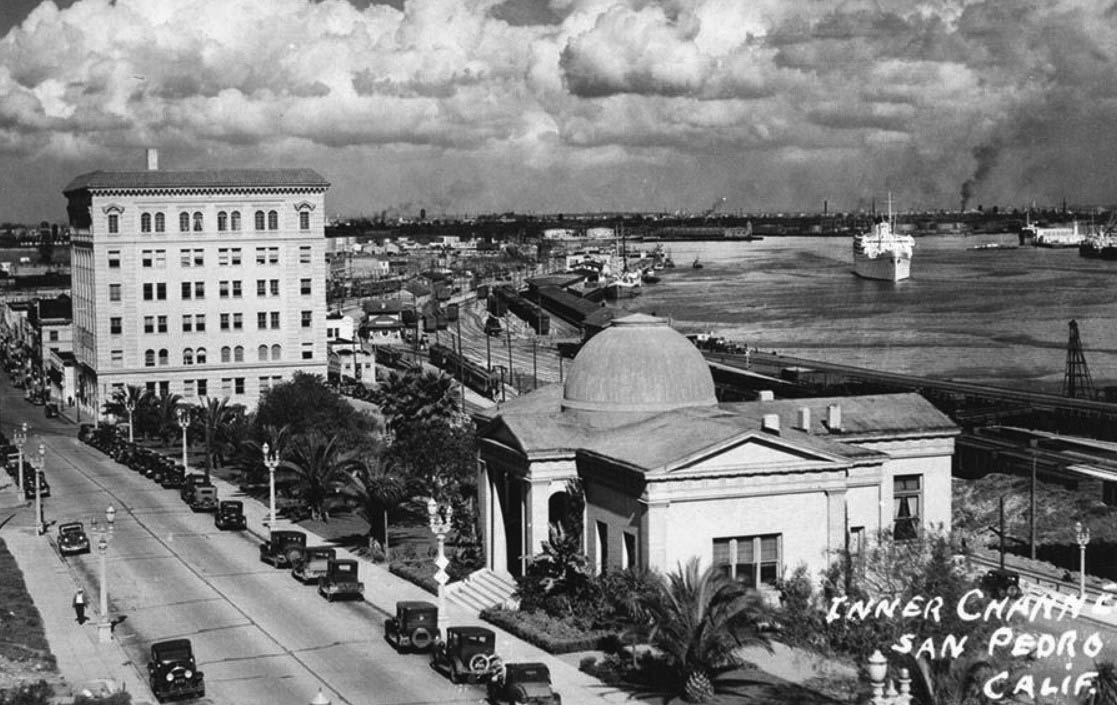 |
|
| (ca. 1930)#*^ – Postcard view looking north from 9th Street showing the Inner Channel with steam ship approaching. The new City Hall and Municipal Building is at upper left and in the foreground is the San Pedro Chamber of Commerce Building (previously a branch of the LA Public Library). |
San Pedro City Hall and Municipal Building
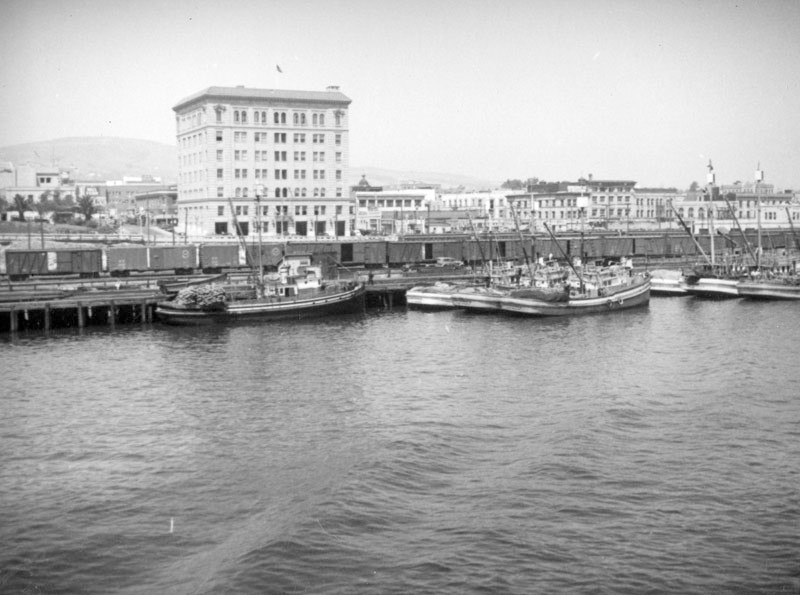 |
|
| (1928)* – View showing downtown San Pedro, including the seven-story, 1928-built City Hall and Municipal Building (center left) as seen from the S.S. Catalina as it leaves the Port of Los Angeles. |
Historical Notes The new San Pedro City Hall and Municipal Building was built on the same site where the previous San Pedro City Hall Building stood between 1909 and 1928. |
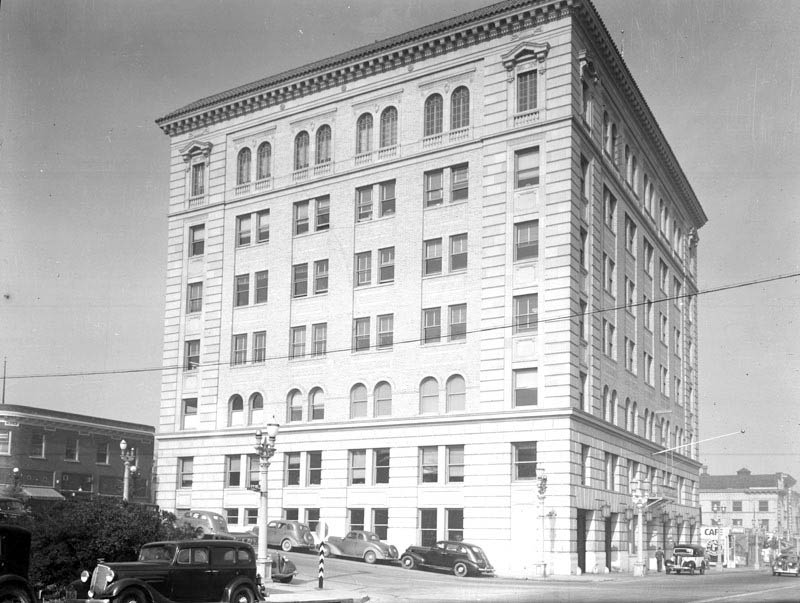 |
|
| (1938)* - Exterior view of the Municipal Building in San Pedro, also known as the San Pedro City Hall, located at 638 S. Beacon Street in San Pedro. |
Historical Notes Opened in 1928, this seven-story Beaux Arts was built by the Charles W. Pettifer Construction Company under the supervision of Charles O. Brittain of the City of Los Angeles Construction Dept. Specific floors were used for certain purposes: the ground floor basement was a fire station then converted into a garage, the 6th floor included a courtroom, and the 7th floor held an old jail known as, "7th Heaven." * |
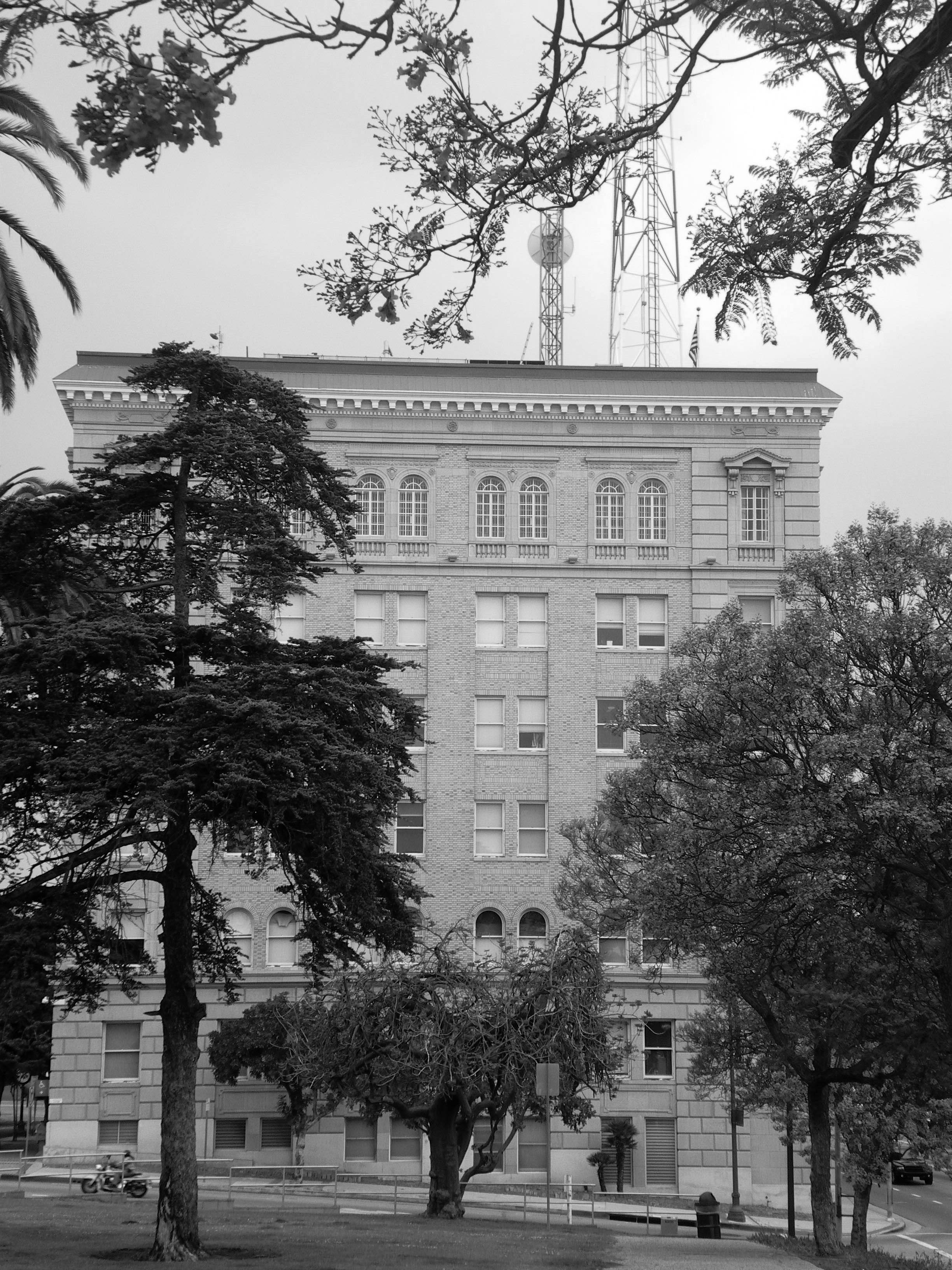 |
|
| (2008)*^ - View showing the San Pedro Municipal Building, located at 638 S. Beacon St., San Pedro. |
Historical Notes Also known as "San Pedro City Hall", the seven-story Beaux Arts building is the tallest building in San Pedro. It includes an old jail, a wood-paneled courtroom, and a fire station converted into a museum.*^ In 2002, the San Pedro Municipal Building was dedicated LA Historic-Cultural Monument No. 732 (Click HERE for complete listing). |
* * * * * |
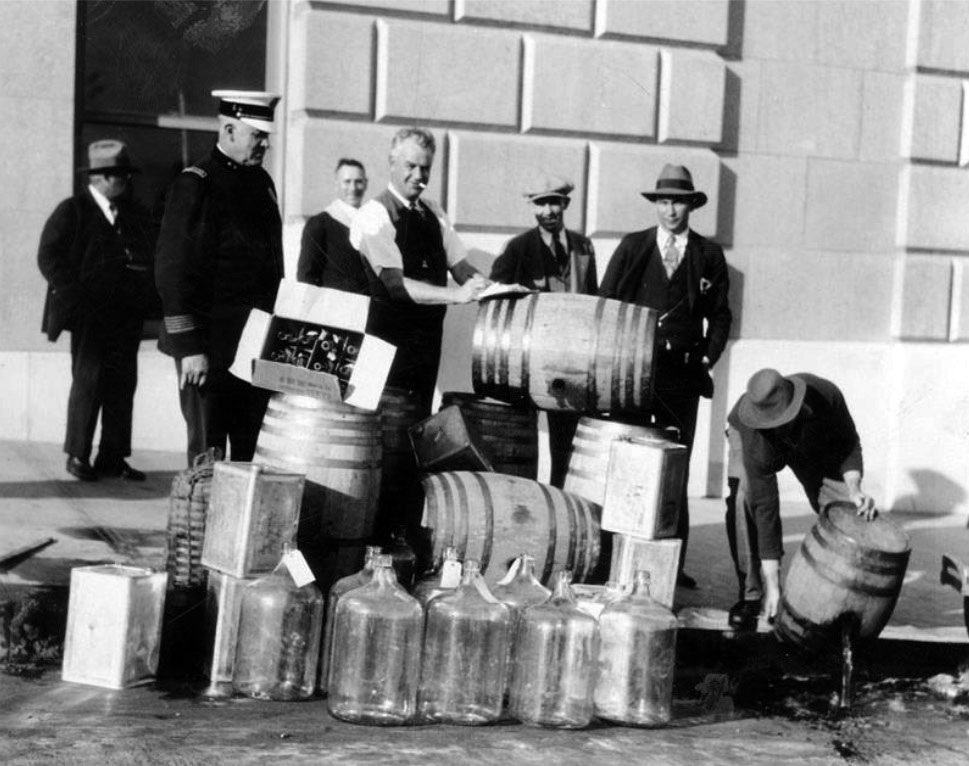 |
|
| (1930)^*^# - Commander of the San Pedro police division, Capt. Daniel M. Long (wearing uniform), watches as a trustee of the harbor jail pours a barrel of whiskey into the gutter. Shortly before this photo was taken, over 4,000 gallons of bootleg alcohol had been seized in the harbor district-San Pedro, Wilmington, Terminal Island and Harbor City. |
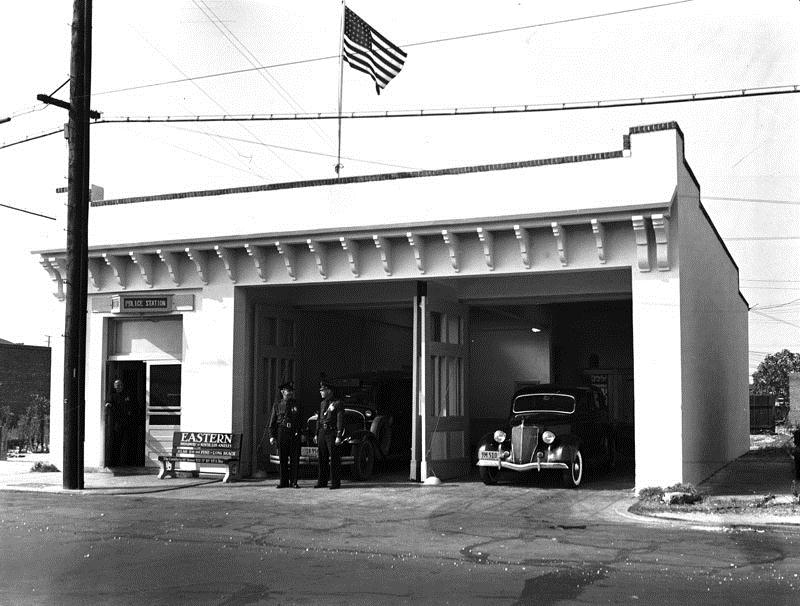 |
|
| (1936)* - Exterior view of the Wilmington Division police station at 115 B Street, Wilmington. Three uniformed officers stand in front, and two cars are parked in the garage, facing forward. |
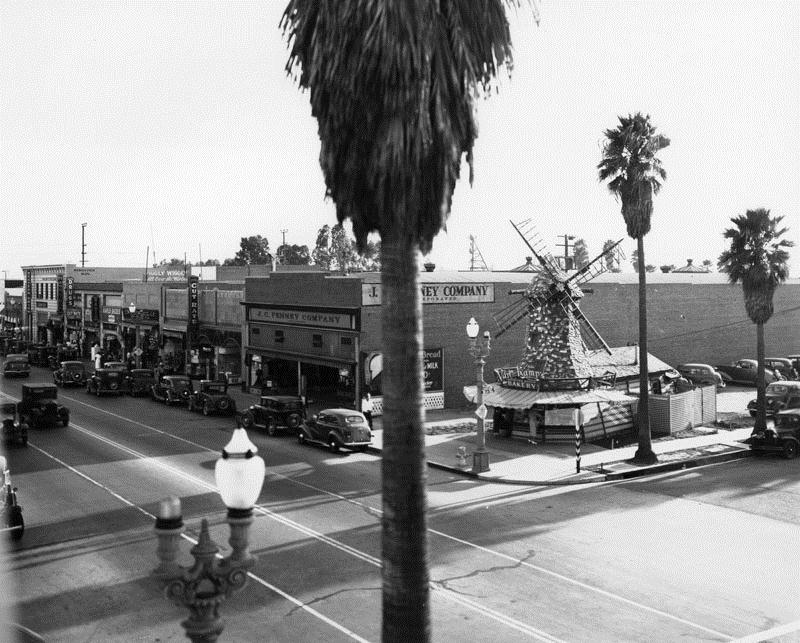 |
|
| (1937)* - View of a business area in Wilmington. Photo shows Van de Kamp's Bakery at the corner of Avalon Boulevard and West I Street. Other businesses includes: J.C. Penney Company building; Cut Rate store and Karl's Shoes. |
Historical Notes Note the dual-lamp style streetlight posts. One side is capped off either for energy conservation or for keeping illumination levels to a minimum. Click HERE to see more in Early L.A. Streetlights. |
.jpg) |
|
| (1937)* - Another angle and a closer view showing the Van de Kamp's Bakery on the corner of Avalon Boulevard and West I Street. |
Historical Notes Van de Kamp's Holland Dutch Bakeries was a bakery founded in 1915 and headquartered in the Van de Kamp Bakery Building in Los Angeles. The company's trademark blue windmills featured on their grocery store signs and atop their chain of famous restaurants that were known throughout the region. The bakery was sold by the Van de Kamp family and acquired by General Baking Co. in 1956. The company was sold to private investors in 1979, and closed in bankruptcy in 1990. Former Los Angeles County District Attorney John Van de Kamp is a grandson of the baker's founder. The family also founded Lawry's Restaurants and the Tam O'Shanter Inn.*^ |
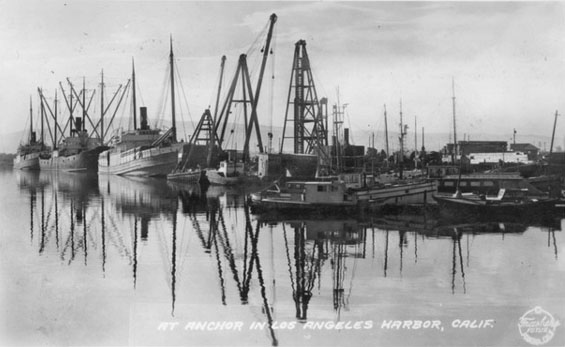 |
|
| (1936)*#* - Postcard view of boats anchored at the Los Angeles Harbor. |
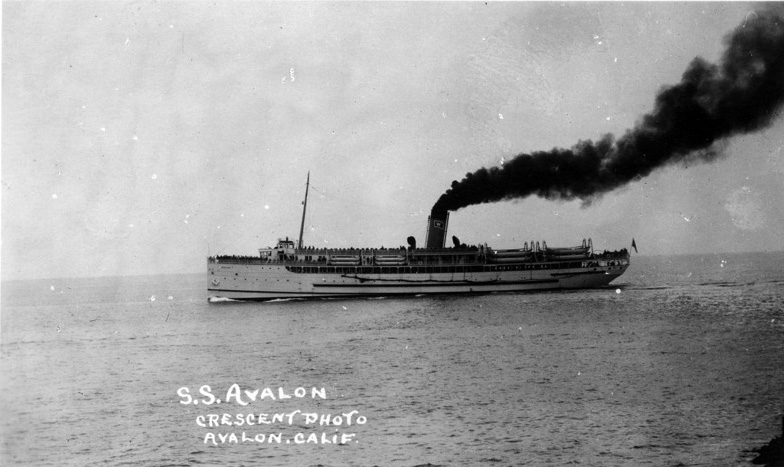 |
|
| (ca. 1920)#** - Postcard view of the S.S. Avalon between Calalina Island and San Pedro. |
Historical Notes Launched as the S.S. Virginia, the passenger ship carried passengers between Chicago and Milwaukee. In 1918, she was requisition by the Navy for use in the first world war and renamed the U.S.S. Blueridge. However, to get her through the St. Lawrence River locks, her bow and 6 feet of her stern had to be cut off and later reassembled. While waiting for orders in Boston harbor, the Navy finally decided she was no longer needed and she was sold as surplus to William Wrigley, owner of the famous chewing gum company and Catalina Island. The ship was renamed Avalon and was sent from New York via the Panama Canal, arriving April 5, 1920 and moored at the Catalina Terminal. However, her debut would not take place until the arrival of William Wrigley Jr. On April 15, 1920, the Avalon left on her first trip to Catalina, taking her full capacity of 3,000 people.*^# |
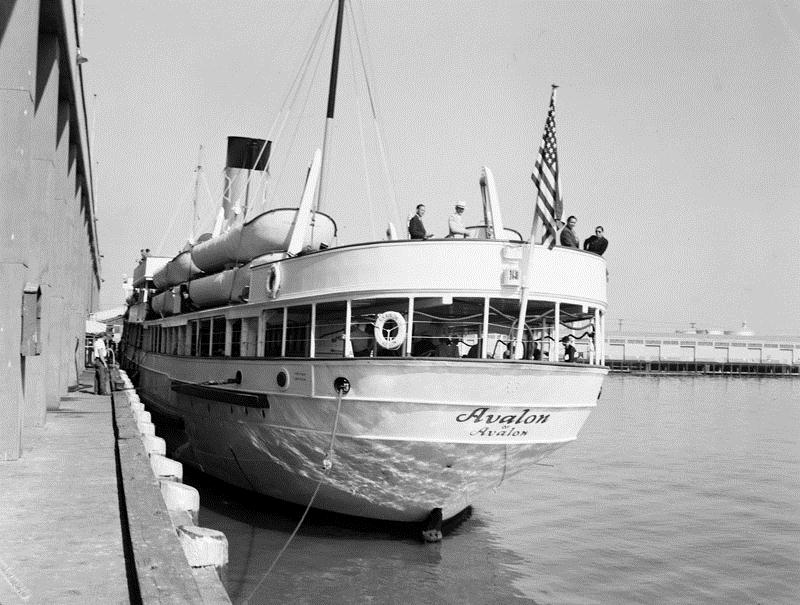 |
|
| (ca. 1936)* - The S.S. Avalon shown at the dock in the Wilmington harbor before leaving for Santa Catalina. |
Historical Notes The Avalon was tied up to the Catalina terminal, at the foot of a Canal street that ran through San Pedro. At some point in time around 1921, the ship's name was bestowed upon Canal Street and changed to Avalon Blvd.*^# |
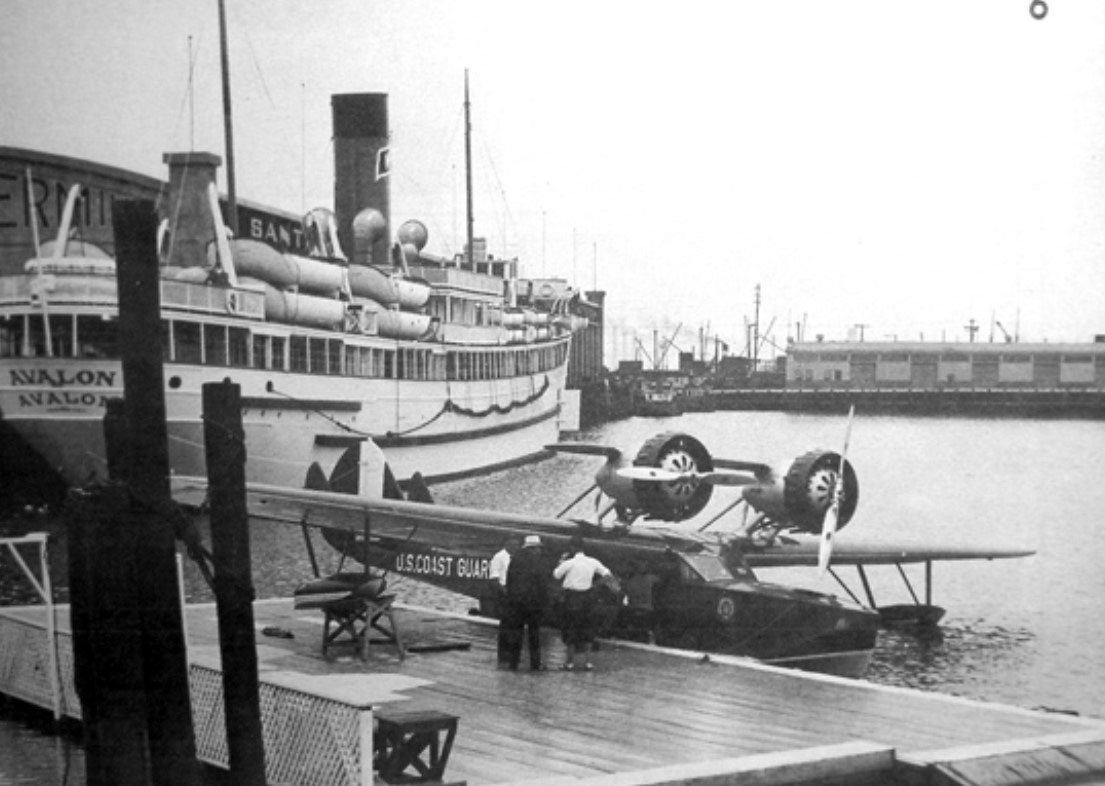 |
|
| (ca. 1930s)+# – View showing the S.S. Avalon docked in front of the Catalina Terminal. In the foreground is the US Coast Guard Douglas Dolphin seaplane. |
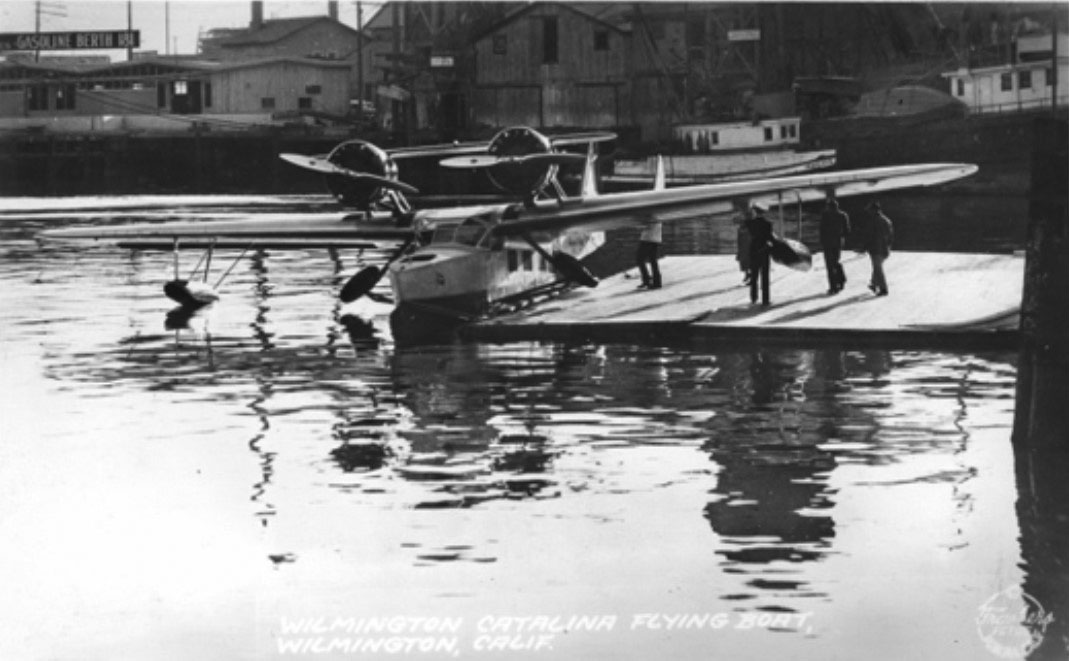 |
|
| (ca. 1930s)+# – Postcard view showing passengers preparing to board a Wilmington Catalina Flying Boat that will take them to Hamilton Cove on Catalina Island. |
Historical Notes In 1931, Philip Wrigley helped design a unique airport at Hamilton Cove, the second cove north of Avalon on Catalina Island. This airport was designed to accommodate the Douglas Dolphin amphibian planes of the Wilmington-Catalina Air Line, Ltd., a Wrigley-operated firm. The twin engine Dolphins landed just offshore and would taxi up a ramp to a large turntable mechanism. The airplane would then be rotated until it was facing the water and ready for a trip back to the mainland. A small Spanish-style terminal building welcomed residents, business people and tourists to Catalina.+# Click HERE to see views of the airport at Hamilton Cove, Catalina. |
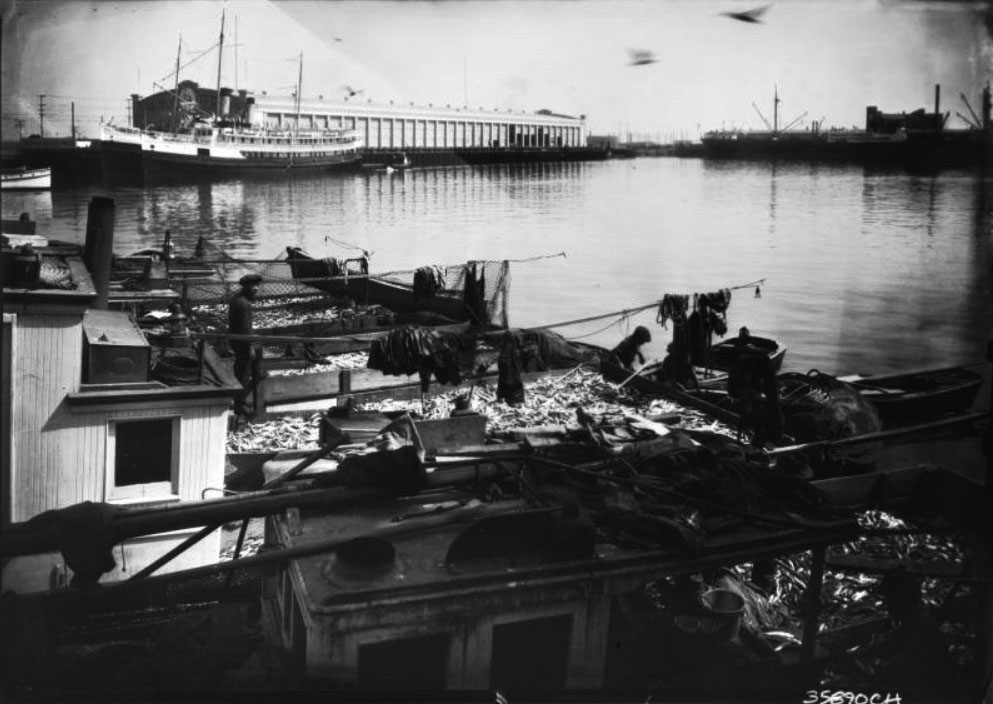 |
|
| (ca. 1930s)^^ – View showing docked boats filled with fish. A long building can be seen across the harbor towards the background. It has "Catalina Terminal” painted on it, while two large two-masted sailing ships can be seen in front of it. |
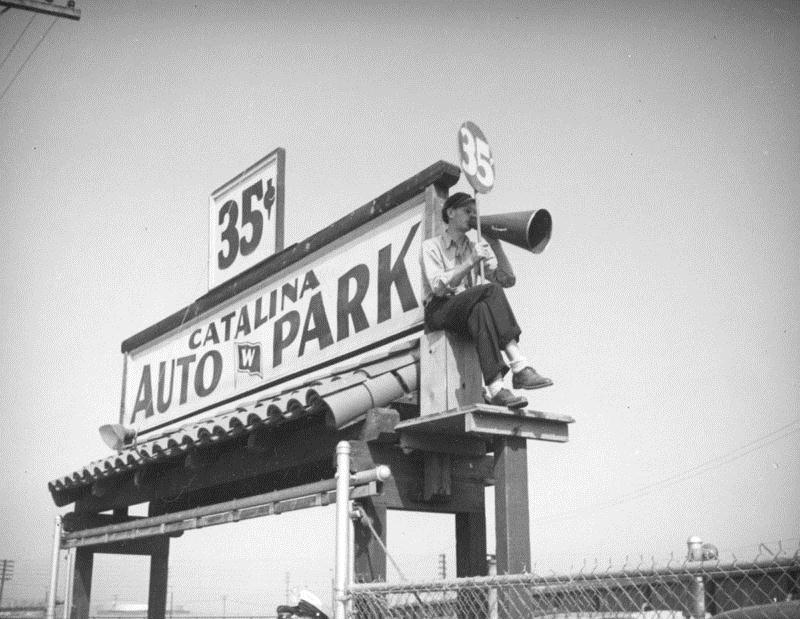 |
|
| (ca. 1938)* - It costs 35 cents to use the auto park for the S. S. Catalina terminal at the Port of Los Angeles. A parking lot attendant sits with a megaphone by the sign. |
Historical Notes In the late 1920's tourist traffic to the Catalina Island was increasing at the rate of 20% annually. In July, August and September of 1929, the S.S. CABRILLO, S. S. AVALON and S. S. CATALINA carried a combined total of 500,000 passengers. The 3 ships offered a total of 5 sailings daily each way.^^* |
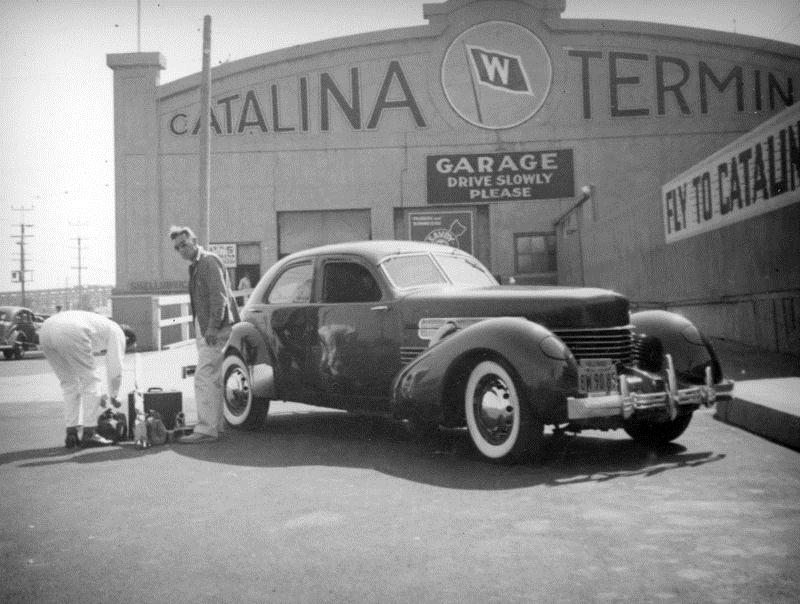 |
|
| (ca. 1938)* - An employee assists a man unload his luggage from his car (1936/37 Auburn Cord 812 Westchester) which he has stopped in front of the garage at the Santa Catalina Island terminal at the Port of Los Angeles. A sign suggests flying to Catalina. |
Historical Notes Cord was the brand name of an American automobile company from Connersville, Indiana, manufactured by the Auburn Automobile Company from 1929 through 1932 and again in 1936 and 1937.*^ |
 |
|
| (ca. 1938)* - People walk across the street to get to the Santa Catalina Island terminal at the Port of Los Angeles. Canopies cover two passenger entrance doorways. |
Historical Notes This building, located at the end of Avalon Boulevard, is now the site of a 1995 community center called Banning's Landing (101 East Water Street).* |
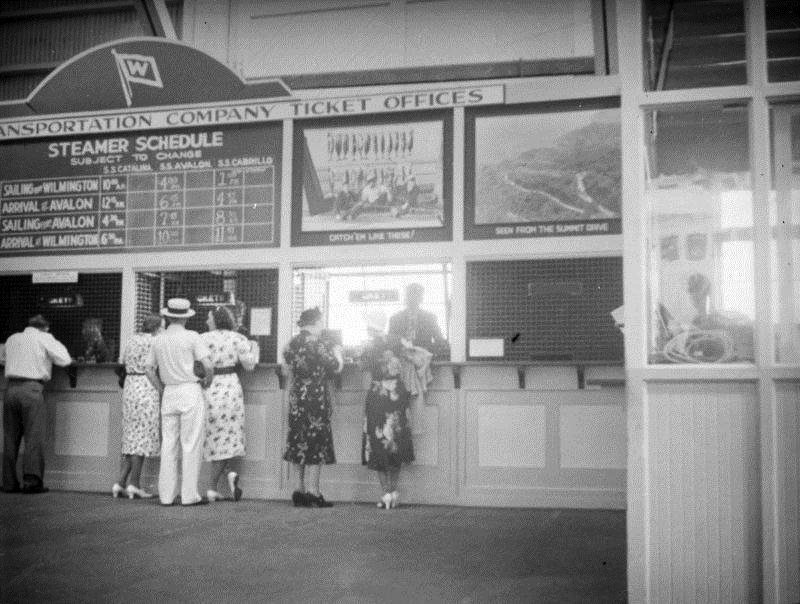 |
|
| (ca. 1938)* - People stand at a line of ticket offices in the Santa Catalina Island terminal at the Port of Los Angeles. |
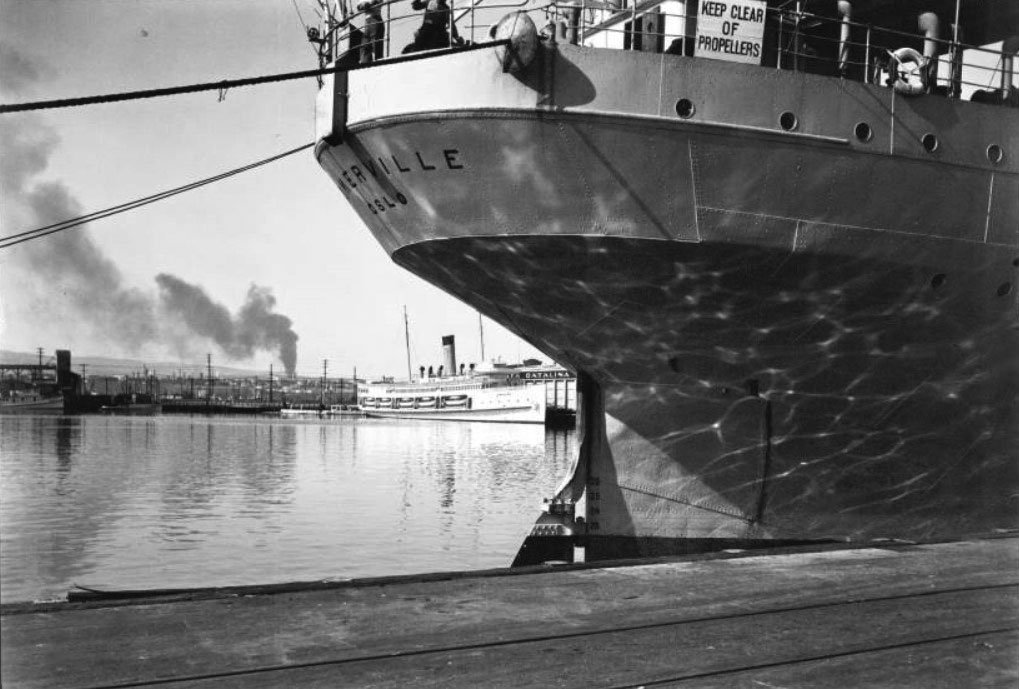 |
|
| (1934)^^ – View showing the hull of a ship against a dock in San Pedro Harbor. In the background can be seen another ship also docked. It is the S.S. Catalina (aka the Great White Steamer). |
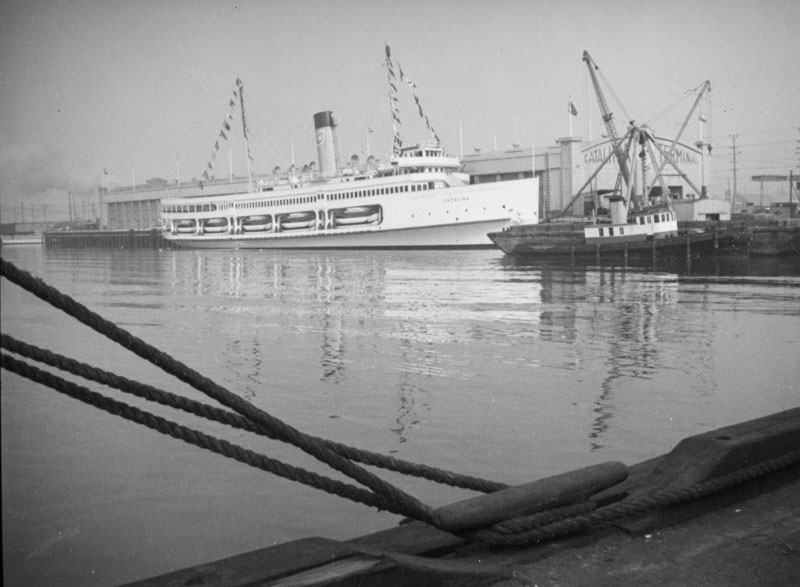 |
|
| (ca. 1938)* - View of the S.S. Catalina docked at the Los Angeles Harbor. |
Historical Notes Commonly referred to as the Great White Steamer, the ship was specially built by William Wrigley to serve his Catalina Island as a passenger ferry. She was christened on May 23, 1924. During World War II, she was requisitioned for use as a troop carrier, but in 1946 she resumed her voyages to Avalon.*^* |
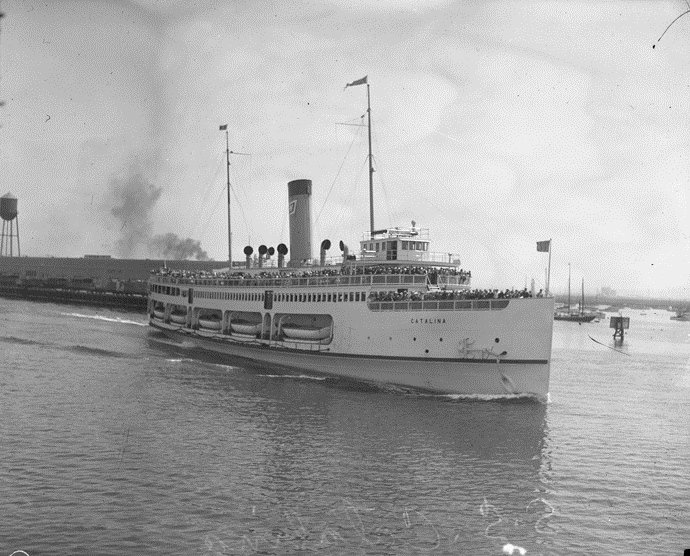 |
|
| (1924)^# - Side view of William Wrigley's steamship Catalina pulling off of pier with crowd of people on the decks. |
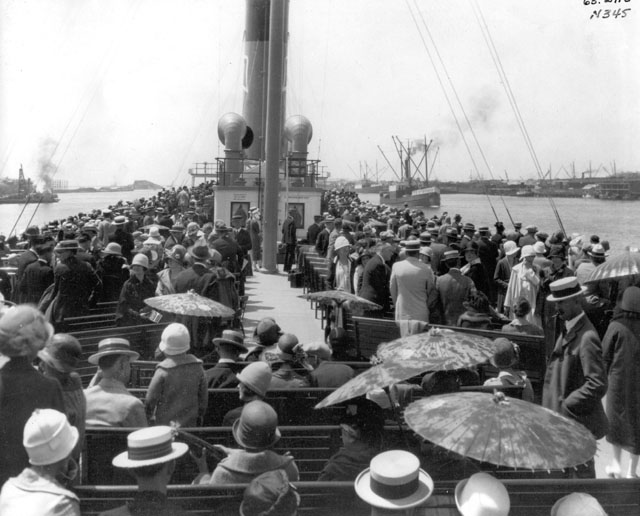 |
|
| (1920s)#**^ - Top deck of the S.S. Catalina filled with passengers as the steamer leaves the LA Harbor for its 23 mile juorney to Catalina Island. |
Historical Notes Among the passengers were movie stars and famous athletes who laughed, danced and drank their way to the island "26 miles across the sea." The S.S. Catalina even hosted 2 United States Presidents at different times. In those days, passengers dressed for the crossing. Gentlemen wore jackets and ties and the ladies dresses and coats, with some carrying umbrellas to protect them from the sun.^^* |
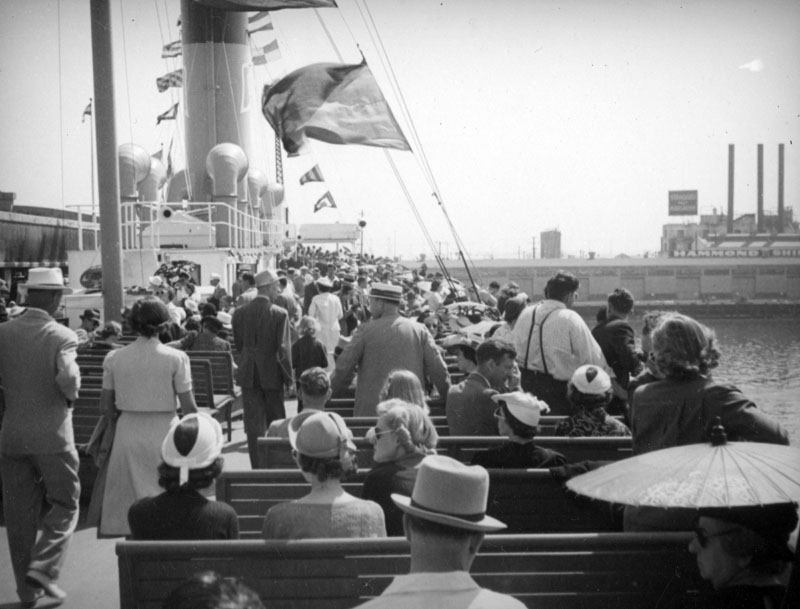 |
|
| (1930s)* - Some people stroll while others sit on board the S.S. Catalina. Hammond Shipping can be seen in the Port of Los Angeles on the right. |
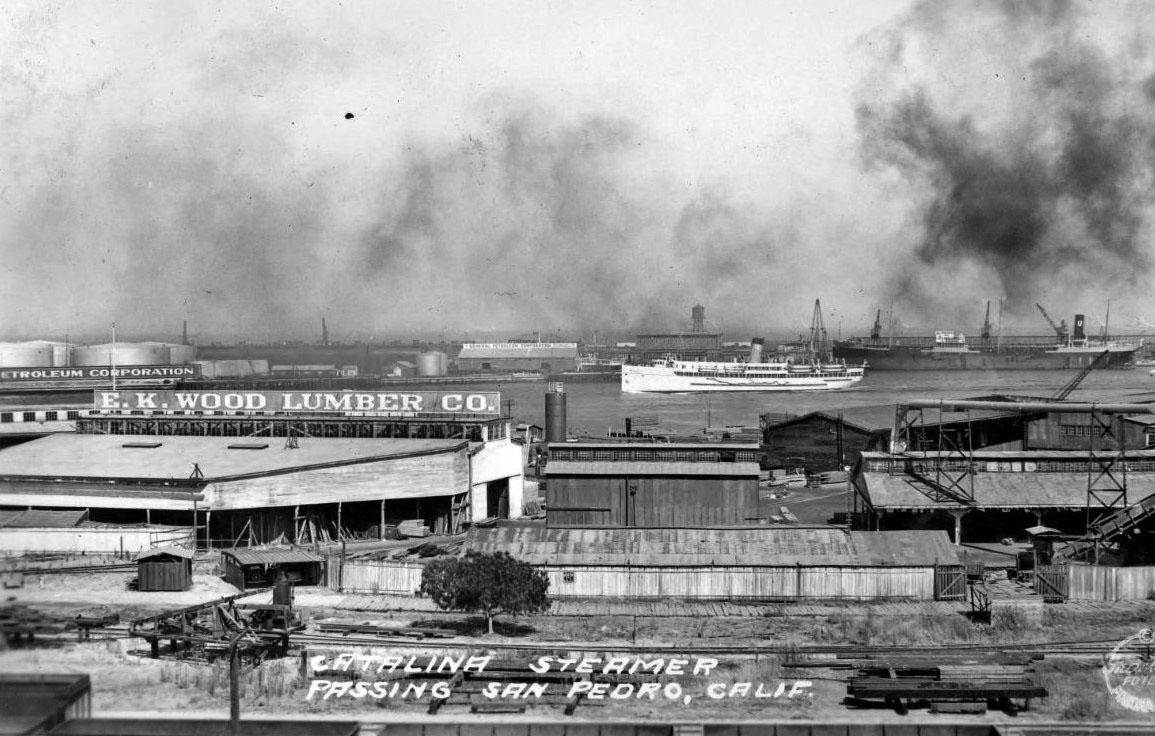 |
|
| (1937)^#^^ - Postcard view of the S.S. Catalina steamer passing San Pedro. |
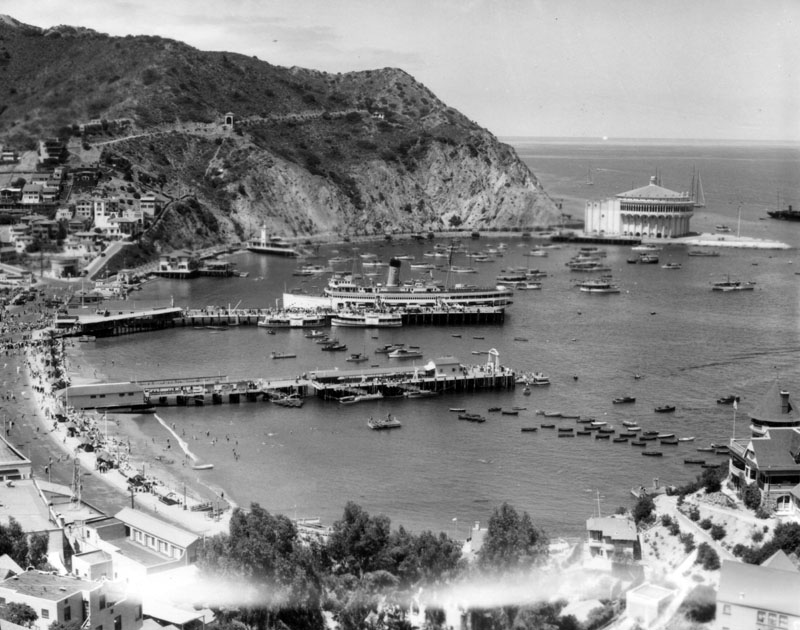 |
|
| (1920s)* - View of Avalon Bay across Crescent Bay, on Santa Catalina Island as seen from a mountain top. The Catalina Casino, surrounded by the sea on three sides, is visible at the edge of the bay on the right along with several boats along with the S.S. Catalina, "The Great White Steamer". |
Historical Notes The sons of Phineas Banning bought the island in 1891 from the estate of James Lick and established the Santa Catalina Island Company to develop it as a resort. In 1919, William Wrigley, Jr. bought out almost every share holder until he owned controlling interest in the Santa Catalina Island Company. The Wilmington Transportation Company which operated the boats between San Pedro and Catalina was now also owned by Wrigley. The S.S. Catalina was built under his direction in 1924.*^ |
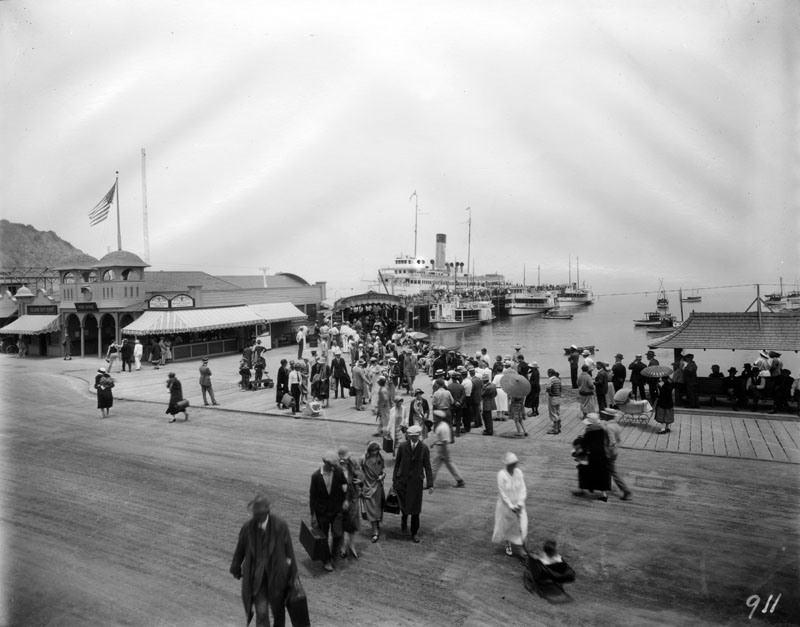 |
|
| (1920s) - View of the dock, or ferry slip, which is full of passengers that appear to be unloading out of the S.S. Catalina, nicknamed "The Great White Steamer". Dozens of people wait for these travelers, making a pathway for them to walk through. The Post Office and Island Gift Shop can be seen on the left, and several small boats are visible to the right of the wharf. |
Historical Notes The S.S. Catalina has been recognized as a Historic-Cultural Monument, No. 213 (Click HERE to see the LA Historic-Cultural Monuments List) and also California State Historic Landmark No. 894 (Click HERE to see more California Historic Landmarks in LA). She was listed on the National Register of Historic Places in 1976. |
Click HERE to see more in Early Views of Catalina |
Badger Avenue Bridge (later Henry Ford Bridge')
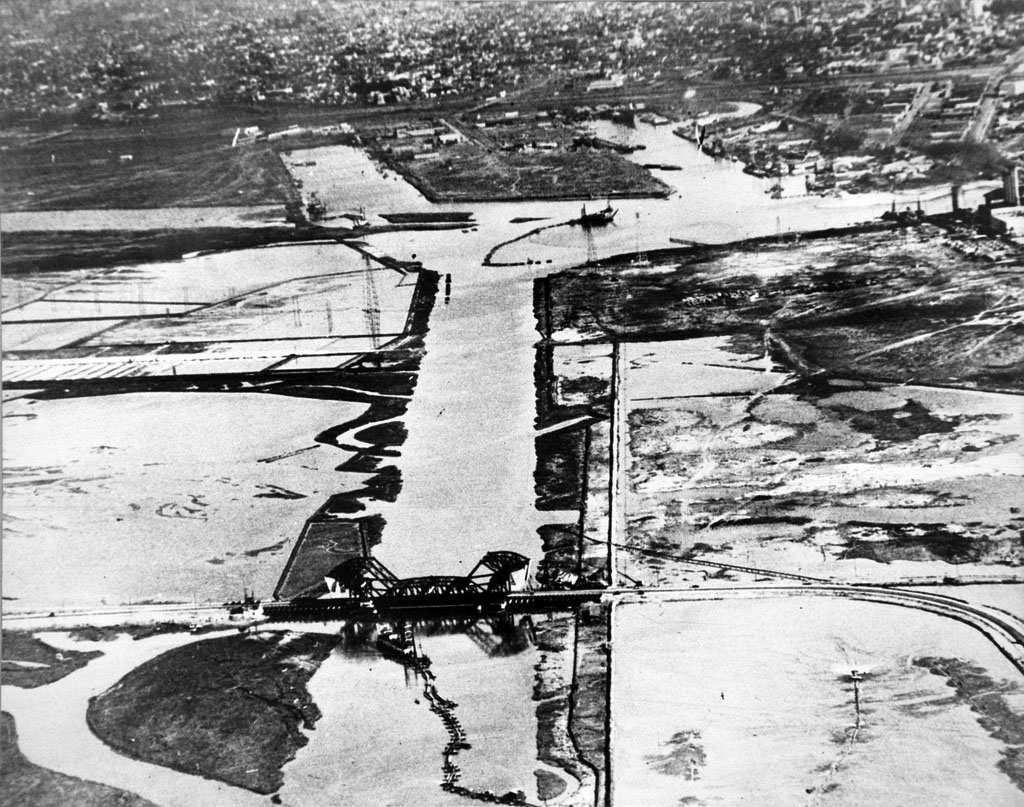 |
|
| (ca. 1924)#^ - Aerial view showing the bascule bridge connecting Terminal Island to the mainland. |
Historical Notes In the early part of the 20th century, Southern Pacific and Pacific Electric trains made their way to San Pedro using trestles to traverse the tidal waters that surrounded it. These railroad bridges made it impossible for ships to use the waterways, so in 1907 the U.S. War Department ordered that the trestles be replaced by drawbridges of the bascule type. The Badger bridge in the port of Los Angeles was originally constructed in 1924 and served as the only rail road link to Terminal Island. It was built to accommodate operations at the Ford Long Beach Assembly plant which opened in 1930 and was closed in 1959. |
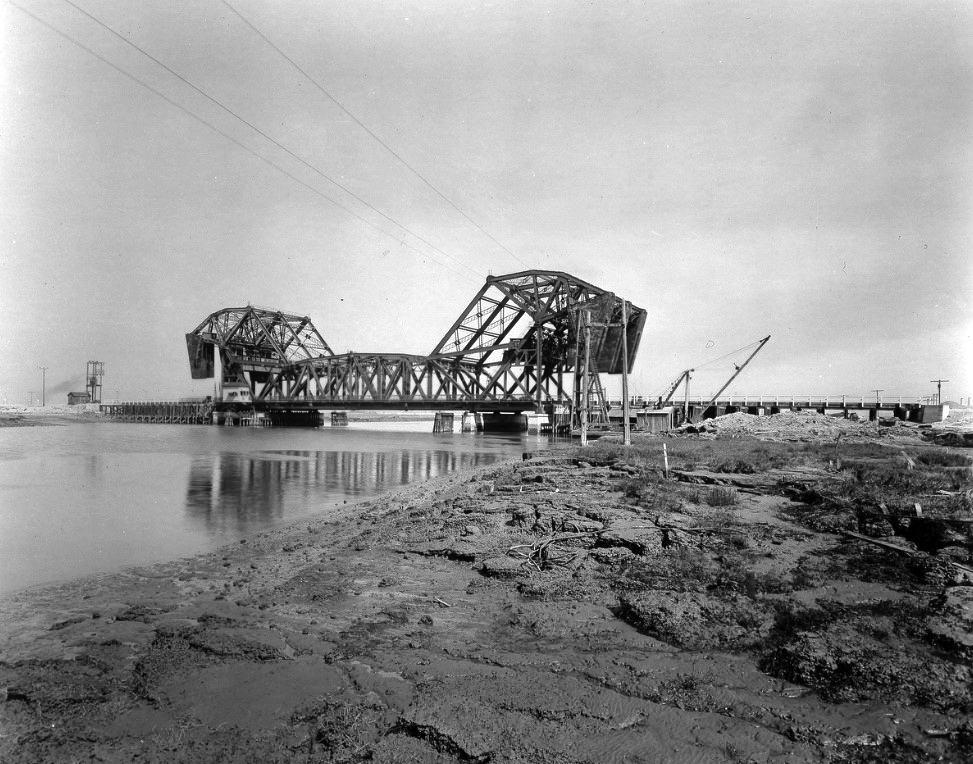 |
|
| (ca. 1924) - Ground view showing the Badger Avenue Bridge (later the Henry Ford Bridge). The name change occurred when the Ford plant was built next to the bridge in 1930. |
Historical Notes Southern Pacific’s engineering department designed the Strauss bascule bridge, named after the type of bascule designed by Chicago engineer Joseph Strauss, who would later design the Golden Gate Bridge. |
 |
|
| (1924)* – Badger Avenue Bridge in operation. |
Historical Notes A bascule bridge is a type of drawbridge that employs a counterweight to lift its center section so that ships can pass underneath. The first one was built in Russia in 1850, and they grew in favor among civil engineers because they could be opened quickly – San Pedro’s span took 50 seconds to raise - without using much energy. |
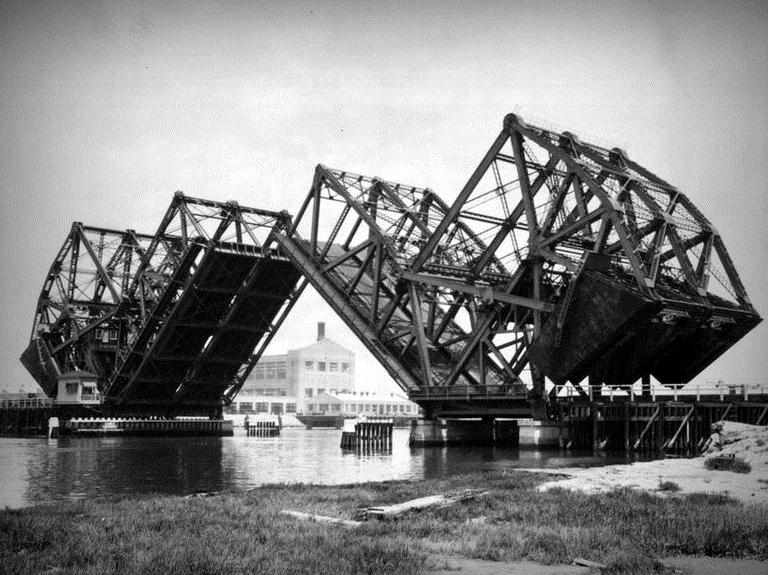 |
|
| (1930)^* - View of the Henry Ford Bridge (previously the Badger Ave Bridge) in operation. It was the largest bascule bridge in the world and connected Terminal Island to the mainland. It was sometimes referred to as the "Jacknife Bridge". The Ford Assembly plant can be seen in the background. |
Historical Notes Designed to carry two rail lines, two lanes of auto traffic and a pedestrian lane this bridge was 70 feet wide. It was reported to be the largest and heaviest of its kind in the world. The bridge is a trunnion bascule bridge. It was designed by the master of trunnion bascule bridge design, Joseph B. Strauss who also was the chief engineer for the Golden Gate Bridge. One of the rail lines on the bridge was a trolley line which was removed in the 1940's. |
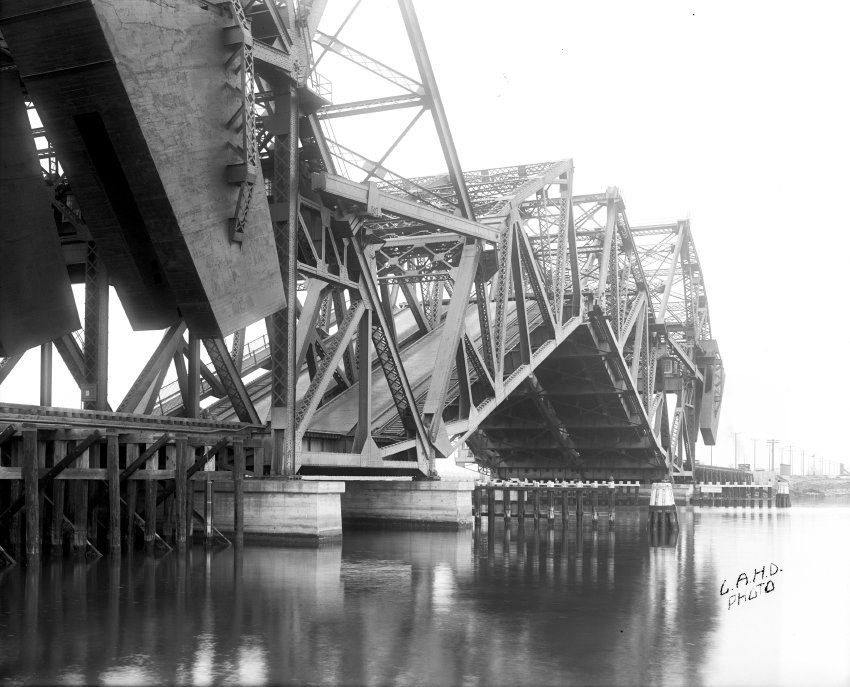 |
|
| (1928)* – Badger Bridge aka “Jacknife Bridge”. Photo courrtesy of LA Harbor Department |
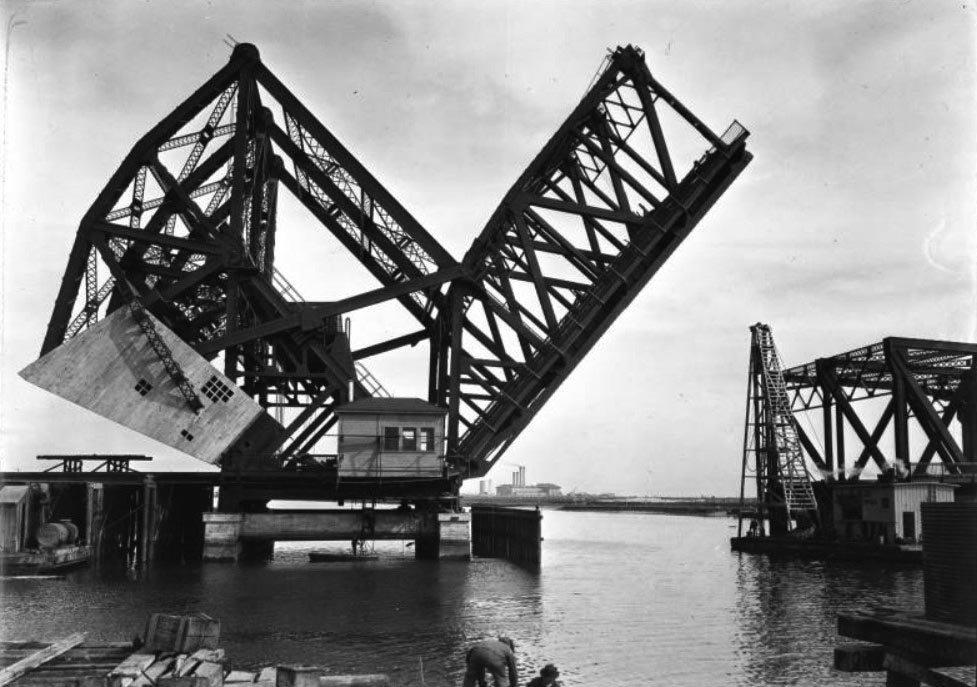 |
|
| (1924)* - Photograph of the Bascule Bridge opening over the Los Angeles Harbor with a boat passing underneath. The bridge can be seen at center at an angle over the water. A small building with three rectangular windows is visible in front of the bridge. A similar second building is visible across the water at right. Metal beams can be seen behind the second building. Two workers can be seen in the foreground. A building with several smokestacks can be seen in the background beyond the water. Back of photoprint reads: "Terminal Island to Mainland". |
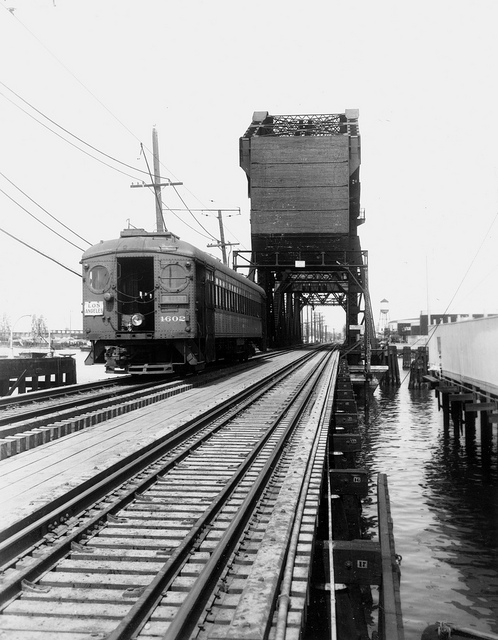 |
|
| (ca. 1945)^#^ - View of Pacific Electric Railway Company’s car no. 1602 on the Bascule Bridge heading towards San Pedro. |
Historical Notes The San Pedro line used the bascule bridge for decades to bring passengers to and from the Harbor Area. The alternate West Basin Line had to be used during World War II, when the Coast Guard ordered that the bridge remain in the open position as a security measure. |
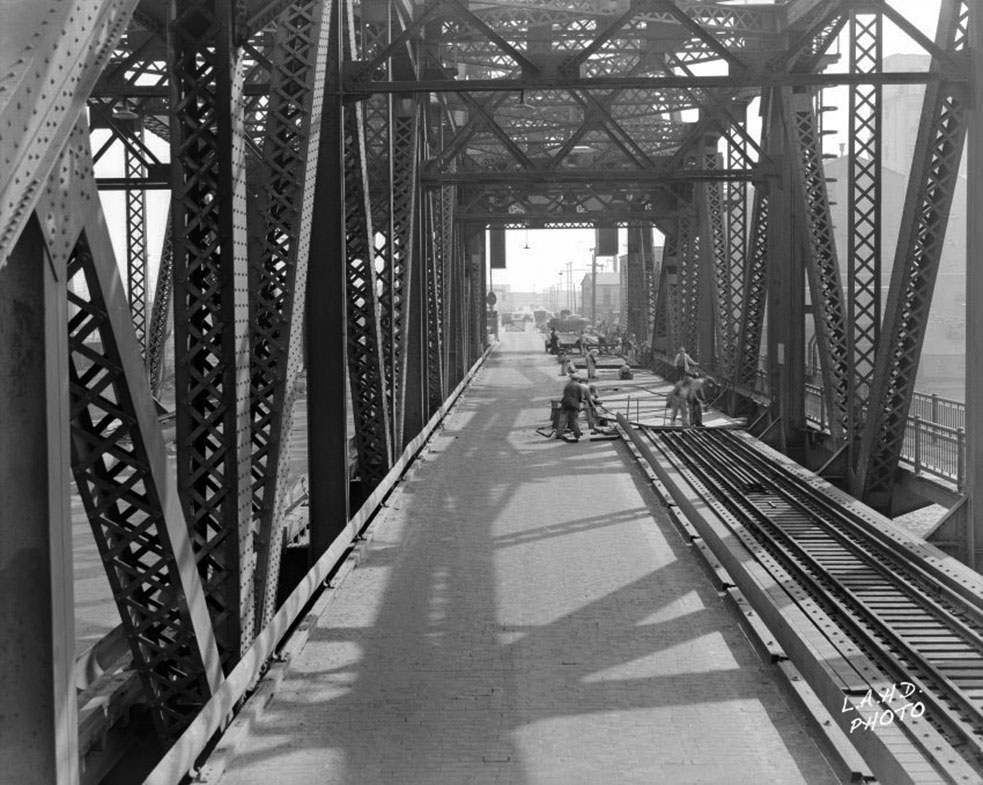 |
|
| (ca. 1945)* – View looking north from Badger (Henry Ford) Avenue, and the re-establishment of one side of the road as a vehicular artery. |
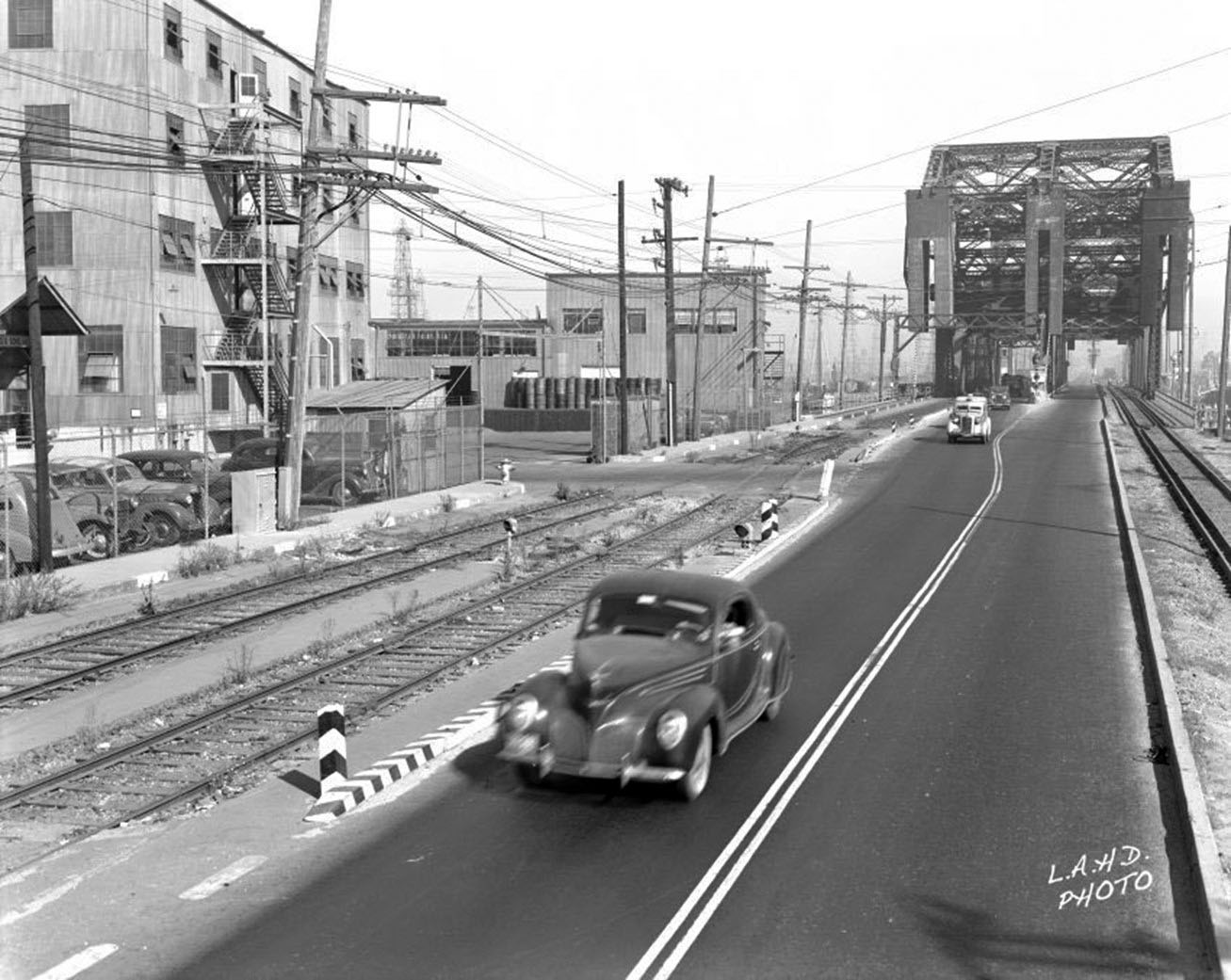 |
|
| (1945)* - View showing Badger Avenue (Henry Ford Avenue) and the manner in which street cuts were made to accommodate the rail line crossing the bridge. Photo taken from the top of a car on the East side of the road, opposite the Spencer Kellogg southern entry gate. |
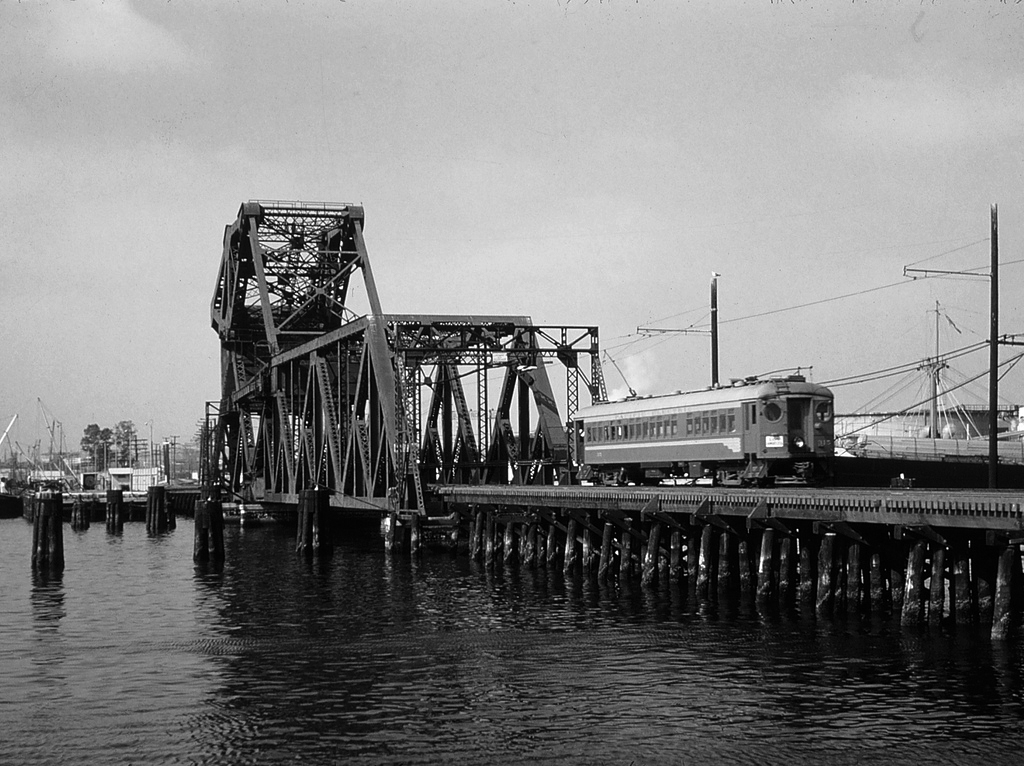 |
|
| (1953)^#^ – View showing a Pacific Electric Red Car near the San Pedro bascule bridge. |
Historical Notes As ridership on the Red Cars began to decrease due to the growing use of buses and personal automobiles following the war, an unfortunate accident occurred that led to the demise of the bascule bridge. On Sept. 28, 1955, a passing ship rammed into the bridge’s counterweight hinge mechanism, damaging it beyond repair. Passengers had to use the West Basin Line, which took about 10 minutes longer. The bridge could not be saved. It was deconstructed shortly thereafter, its iron sold for scrap. The original 1924 bascule bridge was dismantled and replaced in 1996 by a vertical-lift bridge. |
Schuyler Heim Bridge
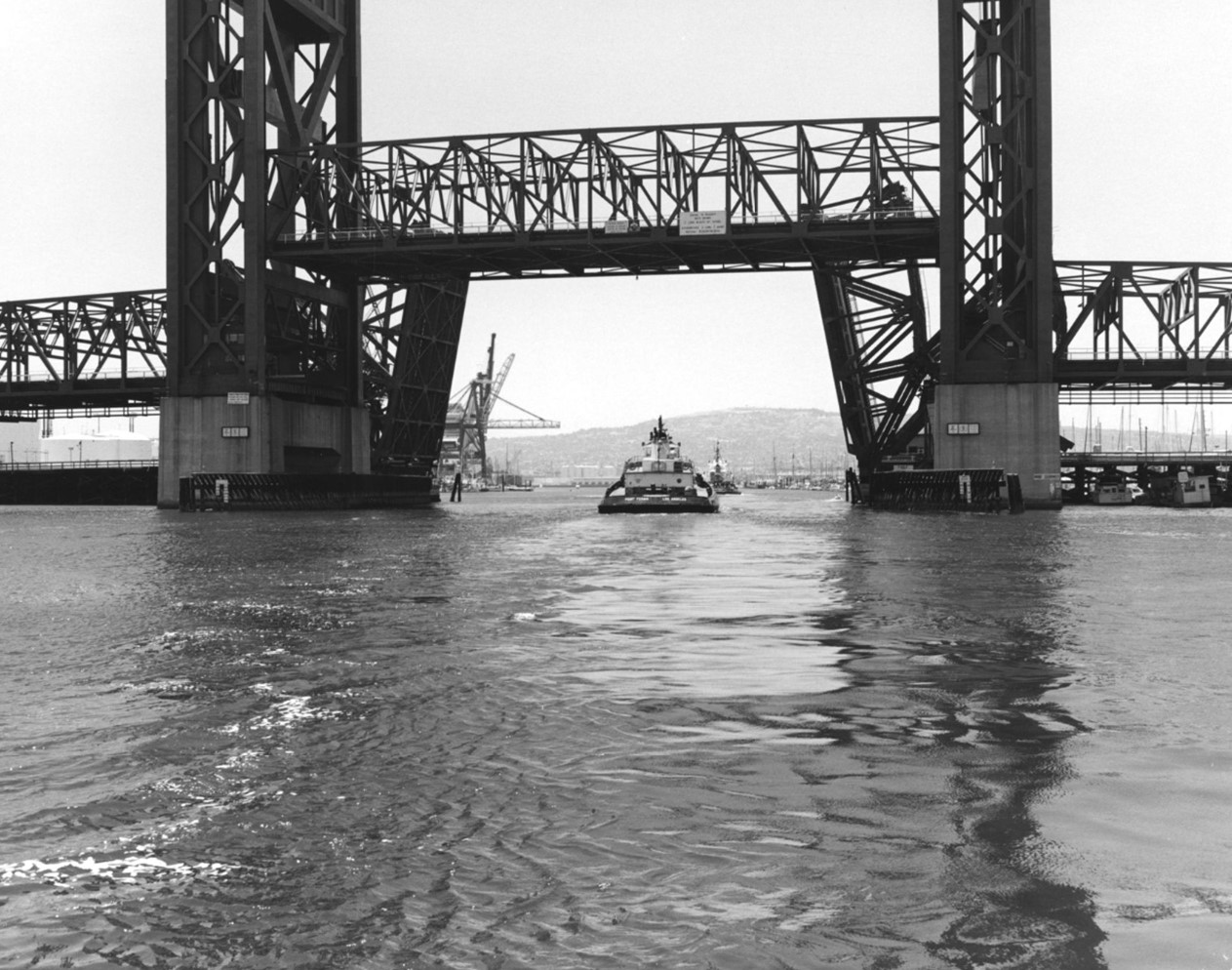 |
|
| (1988)* - View of the Schuyler Heim Bridge connecting Wilmington and Terminal Island, with the tugboat Point Fermin passing under the raised roadbed. The hills of Palos Verdes are visible in the distance. Photo by William Reagh. |
Historical Notes The Commodore Schuyler F. Heim Bridge has a significant history in the Port of Los Angeles area. The original bridge (seen above), dedicated on January 10, 1948, was a vertical-lift bridge constructed over the Cerritos Channel by the U.S. Navy from 1946 to 1948. It allowed State Route 47 (Terminal Island Freeway) to cross the channel and was named after Schuyler F. Heim, who commanded the Naval Air Station on Terminal Island in 1942. At the time of its opening, it was one of the largest vertical-lift bridges on the West Coast and the highest in the country. The bridge's deck weighed about 820 short tons and was supported by towers 186 feet tall above the roadway deck. |
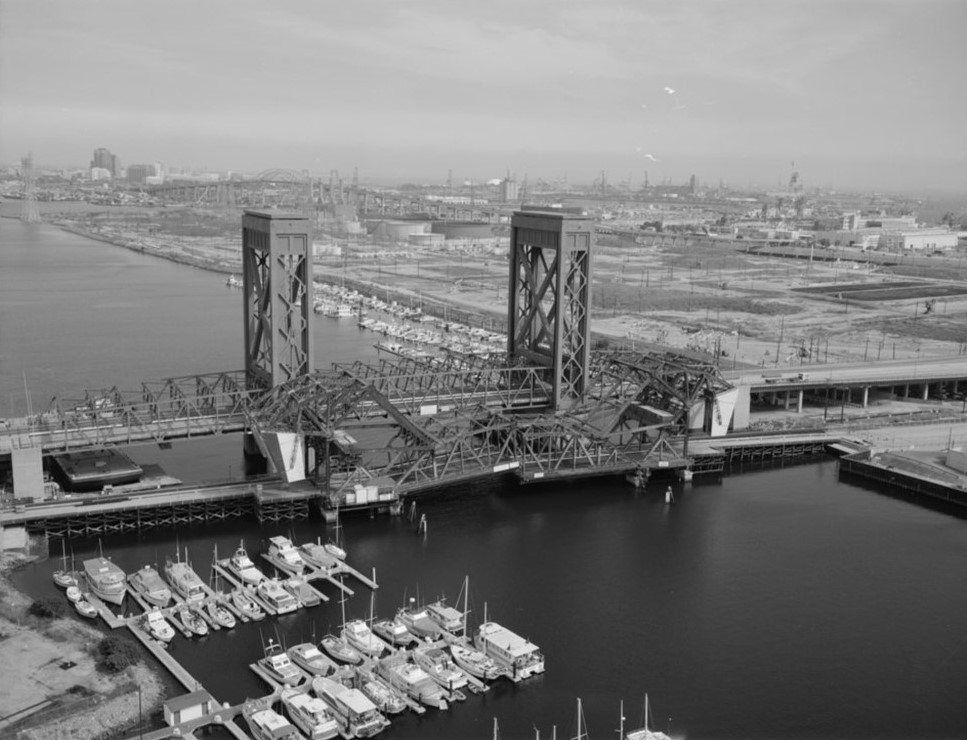 |
|
| (1994)* - Henry Ford Bridge (1924) in foreground, Schuyler Heim Bridge (1948) in background. Photo by Bruce Eckar via Wikipedia. |
Historical Notes The bridges span the Cerritos Channel in the Port of Los Angeles, connecting Terminal Island to the mainland. The Henry Ford Bridge (Badger Avenue Bridge) carried rail traffic, while the Schuyler Heim Bridge carried vehicular traffic. |
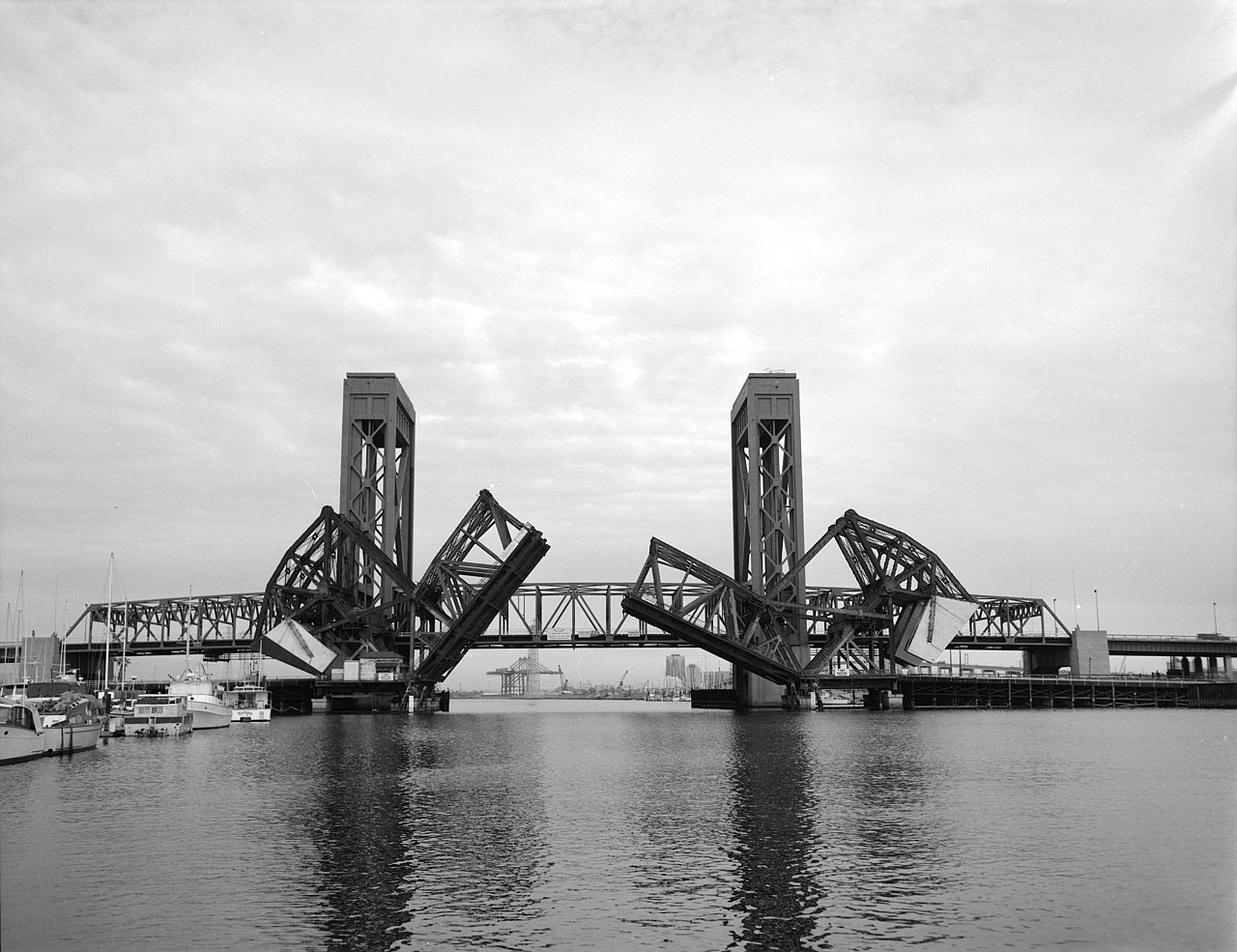 |
|
| (1994)^ - The 1924 Henry Ford Bridge (Badger Ave Bridge) in the half-closed position with the Schuyler Heim Bridge (1948) in background. Photo by Bruce Eckar. |
Historical Notes The original Schuyler Heim Bridge, which served the area for nearly 70 years, was decommissioned on October 12, 2015, and demolished in 2016. It was replaced by a new fixed-span concrete bridge designed to meet current seismic and safety standards. The new Schuyler Heim Bridge, which opened to traffic in September 2020, features seven lanes, including a southbound auxiliary lane and standard emergency shoulders. It remains a vital link for goods movement between Terminal Island and the mainland, now enhanced with improved safety and seismic resilience. The original Henry Ford Bridge, also known as the Badger Avenue Bridge, was a double-leaf bascule railroad bridge constructed in 1924. Serving as a crucial transportation link for rail traffic across the Cerritos Channel, the bridge was dismantled in 1994 and replaced by a new vertical-lift bridge, which opened in 1996. This bridge continues to facilitate rail traffic in the Los Angeles-Long Beach Harbor area, retaining the name "Henry Ford Bridge. |
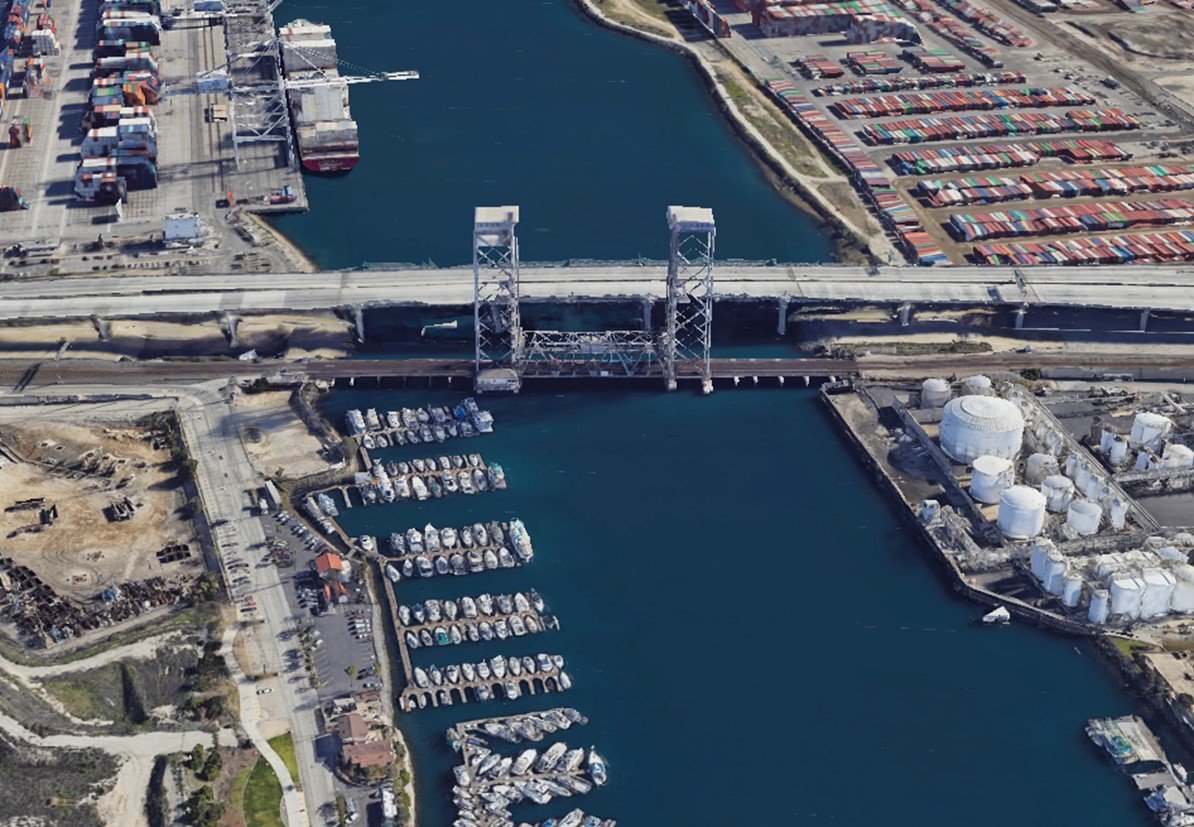 |
|
| (2024)* - Google Earth view showing the new Henry Ford Bridge and the Schuleyr Heim Bridge behind it. |
Historical Notes The Henry Ford Bridge and Schuyler Heim Bridge have been vital to the Port of Los Angeles, enabling the movement of goods, vehicles, and rail traffic between Terminal Island and the mainland. These bridges supported the port's growth into a major global facility, with the Henry Ford Bridge playing a key role in the early expansion of the Los Angeles-Long Beach Harbor. Both bridges were replaced to meet increasing demands— the Henry Ford Bridge in 1996 for modern rail traffic and the Schuyler Heim Bridge in 2020 for enhanced vehicle traffic. These upgrades improved safety and efficiency, further contributing to the region's economic growth by ensuring reliable transportation links for one of the world's busiest ports. |
* * * * * |
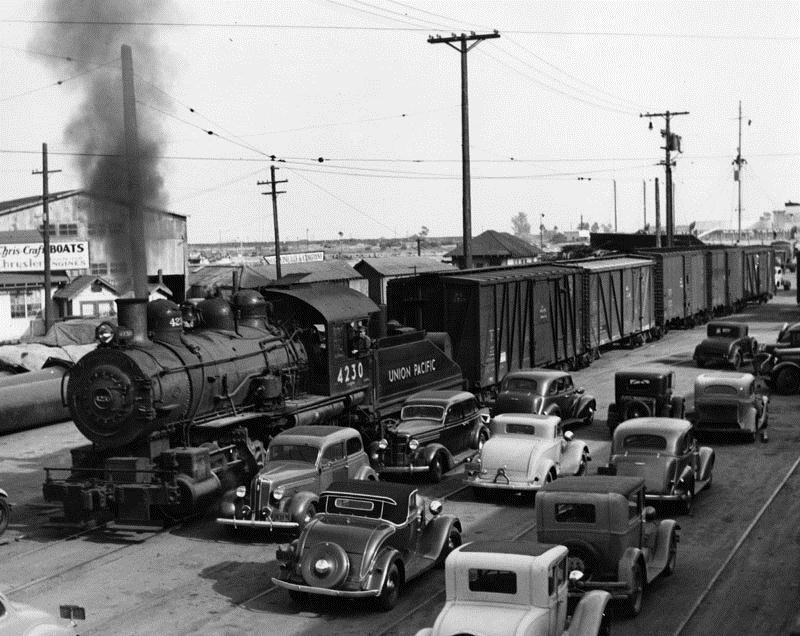 |
|
| (ca. 1935)* - Union Pacific Engine 4230 travels between parked cars at Wilmington Harbor. |
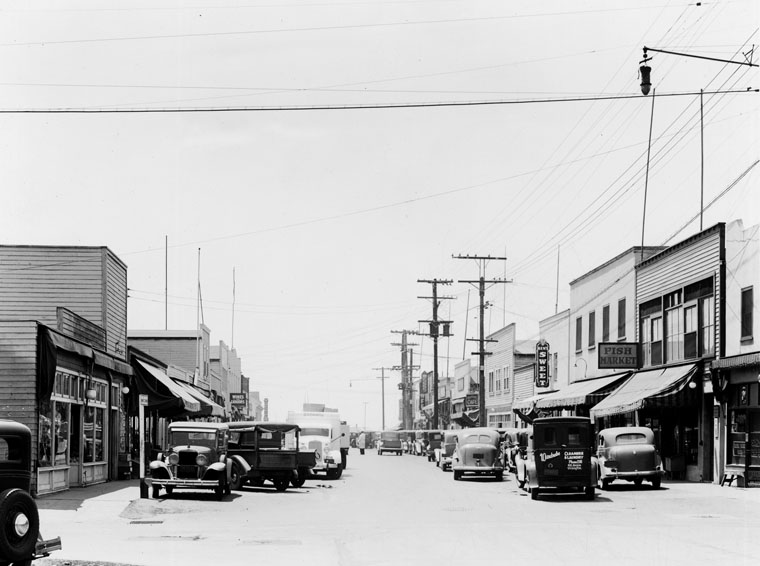 |
|
| (ca. 1935)* - Fish harbor business district on north end of Terminal Avenue. Street is lined with cafes. |
San Pedro High School
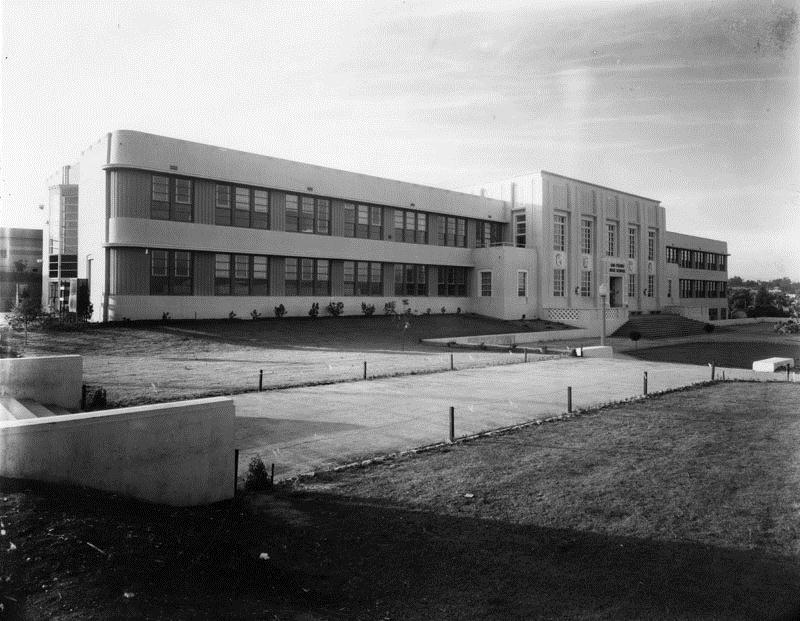 |
|
| (ca. 1936)* - Exterior view of the front entranceway to San Pedro High School. Location: 1001 West 15th Street |
Historical Notes San Pedro High School is home to two protected landmarks, the Administration Building and Language Arts Building. Both were constructed in 1936 under mandate from the Works Progress Administration. San Pedro High School also has a Mathematics and Sciences Building, a Vocational Arts Building, a cafeteria, numerous bungalow-style classrooms, and three gymnasiums. In 2003, San Pedro High School celebrated its 100th Anniversary.*^ |
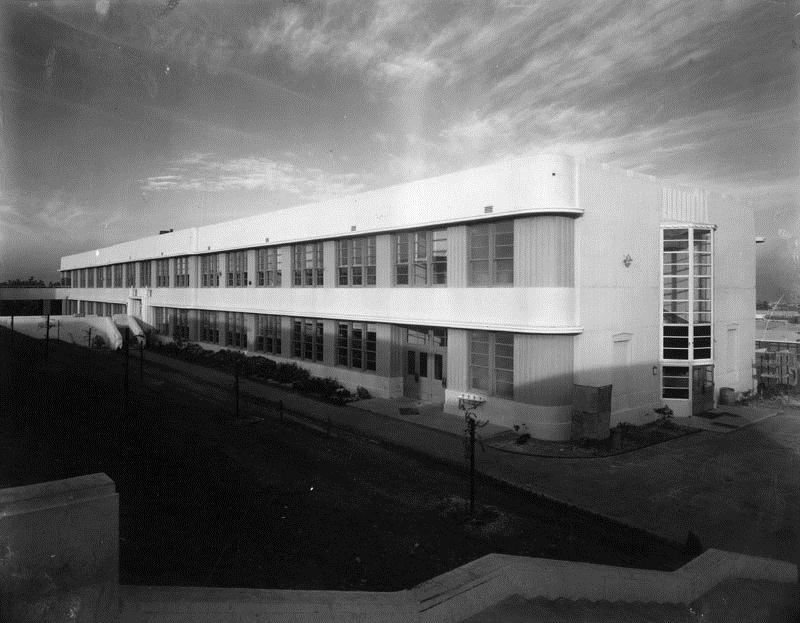 |
|
| (ca. 1936)* - Exterior view of the backside of the main building of San Pedro High School. |
Historical Notes San Pedro High School and the surrounding area is where much of the filming for Some Kind of Wonderful was done.*^ |
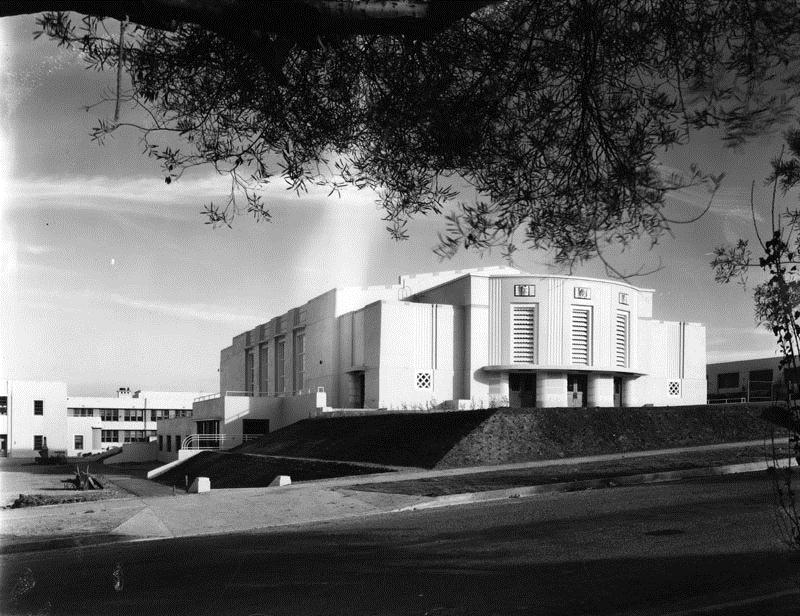 |
|
| (ca. 1936)* - View of San Pedro High School's auditorium. Rear of main building can be seen in the background. |
Historical Notes In the San Pedro High School Library the murals called “Industrial Life in San Pedro” were painted by Thomas Tyrone Comfort in 1937. The murals are oil on canvas. It consists of nine panels, four are 4x8 feet and five are 10x8 feet. He was an FAP, Federal Arts Project muralist and illustrator. Very few examples of his work exist because he died at the age of thirty in 1939. However some of his work resides in the White House.***# |
* * * * * |
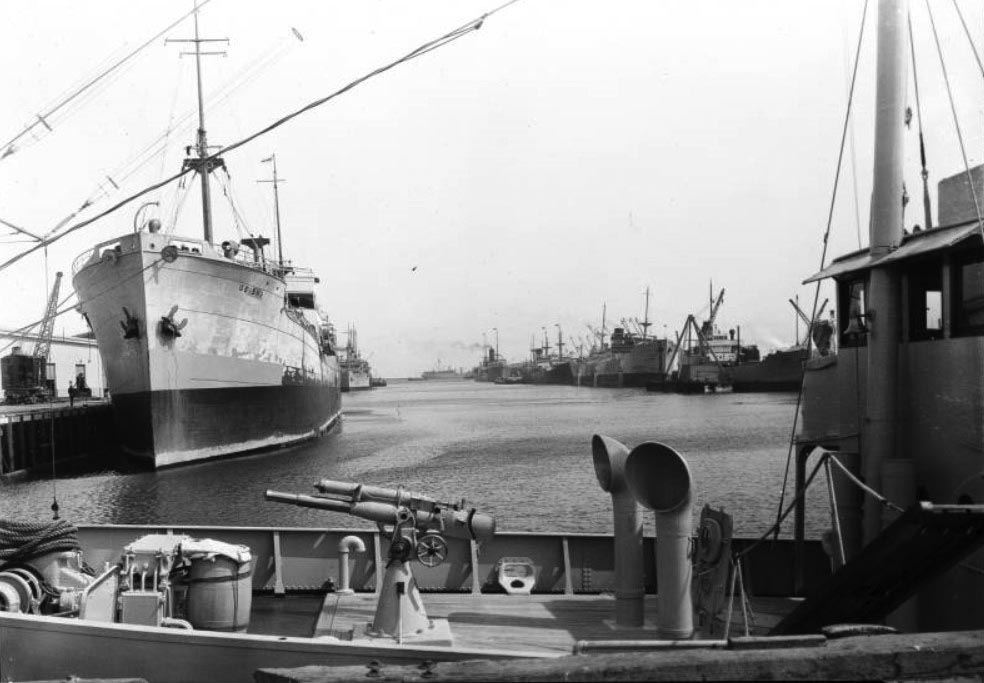 |
|
| (1929)^^ - View of Los Angeles Harbor showing ships at outer dock across deck of a Revenue Cutter showing guns. A large boat with two masts can be seen at left while docked to a wharf. Ships of various sizes are docked behind the one on left while more can be seen at right. The ripples in the water of the harbor can be seen next to the ships. |
Historical Notes The Coast Guard began as the Revenue Cutter Service which was founded on August 4, 1790 as part of the Department of the Treasury. An act of the U.S. Congress created the Coast Guard in 1915, with the merger of the Revenue Cutter Service and the United States Lifesaving Service. The US Lighthouse Service was merged into the Coast Guard in 1939. The legal basis for the Coast Guard is Title 14 of the United States Code, which states: "The Coast Guard as established January 28, 1915, shall be a military service and a branch of the armed forces of the United States at all times." During wartime, the Coast Guard reports to the Department of Defense. The Coast Guard later moved to the Department of Transportation in 1967, and on March 1, 2003 it became part of the Department of Homeland Security.*^ |
 |
|
| (1931)* - Transferring mail from a ship to the Goodyear Blimp in Los Angeles Harbor.^ |
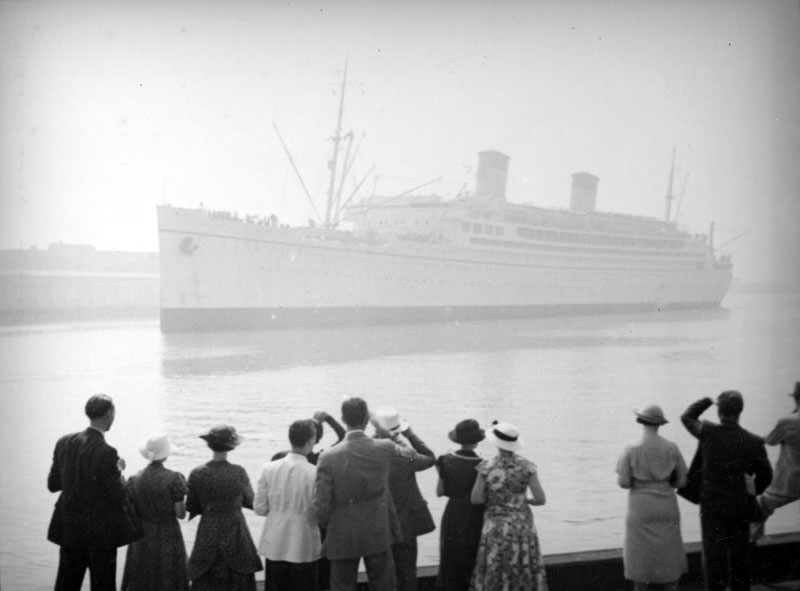 |
|
| (ca. 1937)* - People stand on the dock at the Los Angeles Harbor watching the S. S. Monterey arrive. Photo by Herman Schultheis |
Historical Notes The S.S. Monterey was a luxury ocean liner launched on October 10, 1931. It was one of four ships in the Matson Lines "White Fleet" which included SS Malolo, SS Mariposa and SS Lurline. Monterey, the third of four Matson ships designed by William Francis Gibbs was identical to Mariposa and very similar to her sister ship Lurline. |
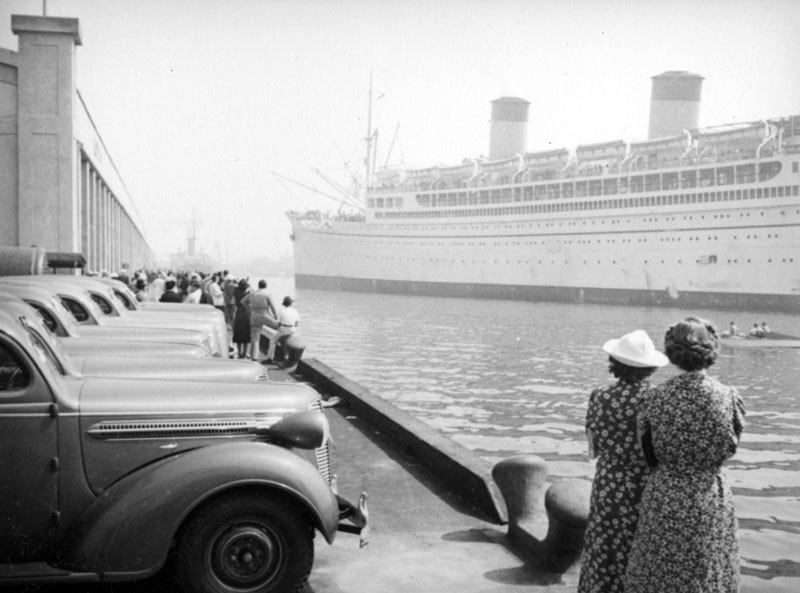 |
|
| (ca. 1937)* - Two women stand by a line of waiting cars watching the S. S. Monterey move into dock at berth 156 at the Los Angeles Harbor in San Pedro. Photo by Herman Schultheis |
Historical Notes Monterey was built to promote travel to Hawaii and for Pacific Ocean liner service including regular stops in ports along the West Coast of the United States, Samoa, Fiji, New Zealand and Australia. On 12 May 1932 she took 83 passengers from New York City to the West Coast on a positioning cruise. Her maiden voyage officially began 3 June 1932 in San Francisco, California after which she made stops in Los Angeles, Honolulu, Auckland, Pago Pago, Suva, Sydney and Melbourne. She scored a public relations triumph when she carried much-appreciated supplies to the Bear of Oakland on Byrd's second expedition to the South Pole. In World War II Monterey served as a fast troop carrier, often operating alone so she would not be slowed by formation navigation in a convoy. The United States Maritime Commission chartered her in 1941 before the US declaration of war to carry 150 Chinese, Korean and Japanese missionaries and stranded US citizens back to San Francisco. Once home, she was quickly refitted to hold 3,500 soldiers. On December 16, 1941 she steamed to Hawaii with 3,349 fresh troops, returning with 800 casualties of the attack on Pearl Harbor.*^ |
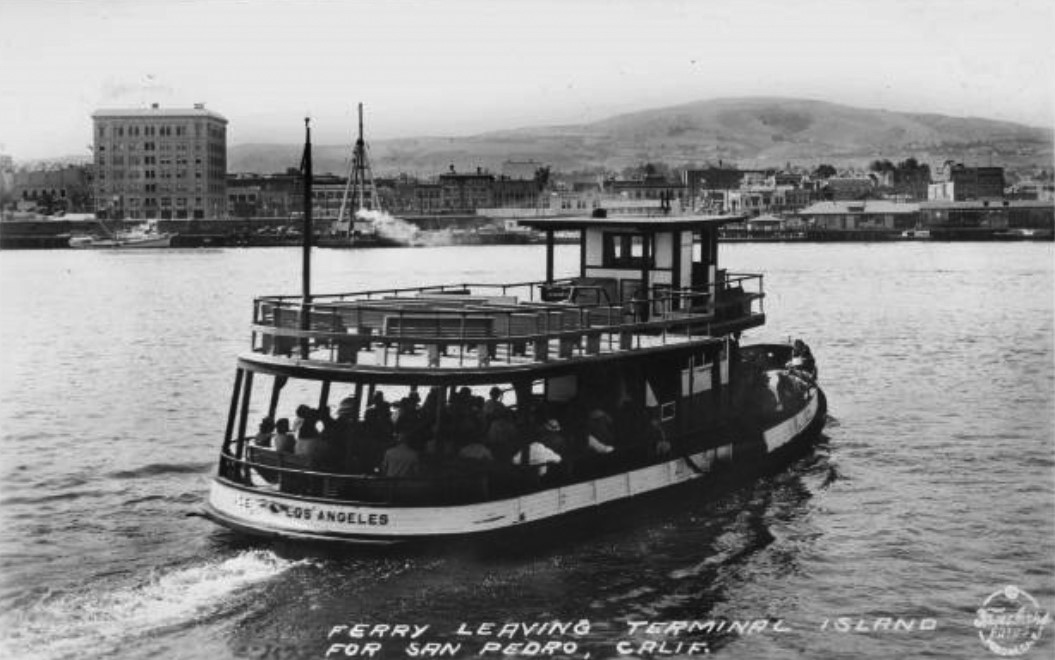 |
|
| (1937)**** - Postcard view showing a ferry leaving Terminal Island for San Pedro. |
Historical Notes Before the Vincent Thomas Bridge was completed in 1963, ferries transported thousands of passengers and vehicles to and from the canneries and military bases on Terminal Island.*^ |
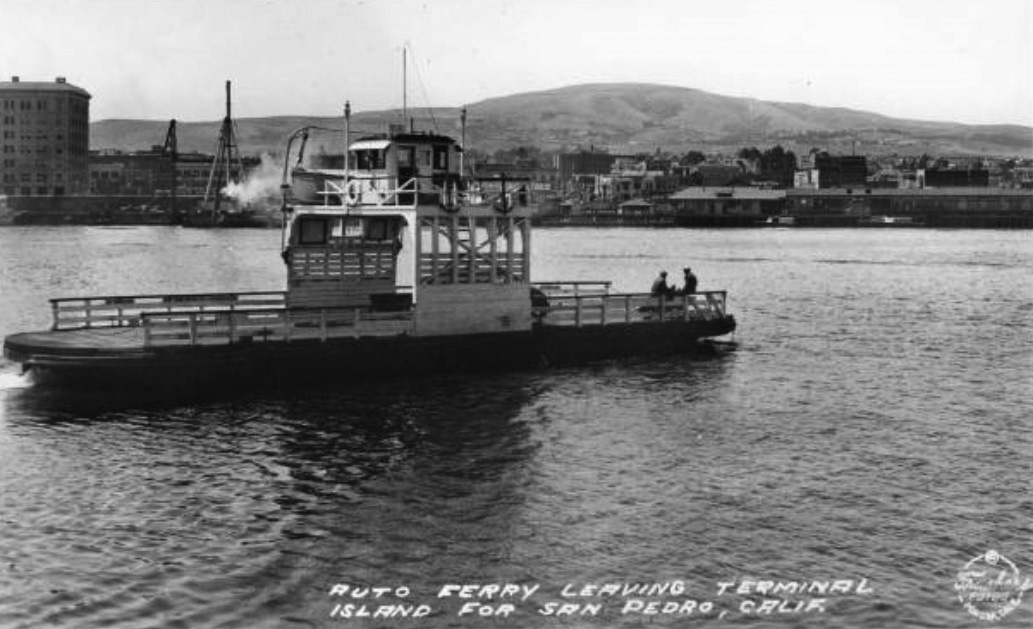 |
|
| (1937)**** - Auto ferry leaving Terminal Island for San Pedro carrying only one car. Two men are seen in front of the ferry, one appearing to be sitting on a motorcylce. |
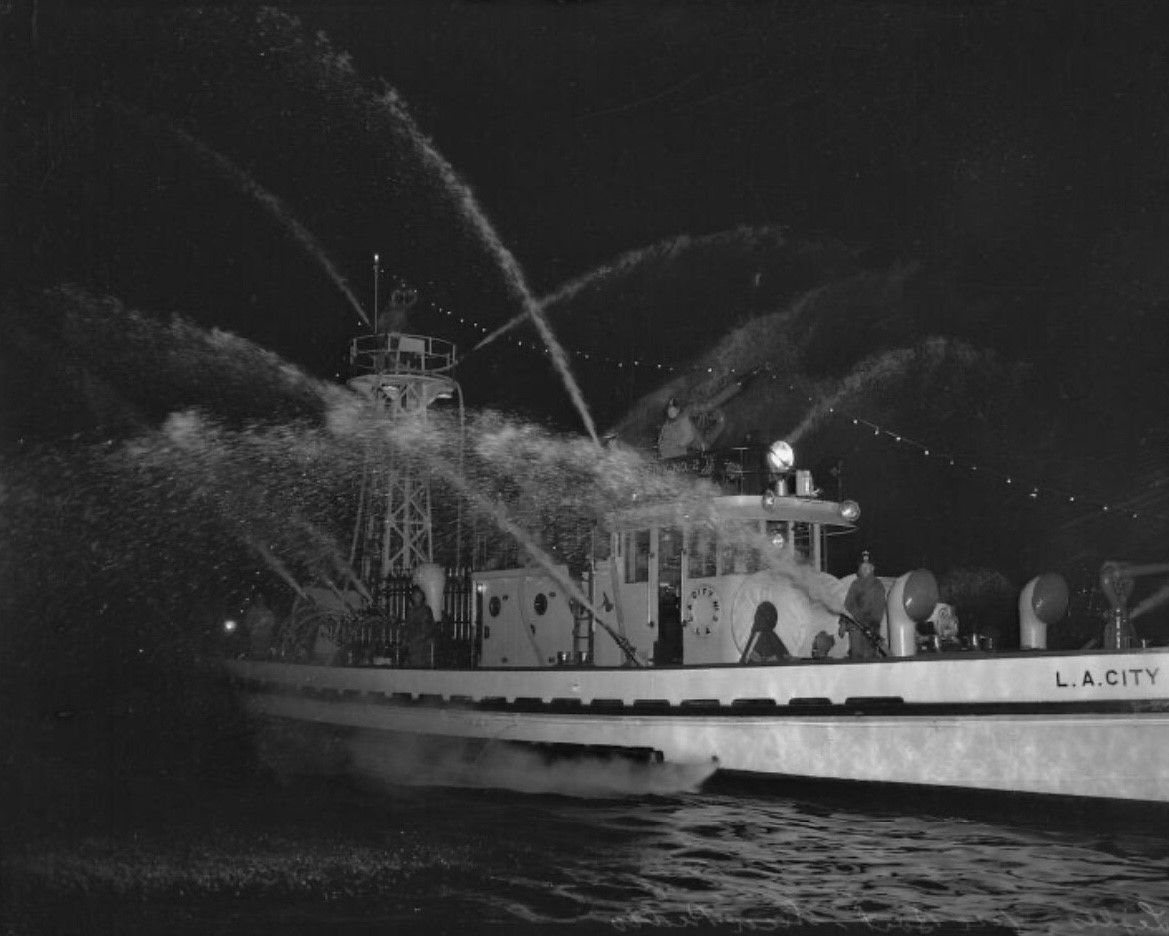 |
|
| (1935)* - LAFD Fireboat, San Pedro. |
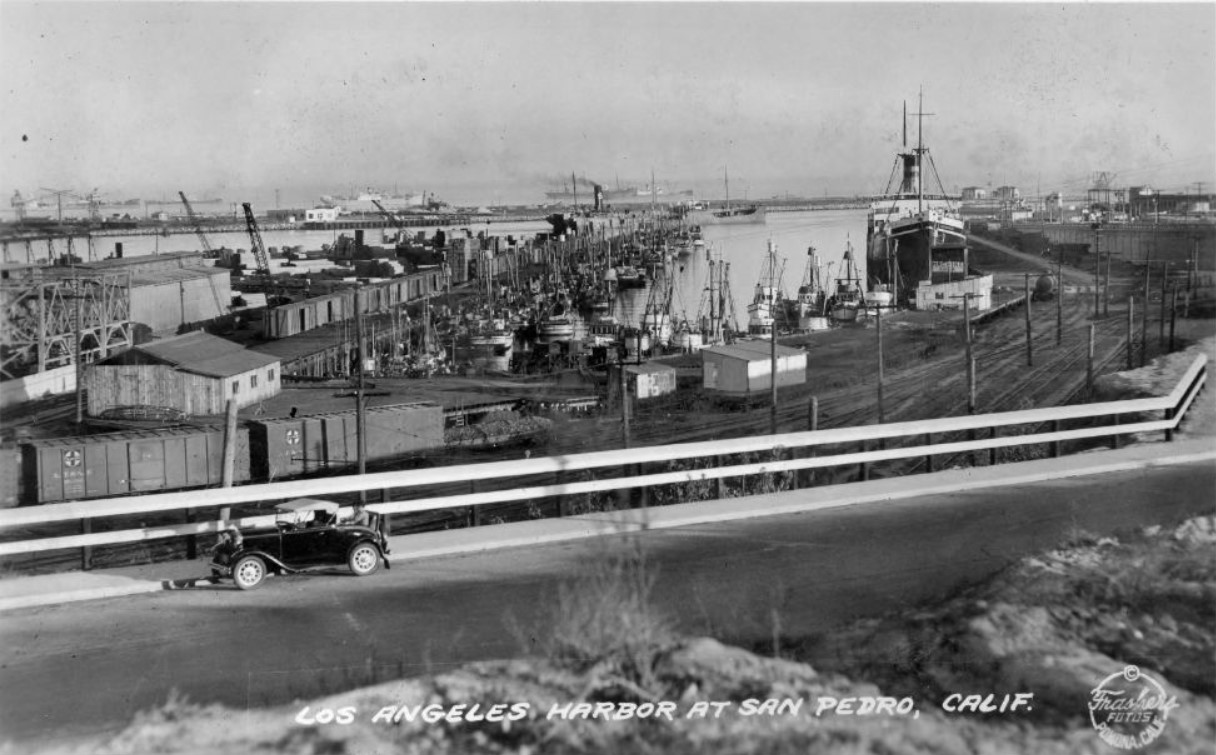 |
|
| (1938)^#^^ - Postcard view showing an early model car with two people sitting in the rear rumble seat, parked along a rail overlooking the Los Angeles Harbor at San Pedro. |
Historical Notes So who invented the rumble seat? It was Sir Hubert Malcolm Rhumble, a prominent carriage designer of England’s late 1800s. He designed a coachman’s seat that stuck in the car lexicon, according to the Automobilist Magazine in August 1958. In early vintage automobiles the trunk lid folded back to form a seat area, sometimes called a “mother-in-law” seat. In that era, it must have been the stuff of some pretty good jokes.*#^# |
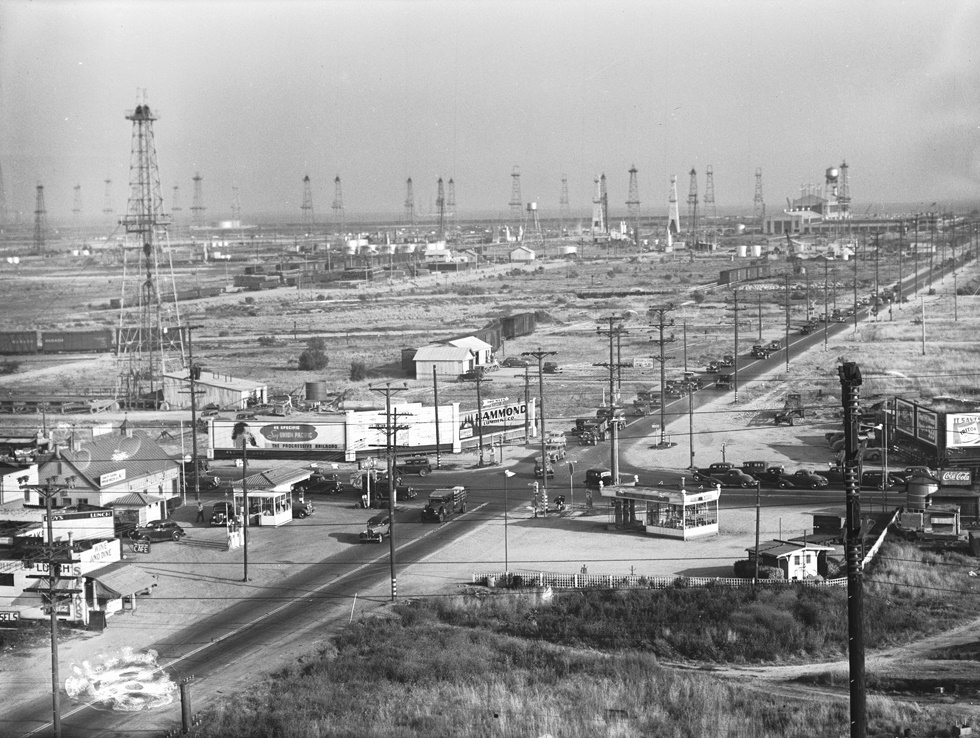 |
|
| (1937)* - Henry Ford Avenue and U.S. Highway 101, Wilmington. Oil derricks can be seen in the background. |
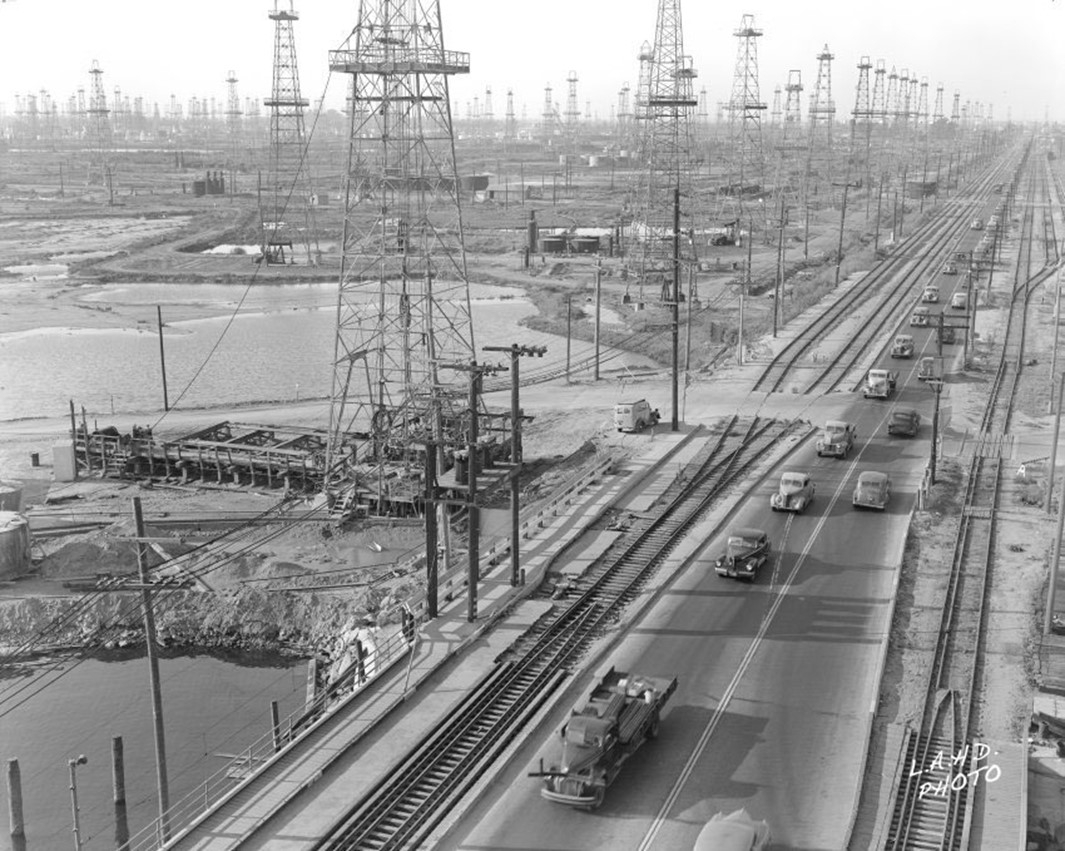 |
|
| (1945)* - A general view looking northerly along Badger Avenue (Henry Ford Avenue) from the northeast counterweight of the Badger Bridge. |
 |
|
| (1930s)^* – View showing the Hancock Oil Gas Station located at 837 North Pacific Avenue in San Pedro. It was owned by Ray Johnson and George Story. The car on the rack (1930 Buick) is a City of Los Angeles Fire Department vehicle and has the number 1527 on the door. The Homeport (?) Cafe is seen in the distance. |
Historical Notes The two-story service station and office was demolished at in 1966. Today, J & J Body Shop exists where the service station once stood. Click HERE to see contemporary view. HANCOCK Oil Company was headquartered in Los Angeles. In the 1850’s, lawyer Henry Hancock helped the Rocha family establish their legal claim to Rancho La Brea, but they ended up owing him so much in fees that they gave him part of the rancho in payment. In 1860 Hancock and his brother bought the rest of the rancho. Hancock began to sell asphalt produced from the famous tar pits that gave the rancho its name. This was the beginning of the Hancock Oil Company. In 1885 Hancock’s widow leased part of the rancho to eastern oil men who went bust by 1888. But in 1902, Mrs. Hancock leased part of the rancho to the Salt Lake Oil Company, which proved a great success. Henry Hancock’s son, George A. Hancock, who had learned the oil business working for Salt Lake, established his own company in 1906. By February 1907, he had over 70 wells producing nearly 300 barrels a day, making the Hancocks one of California’s wealthiest families. The Hancock family built Hancock Park, a large upscale apartment community. The Hancock Oil Company was sold to Signal Oil in 1958. The 1965 Signal was sold to Humble, and both the Hancock and Signal brands vanished.* Click HERE to see more Early Views of LA Gas Stations. |
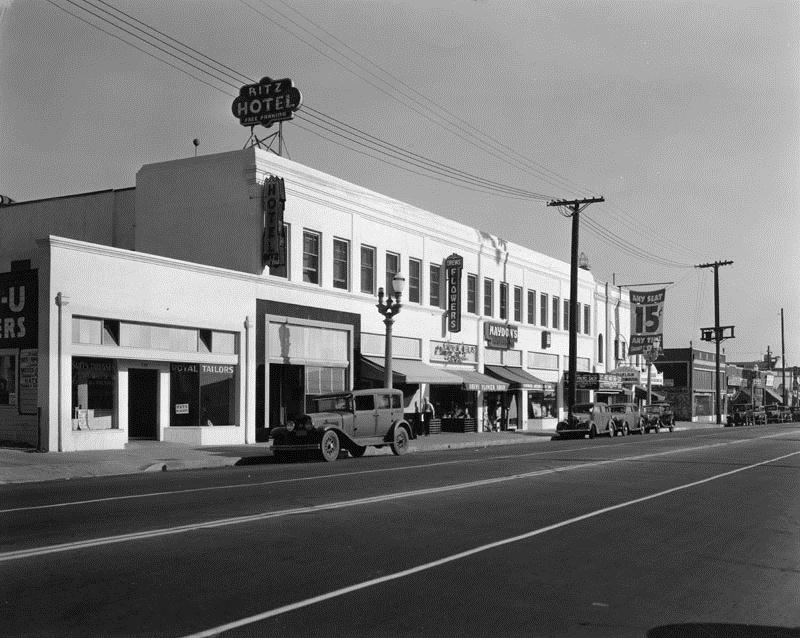 |
|
| (1939)* - Photo of the 700 block of Avalon Boulevard shows several businesses which includes: Royal Tailors; Ritz Hotel; Drews Flowers; Haydon's; a photo shop; and a small theater. A large banner hangs over the theater, advertising "any seat, 15 cents, any time." |
 |
|
| (1939)* - Night view of Foodman Market in Wilmington. Groups of people can be seen standing on both sides of two large spotlights at the front of the store. Note banners hanging on building. |
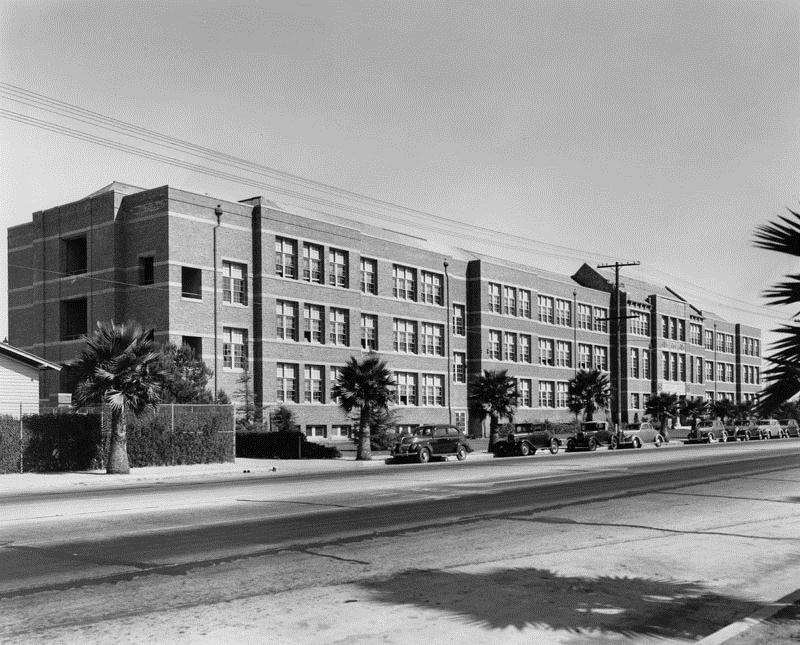 |
|
| (1939)* - Exterior view of Banning High School. View is looking at the left side of the building, from across the street. Partial view of the main entrance may be seen towards the middle of the building. Note the architectural design above the entrance. |
Historical Notes Banning High School was renamed in honor of General Phineas Banning when a newer facility at Avalon and Pacific Coast Highway was opened in 1926 (previously Wilmington High School). The 'old' red brick building was a landmark in the Wilmington town for many years. The ivy covered brick building suffered damage in the 1971 Sylmar earthquake and was torn down in 1973.*^ |
.jpg) |
|
| (1939)* - Exterior view of Banning High School. View is looking at the right side of the building, from across the street. Main entrance of school is in the middle of the building, decorated by two large columns. |
Historical Notes For three years, classes were held in bungalows while the new building was being constructed. In fall 1975, the new building was opened on the grounds with a Lakme Avenue address. Along with the new building, a new gym and swimming pool were added to the campus—the home of the Banning Pilots.*^ |
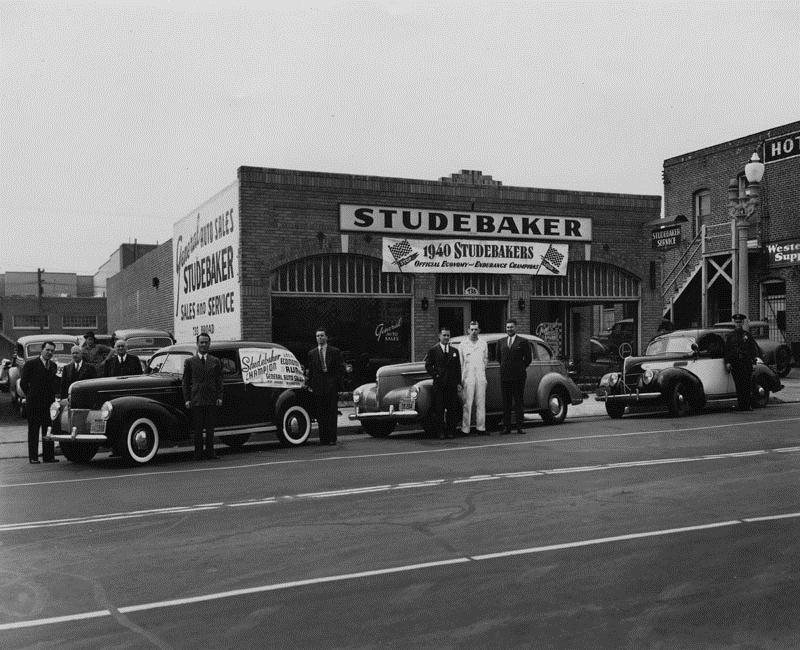 |
|
| (1940)* - Exterior view of Studebaker sales and service building. Employees stand by automobiles that are on display at the front of the building. |
* * * * * |
 |
|
| (ca. 1930)* - Cargo is unloaded through a chute from the S.S. Robert Dollar, onto Union Pacific railroad carts, L.A. Harbor. |
 |
|
| (1929)^^ - View showing cranes unloading steel at Los Angeles Harbor. At left, a steam-powered crane is pulled across the docks by a small locomotive. At right, a second crane can be seen scooping what appears to be coal from a freight car that reads "Utah Coal Route". In the foreground, stacks of lumber can be seen. |
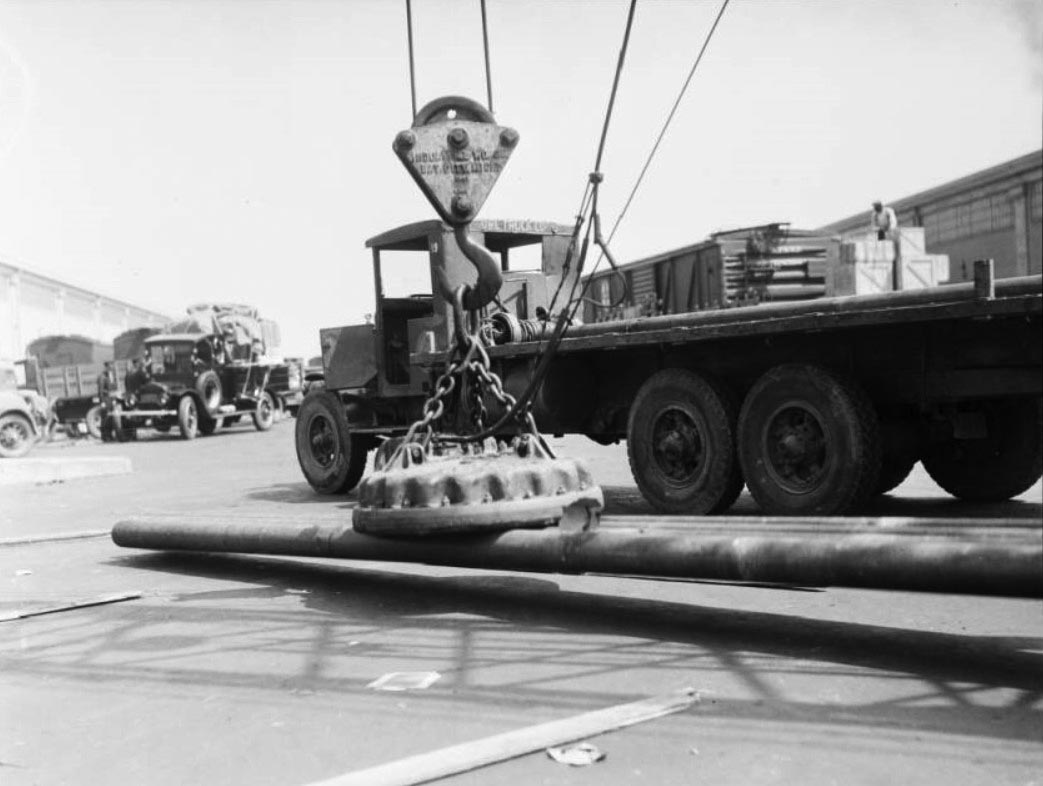 |
|
| (1930)^^ - Photo of steel pipe being loaded on to a truck with a large magnet at the Los Angeles Harbor. |
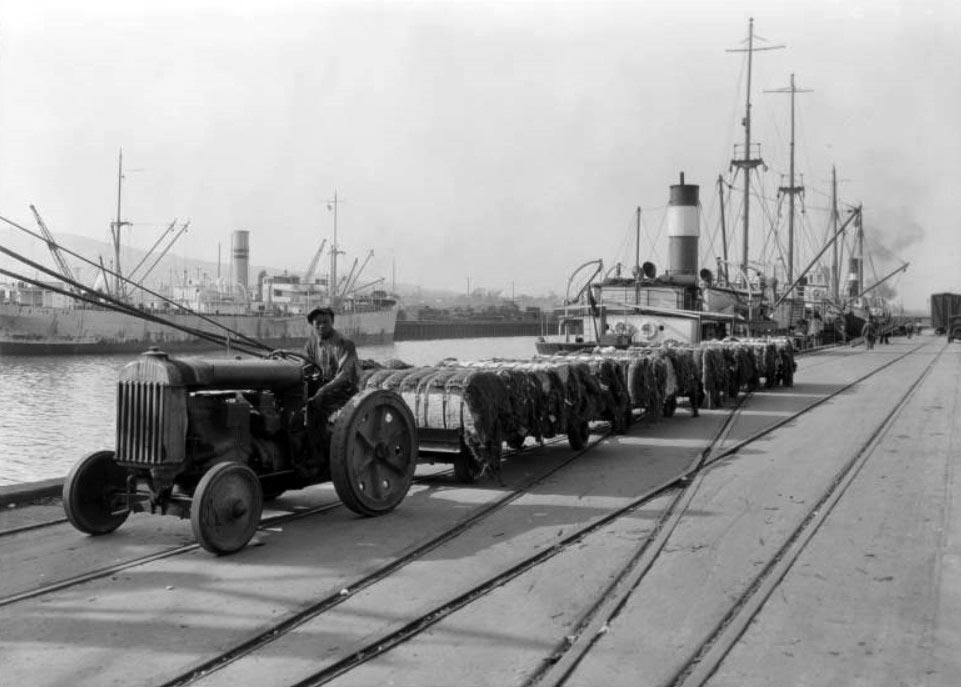 |
|
| (1931)^^ – View showing cotton bales being pulled along a wharf in Los Angeles Harbor. A tractor can be seen in the foreground at left, and it is towing a long line of cylindrical cotton bales behind it at center. The bales are sitting on four flat-bed trailers. In the background at right, a large cargo ship can be seen along the dock, while another freighter is visible in the background at left, across the water. |
.jpg) |
|
| (1940)* - Before Containers: barrels of liquor are hoisted by ropes, three at-a-time, from the hold of the ship onto the docks. |
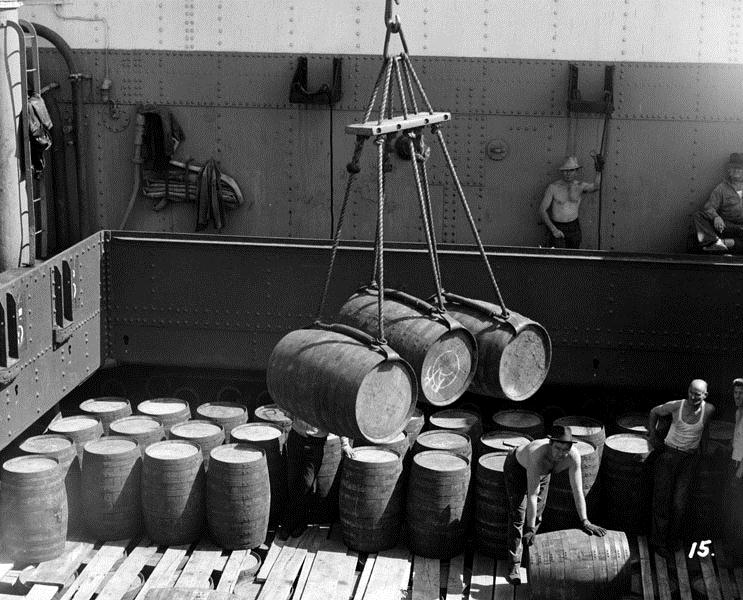 |
|
| (1940)* - A whiskey shipment is being unloaded from a ship for Norton Lily & Co. |
 |
|
| (1940)* - Barrels of liquor are being moved, nine barrels at a time, to be stored in a warehouse at San Pedro Harbor. |
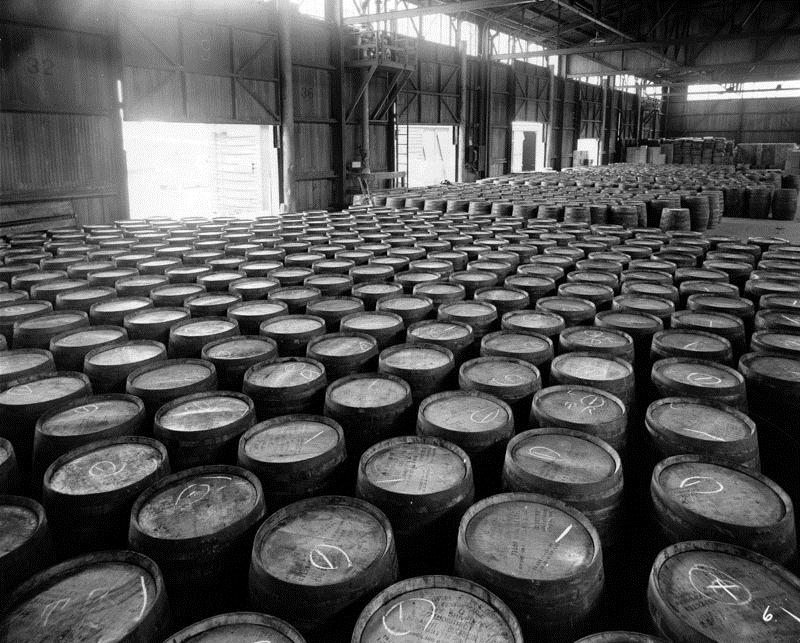 |
|
| (1940)* - View shows barrels of liquor stored in a warehouse. The number 1, encircled, is written on each barrel. |
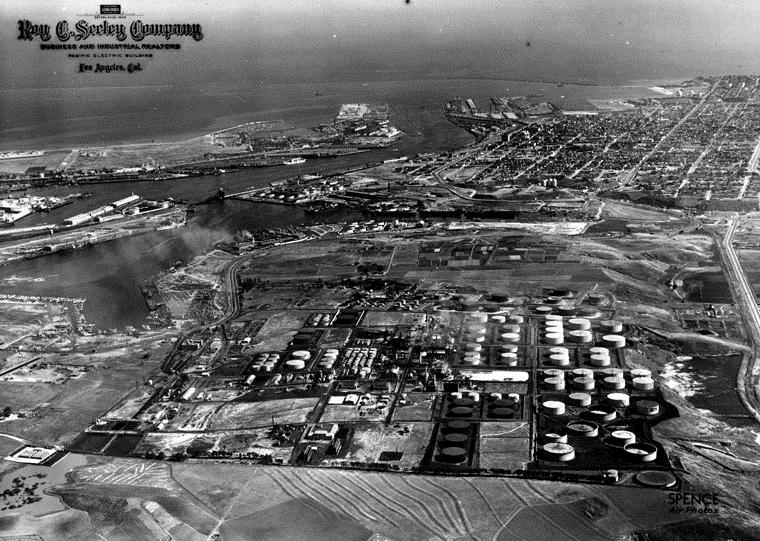 |
|
| (1939)* - Aerial view of the L.A. Harbor, looking south. View also shows the Union refinery in Wilmington. |
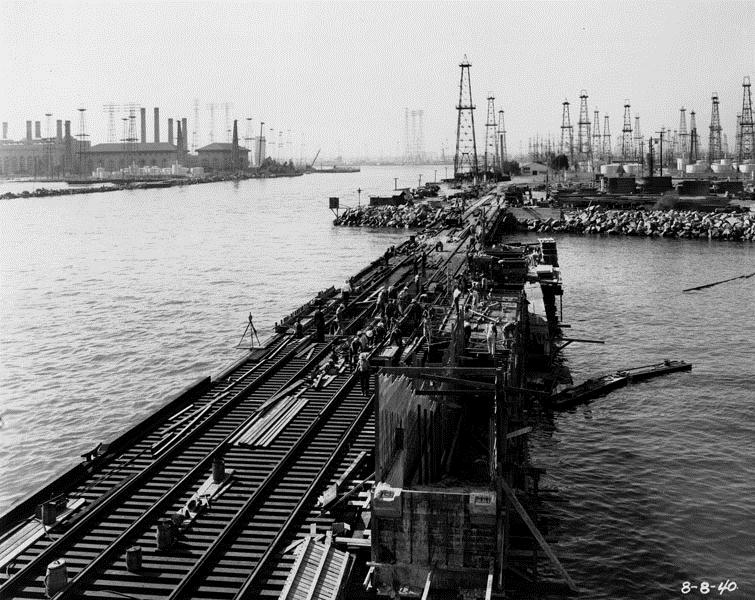 |
|
| (1940)* - A crew of men busily work on the construction of railroad tracks on a bridge, over the harbor. When completed, the tracks will lead from one side of the harbor to the oil fields at Associated Oil Co., Watson refinery, in Wilmington. In the background can be seen a multitude of oil wells of the Wilmington Oil Field. |
Historical Notes The Wilmington Oil Field was discovered in 1932 and is the third largest oil field in the United States. The field runs roughly southeast to northwest through the Los Angeles Basin, stretching from the middle of San Pedro Bay through Long Beach and east of the Palos Verdes Peninsula. The field originally contained approximately 3 billion barrels of reserves. As of 2002, approximately 90% of its original reserves had been recovered, leaving approximately 300 million barrels. The offshore portion of the oil field is developed largely through wells drilled directionally from THUMS Islands, four artificial islands in Long Beach Harbor.*^ |
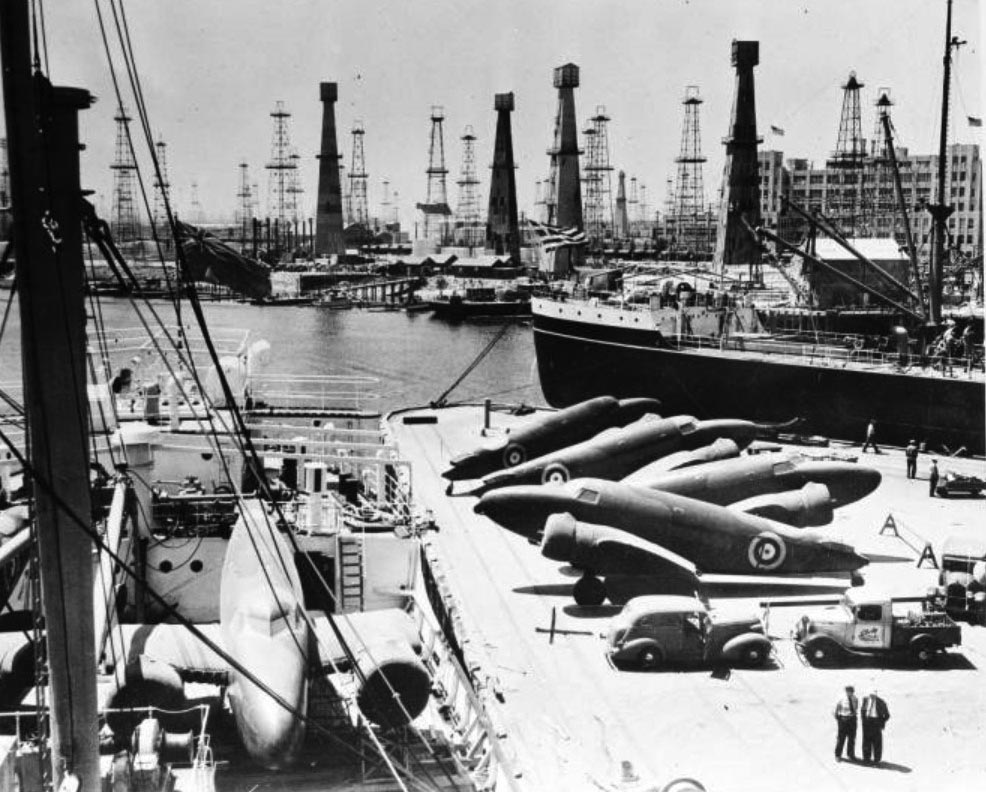 |
|
| (1940s)^^ - Photo showing Lockheed airplanes being loaded for foreign shipment at Los Angeles Harbor. Five planes with bulls eyes painted on the back end sit on the end of a triangular slot of paved land while three automobiles are visible in the right foreground. The side of one truck reads "Liberty Dairy Products" while what seems to be the back portion of a ship can be seen at left. An airplane sits in the deck of the ship while another large ship is visible at right. Water sits directly behind the ships while oil rigs are scattered about the land behind the harbor. |
Banning Residence
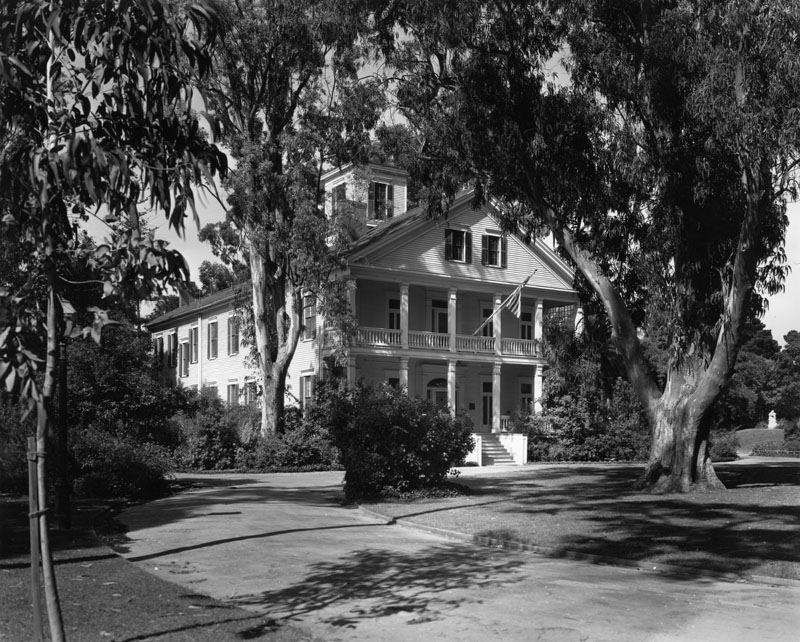 |
|
| (1937)* - Exterior view of Phineas Banning's residence in Banning Park in Wilmington. Large trees and greenery can be seen on both sides of the home. |
Historical Notes The historic Greek Revival-Victorian Banning House was built in 1863 by Phineas Banning near the original San Pedro Bay. It remained in the Banning family until 1925 and has been owned by the City of Los Angeles since 1927. The home, barn and gardens are now operated as a museum.*^ |
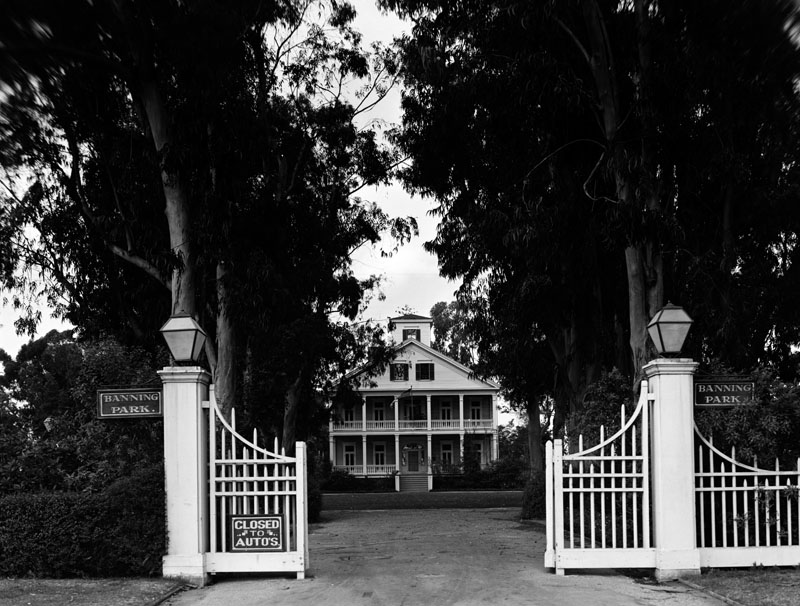 |
|
| (1937)* - Exterior view of the Greek Revival style residence of Phineas Banning, located at 401 East M Street in Banning Park in Wilmington. |
Historical Notes The Banning Residence was lived in by three generations of the Banning family until it and the surrounding land were acquired by the City of Los Angeles in 1927. Eighteen rooms of the house containing furniture and decorative elements added during 60 years of Banning family residence in the house are shown to the public during regular tours of the house and grounds. #^* |
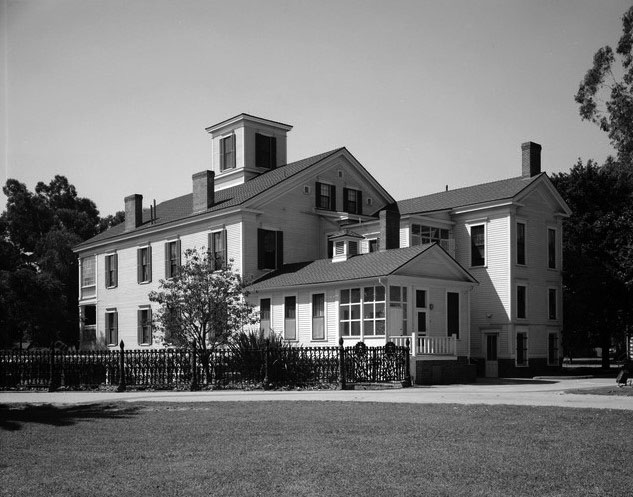 |
|
| (n.d.)#^* - Exterior rear view, looking northeast, of the General Phineas Banning House, built in 1864 in the Greek Revival style. |
Historical Notes In 1963, the Banning House property, also known as Banning Park, was designated as Los Angeles Historic-Cultural Monument No. 25 (Click HERE to see complete listing). It is also California Historical Landmark No. 147 (Click HERE to see more in California Historical Landmarks in LA) as well as being federally listed on the National Register of Historic Places. |
* * * * * |
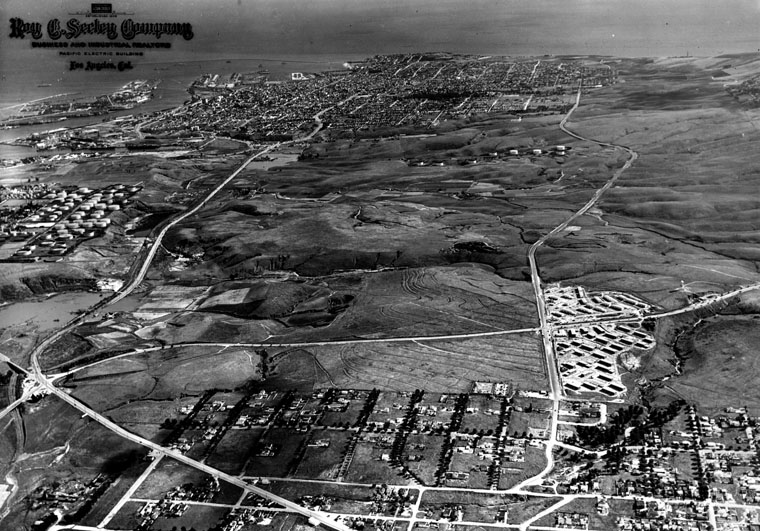 |
|
| (1941)* - Aerial view of Harbor Hills in San Pedro, dated April 2, 1941. Photo by Spence Air Photos |
Historical Notes Spence Air Photos was a one-man company ~ photographer, "Robert Earl Spence". He began shooting aerials in 1918. In the 1920s he had numerous clients hiring him to shoot homes and businesses. Spence would shoot images at an angle, not straight down, showing many additional building details. Spence was not a pilot, he hired an airplane pilot to fly him overhead while he leaned out from the cockpit with a bulky camera to get angled shots of the landscape. His method captured the details of the homes and their surroundings all the way to the horizon. He continued to photograph homes for 50 years. In 1971, Spence retired and donated his collection of 110,000 negatives to the University of California Geography Department. He passed away in 1974.****^ At UCLA, the Spence Collection is part of The Benjamin and Gladys Thomas Air Photo Archives. |
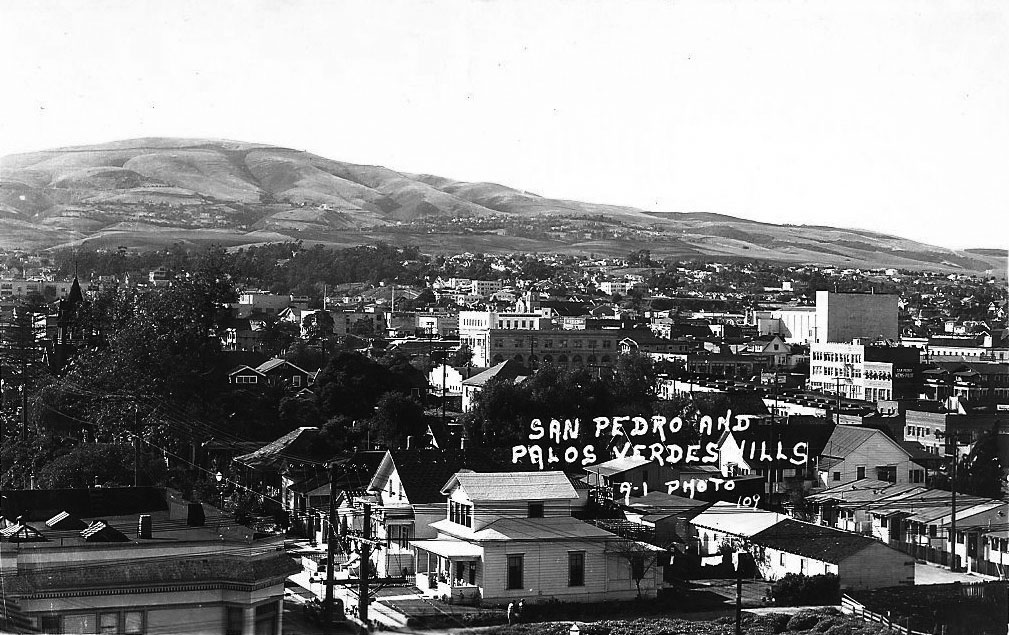 |
|
| (ca. 1940)^* – View of San Pedro with the Palos Verdes Hills in the background. The large building at center-right is the Warner Grand Theatre. |
Historical Notes Originally known as the Warner Bros Theatre, the Warner Grand Theatre was the first sound-equipped theatre in the South Bay. It opened to the public on January 20, 1931, with a star-studded gala premier. Jack Warner christened it "The Castle of Your Dreams." *^ |
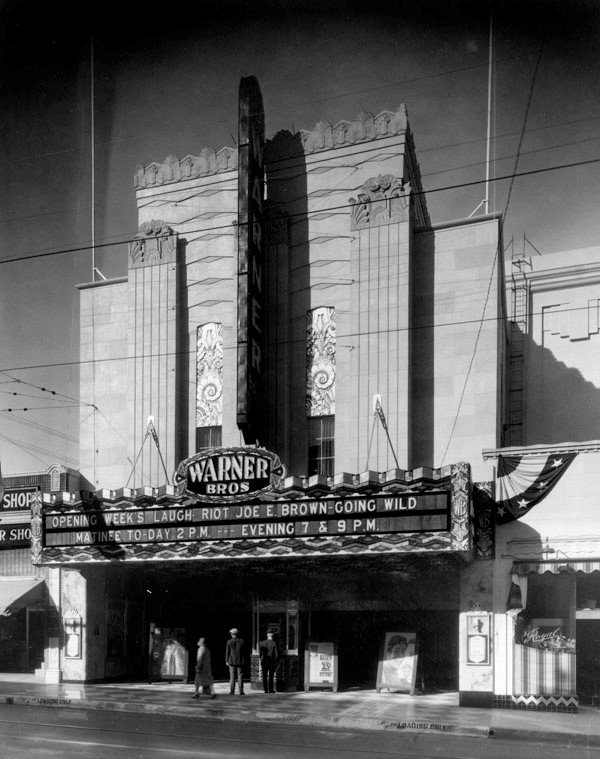 |
|
| (1931)* – Exterior view of the Warner Bros. Theater, located at 478 W. 6th Street in San Pedro. Marquee reads: Opening Week's Laugh Riot - Joe E. Brown - Going Wild. |
Historical Notes The design of the Warner Grand Theatre was a collaboration by architect B. Marcus Priteca and interior designer Anthony Heinsbergen, in the Art Deco—Moderne style. It was one of three similarly lavish Los Angeles area Art Deco movie palaces on which Priteca and Heinsbergen collaborated for the Warner Bros. company in the early 1930s. The Warner Beverly Hills Theatre has been demolished, and the Huntington Park Warner, closed for many years, has been extensively altered, leaving the Grand as the last of the three original theaters remaining intact. Priteca later designed Hollywood's famous Pantages Theatre.*^ |
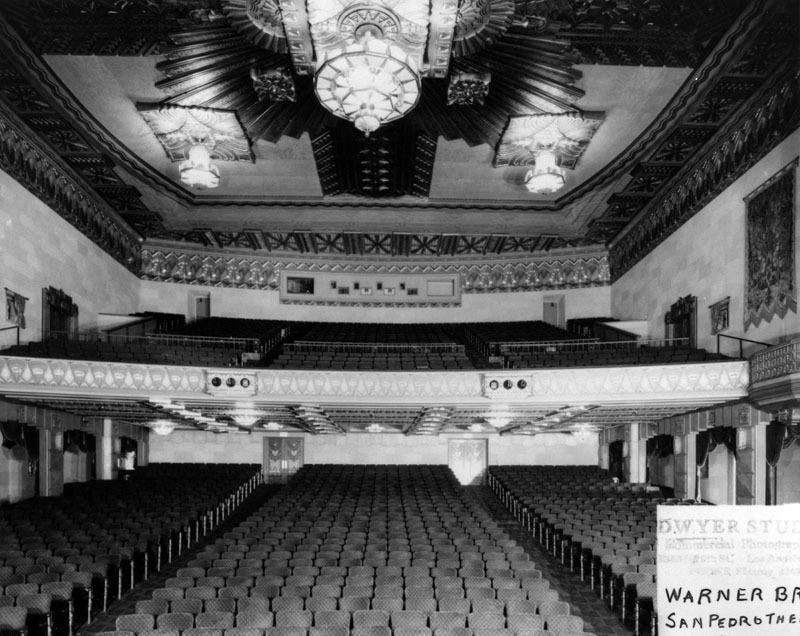 |
|
| (ca. 1938)* – Interior view of the Warner Grand Theater showing the auditorium seating on both levels and the projection booth. The ceiling and walls are decorated with various Art Deco architectural details. |
Historical Notes The theatre interior was designed by Antoon (Anthony) B. Heinsbergen and featured grand, wood-carved ceilings with a copper, gold, and silver sunburst design, Art Deco tile and lighting fixtures, and ornate wall tapestries. In the 1980s, the theatre was renamed the Warner Grand and in 1982 it was dedicated Los Angeles Historic-Cultural Monument No. 251 (Click HERE to see complete listing). |
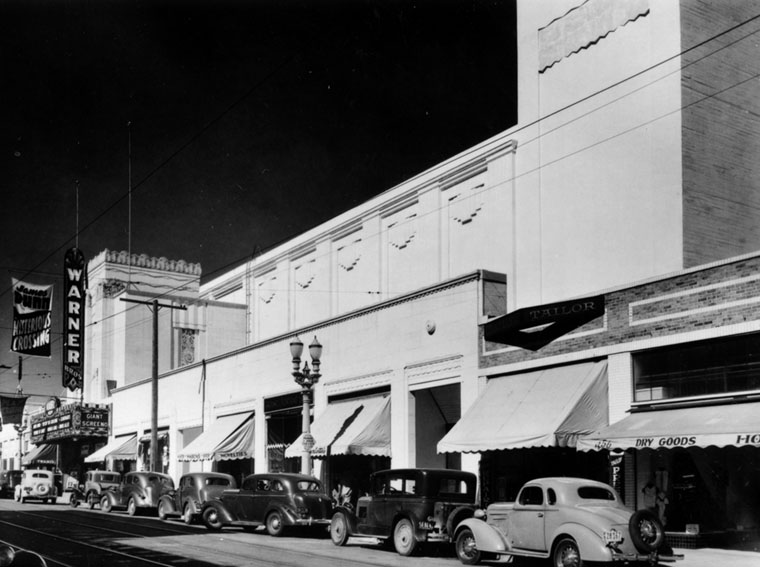 |
|
| (ca. 1938)* - Exterior view of the Warner Bros. Theater located at 478 W. 6th Street in San Pedro. A banner hanging in front of the theater, advertises James Dunn in "Mysterious Crossing." There are several shops to the right of the theater, such as a Novelties shop, a Tailor and a Dry Goods. Early model automobiles are parked along the curb on the street. |
Historical Notes The Warner Grand Theatre went through numerous incarnations over the years, including the San Pedro Theatre (1937), the Stanley Warner San Pedro Theatre (1956), the Warner Theatre (1957), and the Stanley Warner Theatre (1959). In the 1970s, the venue became a Mexican film house called Teatro Juarez. During this period, changes to the opulent interior included covering the plush velvet seats in red, green, and beige vinyl as an homage to the Mexican flag. #*** |
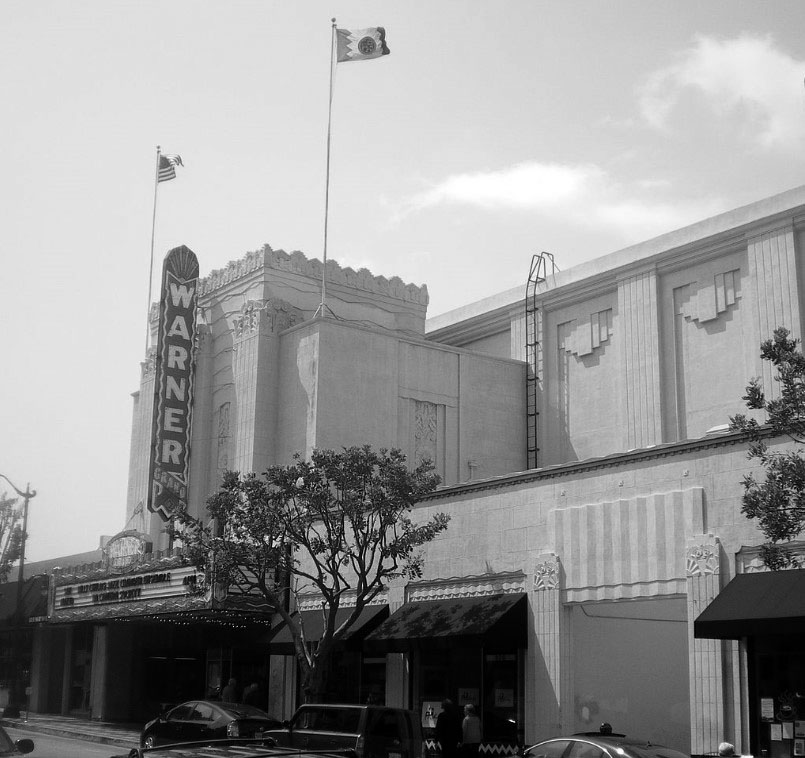 |
|
| (2008)*^ - Exterior view of the Warner Grand Theatre at 478 W. 6th Street in San Pedro. |
Historical Notes The theater was facing possible demolition or re-development when, in 1995, a local group of activists formed the Grand Vision Foundation to work for the preservation of the historic building. Their efforts were successful when the theater was purchased by the Cultural Affairs Department (later renamed the Department of Cultural Affairs) of the City of Los Angeles in 1996. Efforts to both restore and program the theater have been ongoing since the acquisition. In 1999, the Warner was added to the National Register of Historic Places as building #98001633. Warner Grand Theatre currently hosts foreign films, art films, and family films presented by Cinema Grand, Grand Vision Foundation, the Los Angeles Harbor International Film Festival, and the San Pedro International Film Festival.*^ |
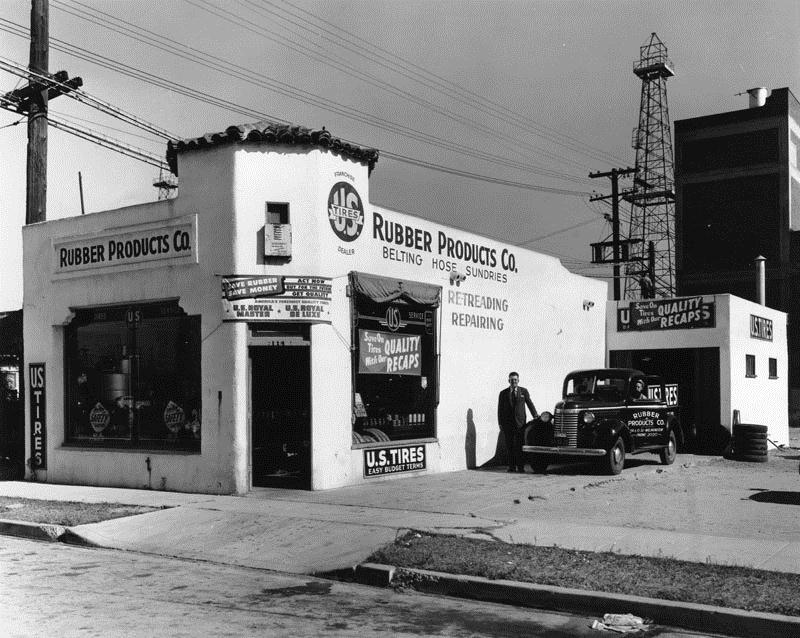 |
|
| (1941)* - Exterior view of Rubber Products Co. at 114 East G Street, in Wilmington. The shop sells tires, rims and other automotive products. Oil well sits in the background. |
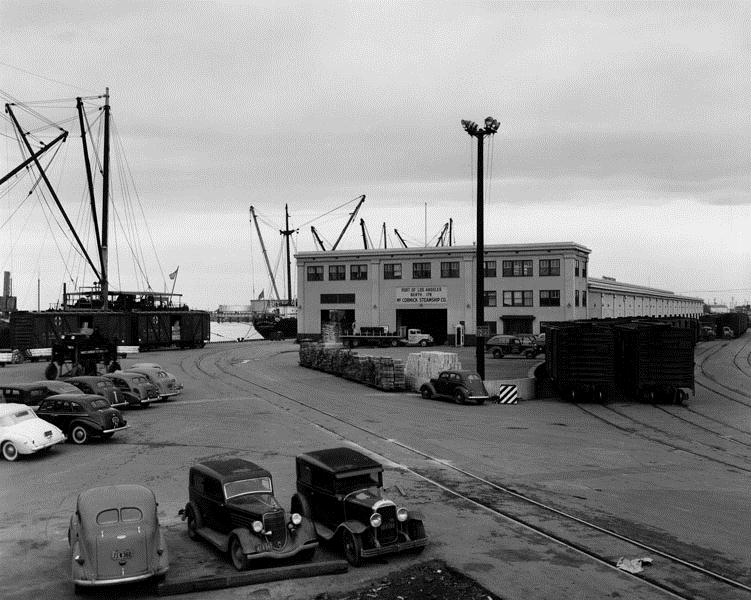 |
|
| (1941)* - Exterior view of Port of Los Angeles, Berth 178, McCormick Steamship Co. Railroad tracks may be seen on both sides of the building. Rail cars on left are stacked with cargo, possibly unloaded from a ship anchored by the dock. |
Fish Harbor (Terminal Island)
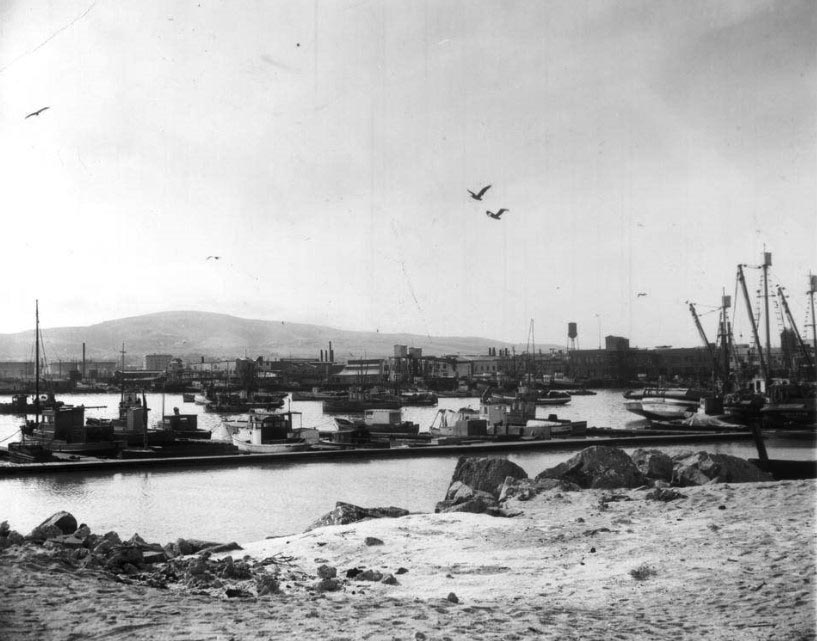 |
|
| (1941)#** – View showing Fish Harbor at Terminal Island, home port for the Japanese (American) fishing fleet. In the background are some of the canneries. |
Historical Notes Terminal Island, home to a vibrant and flourishing Japanese fishing village before residents were evicted and imprisoned during World War II, has recently been named one of America’s most endangered historic places by the National Trust for Historic Preservation. #** |
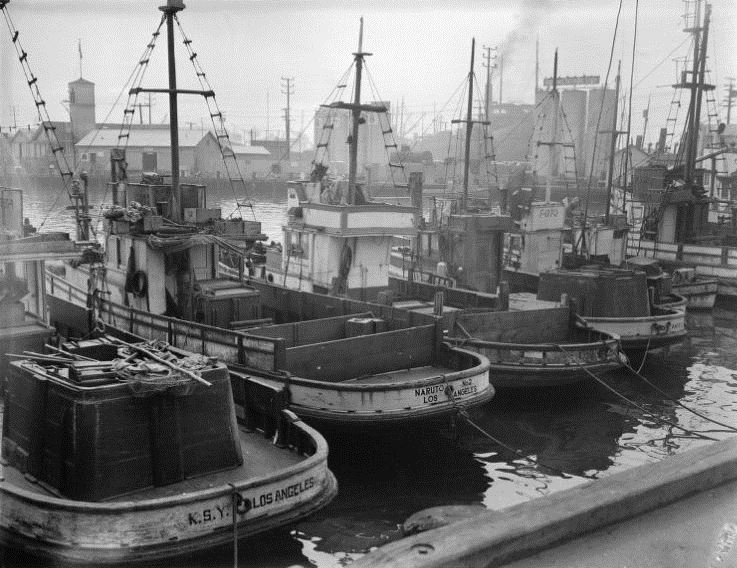 |
|
| (1942)*^## - Impounded Japanese fishing boats at the Los Angeles Harbor. |
Historical Notes Following President Franklin D. Roosevelt issuing Executive Order 9066 on Feb. 19, 1942, the first major Los Angeles relocation of Japanese and Japanese Americans occurred at Terminal Island. By 1942 about 3,000 residents lived in the Japanese fishing community on Terminal Island, also called East San Pedro or Fish Harbor. After Pearl Harbor, many male Japanese residents were detained by the FBI and all Japanese-owned fishing boats impounded. ^** |
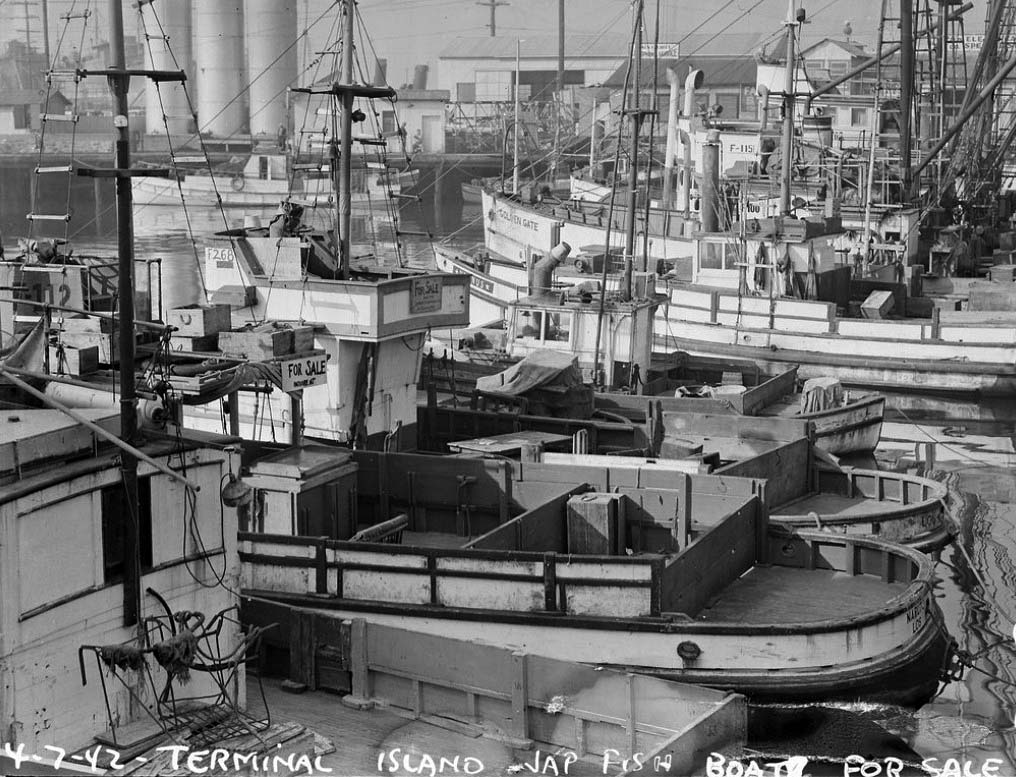 |
|
| (1942)#** - The fishing fleet at rest and for sale, Terminal Island. |
Historical Notes On Feb. 21, 1942, the U.S. Navy began condemnation proceedings to remove all residents – mostly Japanese – from areas near naval bases on Terminal Island. Within a week, further military orders led to clearing all residents in a mass move documented by the Los Angeles Times.^** |
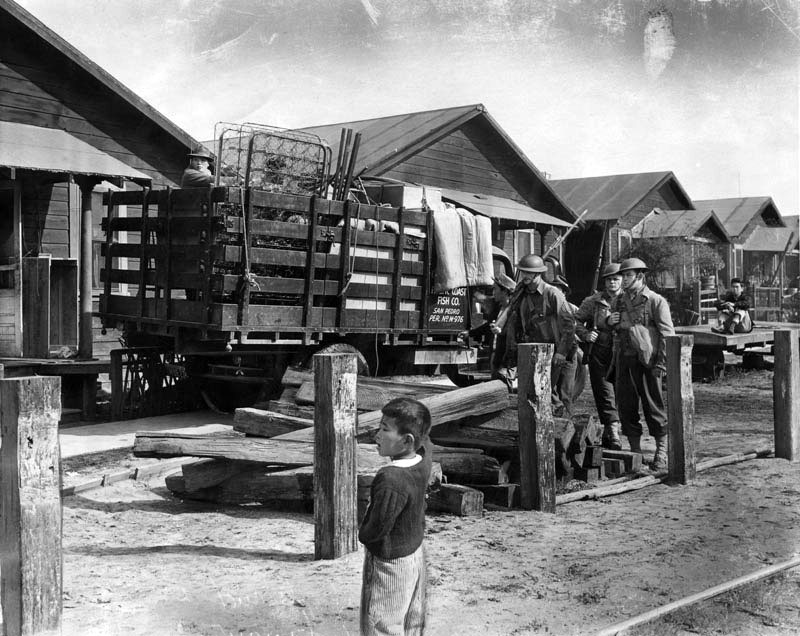 |
|
| (1942)* - It was moving day on February 23, 1942, for Japanese residents at Fish Harbor, Terminal Island, as U. S. troops took possession of the harbor under a federal condemnation writ and scores of Japanese families began their mass evacuation. This photo shows soldiers patrolling a Japanese section while a truck loaded with household goods passes by. |
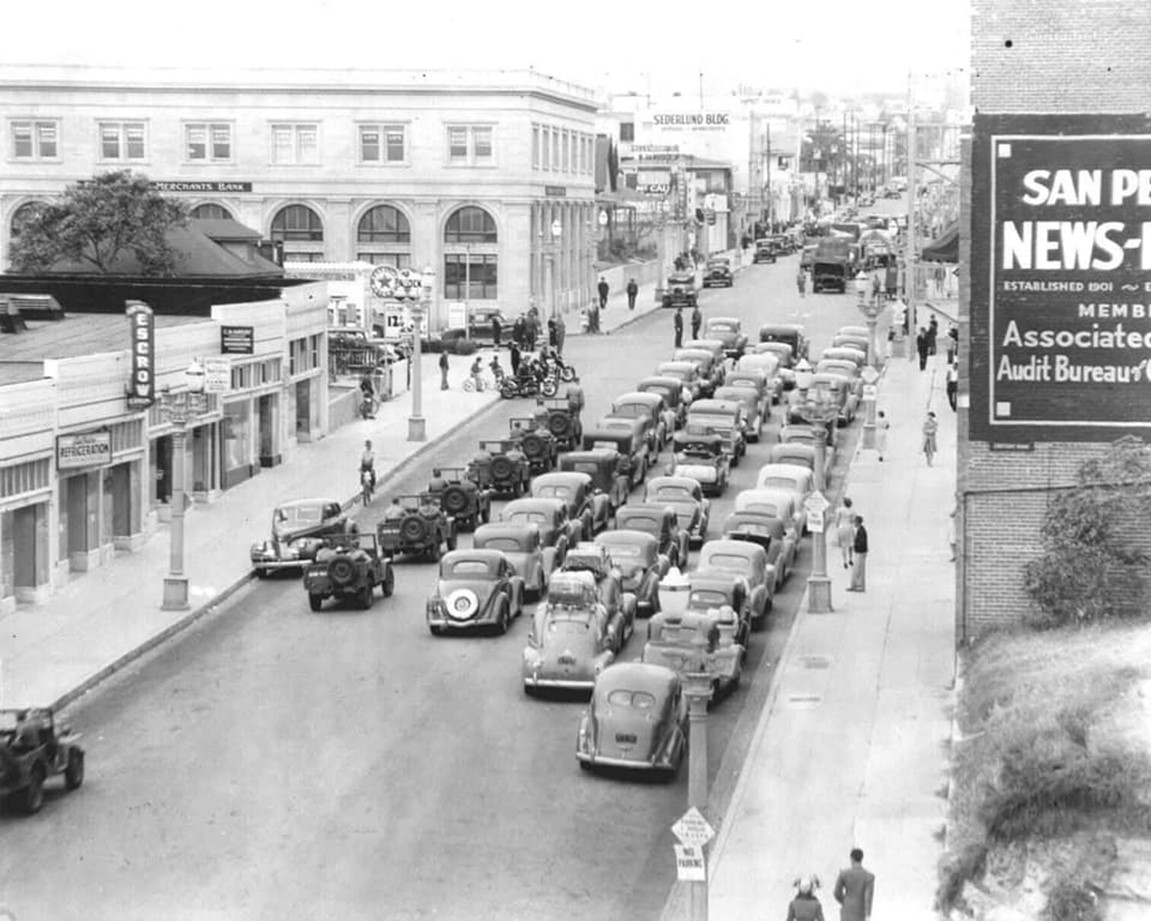 |
|
| (1942)* - 7th Street at Mesa in San Pedro - Evacuation of Japanese-Americans to Relocation Centers |
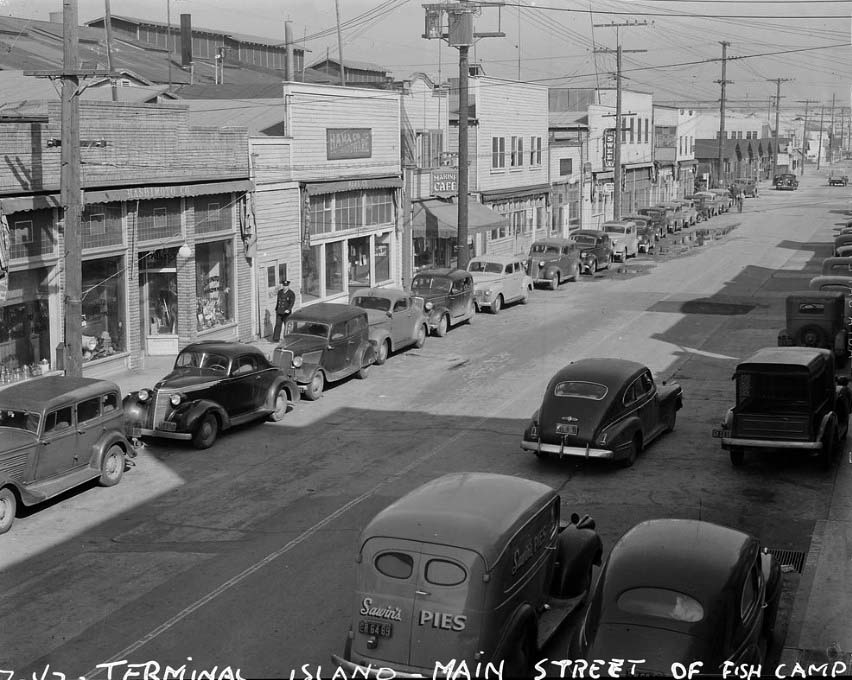 |
|
| (1942)#** – View showing “Main Street Fish Camp”, Terminal Island. |
Historical Notes In the days following the detention and transfer of residents to Manzanar. The robust fishing and cannery businesses will not reestablish themselves after the war. |
Shipbuilding at Terminal Island
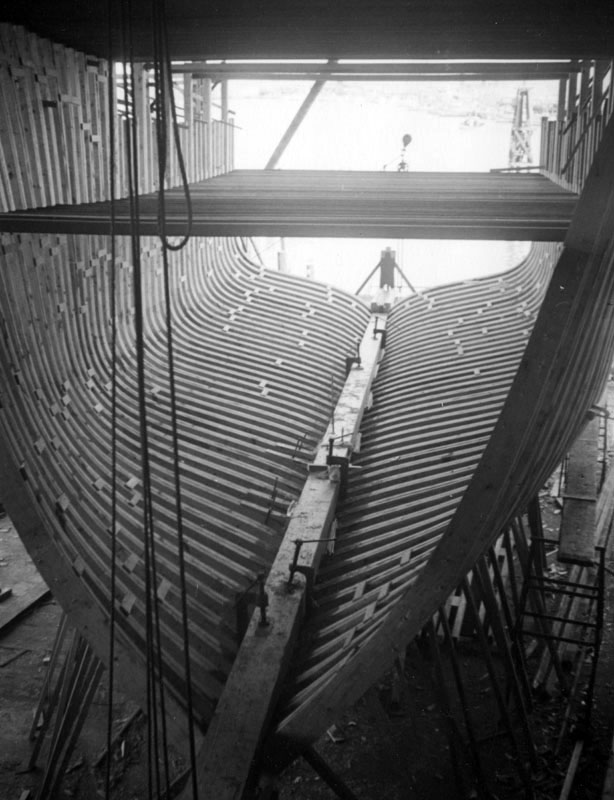 |
|
| (ca. 1938)* - View down a ship frame and into the harbor at Terminal Island. |
Historical Notes Terminal Island launched a worldwide tuna canning industry that made tuna-fish a staple of American households and played a crucial role in both World Wars as a major shipbuilding center. The shipyards in the area employed about 90,000 men and women of all ethnicities at the height during World War II. * |
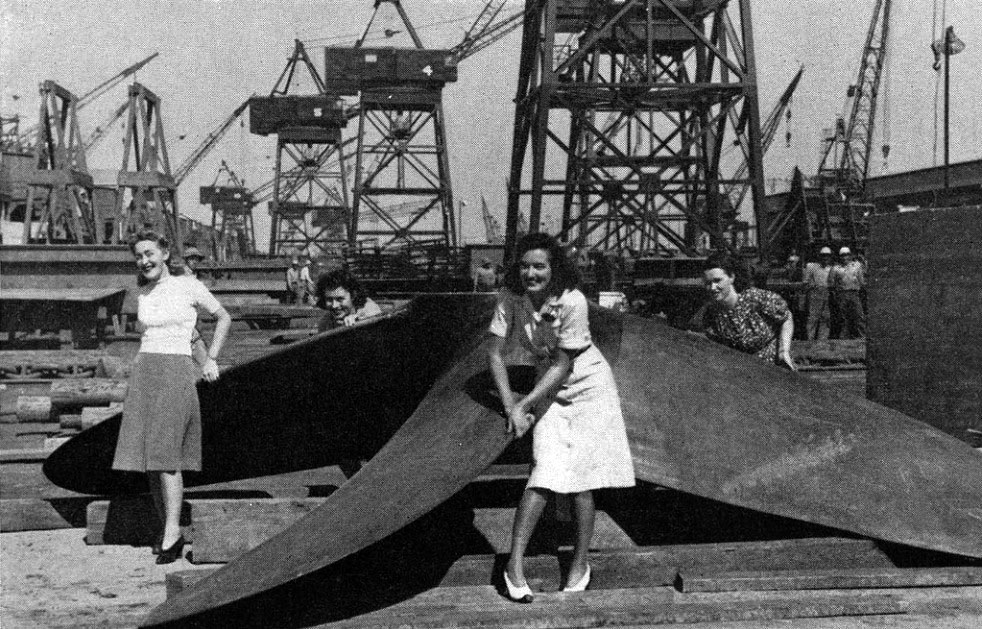 |
|
| (1941)#** – Four young ladies posing for the camera while acting as though they’re trying to turn a propeller on Terminal Island. |
Historical Notes Terminal Island played a key role in both World Wars, setting world records for quick production of ships for the war effort. Bethlehem Shipbuilding Corporation operated the site as a repair facility until 1941, when the specter of another world war led the U.S. Maritime Administration to assist with a $4.5 million project to ready the facilities for shipbuilding once again. This time, instead of merchant marine vessels, the shipyard would produce Fletcher class destroyers, a new kind of naval defense ship. The first ship to launch from the yard was the USS Kendrick in April 1942; the last was the USS Hardwood, christened in 1945. According to the employee manual, "Never before in the history of the world have so many people taken part in a production battle of this kind, and never before has the fate of nations depended so much on the people on the production front." #*** |
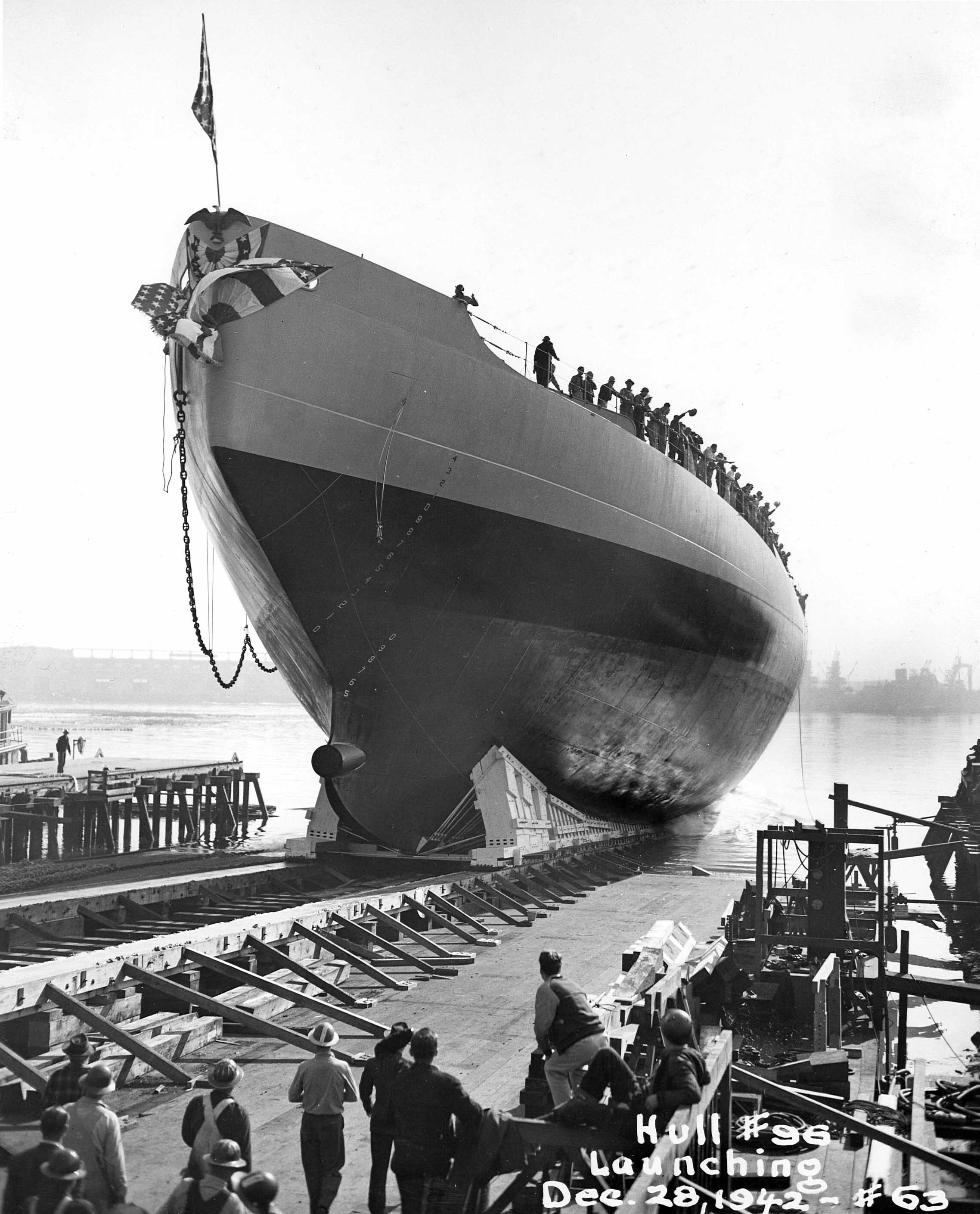 |
|
| (1942)^^ - View of the launching of Hull 96 in San Pedro. Photo by Dick Whittington. |
Historical Notes Hull 96 would become the USCGC Staten Island, an ice breaker, she will see service in the Second World War and continue well into the 1970's. Here she sees the water for the first time as the men and women who built her look on. #** |
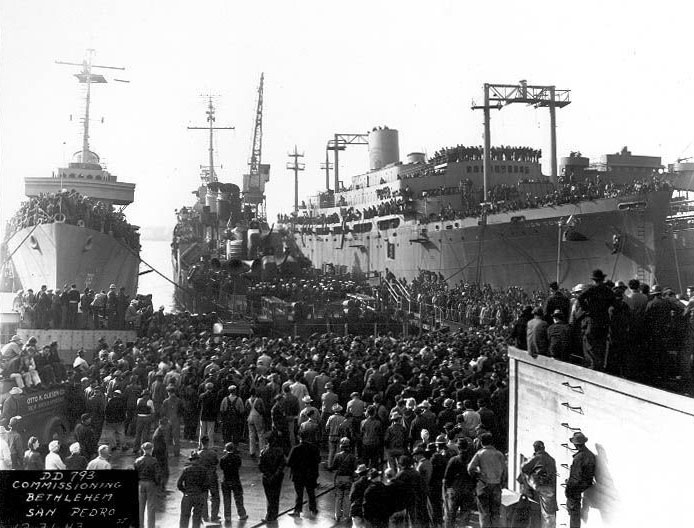 |
|
| (1943)#+ – View showing the commissioning ceremony of USS Cassin Young in San Pedro Harbor, seen here between the USS Preston at left and the USS Comfort at right. |
Historical Notes USS Cassin Young (DD-793), a Fletcher-class destroyer, was a ship of the U.S. Navy named for Captain Cassin Young (1894–1942), who was awarded the Medal of Honor for his heroism at the Japanese attack on Pearl Harbor and who was killed in the Naval Battle of Guadalcanal in the fall of 1942. Cassin Young (DD-793) was launched 12 September 1943 by Bethlehem Steel Corp., San Pedro, California; sponsored by Mrs. C. Young; and commissioned 31 December 1943, Commander E. T. Schrieber in command. After serving in World War II, including the Battle of Leyte Gulf and the Battle of Okinawa, the Cassin Young continued in active service until 1960. She is preserved today as a memorial ship, berthed at Boston Navy Yard in Massachusetts, across from the old warship the USS Constitution. She was designated a National Historic Landmark in 1986 as one of only four surviving Fletcher-class destroyers still afloat.*^ |
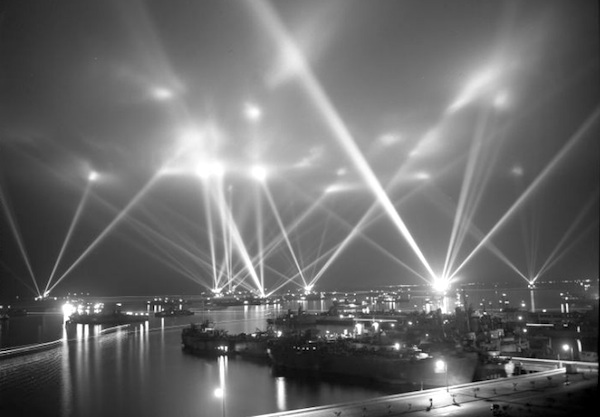 |
|
| (946)*#* - U.S. naval ships illuminate the skies above the Los Angeles Harbor in honor of Foreign Trade Week. |
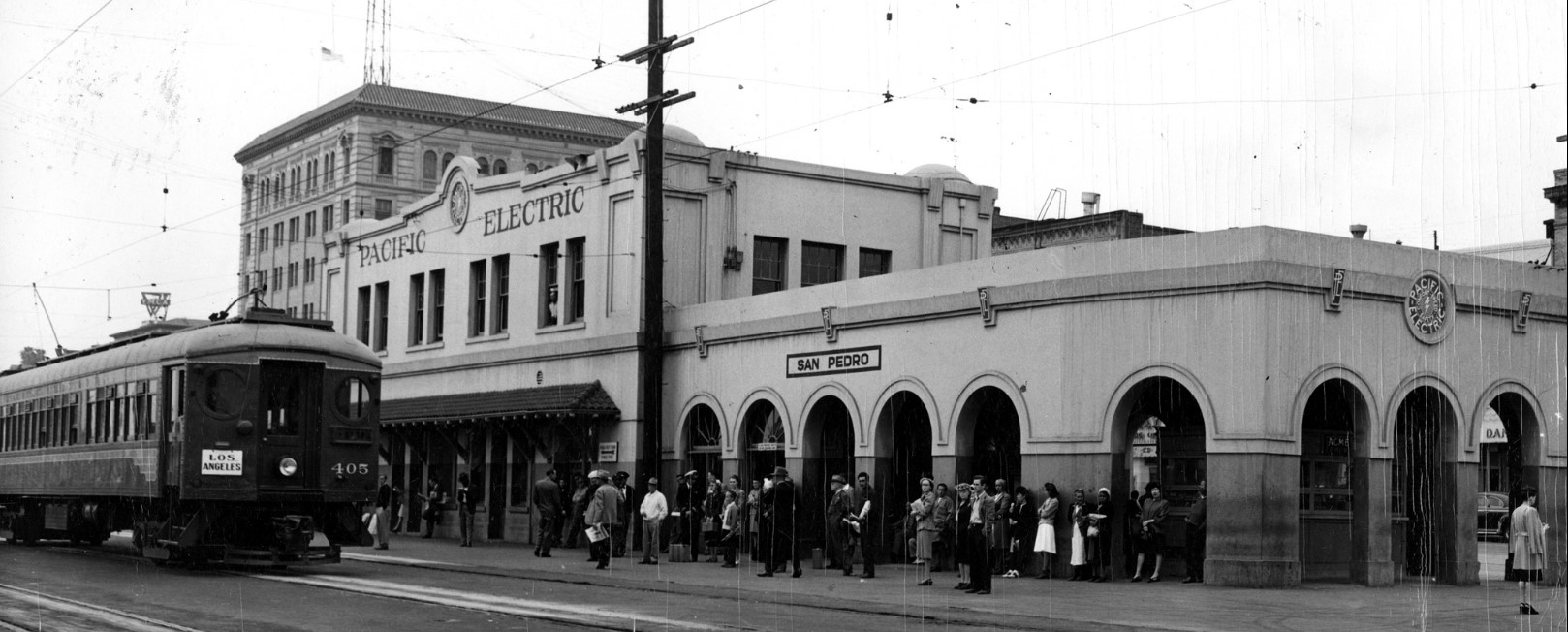 |
|
| (ca. 1950)*##* - Panoramic view of the San Pedro Red Car Staion circa 1950. A group of people are standing by the tracks waiting for the next rail car to arrive. |
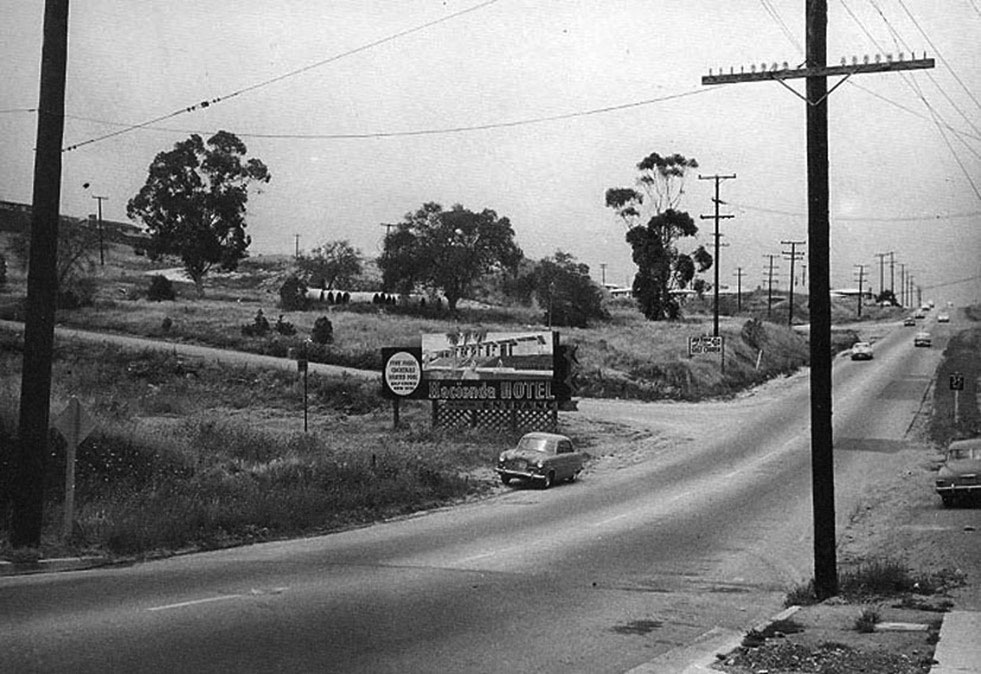 |
|
| (1950s)* – A two-lane Western Avenue near 1st Street in San Pedro. |
Historical Notes Western Avenue stretches from the southern tip of Griffith Park in the Los Feliz area of Los Angeles all the way down to Paseo del Mar at Royal Palms County Beach in San Pedro. The 28-mile thoroughfare is one of the longest streets in Los Angeles County. (Some say Sepulveda Boulevard is the longest at 42.8 miles from the north Valley to the Long Beach border; the two roads intersect at Torrance’s eastern border with Harbor City.) The four-mile section between Torrance Boulevard and Pacific Coast Highway in Lomita ended up being the final link to the completion of Western from Hollywood to San Pedro. It was opened in April 1950. The section through San Pedro finally was completed as a direct thoroughfare all the way to the coast late in 1958, when work on the final segment between 9th and 19th streets was finished.^ |
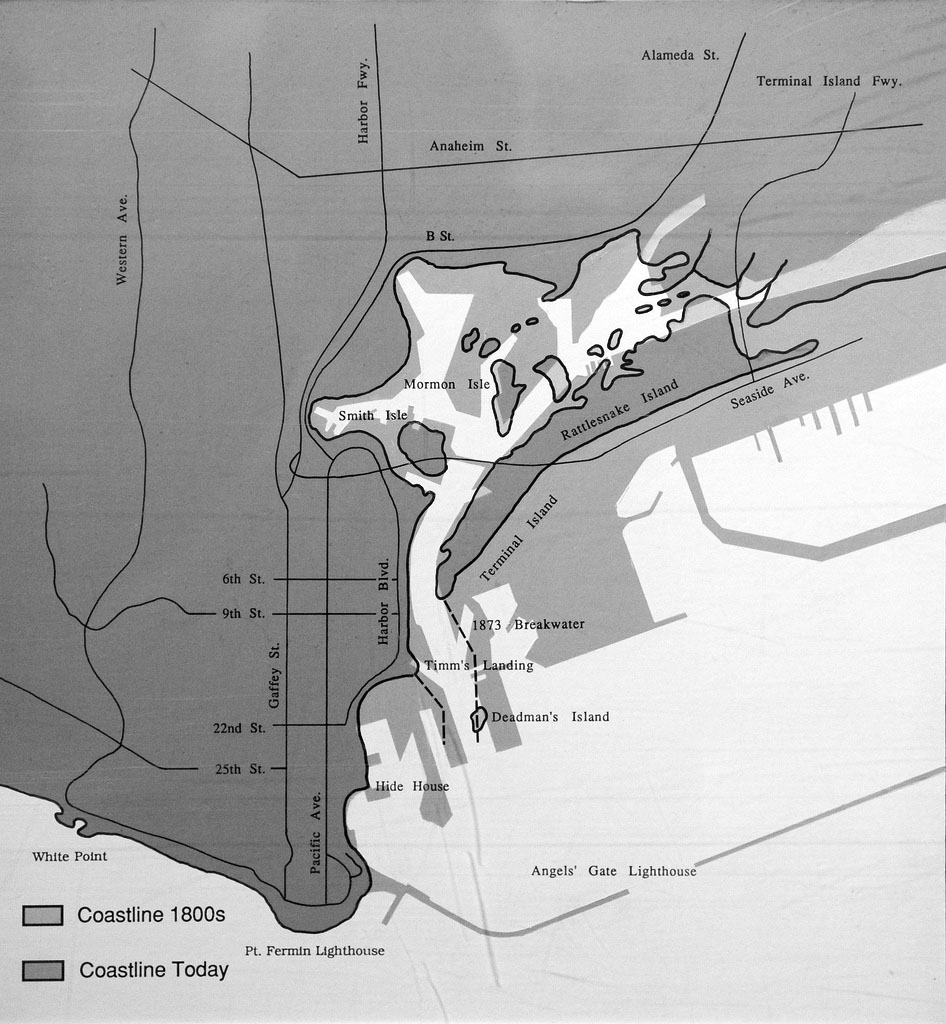 |
|
| (2008)#^ - This map illustrates the changes Wilmington Lagoon underwent to become the present day Port of Los Angeles. |
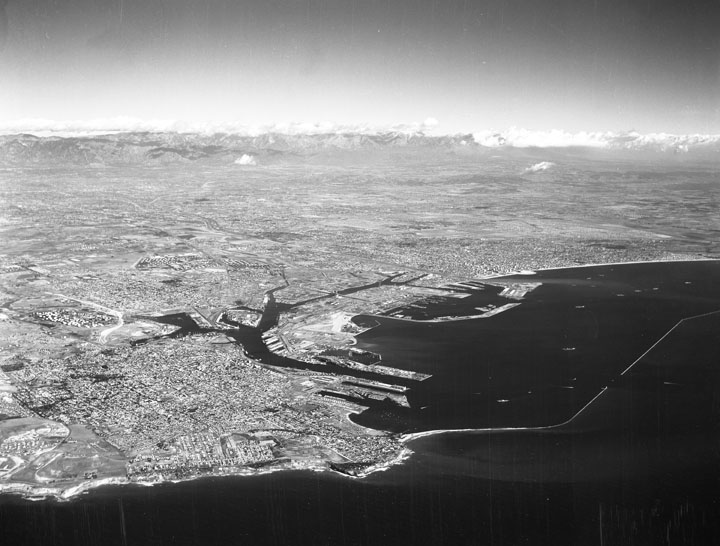 |
|
| (1955)* - Aerial view looking northeast of the Ports of Los Anglees and Long Beach. |
Historical Notes Rancho Palos Verdes and the Portuguese Bend are visible on the bottom left corner; San Pedro (large inhabited area) and Point Fermin (peak that stretches out) are at bottom middle; the white "thread" extending outward toward the right of the Pacific Ocean are the fishing pier and Middle Breakwater. Terminal Island (lower center) is identified by the smallish "islet", which is connected to the Port of Long Beach (middle right, arched area). The city of Long Beach spans far into the distance. Portuguese Bend was the site of an old 1800s whaling station. The site was designated California Historical Landmark No. 381 (Click HERE to see more in California Historical Landmarks in Los Angeles). |
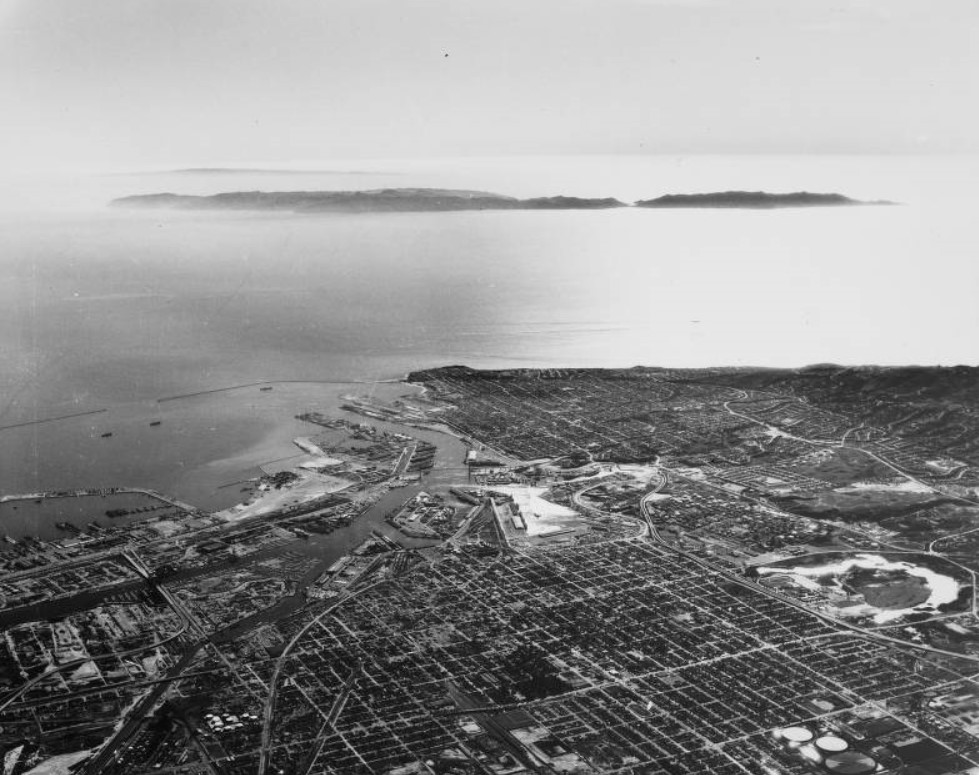 |
|
| (1964)^^ - Aerial View facing south over the Los Angeles Harbor. The Main Channel opens into Outer Los Angeles Harbor, facing Catalina Island, 22 miles away yet seemingly closer. |
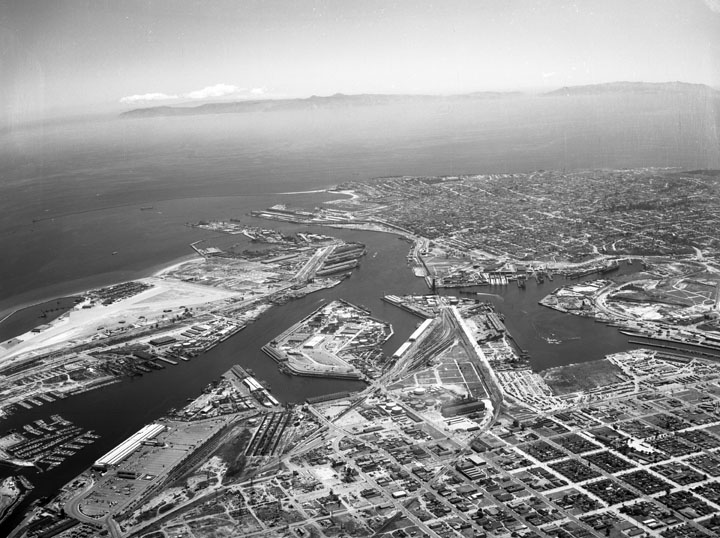 |
|
| (1956)* - Aerial view of the Los Angeles Harbor and Terminal Island; view is looking southwest toward the Pacific Ocean. The East Basin is at lower left, flowing into East Basin Channel; Turning Basin is at middle; West Basin is at lower right; the Los Angeles Main Channel at center, flows into the Pacific Ocean. Terminal Island is on middle left; the city of San Pedro is at center right; Cabrillo Beach and Point Fermin are visible at upper middle. Santa Catalina Island is in the far background. |
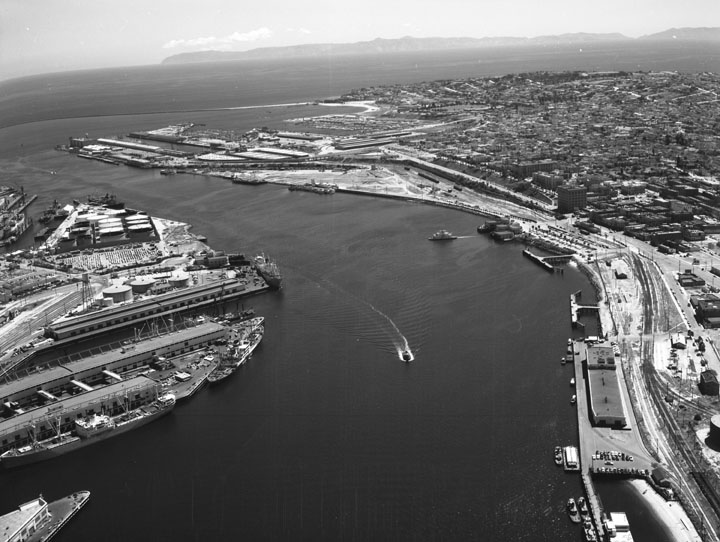 |
|
| (1956)* - Aerial view of the Los Angeles Harbor and San Pedro; view is looking southwest. The Los Angeles Main Channel runs up the middle, veering toward the left, and into the Pacific Ocean; Mobilgas/Mobiloil (with large cylindrical vats) is located on Terminal Island along middle left; the city of San Pedro is on the right. There is a clear view of Santa Catalina Island in the distance (Click HERE to see more in Early Views of Catalina). |
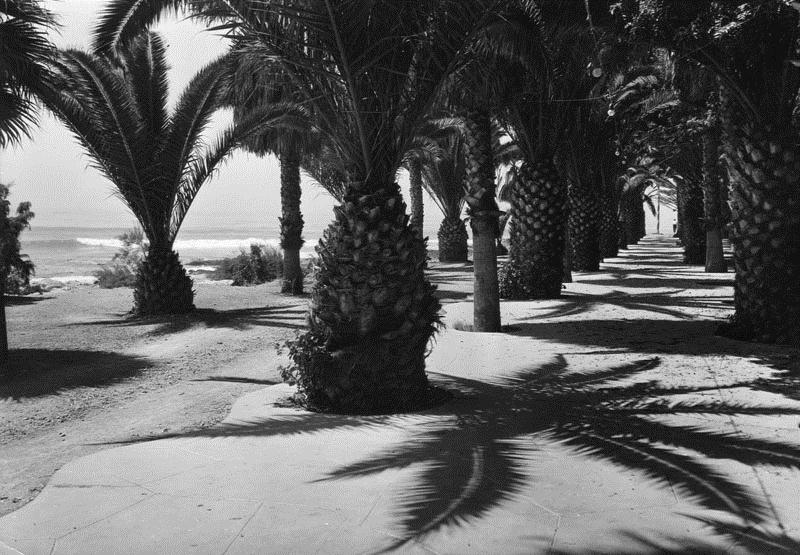 |
|
| (n.d.)* - The pathway winds through a grove of palm trees at Royal Palms State Beach at White Point, located at 1799 Paseo del Mar in San Pedro. |
Historical Notes White Point is a popular coastal destination year round and is home to some of the most diverse tide pools in Southern California. The tide pools extend about a mile south of White Point to Point Fermin Park. At the turn of the century, this secluded cove was settled by immigrant fishermen who were attracted by the vast beds of abalone off the peninsula. Later, the discovery of geothermal sulfur hot springs brought the development of an ocean-side health spa and resort. An earthquake in the 1930's all but closed off the springs. In more recent years, the favorite activity in this busy area is trying to find sea slugs and octopus among the large rock benches and deep pools.* |
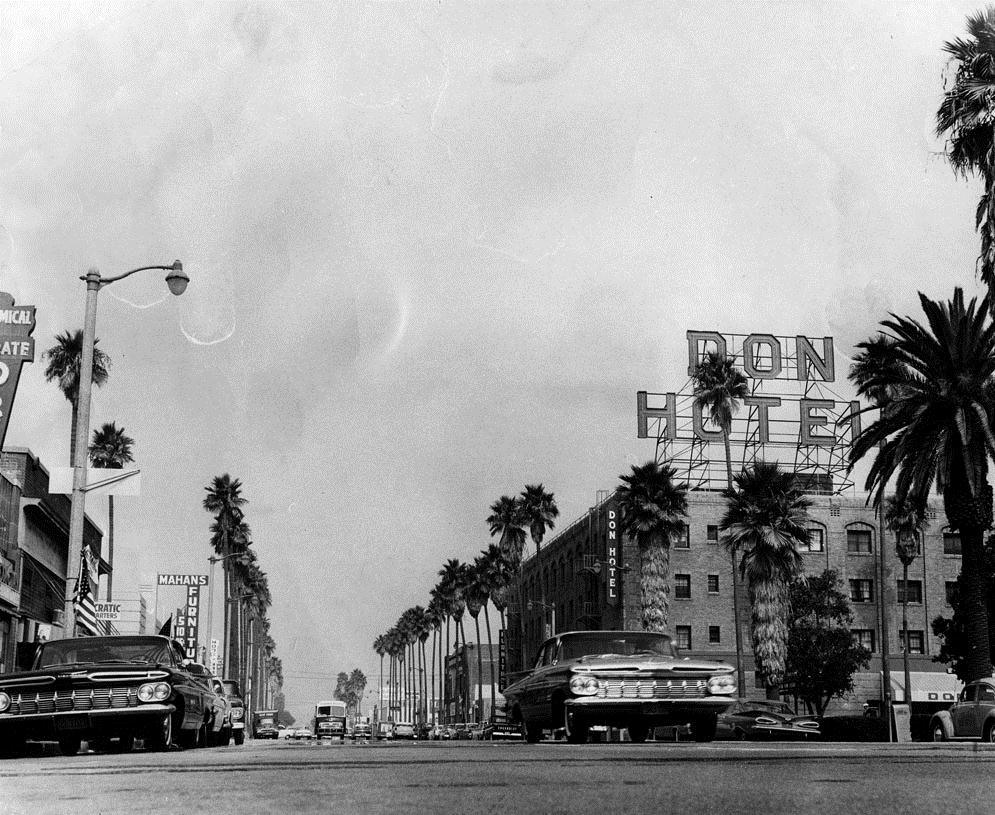 |
|
| (1962)* - View of Avalon Boulevard, Wilmington's principal street, known to millions who have visited Port of Los Angeles to board ships or who have disembarked here. Tall palm trees line both sides of the street in this business area. The Don Hotel, a four-story building, is on the right. |
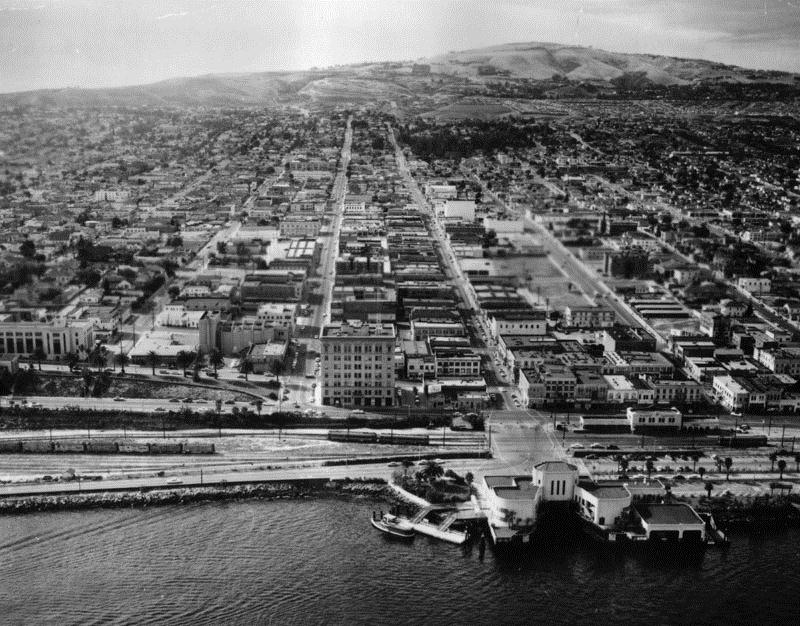 |
|
| (ca. 1960s)* - Aerial view looking inland from the Los Angeles Harbor. The Municpal Ferry building can be seen in the foreground. |
San Pedro Municipal Ferry Building
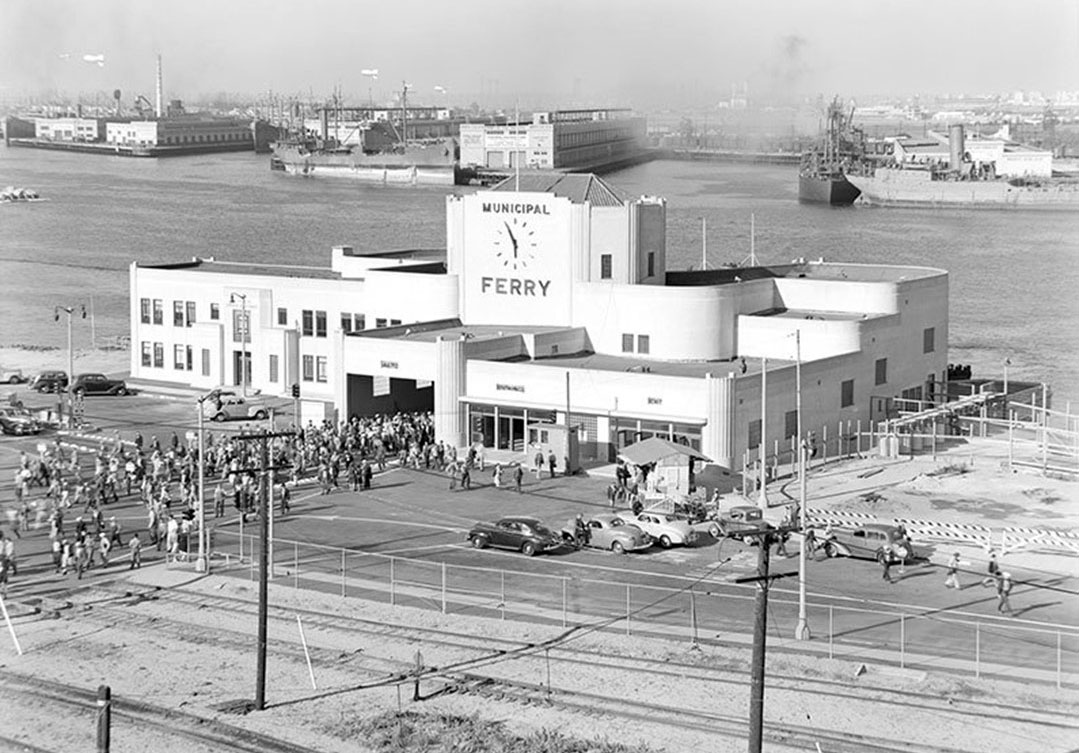 |
|
| (1942)* – A telephoto view from San Pedro City Hall showing passengers disembarking from the ferry “Islander” at Berth 84 on the 5:45 inbound trip. |
Historical Notes The San Pedro Municipal Ferry Building was built in 1941 as a Works Project Administration project. Designed by B. Irvine in the Streamline Moderne style, the building was a working ferry terminal from 1941 to 1963.^ |
| (ca. 1942)#*^ - View looking east from 6th and Beacon streets in San Pedro, with the Municipal Ferry building in the background. Note the ornate streetlights. Click HERE to see more in Early L.A. Streetlights. |
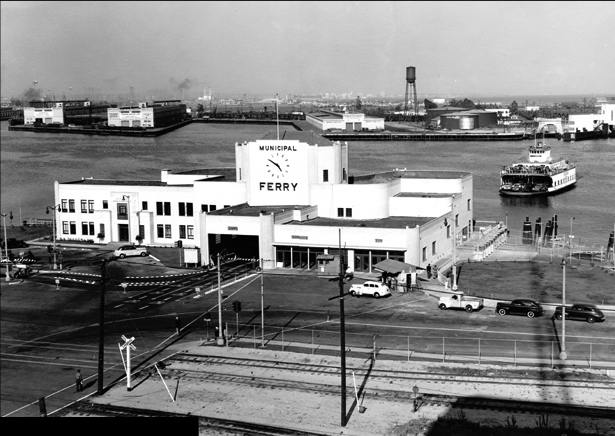 |
|
| (1944)* - Exterior view of the Municipal Ferry building looking towards Terminal Island, at 6th and Harbor Boulevard. |
Historical Notes Ferry service discontinue after 22 years when the new Vincent Thomas Bridge opened in 1963. |
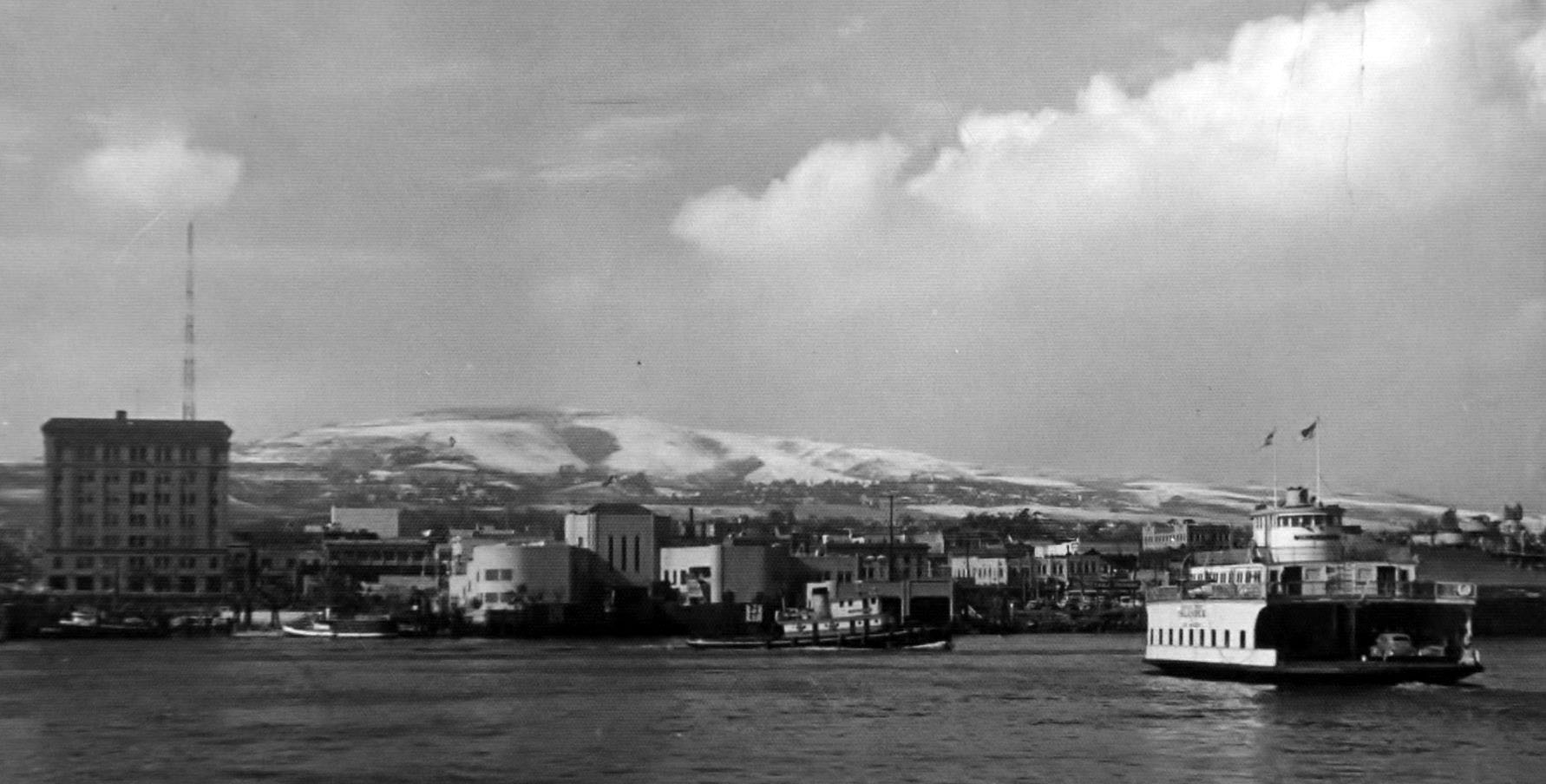 |
|
| (1949)++# - View looking west showing a ferry crossing the Main Channel toward the Municipal Ferry Building with the San Pedro Municipal Building on the left. In the background can be seen Palos Verdes blanketed with snow. Photo date: Jan 11, 1949 |
Historical Notes Before the Vincent Thomas Bridge was built, hundreds of cannery and shipyard workers made their daily passage from San Pedro to Terminal Island aboard ferry boats. State Assemblyman Vincent Thomas thought the ferry system inadequate, and proposed the bridge to replace it. |
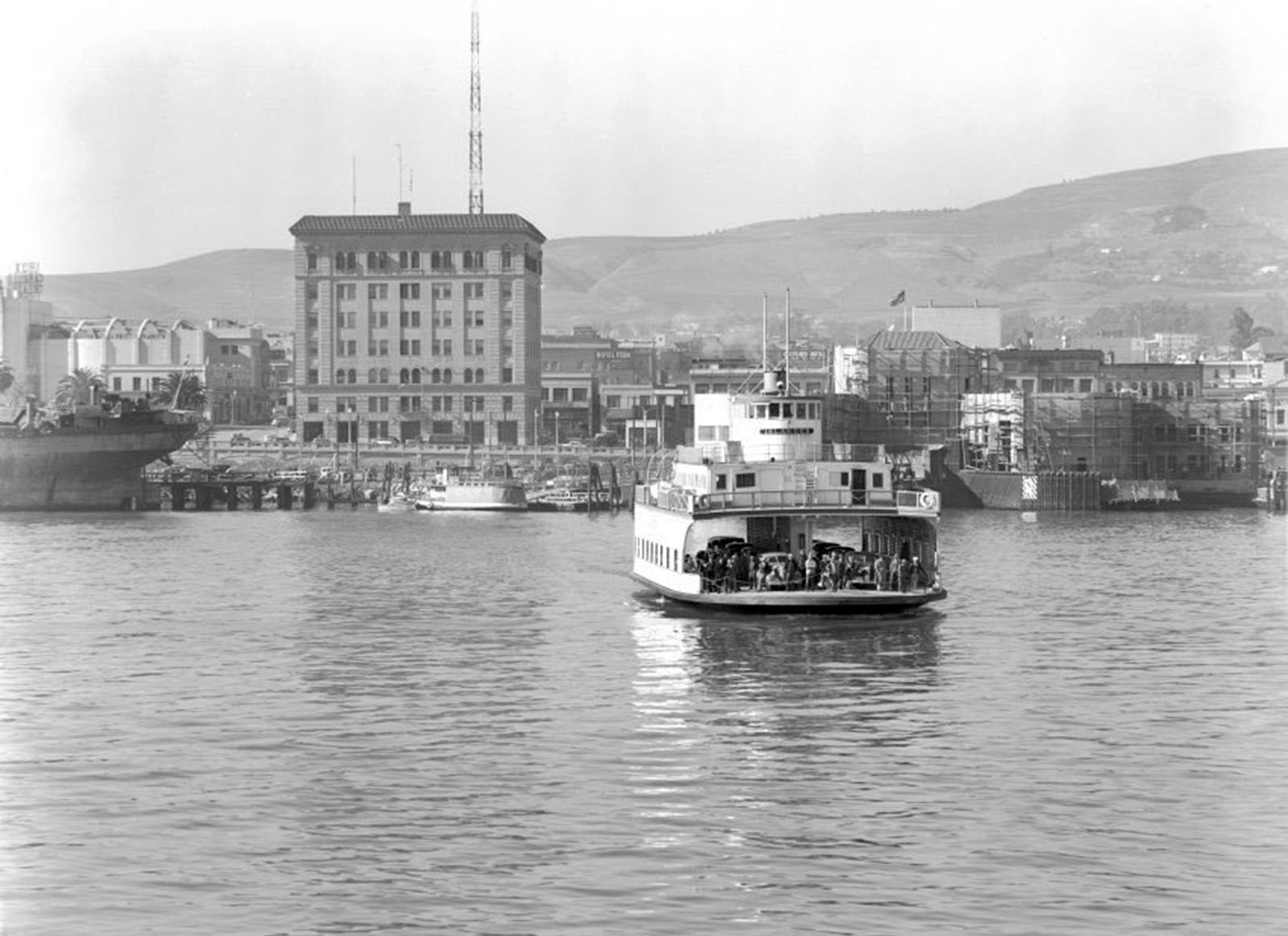 |
|
| (1942)* – Ferry transports people and cars across the waterway with the San Pedro Municipal Building in the background. |
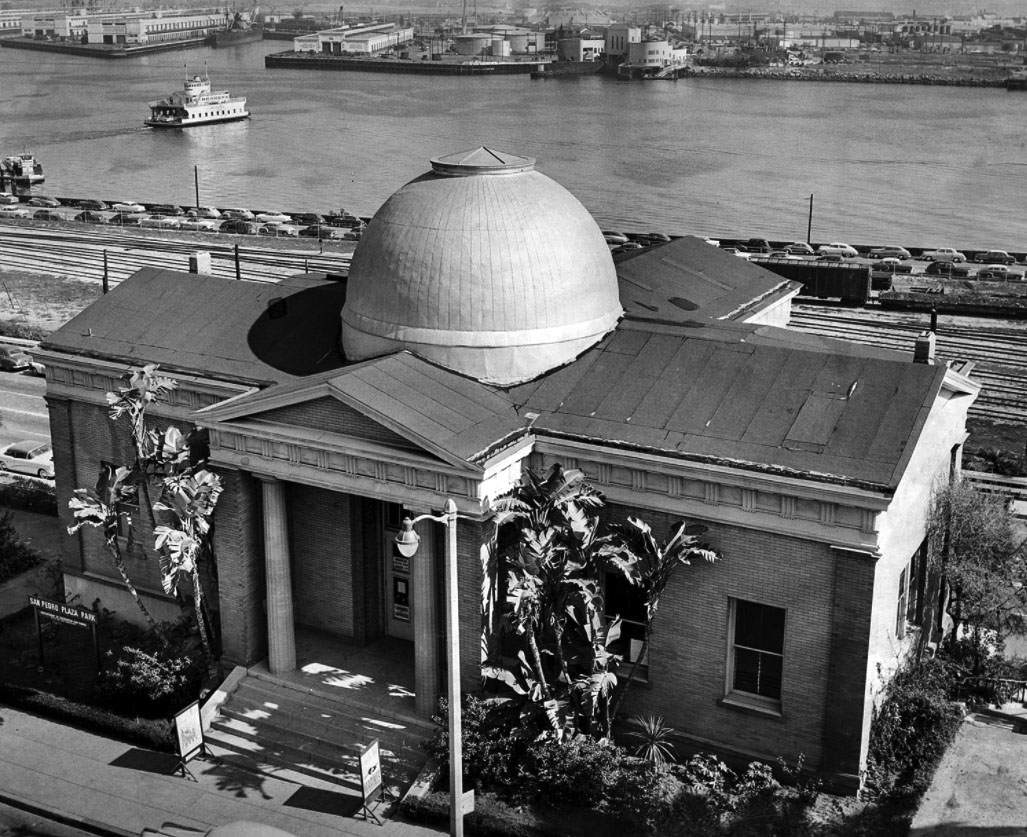 |
|
| (1956)^** – View showing the San Pedro Chamber of Commerce (formerly the Carnegie Library). A ferry is seen crossing the Main Channel toward Terminal Island. |
Historical Notes Originally the San Pedro Branch of Los Angeles Public Library from 1906-1923, this structure was built with an initial grant of $10,000 from Andrew Carnegie, followed by a supplementary $375 from Carnegie and $500 from the city. Architects Edelsvard and Saffell, as well as H. V. Bradbeer, have been credited with the design of the Classical Revival style building. After it served as the office of the San Pedro Chamber of Commerce, it was the Seamen's Library until 1966, when it was demolished to make way for the Maritime Industry Memorial.* |
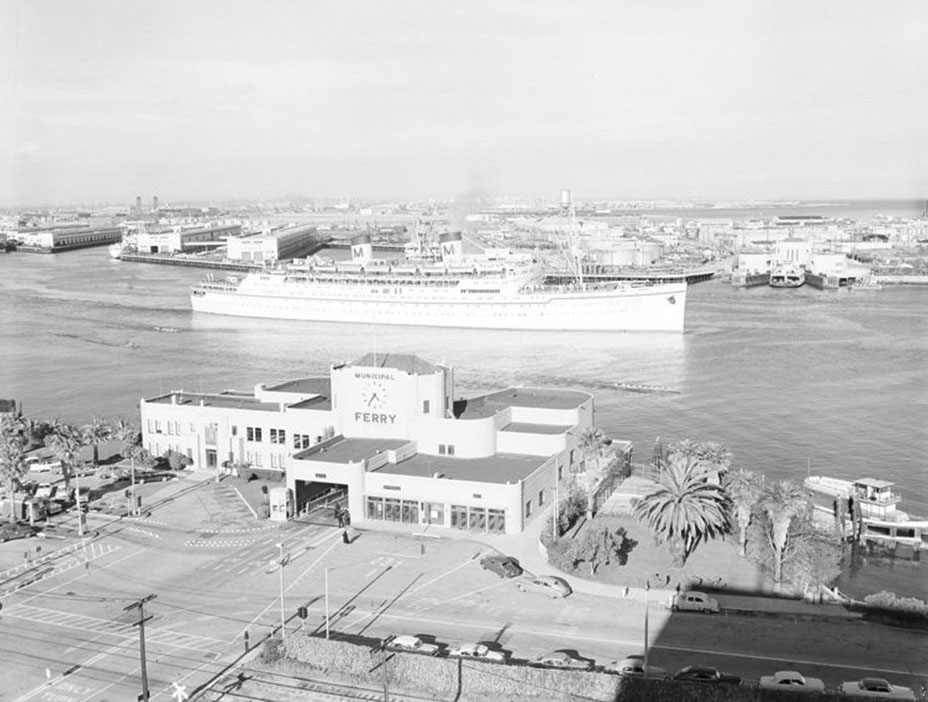 |
|
| (1958)* - S.S. Lurline sailing south on Main Channel past the ferry crossing with the San Pedro Municipal Ferry Building in the foreground. |
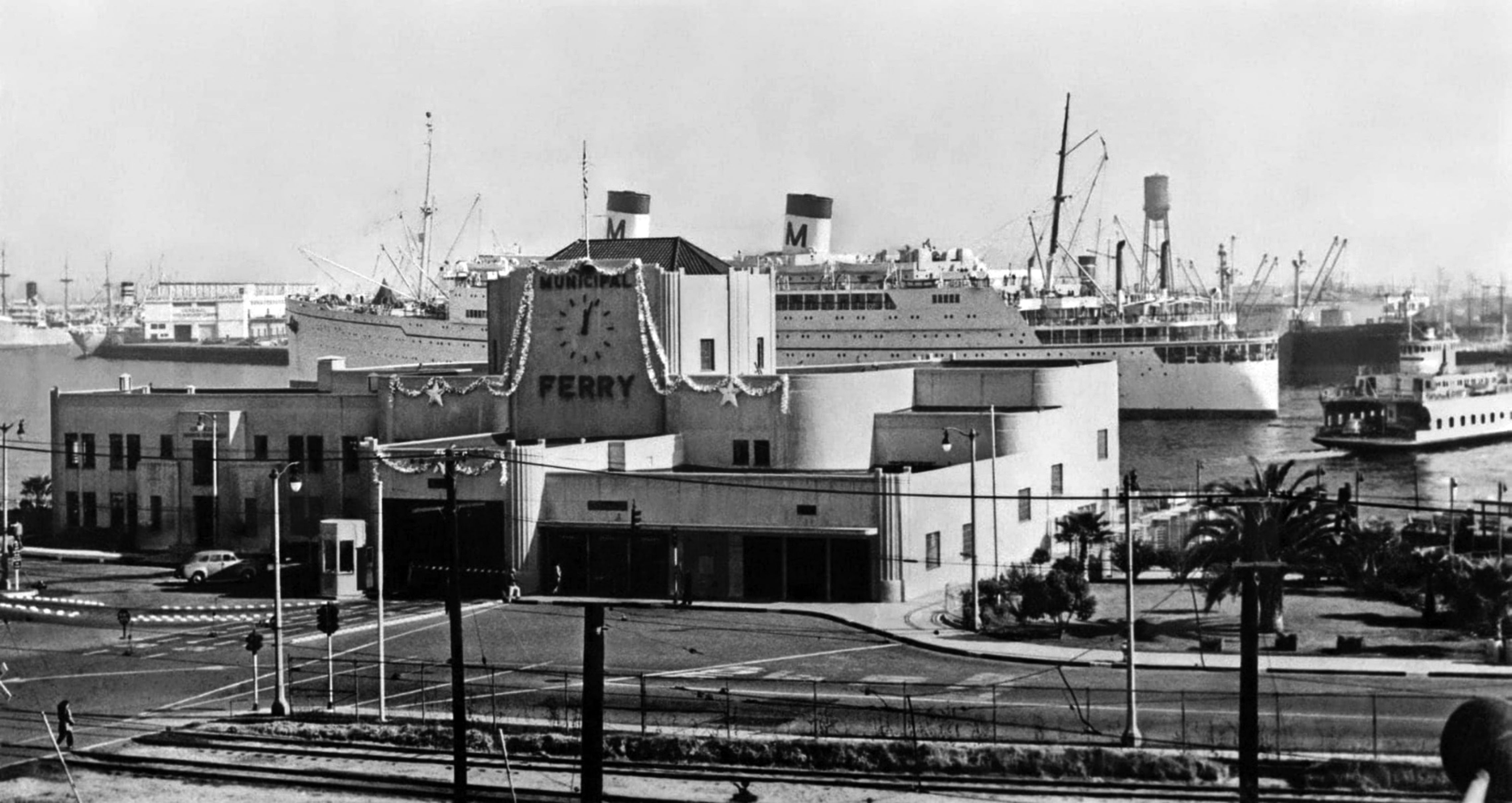 |
|
| (1950s)^ - Matson Line's S.S. Lurline gliding by San Pedro's Municipal Ferry Building. |
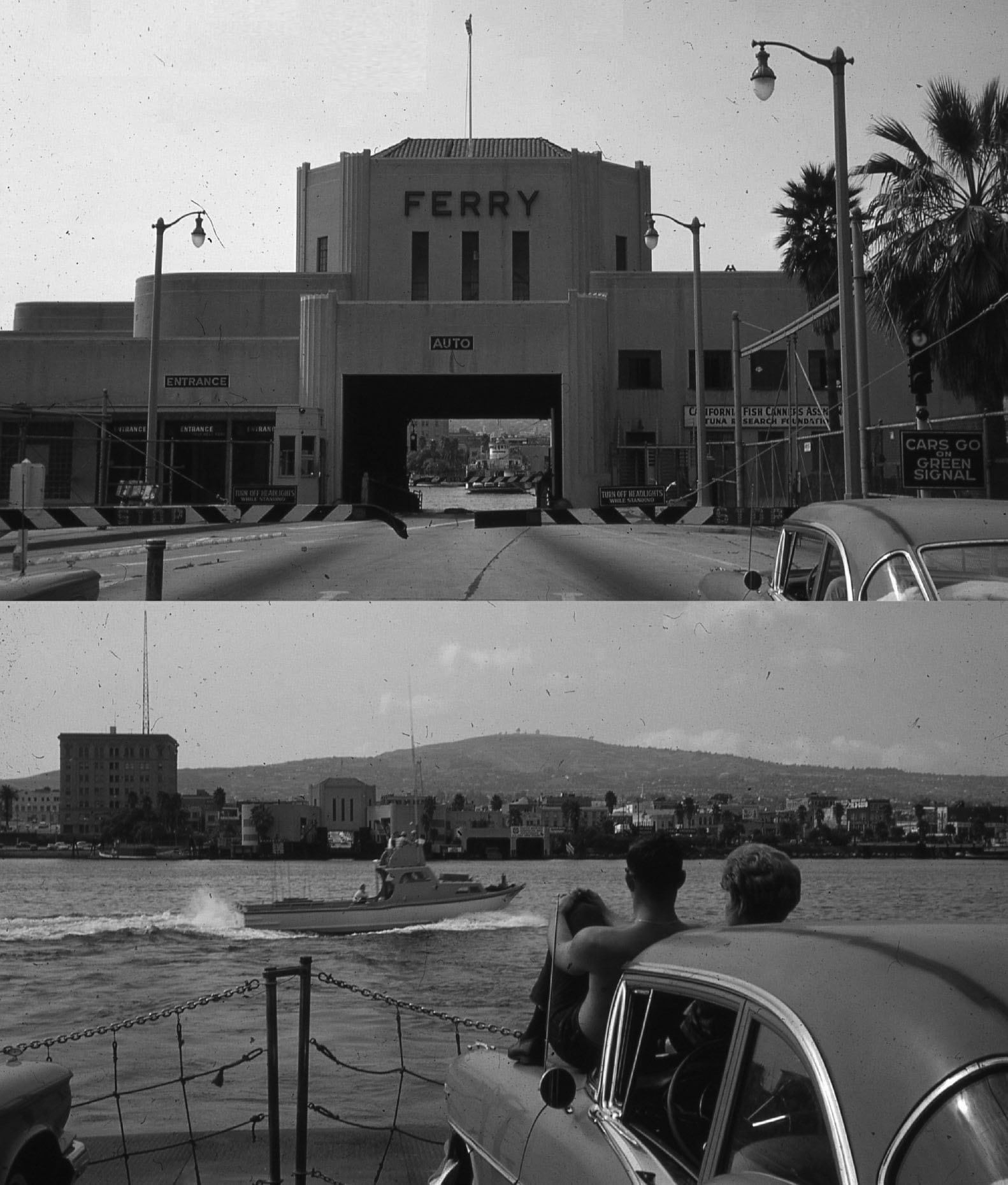 |
|
| (1957)* - Riding the Municipal Ferry from Terminal Island to San Pedro. |
Historical Notes Ferry service discontinue after 22 years when the new Vincent Thomas Bridge opened in 1963. |
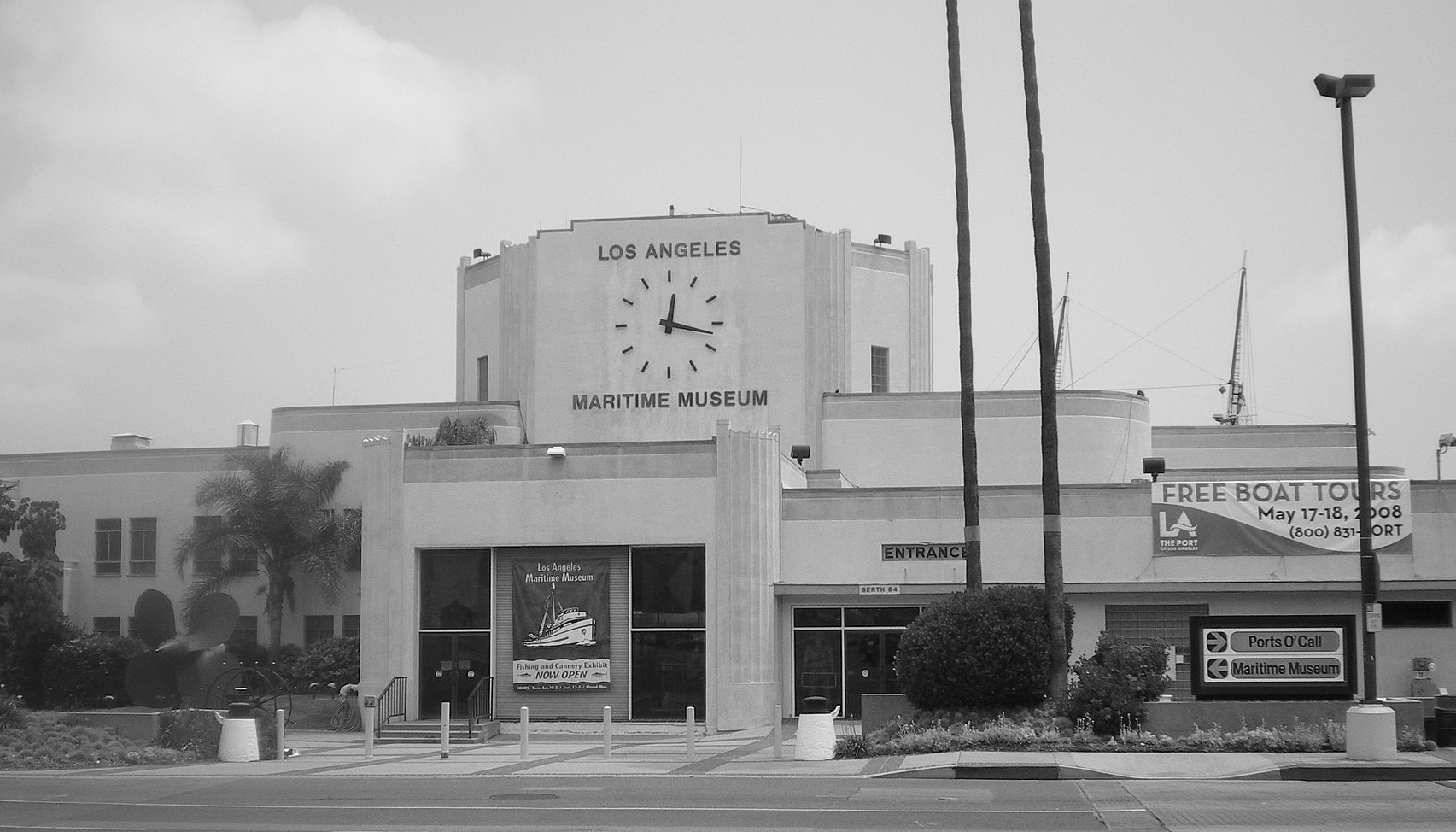 |
|
| (2008)* – The Los Angeles Maritime Museum housed in the old San Pedro Municipal Ferry Building. |
Historical Notes Beginning in 1976 the building exterior was restored and the interior remodeled into the Los Angeles Maritime Museum, which opened in 1979. It is the largest maritime museum on the West Coast. |
Ports O' Call Village
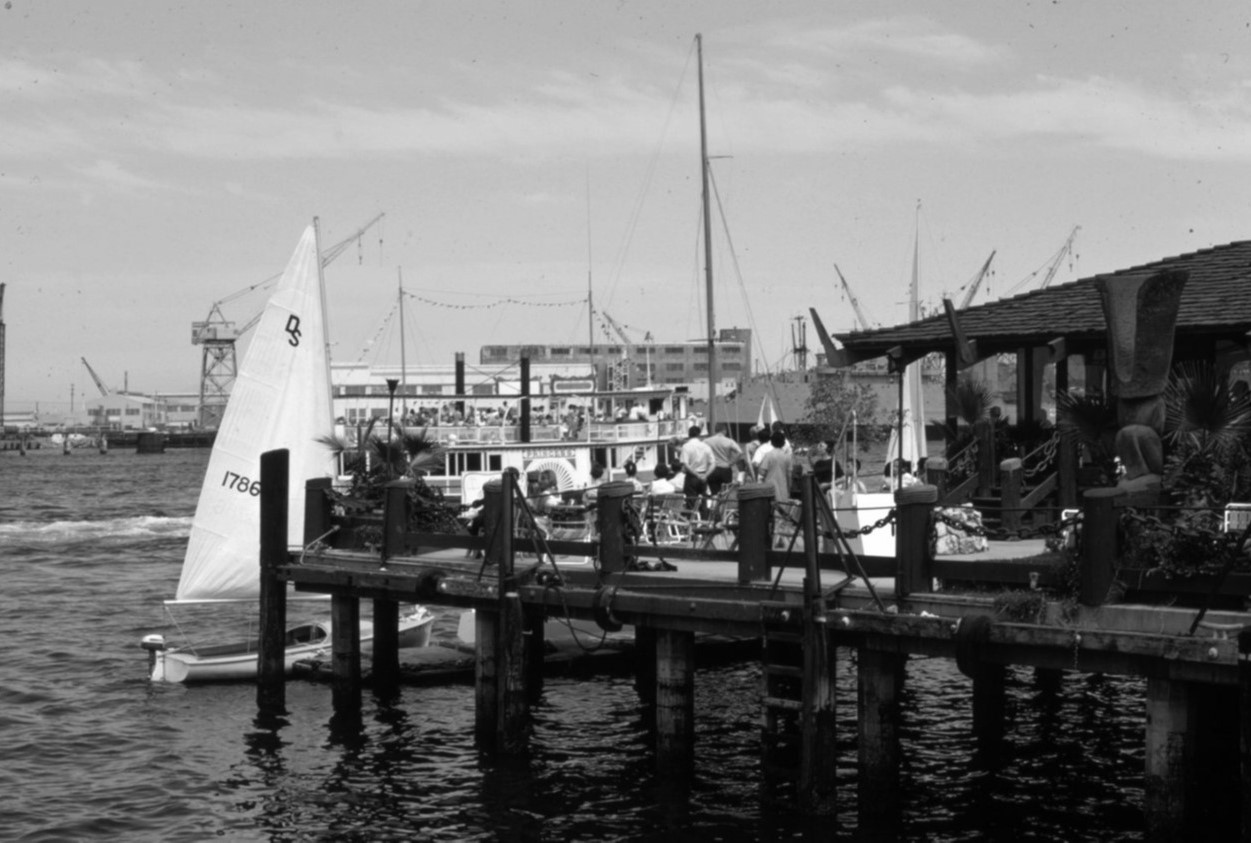 |
|
| (1967)* - The northern side of the Ports O' Call Restaurant in San Pedro. Princess, a harbor cruise boat, is seen just beyond the restaurant patio, and several cargo ships and container cranes are seen throughout the harbor. |
Historical Notes Ports O' Call, an entertainment and shopping complex modeled after a 19th Century New England fishing village, opened in 1963 and experienced steady popularity for many years. As tastes began to change in the late-1980s, some attractions were removed but many restaurants continued to serve customers for another 30 years. Despite lawsuits and public outcry, all of the Ports O' Call structures, except the San Pedro Fish Market, were demolished in 2018 to make way for West Harbor, a new development designed by James Corner Field Operations.^ |
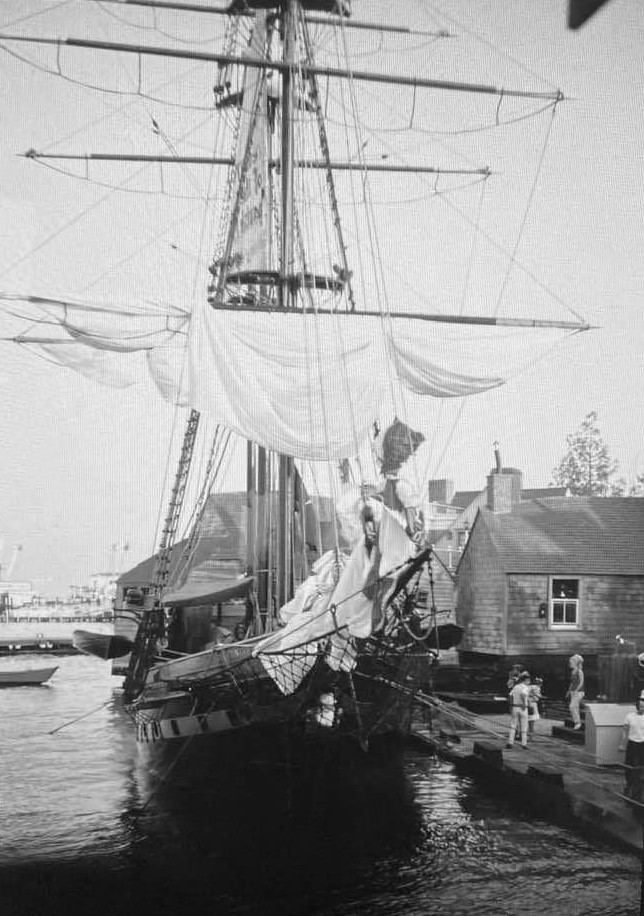 |
|
| (1960s)* - Ports O’Call, San Pedro. |
Historical Notes In 2016, the Los Angeles Board of Harbor Commissioners approved a 50-year lease for the new San Pedro Public Market on the site. Plans for San Pedro Public Market include restaurants, shopping, fresh markets, office space and a waterfront promenade with outdoor space and an open-air amphitheater.^ |
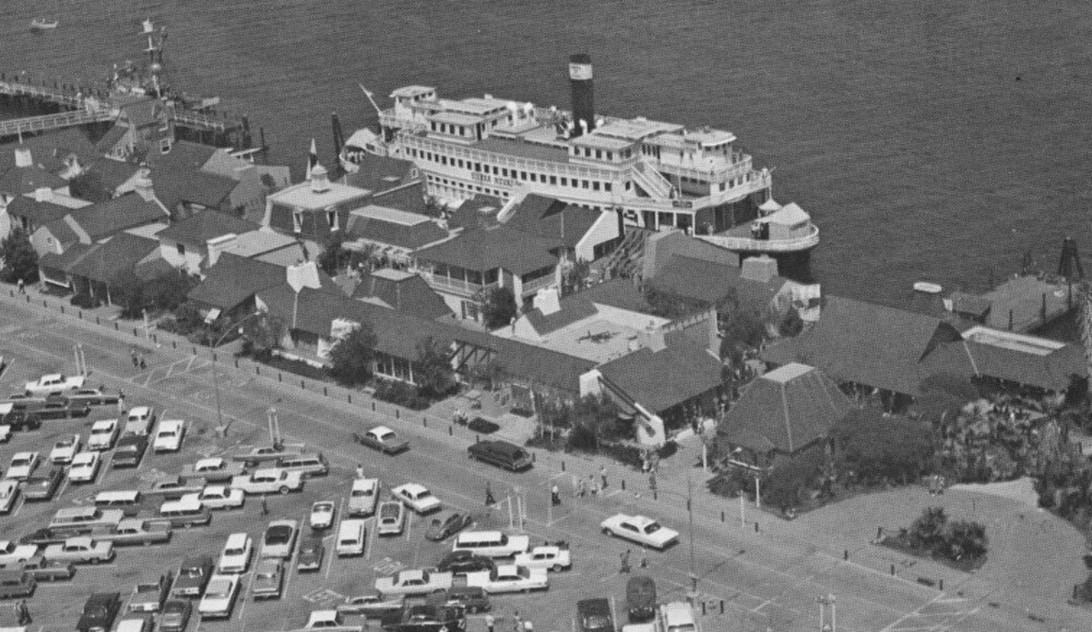 |
|
| (1960s)* - Postcard view showing Ports O’Call Village. |
Vincent Thomas Bridge
 |
|
| (ca. 1960)*^^ - The Vincent Thomas Bridge under construction. It is the fourth largest suspension bridge in the State of California. |
Historical Notes The Vincent Thomas Bridge is the first suspension span ever to be built on steel piles — 990 of them were sunk to hold it up, instead of the more traditional concrete supports. And it is the first to be built entirely without rivets; the steel is welded together. |
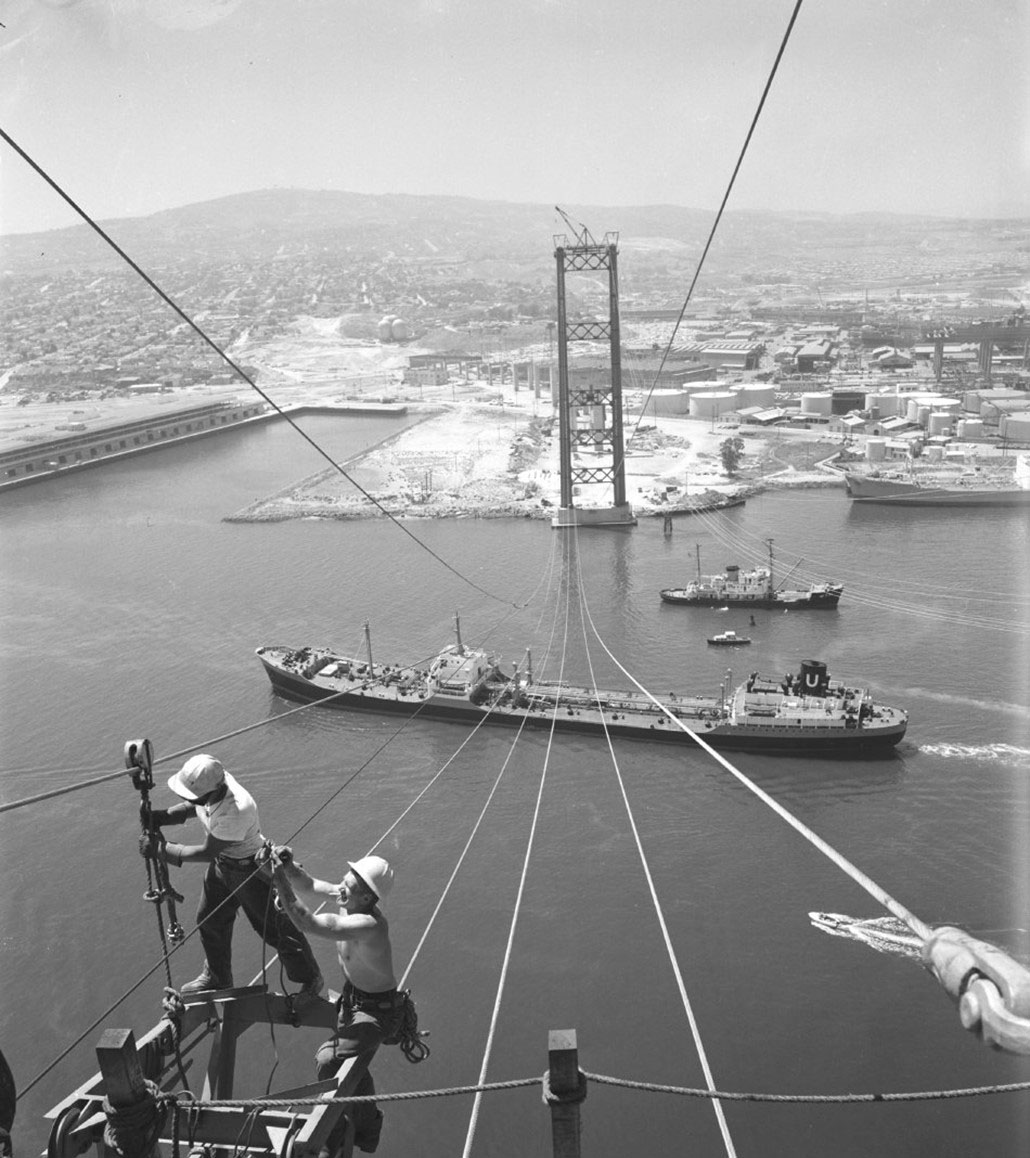 |
|
| (1962) - High Wire Act! - Construction workers work on the suspension cables of the Vincent Thomas. L.A. Harbor Department Photo |
Historical Notes The bridge is 6,060 feet long, 52 feet wide, 365 feet tall. Its longest span is 1,500 feet, and the clearance below is 185 feet. |
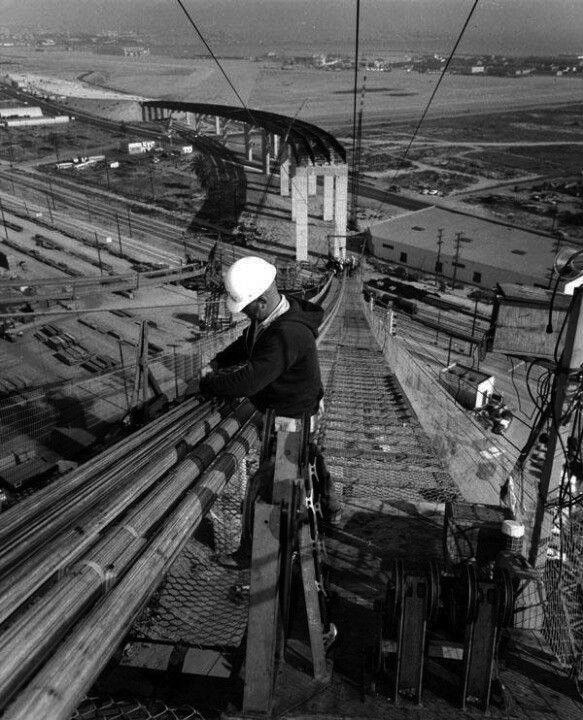 |
|
| (1962)^ – A construction worker is seen working on the suspension cable on top of one of the two Vincent Thomas Bridge towers. |
Historical Notes Construction of the bridge required: 14,100 tons of steel; 1,270 tons of suspension cable; 92,000 tons of Portland cement; and 13,000 tons of lightweight concrete. |
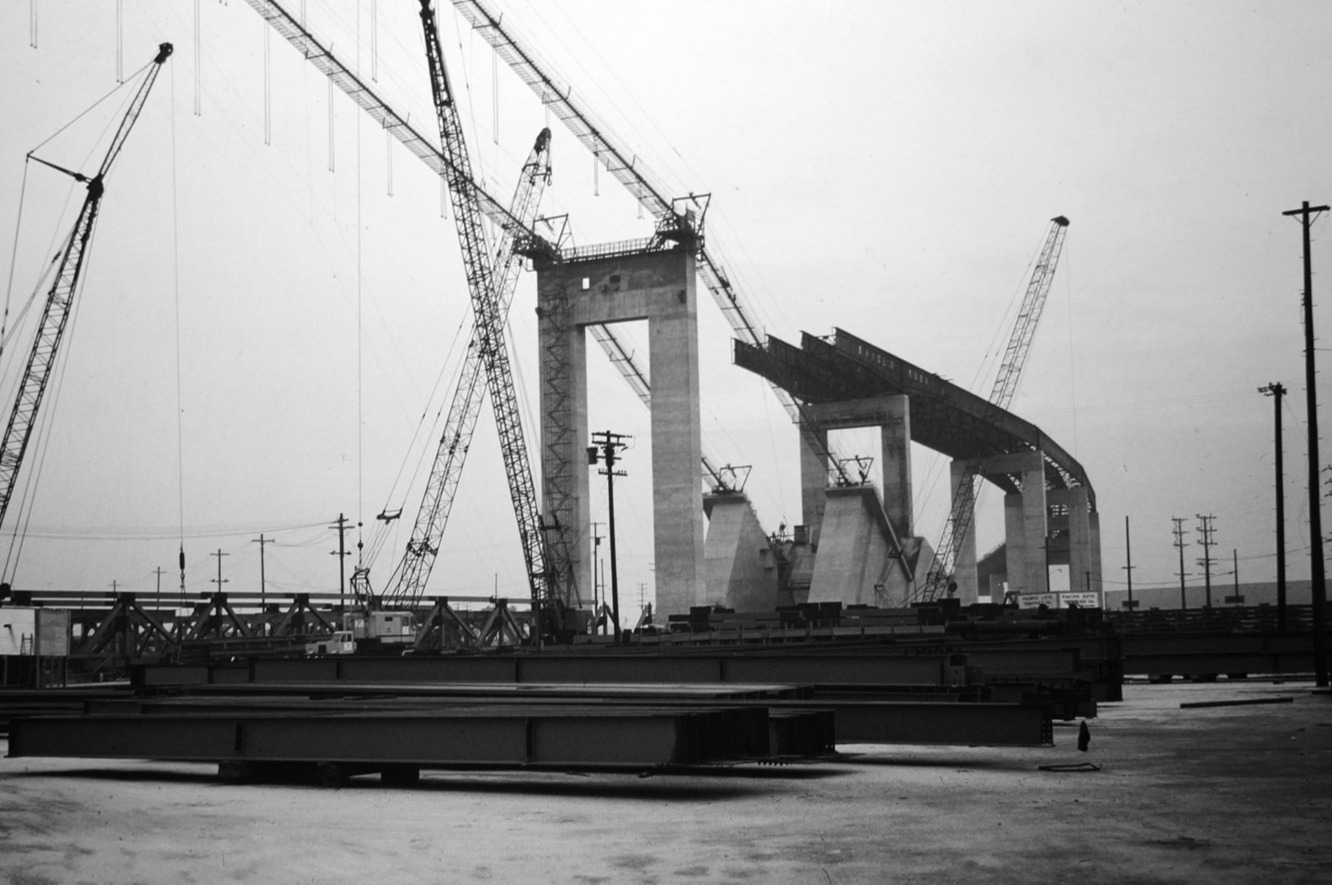 |
|
| (1962)* - The Vincent Thomas Bridge in the early stages of construction with steal beams (girders) still awaiting to be positioned in place. Photo courtesy of Darrel Cowan |
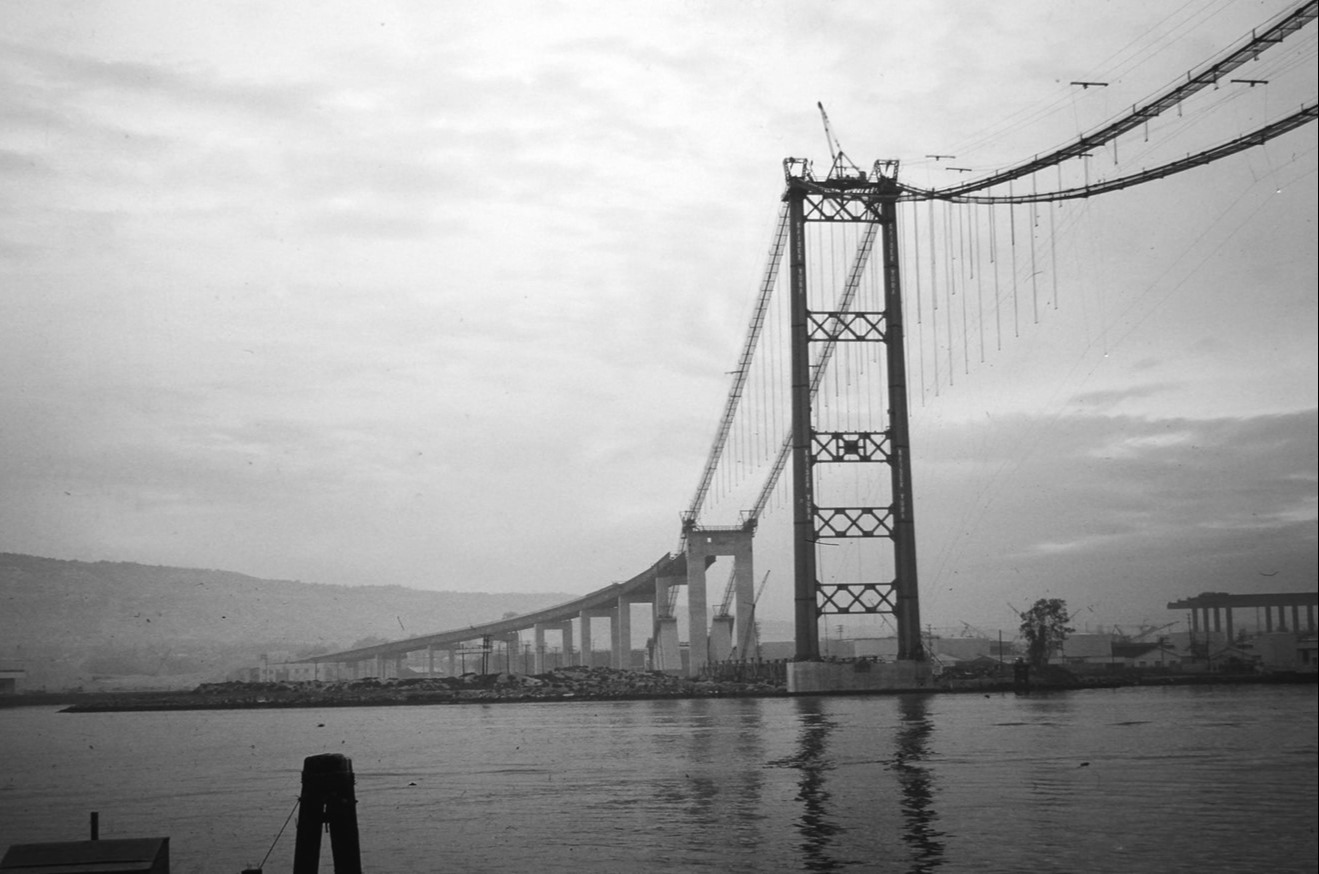 |
|
| (1962)* - The Vincent Thomas Bridge beginning to take form. Photo courtesy of Darrel Cowan |
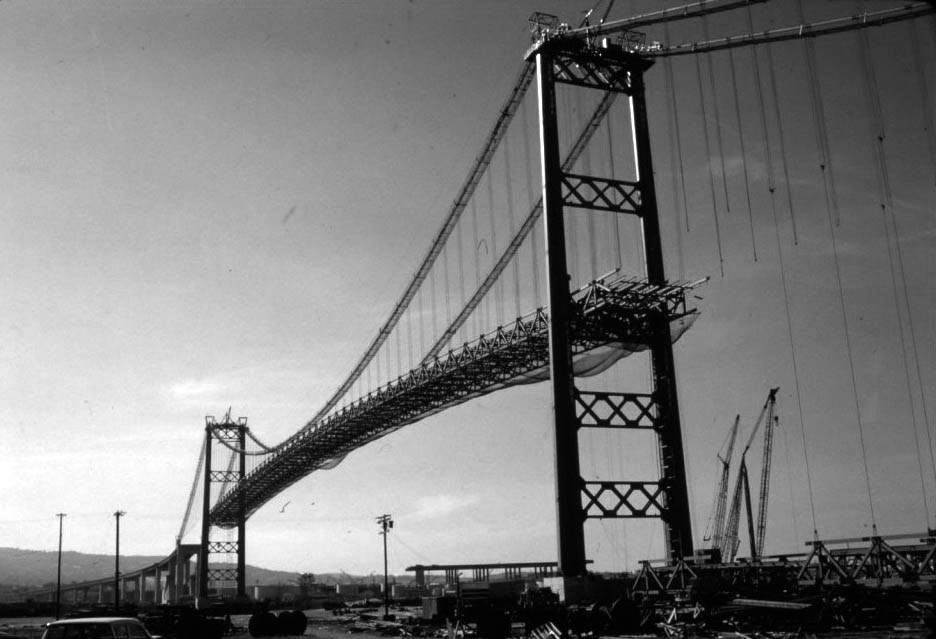 |
|
| (1963)^* - View of the Vincent Thomas Bridge showing its longest span nearly completed. |
Historical Notes The main span of the Vincent Thomas Bridge is 1,500 feet long as compared to the Golden Gate Bridge at 4,200 feet long. |
 |
|
| (1963)* - A crowd of mostly schoolchildren gathers to watch steel truss raising during Vincent Thomas Bridge construction. |
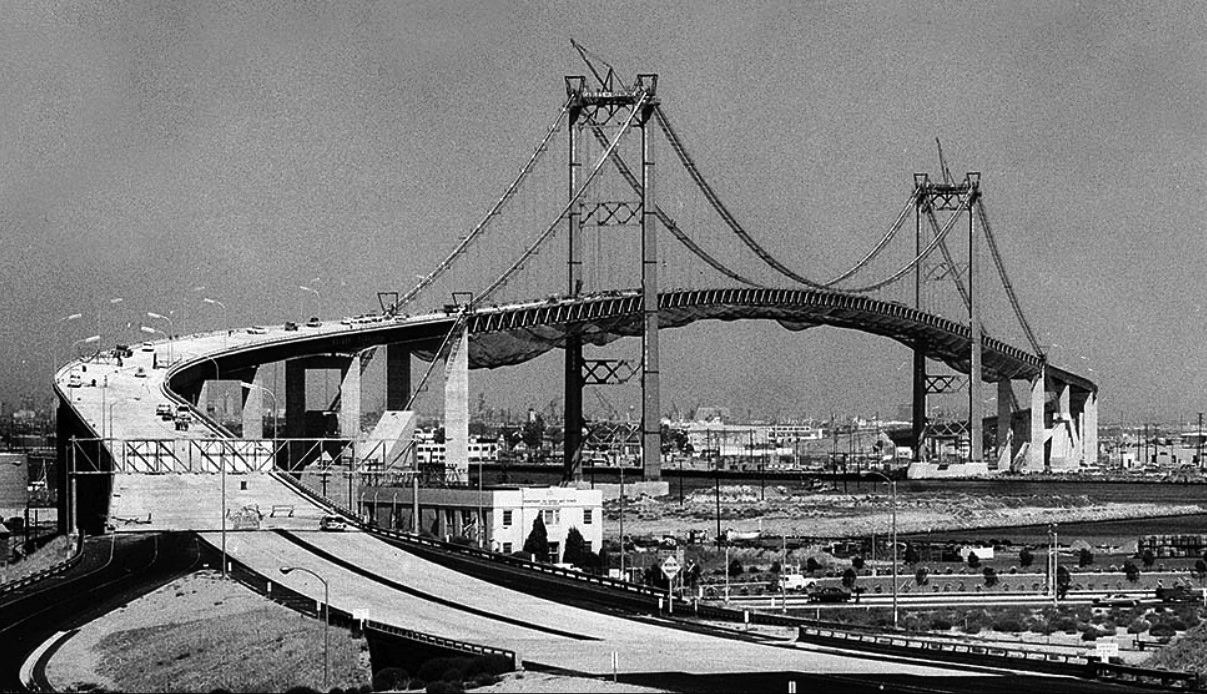 |
|
| (1963)^** - The Vincent Thomas Bridge nears completion between San Pedro and Terminal Island. |
Historical Notes California Assemblyman Vincent Thomas, who represented San Pedro, spent 19 years beginning in 1940 arguing for the 16 different pieces of legislation that were necessary for its construction. When the bridge opened in 1963, Thomas was the longest-serving assembyman. In 1961, the legislature passed a special Concurrent Resolution 131 in order to name it after him while he was still serving.*^ |
 |
|
| (1963)*^^^ - Panoramic view showing The Islander ferry in its last days of service with the nearly completed Vincent Thomas Bridge in the distance and the Municipal Ferry Building in the foreground. |
Historical Notes In 1963, the Vincent Thomas Bridge was completed connecting the mainland to Terminal Island, and there was no longer a need for ferry service. Accordingly, the ferry service was terminated. The terminal building on the Terminal Island side was demolished, but the building on the San Pedro side was used for many years as an office building by the Los Angeles Harbor Department. As the ferry building began to deteriorate, citizens of San Pedro sought to have it restored. They succeeded in having the building designated as a Historic-Cultural Monument (No. 146) in 1975, and starting in 1976 the building was renovated and converted into the Los Angeles Maritime Museum. The museum opened in 1979. The building was listed in the National Register of Historic Places in 1996. |
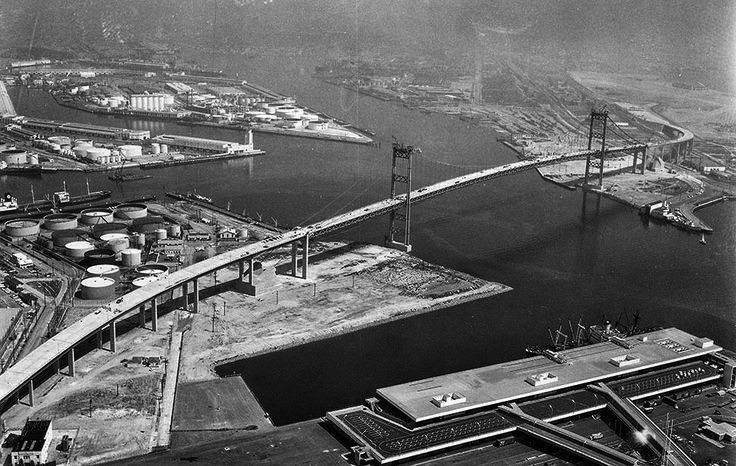 |
|
| (1963)* – Aerial view looking down at the newly completed Vincent Thomas Bridge. |
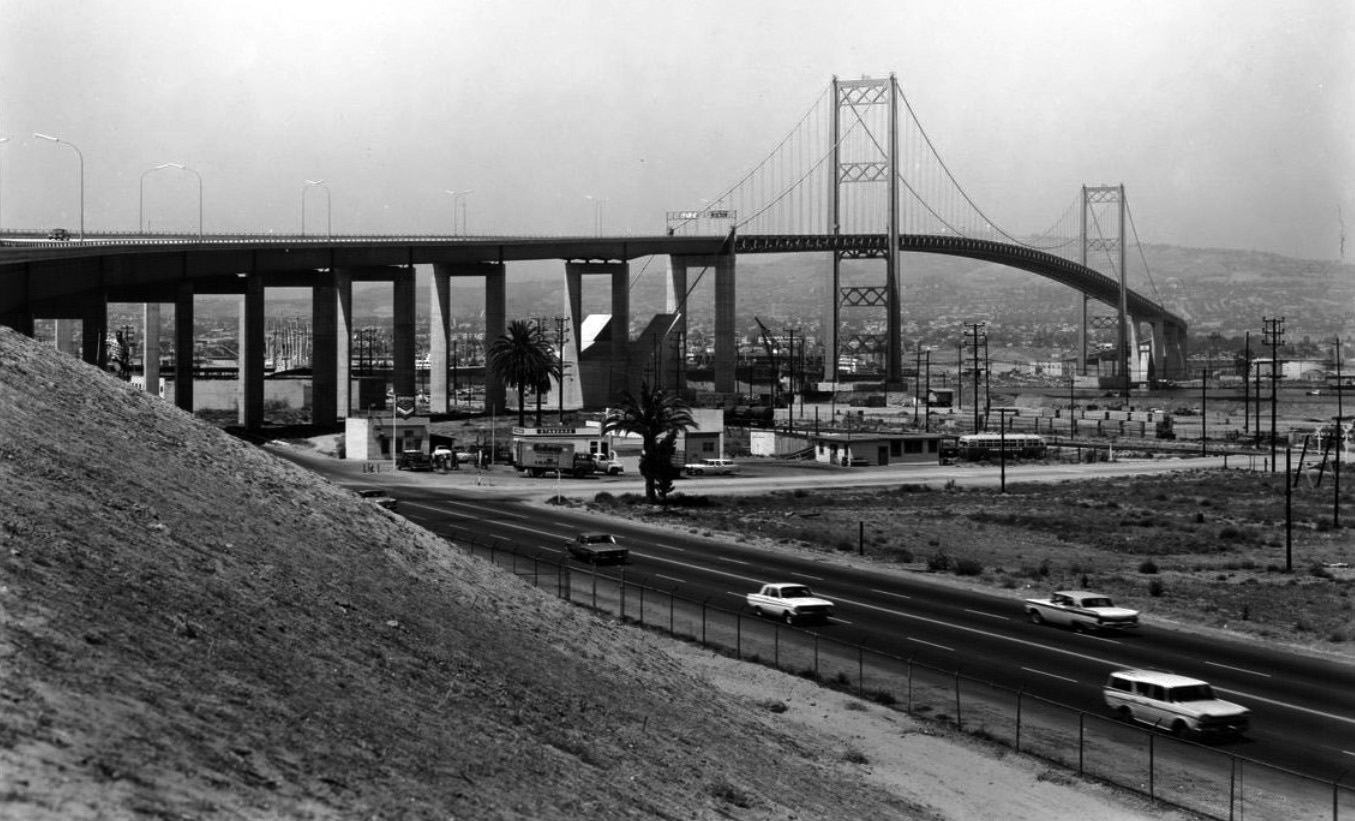 |
|
| (1963)* – View from the hillside showing the newly completed Vincent Thomas Bridge. |
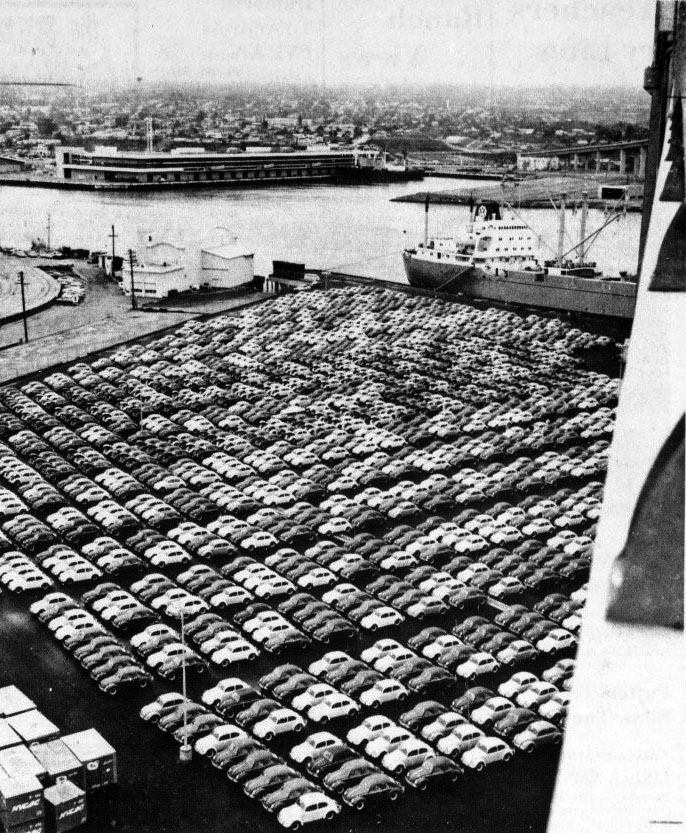 |
|
| (ca. 1964)^ - View looking down from the Vincent Thomas Bridge showing VW Beetles as far as the eye can see. |
Historical Notes The Volkswagen Beetle, or informally the Volkswagen Bug, was produced from 1938 until 2003. The need for this kind of car, and its functional objectives, were formulated by Adolf Hitler, leader of Nazi Germany, wishing for a cheap, simple car to be mass-produced for the new road network of his country. He contracted Porsche in 1934 to design and build it to his exacting standards. Ferdinand Porsche and his team took until 1938 to finalize the design. This is one of the first rear-engined cars. With over 21 million manufactured in an air-cooled, rear-engined, rear-wheel drive configuration, the Beetle is the longest-running and most-manufactured car of a single design platform, worldwide. |
.jpg) |
|
| (ca. 1964)^ - One of the world’s largest car carriers at the time, Volkswagen ship Johann Schulte, arrives at the Port of Los Angeles. View shows 100s of VW Beetles, all lined up and waiting for transport to dealerships. The newly opened Vincent Thomas Bridge stands tall in the background. |
Historical Notes The original 25 hp Beetle was designed for a top speed around 100 km/h (62 mph), which would be a viable cruising speed on the Reichsautobahn system. As Autobahn speeds increased in the postwar years, its output was boosted to 36, then 40 hp, the configuration that lasted through 1966 and became the "classic" Volkswagen motor. |
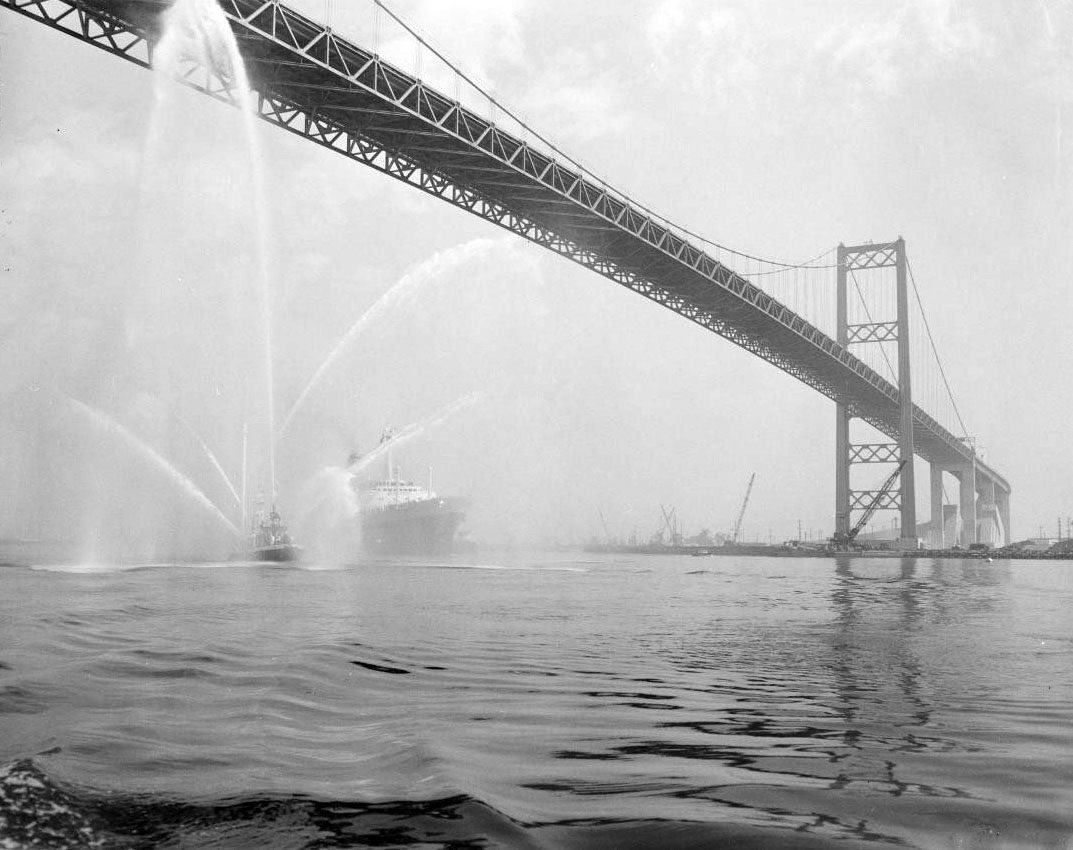 |
|
| (1964)* – S.S. Statendam’s gets a water salute on its departure as it sails under the Vincent Thomas Bridge. |
Historical Notes SS Statendam was an ocean liner of the Holland America Line built in 1957. She was bought by the Paquet group in 1982 and renamed Rhapsody and sold again to the Lelakis group in 1986. Later she became part of the Regency Cruises fleet and was named Regent Star in the Regency fleet. She was laid up after the Regency Cruises bankruptcy and remained in poor condition for many years. She was scrapped in Alang, India in 2004. |
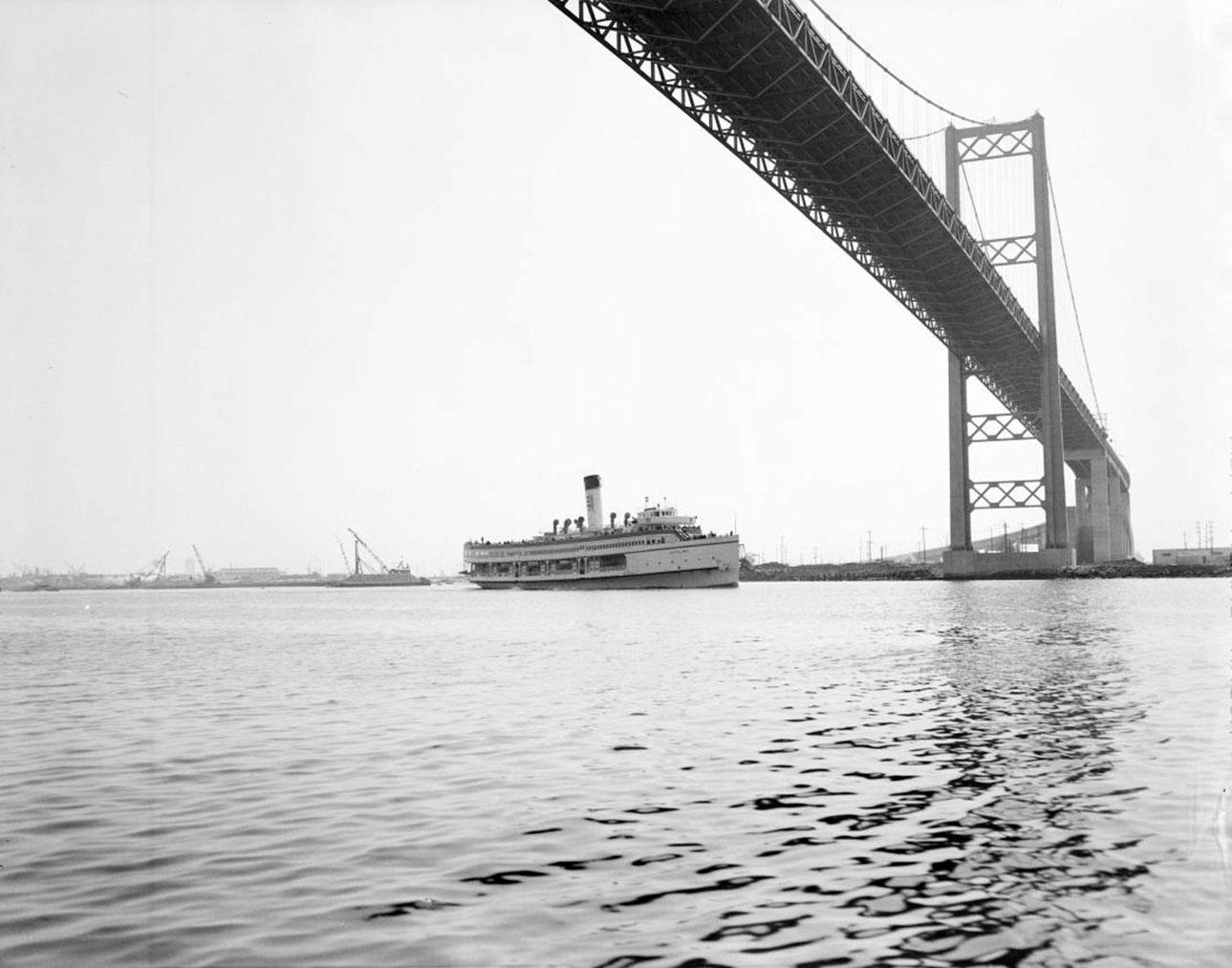 |
|
| (1964)* – SS Catalina departs the Port of LA on a short cruise to Santa Catalina Island. |
Historical Notes SS Catalina, also known as The Great White Steamer, was a 301-foot steamship built in 1924 that provided passenger service on the 26-mile passage between Los Angeles and Santa Catalina Island from 1924 to 1975. According to the Steamship Historical Society of America, Catalina has carried more passengers than any other vessel anywhere. From August 25, 1942 until April 22, 1946 the ship served as the Army troop ferry transporting more than 800,000 troops and other military personnel between embarkation camps and the departure piers. After a period of service as a floating discothèque, the ship ran aground on a sandbar in Ensenada Harbor in 1997 and partially sank on the spot. It was scrapped in 2009. |
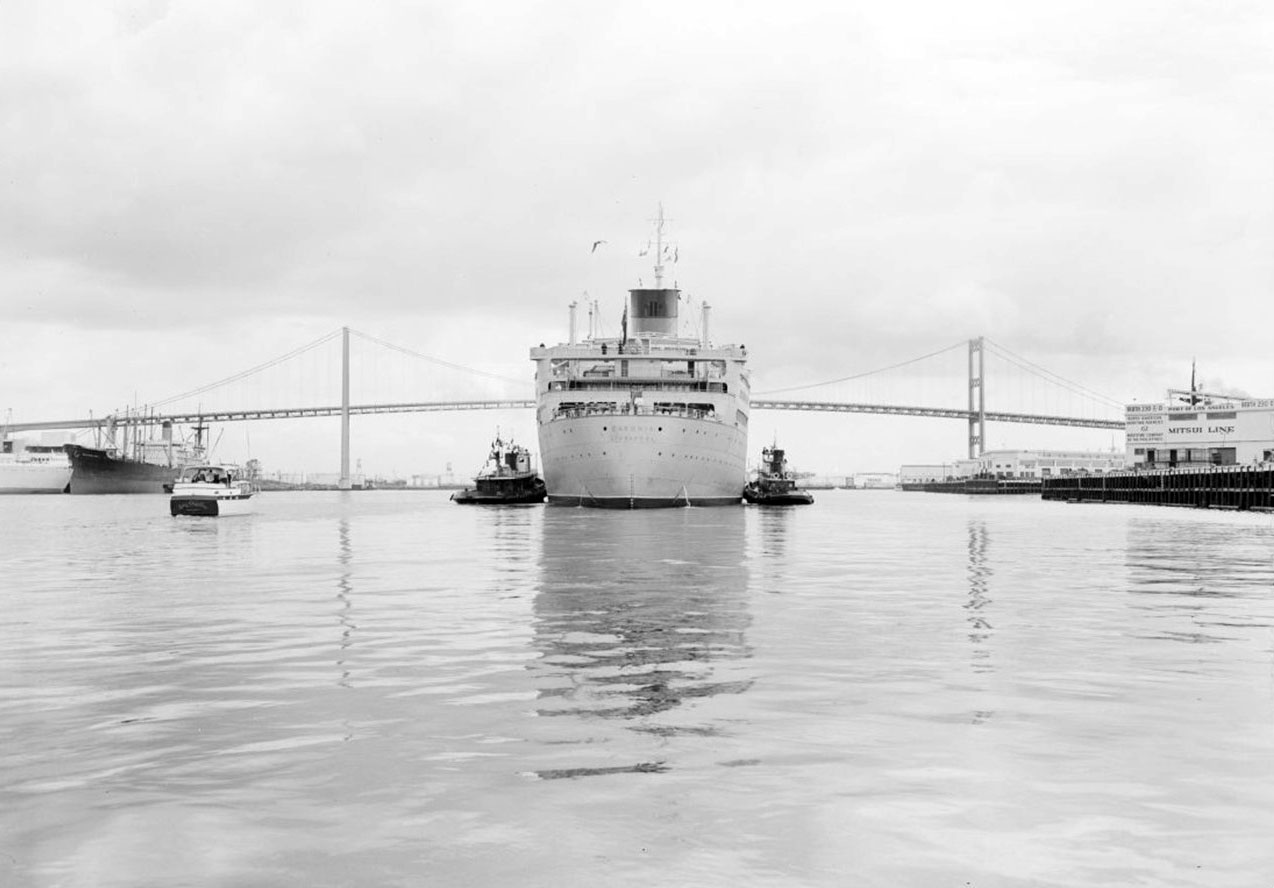 |
|
| (1964)* - M.S. Caronia arrives in the Port of L.A. with the Vincent Thomas Bridge seen in the background. |
Historical Notes RMS Caronia was a passenger ship of the Cunard Line (then Cunard White Star Line). Launched on 30 October 1947, she served with Cunard until 1967. She was initially nicknamed the "Green Goddess" after Liverpool's green and white "Green Goddess" trams, and the nickname stuck. She was one of the first "dual-purpose" ships, built both for 2-class transatlantic crossings and all 1st-class cruising. After leaving Cunard she briefly served as SS Caribia in 1969, after which she was laid up in New York until 1974 when she was sold for scrap. While being towed to Taiwan for scrapping, she was caught in a storm on 12 August. After her tow lines were cut, she repeatedly crashed on the rocky breakwater outside Apra Harbor, Guam and broke into three sections. |
 |
|
| (1965)* - Daytime view of the Vincent Thomas Bridge as the fog burns off. |
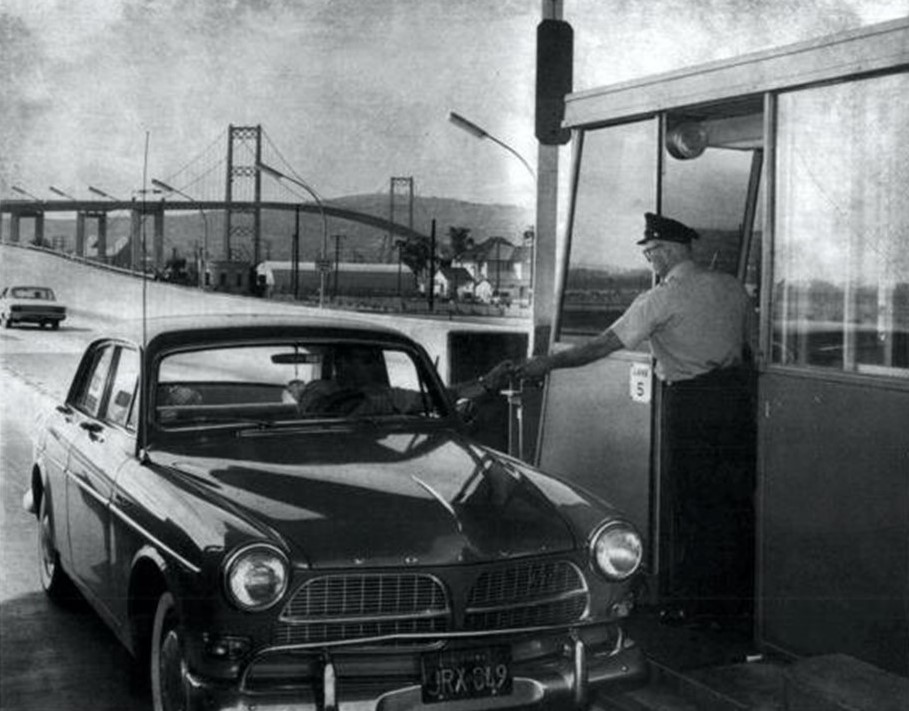 |
|
| (1965)* - A Volvo stops to pay the 25-cent toll to cross the Vincent Thomas Bridge. |
Historical Notes When the Bridge opened in 1963, a 25-cent toll was collected in each direction. On grand opening day, Assemblyman Thomas paid the first toll. In 1983, the toll increased to 50 cents for westbound traffic and was free for eastbound traffic. In 2000, the Bridge was considered “paid for” and the toll was repealed. |
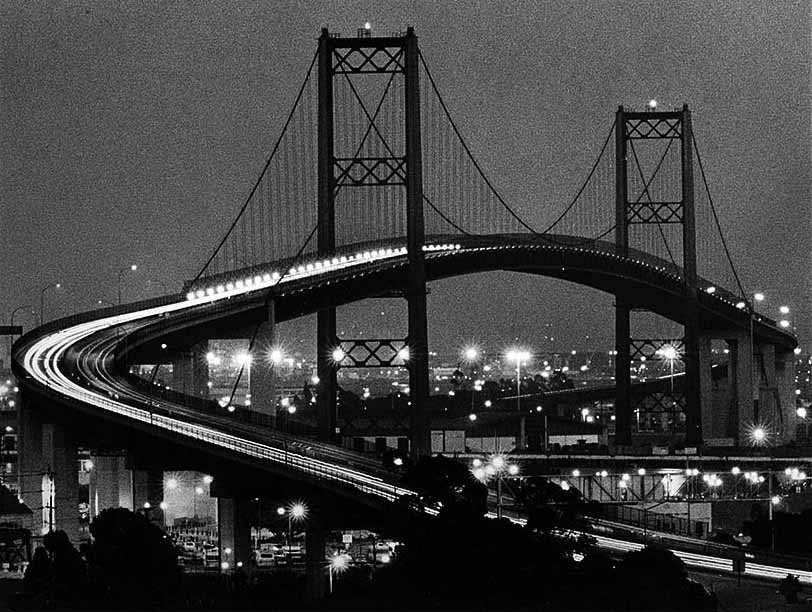 |
|
| (1988)^** - Traffic streams across the Vincent Thomas Bridge at dusk. |
Historical Notes Skeptics predicted it would serve fewer than 2,000 vehicles a day and that it would take taxpayers 40 years to pay for the $21-million structure. In its first month of operation, however, the bridge served a daily average of 9,631 vehicles. And most of the debt was paid off within 20 years. |
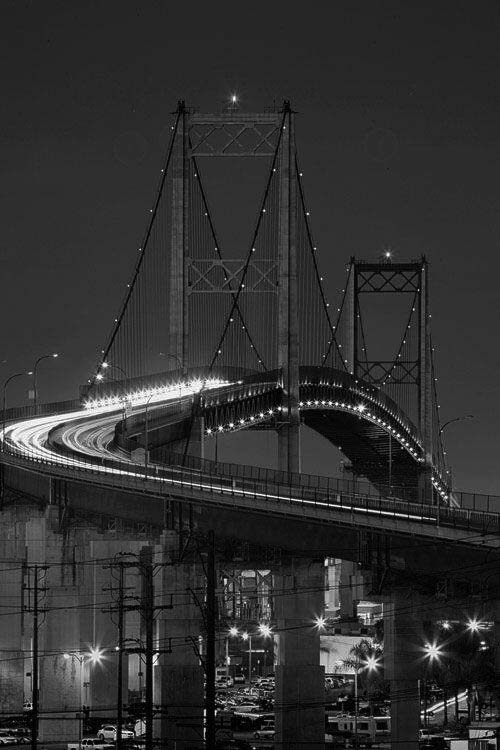 |
|
| (ca. 2010s)* – Night view showing the Vincent Thomas Bridge. |
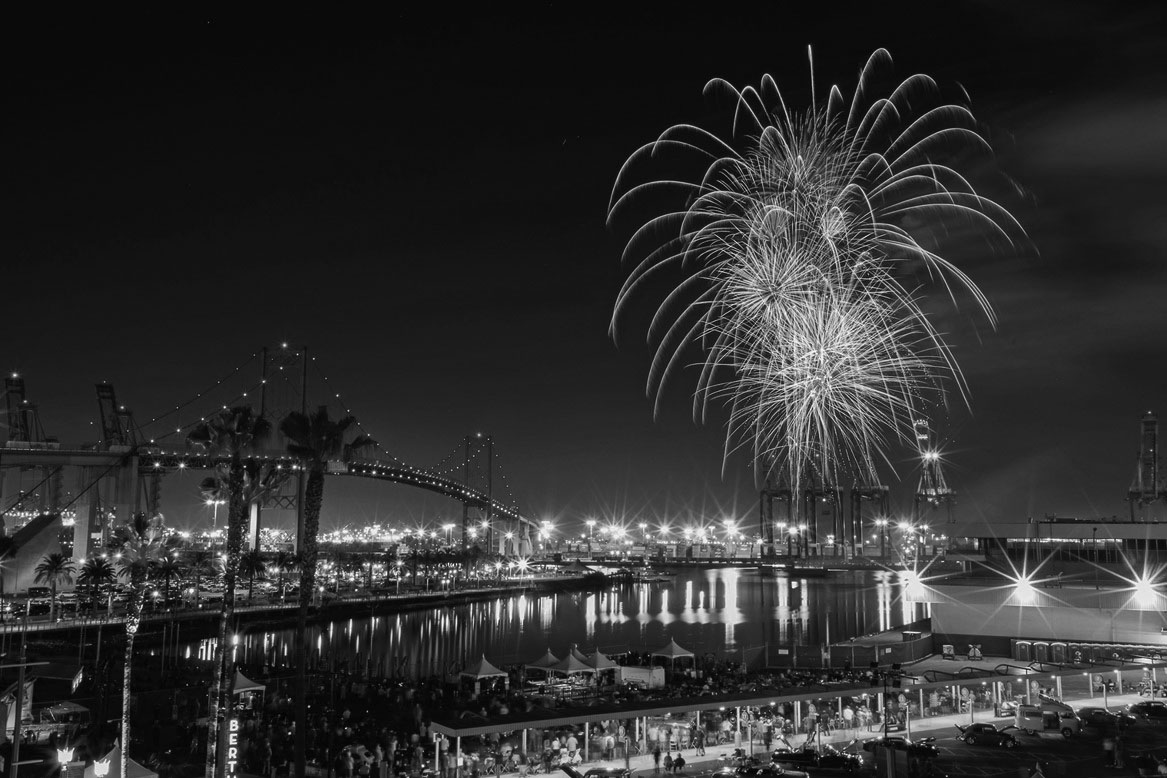 |
|
| (2020)* – Fireworks at Port of Los Angeles by the Vincent Thomas Bridge. Courtesy of Port of Los Angeles |
.jpg) |
|
| (2022)* - Contemporary view of Vincent Thomas Bridge with cranes seen in the distance. – Photo by Howard Gray |
Historical Notes The Vincent Thomas Bridge now carries 26,500 vehicles a day. It is widely credited with providing a crucial transportation link to the Port of Los Angeles and of aiding the port’s phenomenal growth. |
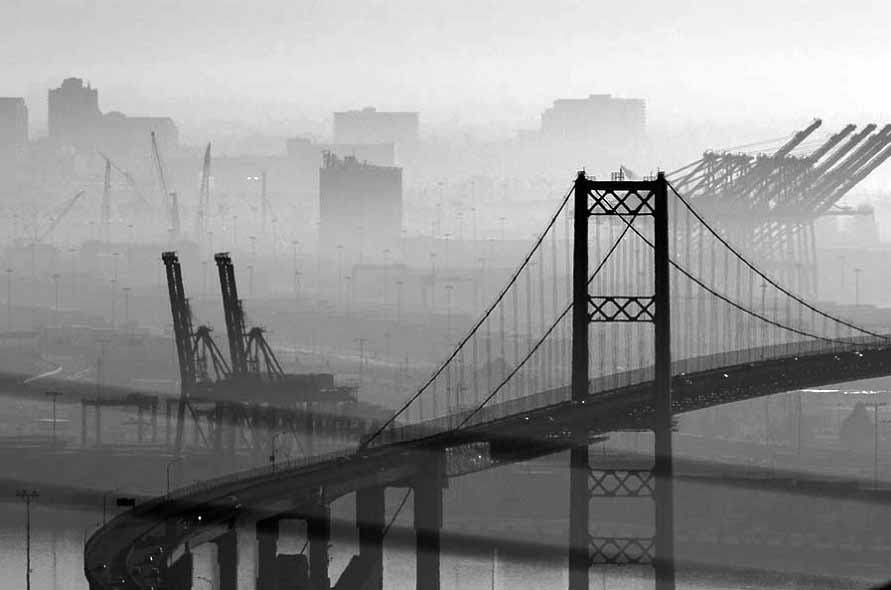 |
|
| (2013)* - Vincent Thomas Bridge on a foggy morning from West Santa Cruz Street, Rancho Palos Verdes. |
Historical Notes San Pedro Harbor, part of the Port of Los Angeles, employs various cranes critical to its operations and environmental goals. The port is transitioning to sustainable technologies, replacing older diesel cranes with electric and hybrid models to reduce emissions significantly. Notable advancements include the introduction of an electric mobile ship-loading crane and a hydrogen fuel cell-powered crane, both of which eliminate emissions. These efforts align with the port's commitment to becoming a zero-emission facility while maintaining efficient cargo handling. |
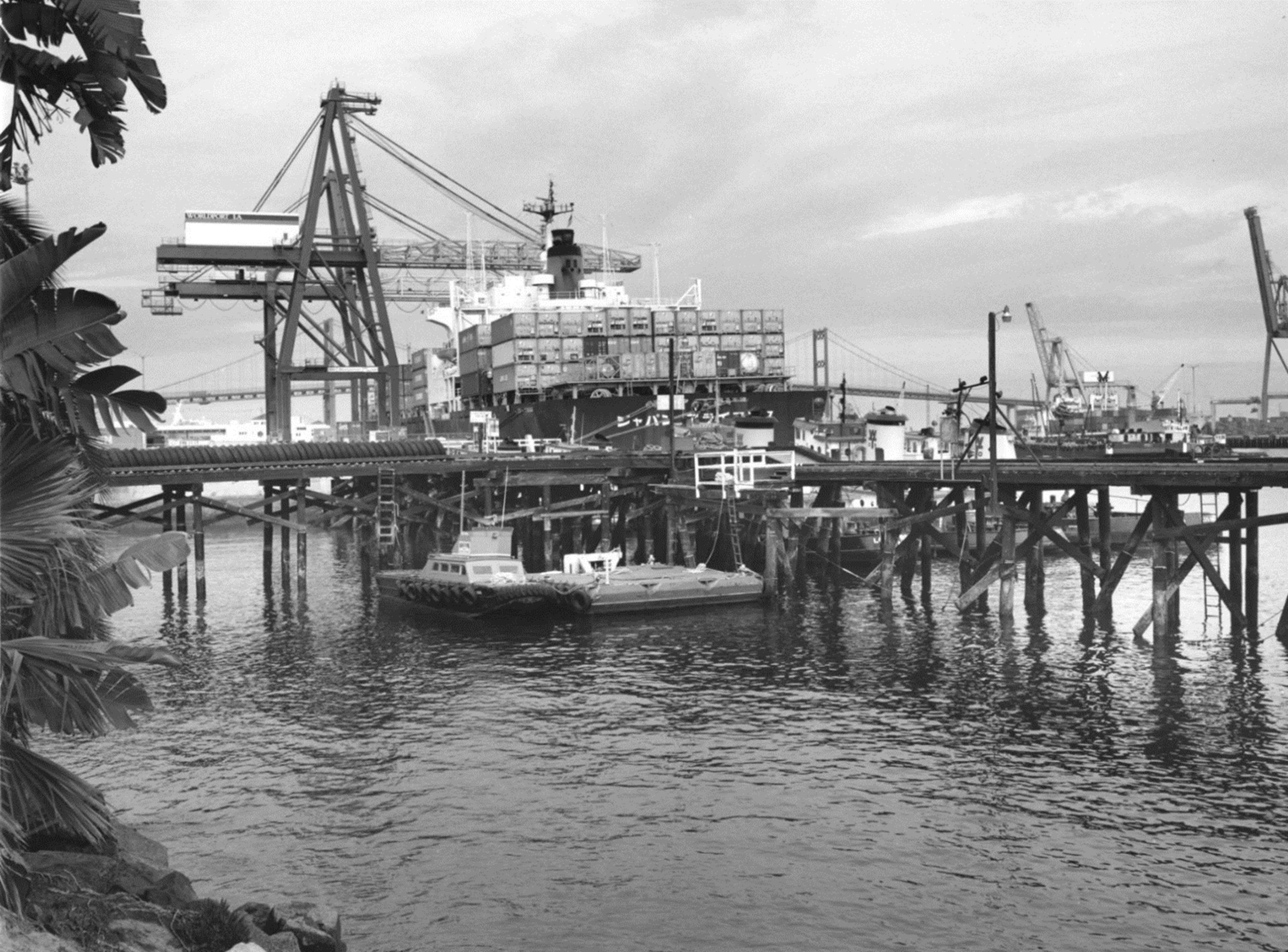 |
|
| (1987)* - View of a ship being loaded at Los Angeles Harbor, with cranes placing containers onto its deck. In the foreground, two wooden piers are visible, while the Vincent Thomas Bridge can be seen in the distance. Photo by William Reagh. |
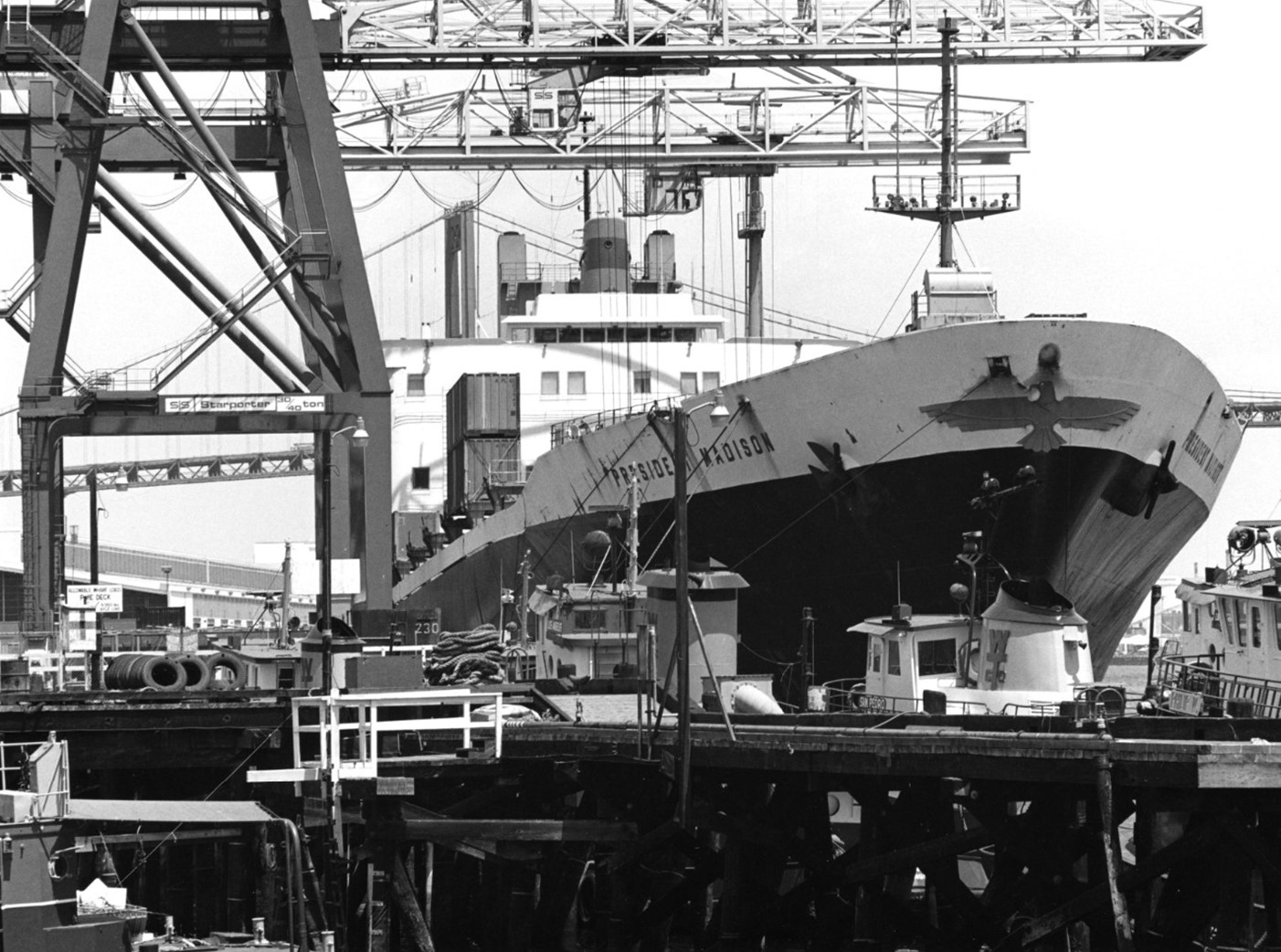 |
|
| (1985)* - View of the San Pedro waterfront. Shows container ship President Madison docked next to loading crane; four tugboats in foreground. Photo by William Reagh. |
 |
|
| (2010s)* – Harbor view as seen from the USS IOWA*. |
Historical Notes USS Iowa was the lead ship of the last class of U.S. Navy battleships to be built by the United States. The battleship was originally commissioned in 1943, and served during World War II, the Korean War, and through the Cold War. Iowa earned 11 battle stars during her career and hosted three U.S. Presidents, ultimately earning the nicknames Battleship of Presidents and Big Stick. Iowa was awarded to the Pacific Battleship Center on September 6, 2011 for display at the Port of Los Angeles in San Pedro, California – home to the United States Battle Fleet from 1919 to 1940. |
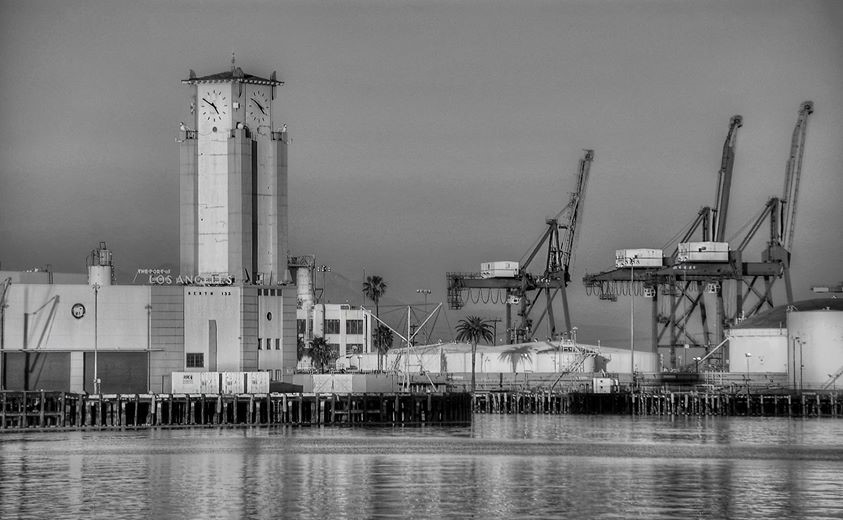 |
|
| (2009)* - View of the former cruise ship terminal at Berth 153 and the Port of Los Angeles clock tower. Photo taken February 2, 2009. |
Historical Notes The World Cruise Terminal at the Port of Los Angeles (passenger and cargo ternminals at Berth 93), opened in 1963. It was designed by AIA award-winning architect Edward H. Fickett, F.A.I.A. The terminal which hosted the original Love Boat TV series from 1977 to 1986 was modernized and expanded in 2010-11 to accommodate the most modern megaships. |
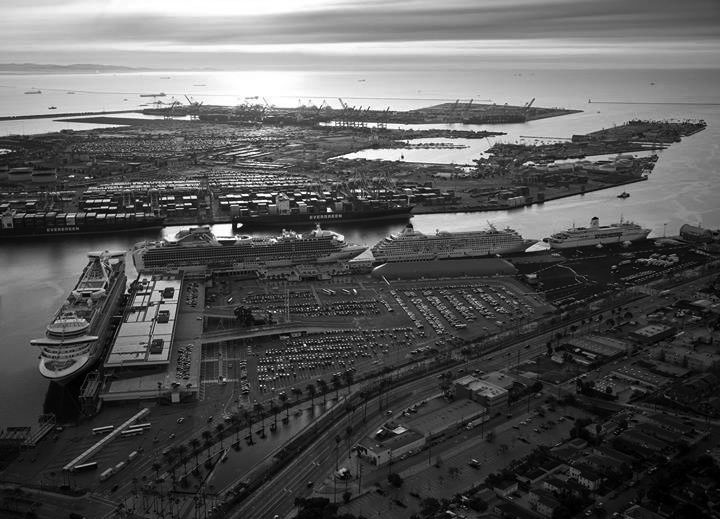 |
|
| (2011)* - A busy day in San Pedro with four cruise ships docked at the World Cruise Center. |
Historical Notes Located in the San Pedro District beneath the Vincent Thomas Bridge, the World Cruise Center is th largest cruise ship terminal on the West Coast. It has three passenger ship berths and transports over 1 million passengers annually. Cruise lines served: Carnival Cruise Lines, Celebrity Cruises, Crystal Cruises, Cunard Line, Disney Cruise Line, Holland America Line, Princess Cruises, Norwegian Cruise Line, Royal Caribbean International, Seabourn Cruise Line, Silver Sea Cruises. |
| (2009)* – The Vincent Thomas Bridge viewed from 11,500 feet. A cruise ship is seen in dock, as well as a cargo ship. The Victory Ship SS Lane Victory is also visible, moored between the cruise ship and the bridge. |
Historical Notes The spectacular Vincent Thomas Bridge is the "Official Welcoming Monument" to Los Angeles. The suspension bridge daily welcomes thousands of people to LA's major seaport district of San Pedro as well as the port. |
Then and Now
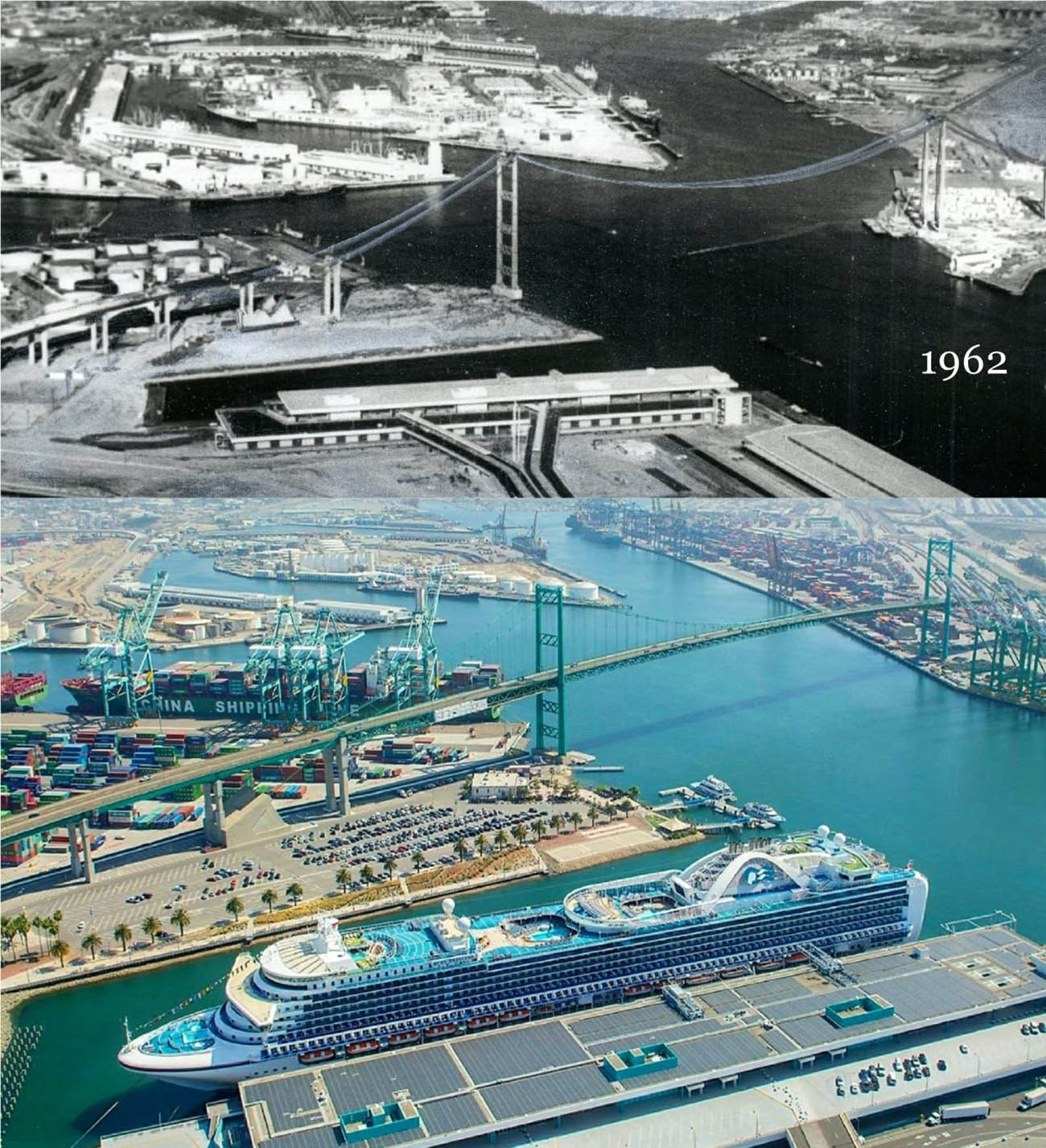 |
|
| (1962 - 2020s)* - Vincent Thomas Bridge with the Los Angeles World Cruise Center in the foreground. |
Historical Notes The Port of Los Angeles World Cruise Center began life as a freight and passenger terminal for the American President Lines. It was later converted into a cruise ship facility and became home to the “Love Boat”. As the size and number of cruises ships increased, the cruise ship center underwent a 21 million dollar major renovation and improvement project in 2003. Today the Port of Los Angeles World Cruise Center serves as the West Coast’s largest cruise port with hundreds of thousands of passengers using the facility. It can accommodate the biggest cruise ships. |
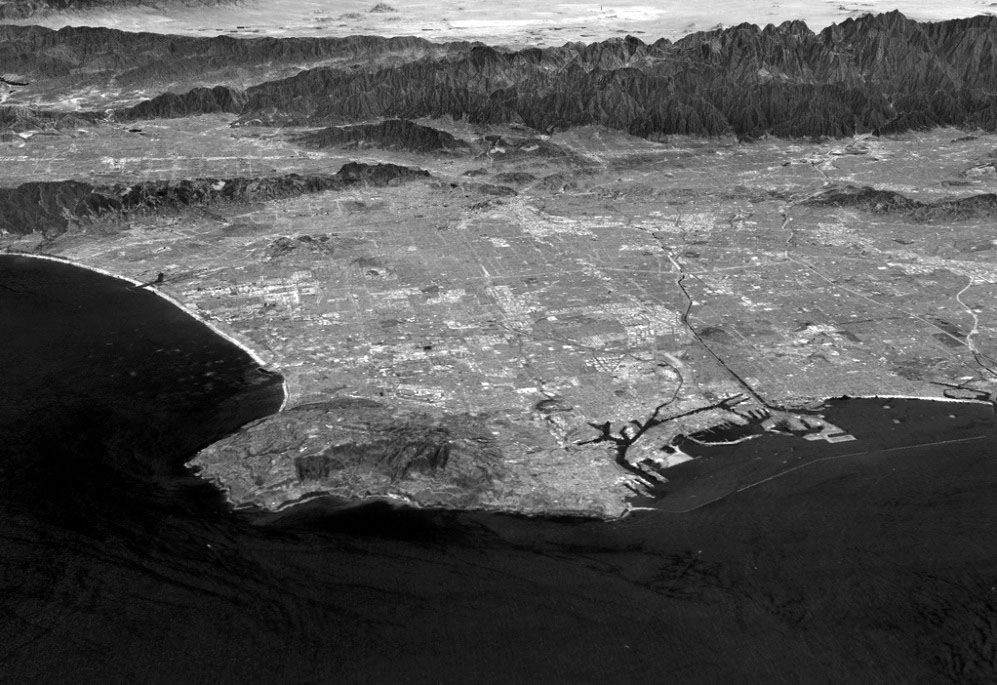 |
|
| (2009)**^# - The San Pedro Harbor and Long Beach Harbor stand out in a perspective view with Landsat overlay of the Los Angeles Basin. |
Historical Notes Most of Los Angeles is visible in this computer-generated north-northeast perspective viewed from above the Pacific Ocean. In the foreground the hilly Palos Verdes peninsula lies to the left of the San Pedro and Long Beach harbors, and in the middle distance the various communities that comprise the greater Los Angeles area appear as shades of grey and white. In the distance the San Gabriel Mountains rise up to separate the basin from the Mojave Desert, which can be seen near the top of the image. This 3-D perspective view was generated using topographic data from the Shuttle Radar Topography Mission (SRTM) and an enhanced color Landsat 5 satellite image mosaic. Topographic expression is exaggerated one and one-half times. |
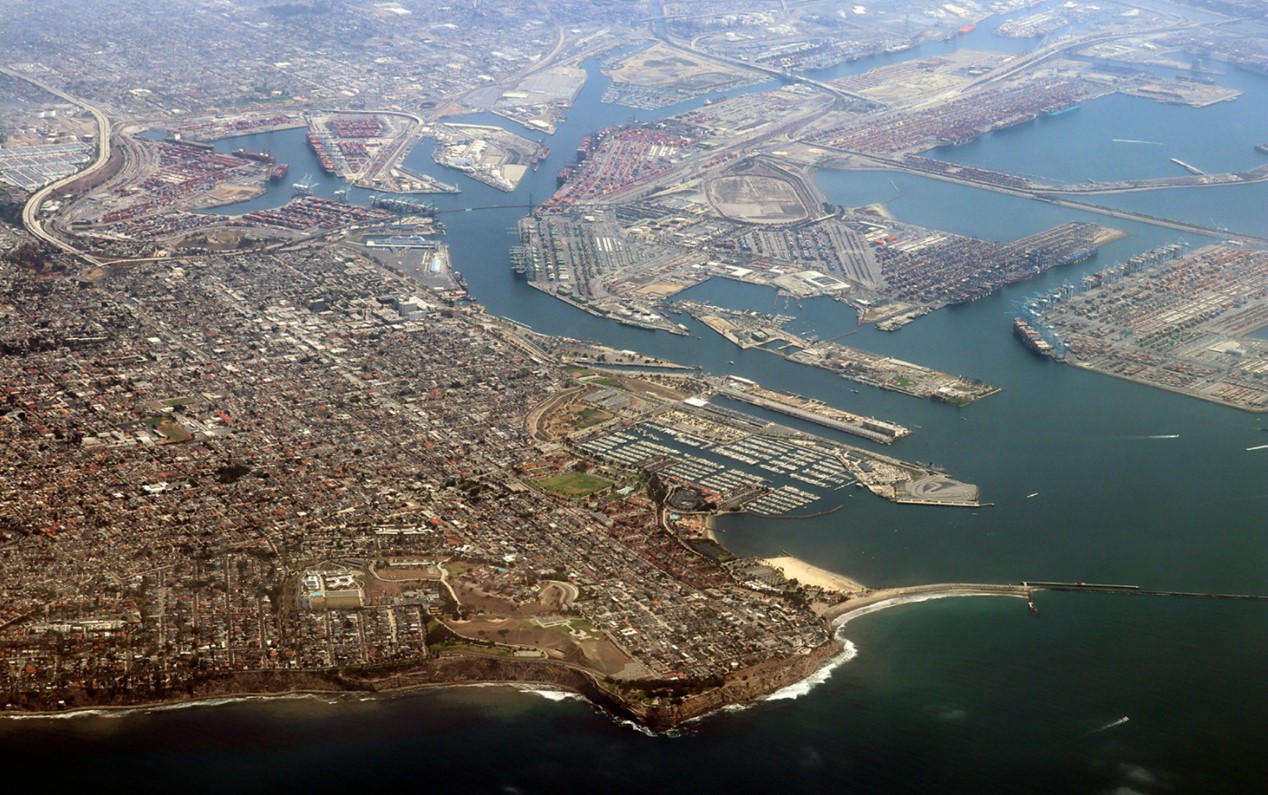 |
|
| (2021)* – Looking down at the Port of Los Angeles from 10,000 feet. |
 |
|
| (2014)* - Map of the Port of Los Angeles as it exists today, showing points of interest. |
1. The Original Wienerschnitzel Restaurant
|
28. Historic Downtown San Pedro
|
* * * * * |
Please Support Our CauseWater and Power Associates, Inc. is a non-profit, public service organization dedicated to preserving historical records and photos. Your generosity allows us to continue to disseminate knowledge of the rich and diverse multicultural history of the greater Los Angeles area; to serve as a resource of historical information; and to assist in the preservation of the city's historic records.
|
More Historical Early Views
Newest Additions
Early LA Buildings and City Views
History of Water and Electricity in Los Angeles
* * * * * |
References and Credits
* LA Public Library Image Archive
**DWP - LA Public Library Image Archive
*#South Bay Daily Breeze: San Pedro’s Bascule Bridge; The Free Harbor Day Jubilee
#^Flickr: History of San Pedro Harbor and Terminal Island
#* Huntington Digital Library Archive
+# Catalinagoose.com: Wilmington-Catalina Airline
#+ World War II Database: USS Cassin Young
#^^California State Library Image Archive
#^*Library of Congress Image Archive: 1909 Panorama with City Hall: 1919 U.S. Naval Fleet; c.1904 Panorama of Beacon Street
#*^Facebook.com - San Pedro's Original Website, San Pedro.com
#**Flickr.com: Michael Ryerson
*#*KCET - Inventing LA: Port of Los Angeles; L.A.'s First Railroads Connected the Region to the Global Economy; Why Is SoCal's Harbor Split Between Two Cities?
*^*California Historic Landmark Listing (Los Angeles)
^^*S.S. Avalon and S.S. Catalina
**^Wilmington Historic Society
^.^California State University Dominguez Hills Image Archive
**#Maureen Megowan: History of San Pedro; Secrets about the Palos Verdes Peninsula
*^#Avalon: cawreckdivers.org.com
^*#Avalon Boulevard: publicradio.org
*^^Port of Los Angeles: portoflosangeles.org
^**LA Times: Japanese Evicted from Terminal Island; Framwork: The Vincent Thomas Bridge
^^#SanPedro.com: Fishing Industry
^#^LA Metro Transportation Image Archive
^##Port of Los Angeles: Discover the LA Waterfront
^#*Los Angeles Fire Department Historical Archive
*#^Vincent Thomas Bridge - Facts and Figures
*^*^The Banning Compnay: socialarchive.virginia.ed
*^^*Pacific Eelecfric in San Pedro/Wilmington
^**^The Historical Society of Southern California
****Pamona Public Library’s Frasher Foto Postcard Collection
***^San Pedro and Los Angeles Harbor History
***#WPA in LA: The New Deal in Los Angeles 1933-43
**^#Archive.org: Perspective View with Landsat Overlay, Los Angeles Basin
^*^*Pinterest: Cars - Bertrand Lacheze; Beaon Street, 1910
^*^#Facebook.com - Bizzare Los Angeles
^^*#Facebook.com - Classic Hollywood/Los Angeles/SFV
^^**Flickr.com - Floyd B. Bariscale Photostream: Dodson Residence; Fireboat No. 2 and Firehouse No. 112
*^^^Los Angeles Maritime Museum
^^^#Dominguez Rancho Adobe Museum
*##*Portoflosangeles.org: Prot History
^#^^Calisphere: University of California Image Archive
^#^#Press Reference Library, Volume 2 (Google eBook)
*#*#Benjamin Wilson
*#^#Sirensofchrome.com: Rumble Seat
*^##OAC - Online Archive of California
^^##LAist: A Park a Day: Point Fermin Park, San Pedro
#***Los Angeles Conservancy: Warner Grand Theatre; Wartime Shipbuilding on Terminal Island
#**^LA County Library Image Archive
#^**California Elks State Association
#^*^Port of Long Beach Blogspot
#*^*Los Angeles City Historical Society
#*#^LAParks.org: Cabrillo Bath House
****^Facebook.com: West San Fernando Valley Then And Now
^* Noirish Los Angeles - forum.skyscraperpage.com; San Pedro Harbor; 1885 Harbor; 1905 City Hall; Vincent Thomas Bridge; Wilmington Storage and Towing Co.; 5th Street Landing; San Pedro and Palos Verdes ca. 1940; Breakwater and Lighthouse Postcard
*^ Wikipedia: San Pedro; Wilmington; Deadman's Island (San Pedro); Phineas Banning; Daguerreotype; Drum Barracks; Los Angeles Terminal Railway; Santa Catalina Island; S.S. Catalina; Cord Automobile; Banning High School; Wilmington Oil Field; San Pedro High School; Ford Model T; Pt. Fermin Light; Padre Fermín Lasuén; San Pedro Bay; James H. Dodson Residence; Vincent Thomas Bridge; S.S. Monterey; Los Angeles Harbor Lighthouse; S.S. Yale; Juan Rodríguez Cabrillo; World Cruise Center; Volkswagon Beetle; Warner Grand Theatre; Chichibu Maru; San Pedro Municipal Ferry Building; Wilmington Transportation Company; USS Cassin Young; SS California; US Coast Guard
< Back
Menu
- Home
- Mission
- Museum
- Major Efforts
- Recent Newsletters
- Historical Op Ed Pieces
- Board Officers and Directors
- Mulholland/McCarthy Service Awards
- Positions on Owens Valley and the City of Los Angeles Issues
- Legislative Positions on
Water Issues
- Legislative Positions on
Energy Issues
- Membership
- Contact Us
- Search Index